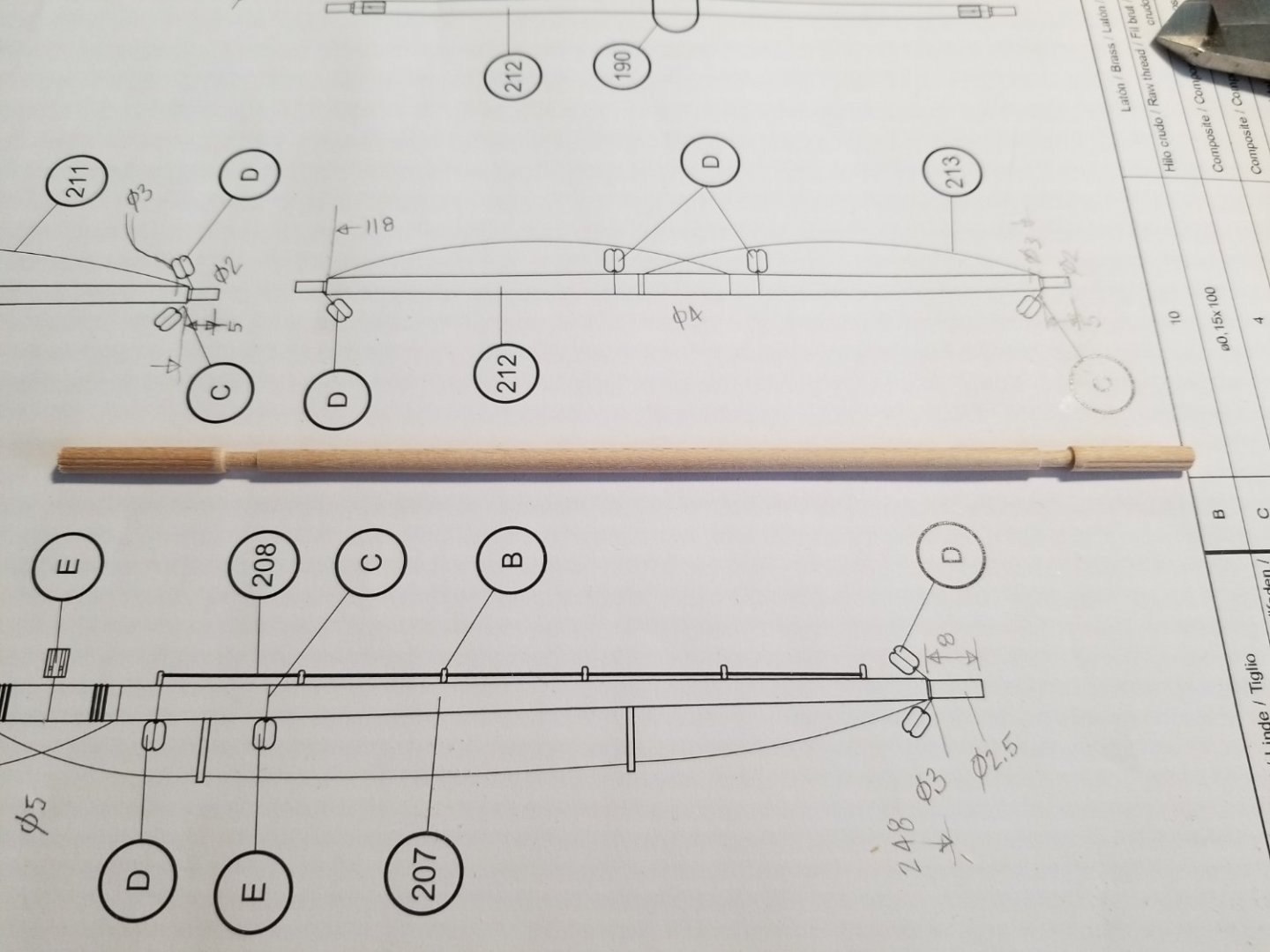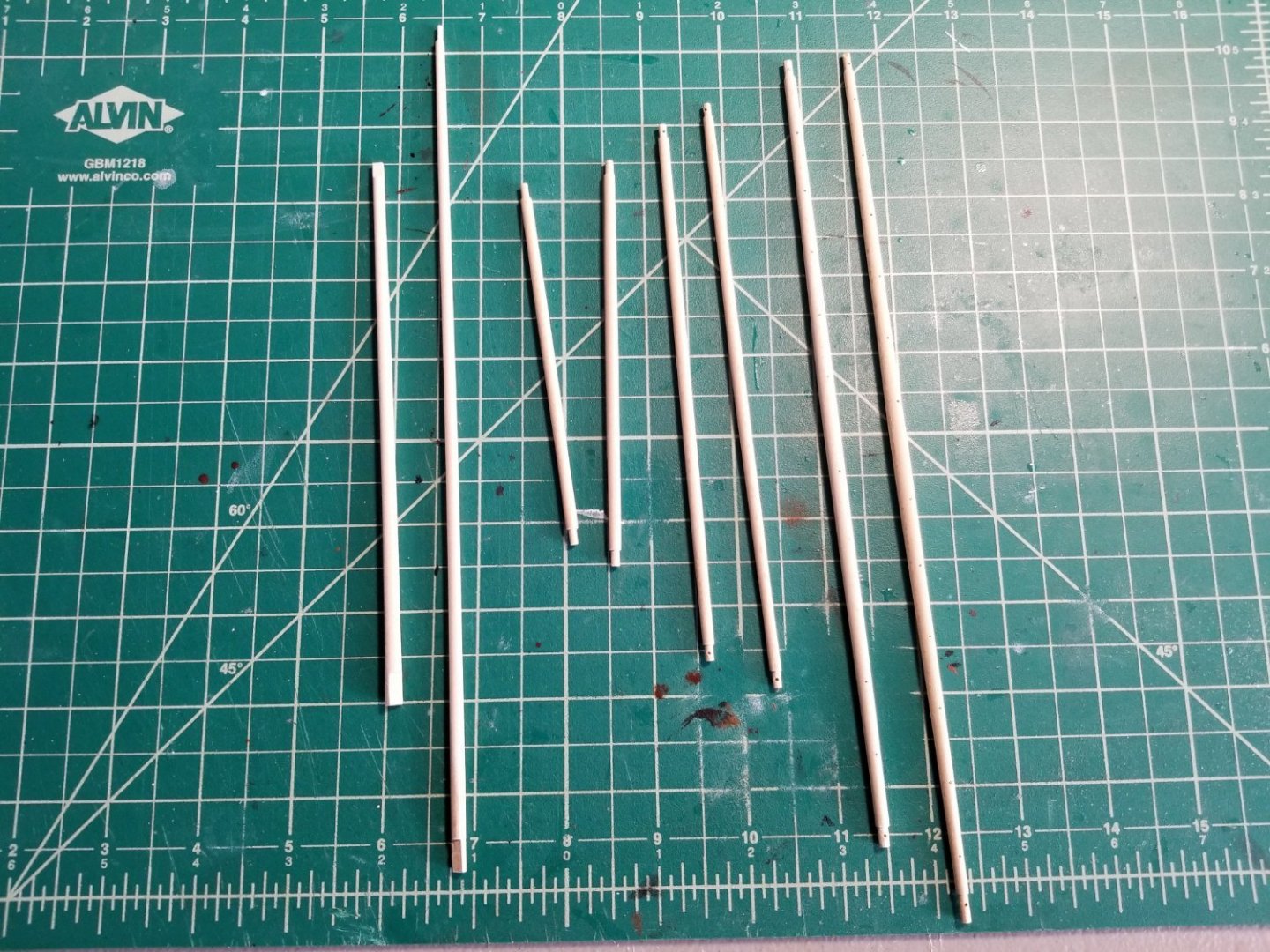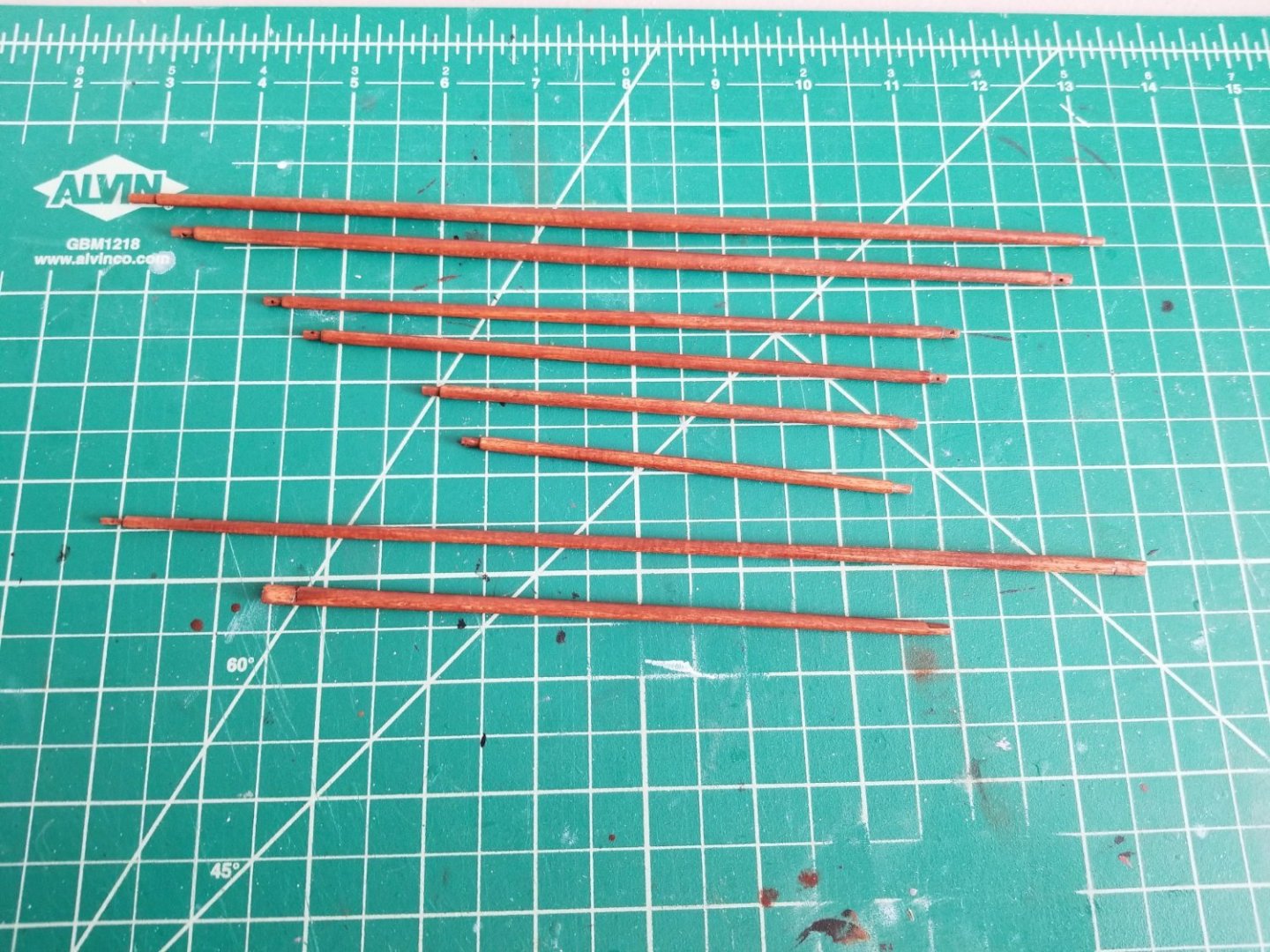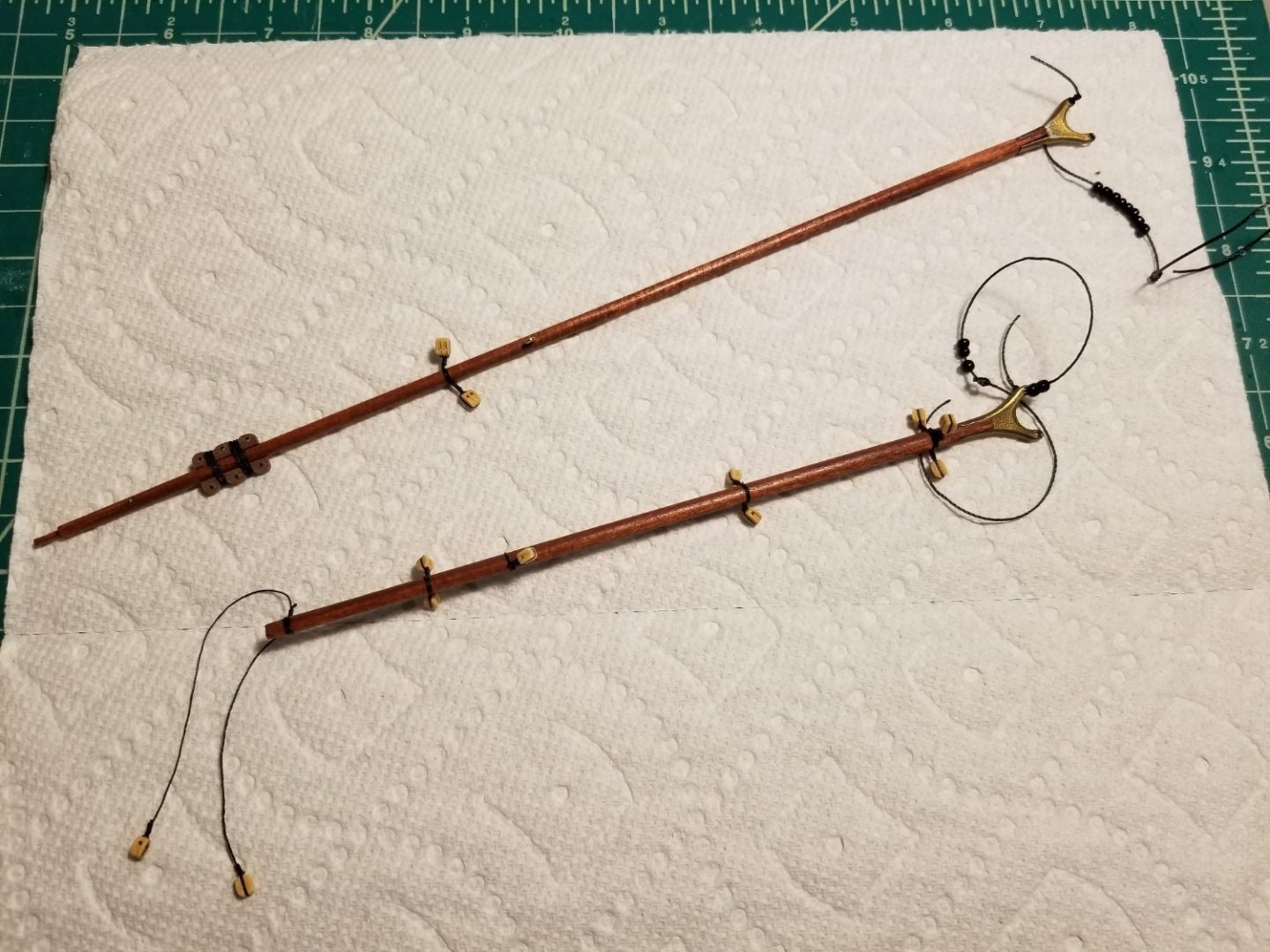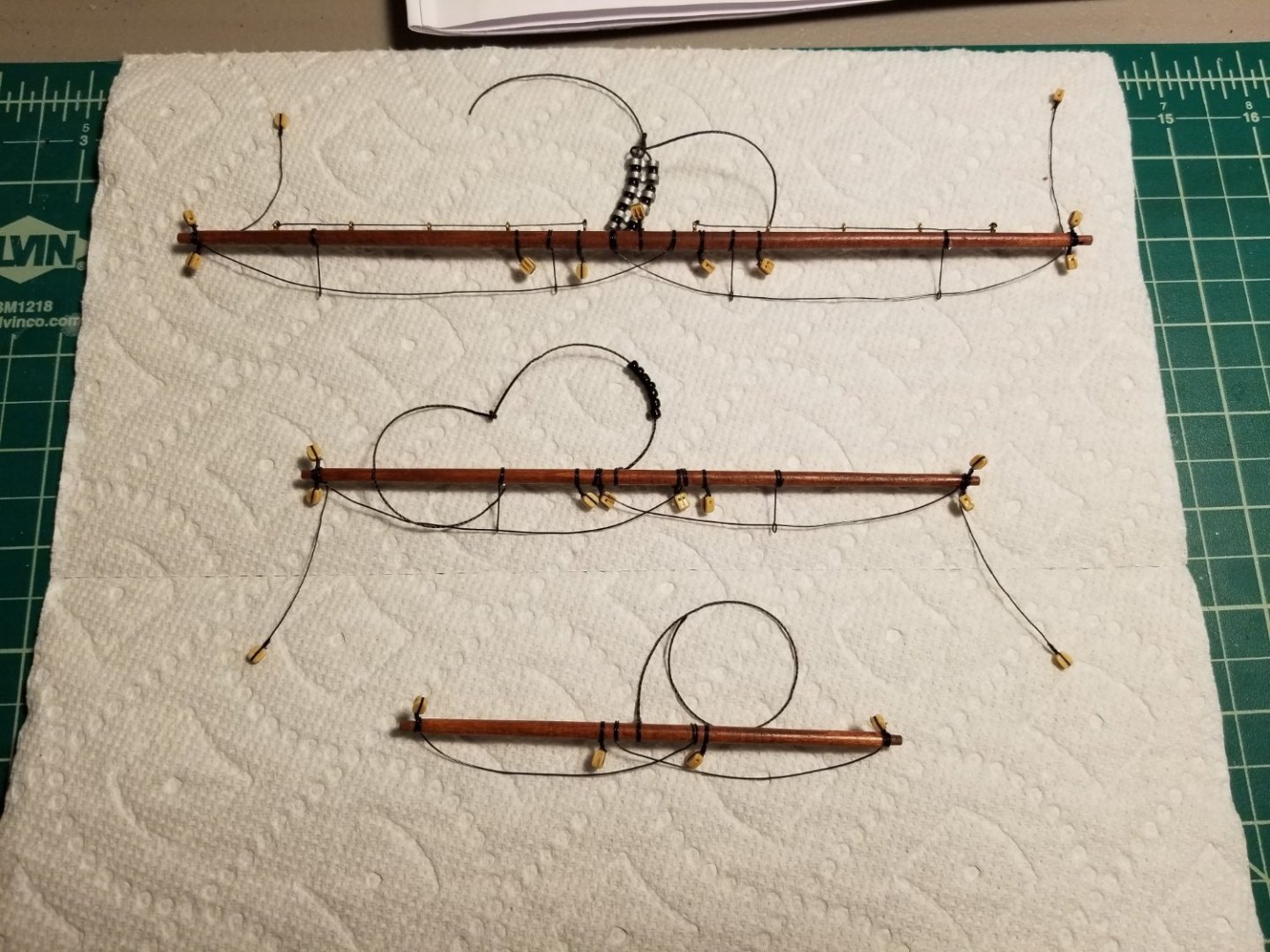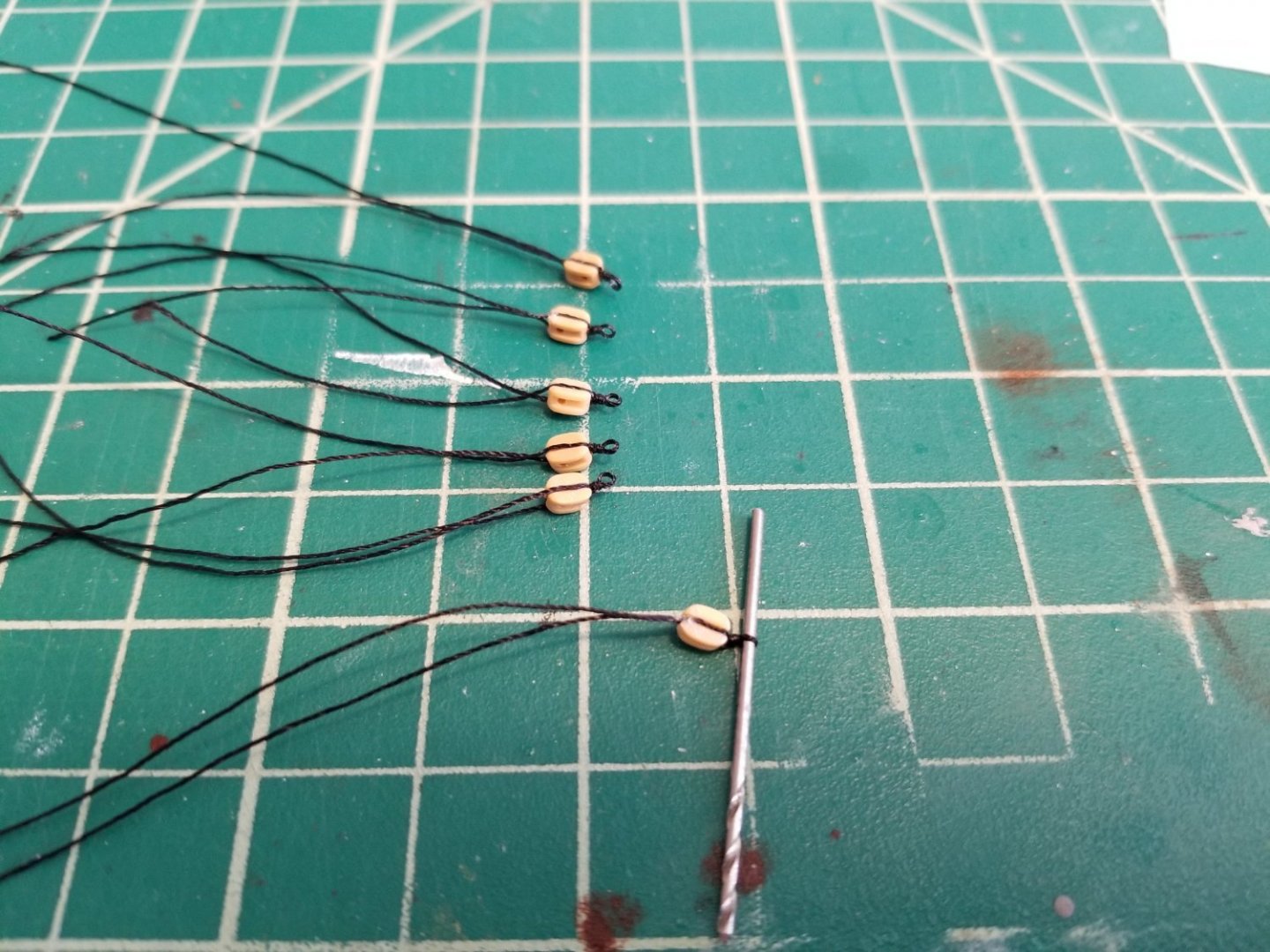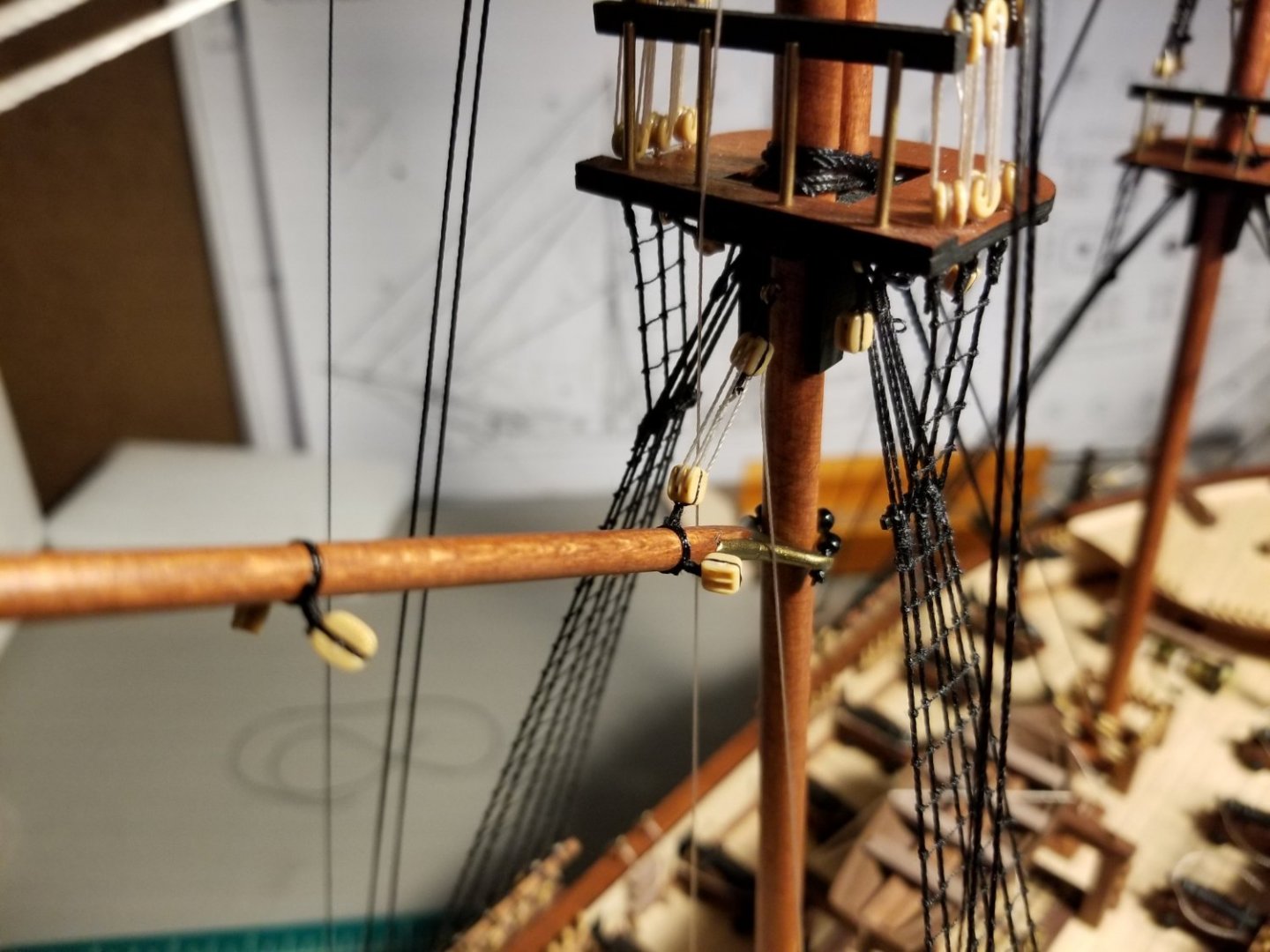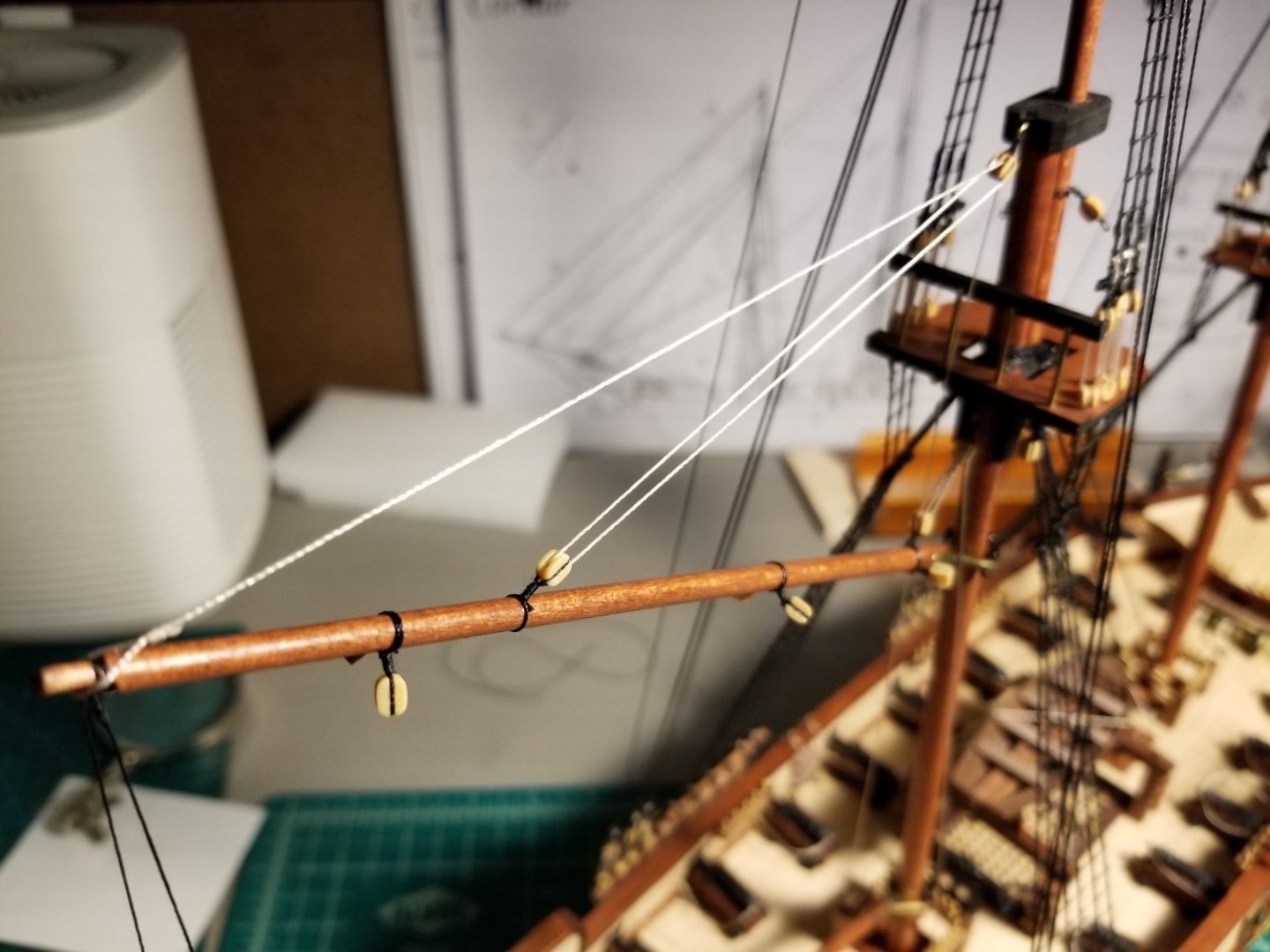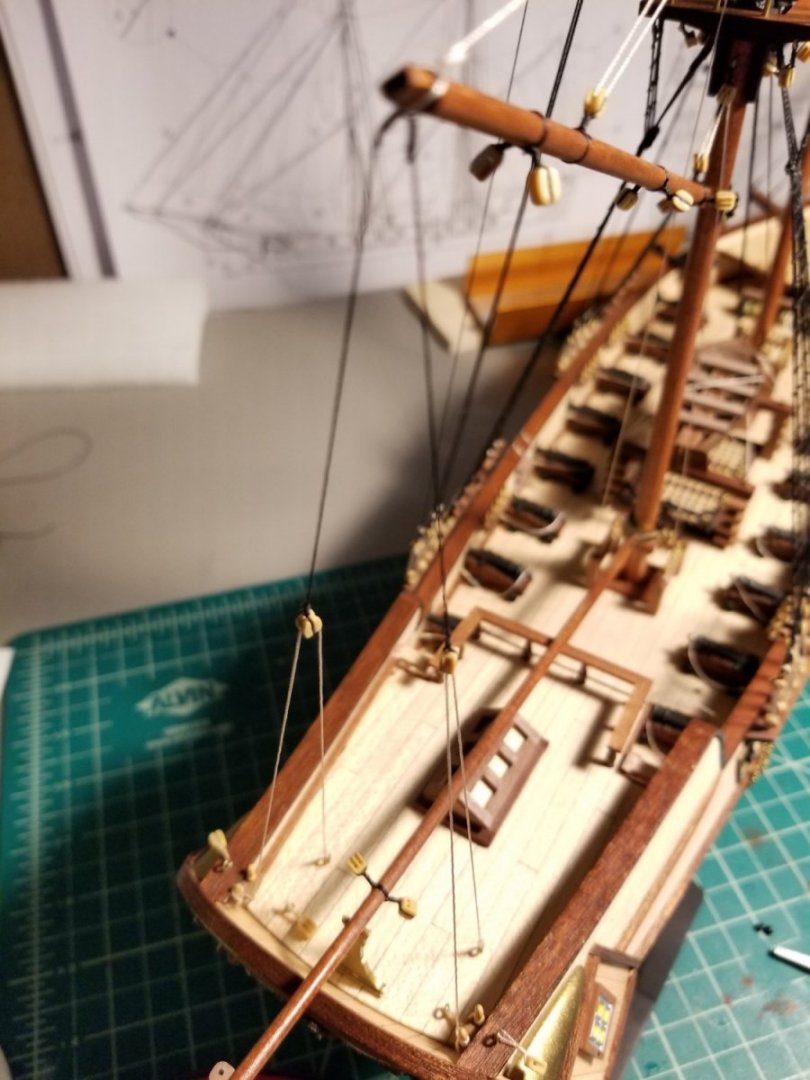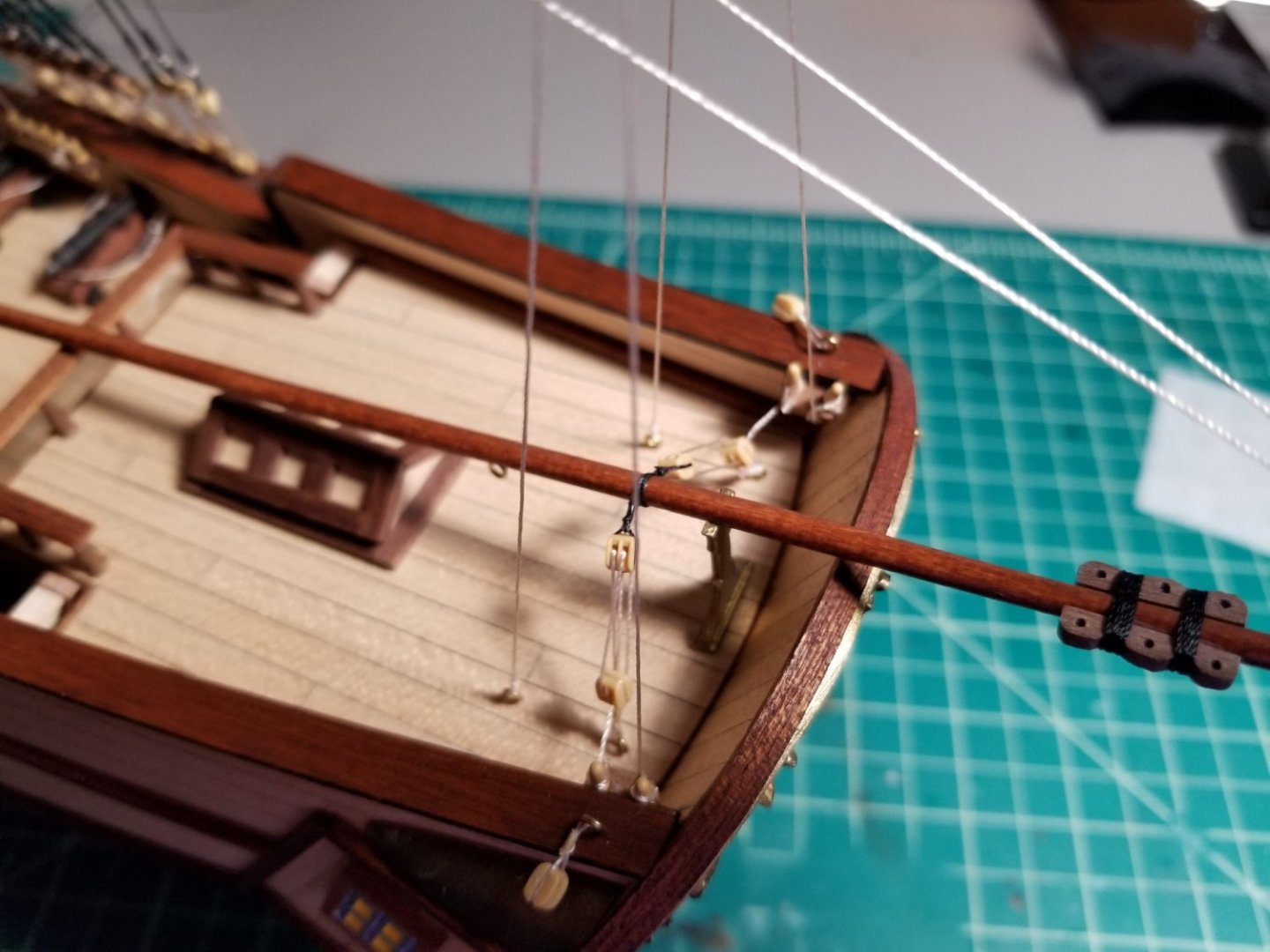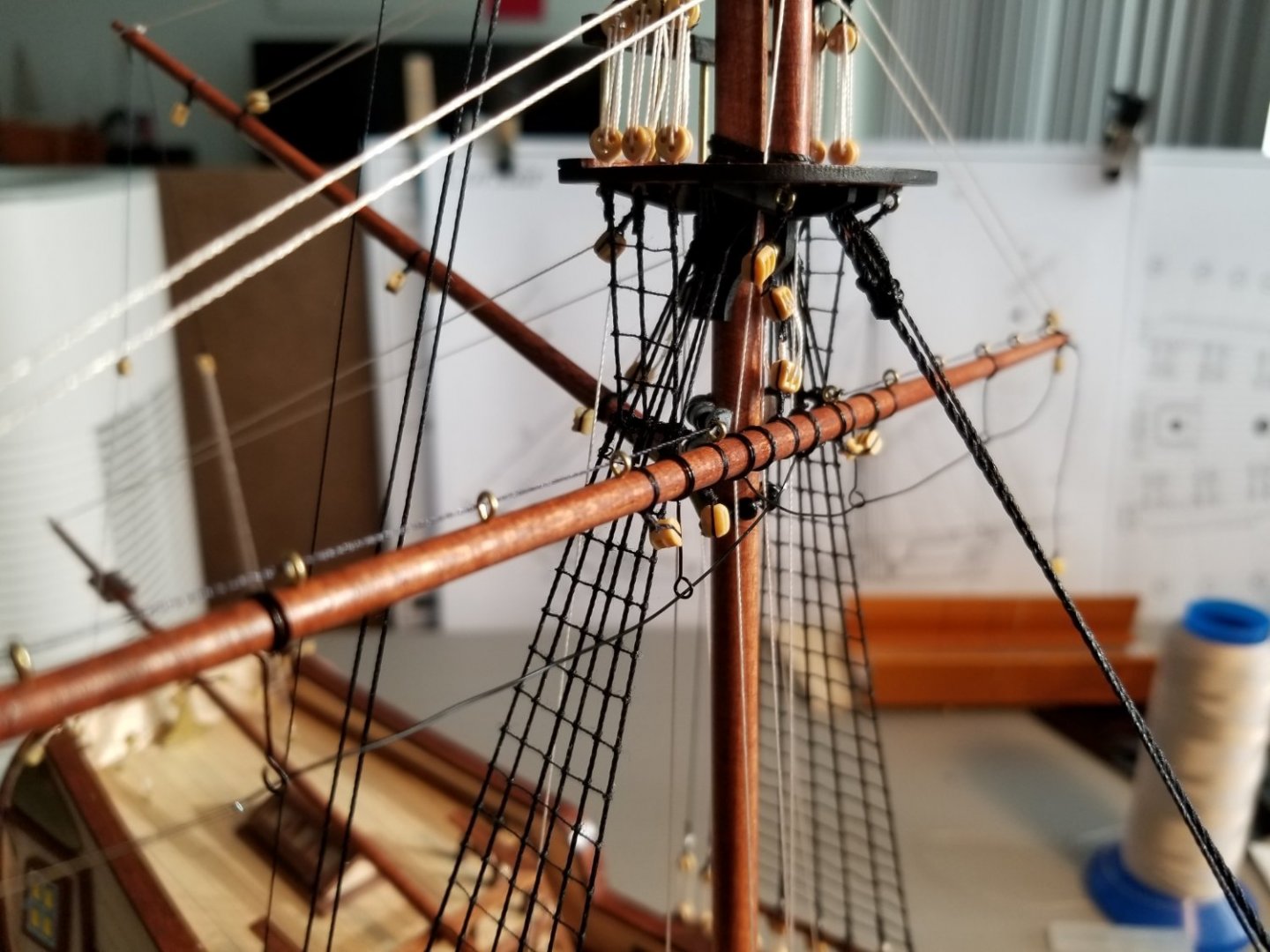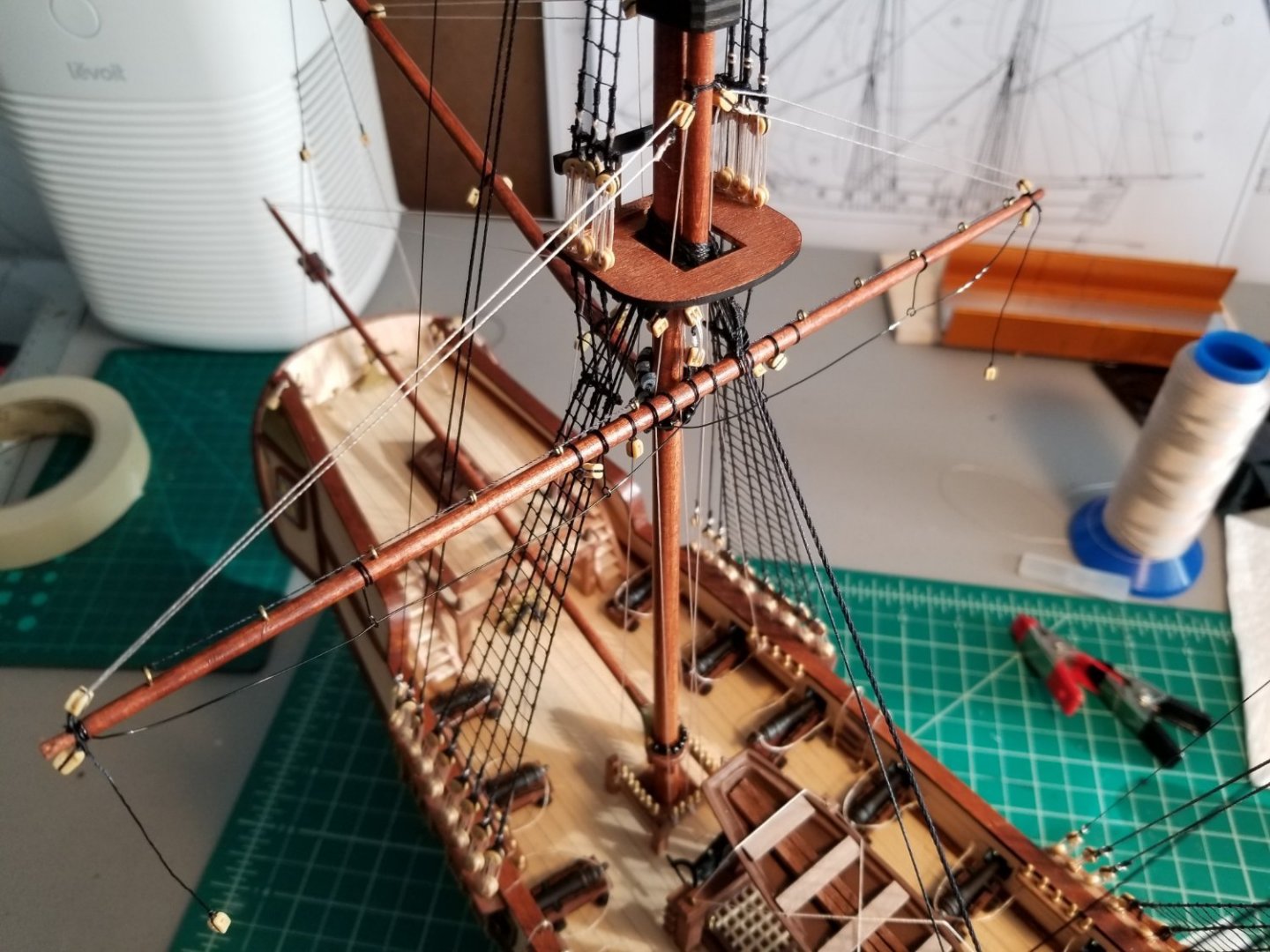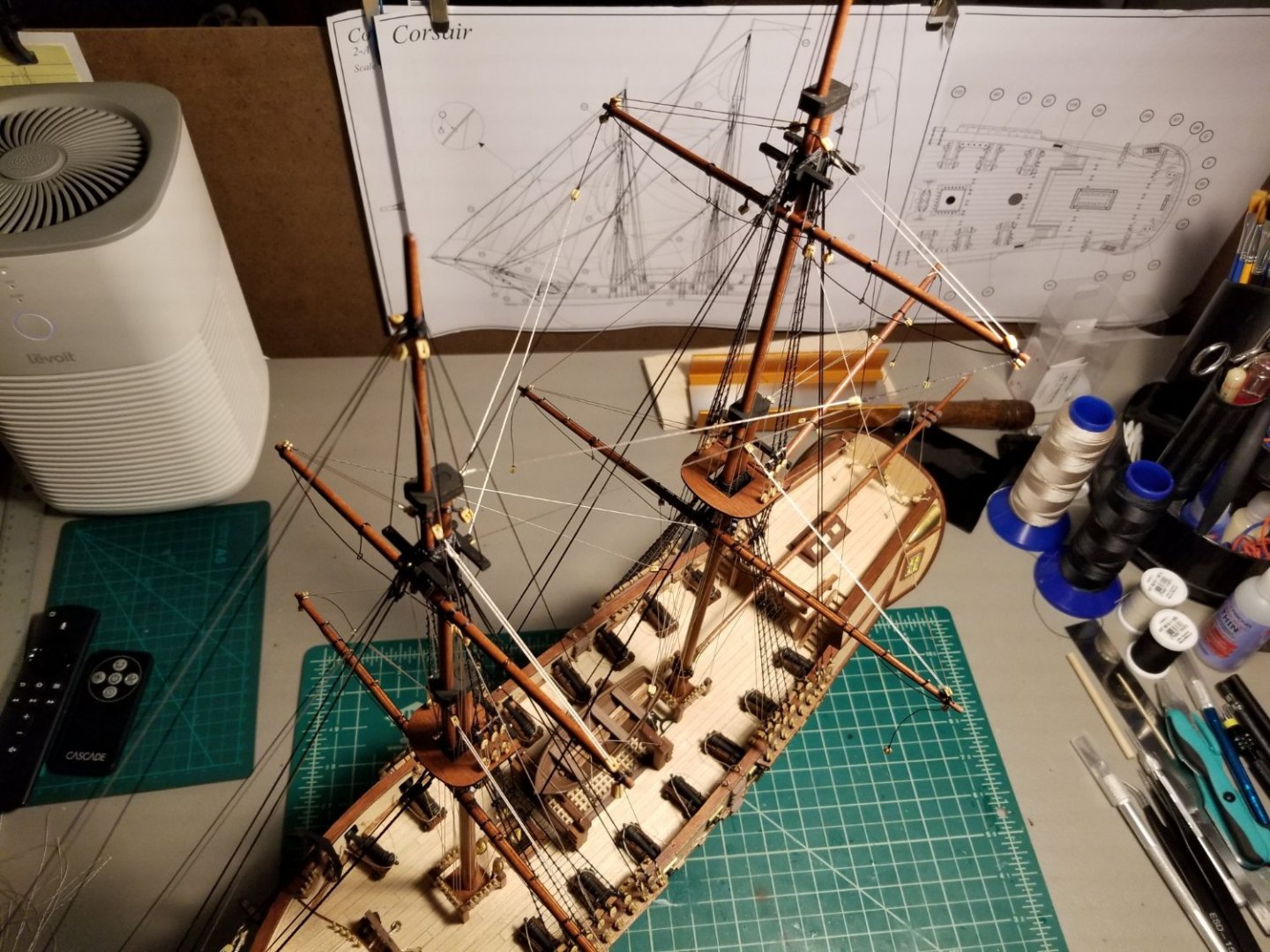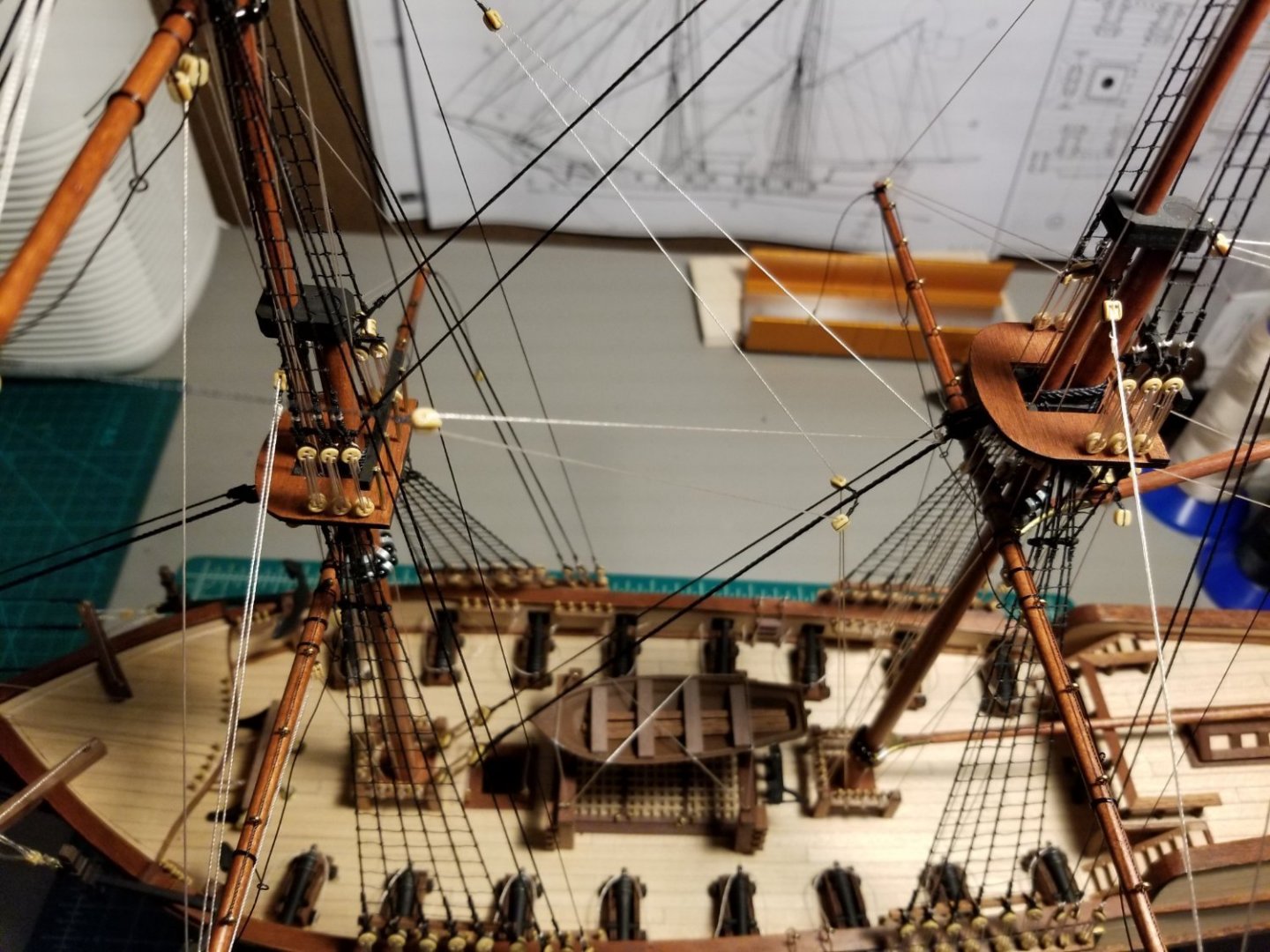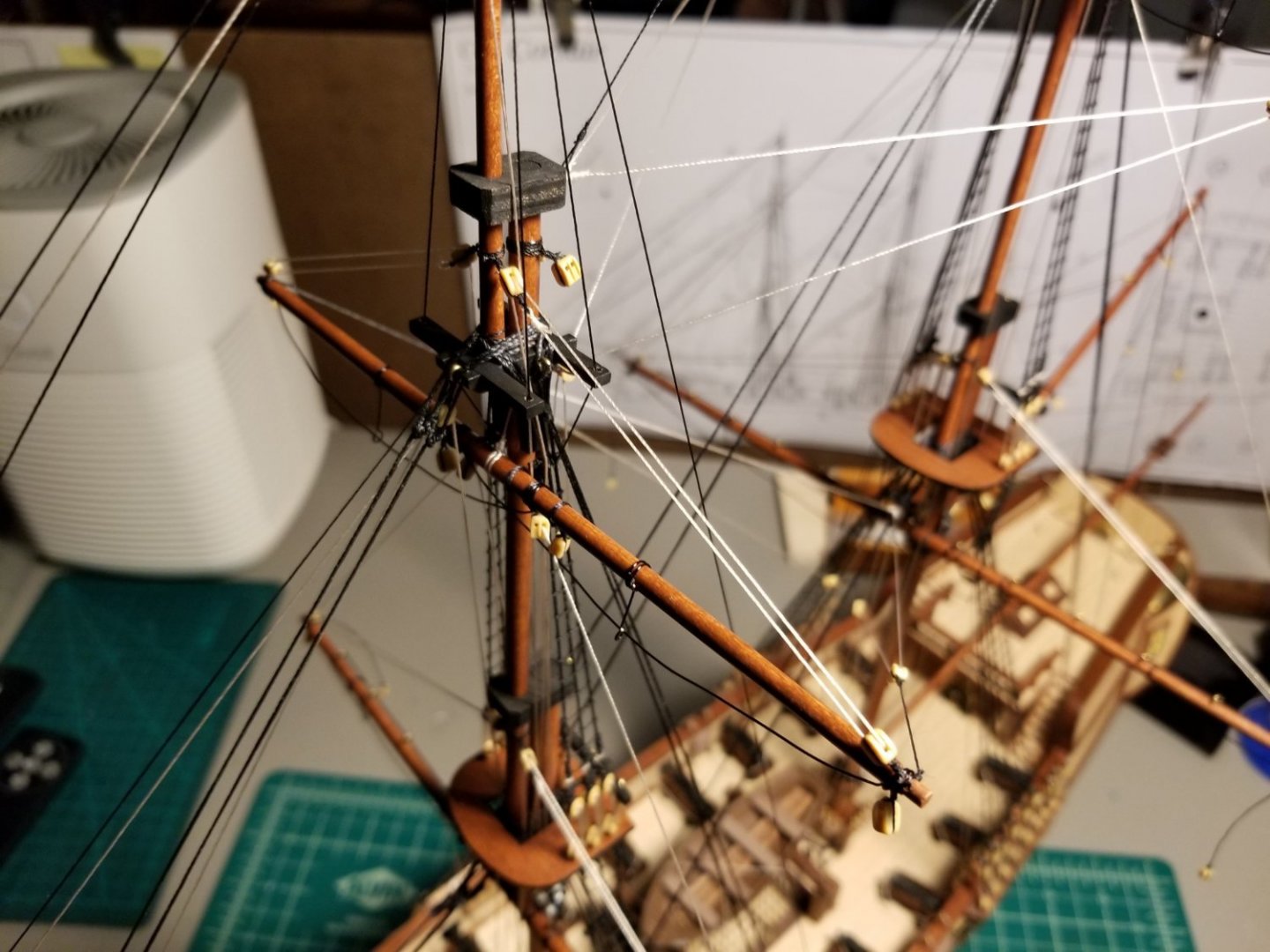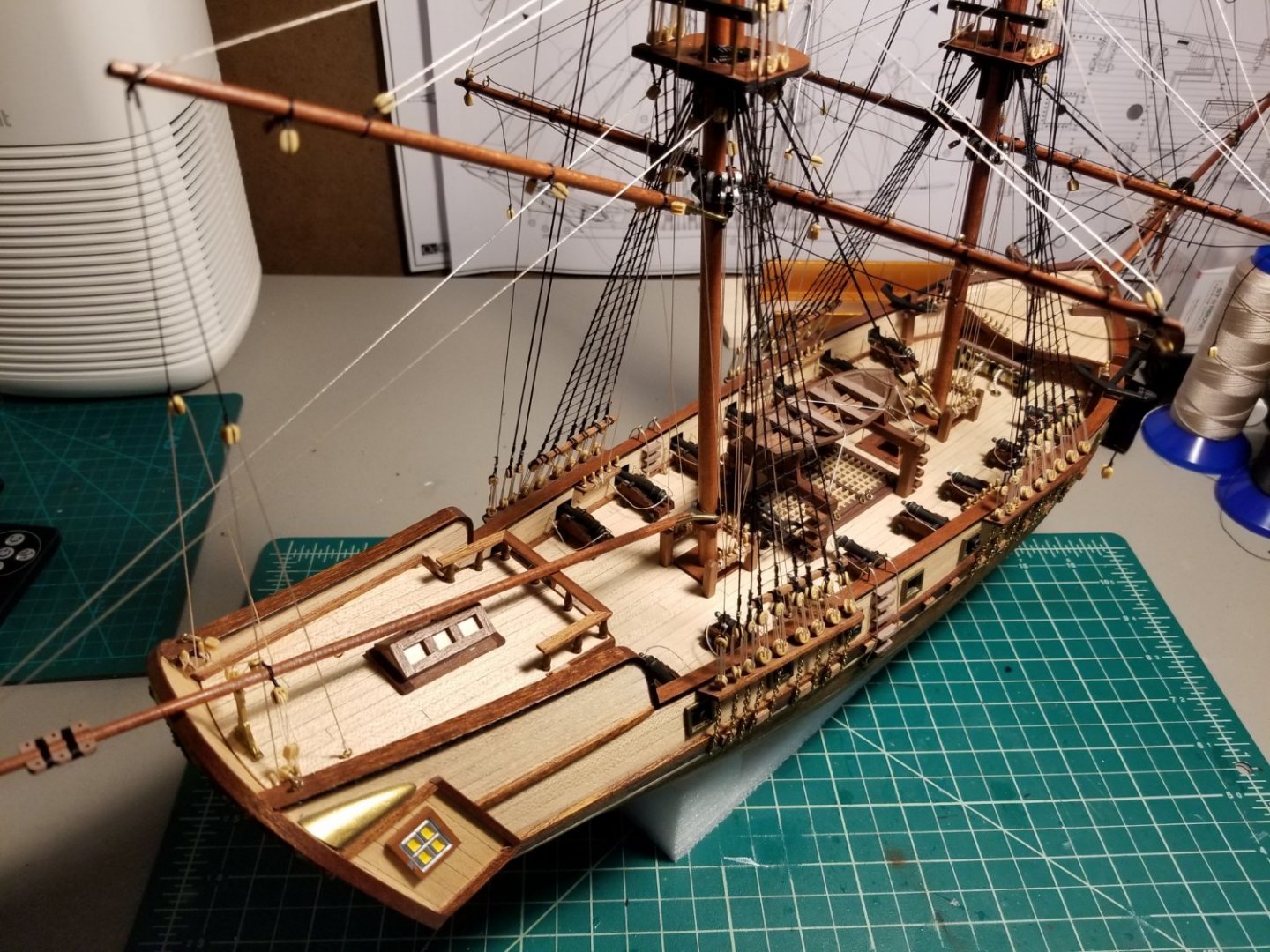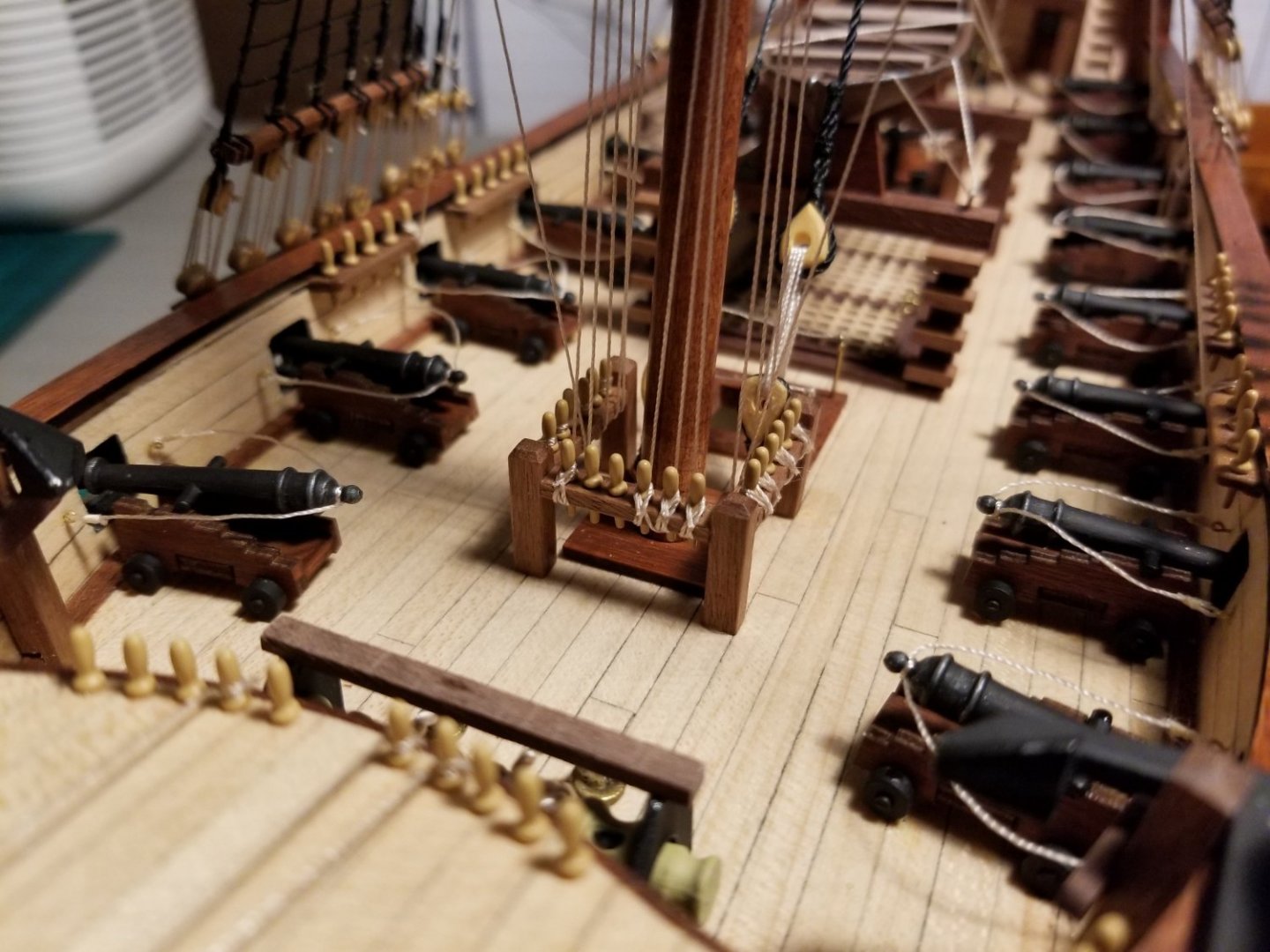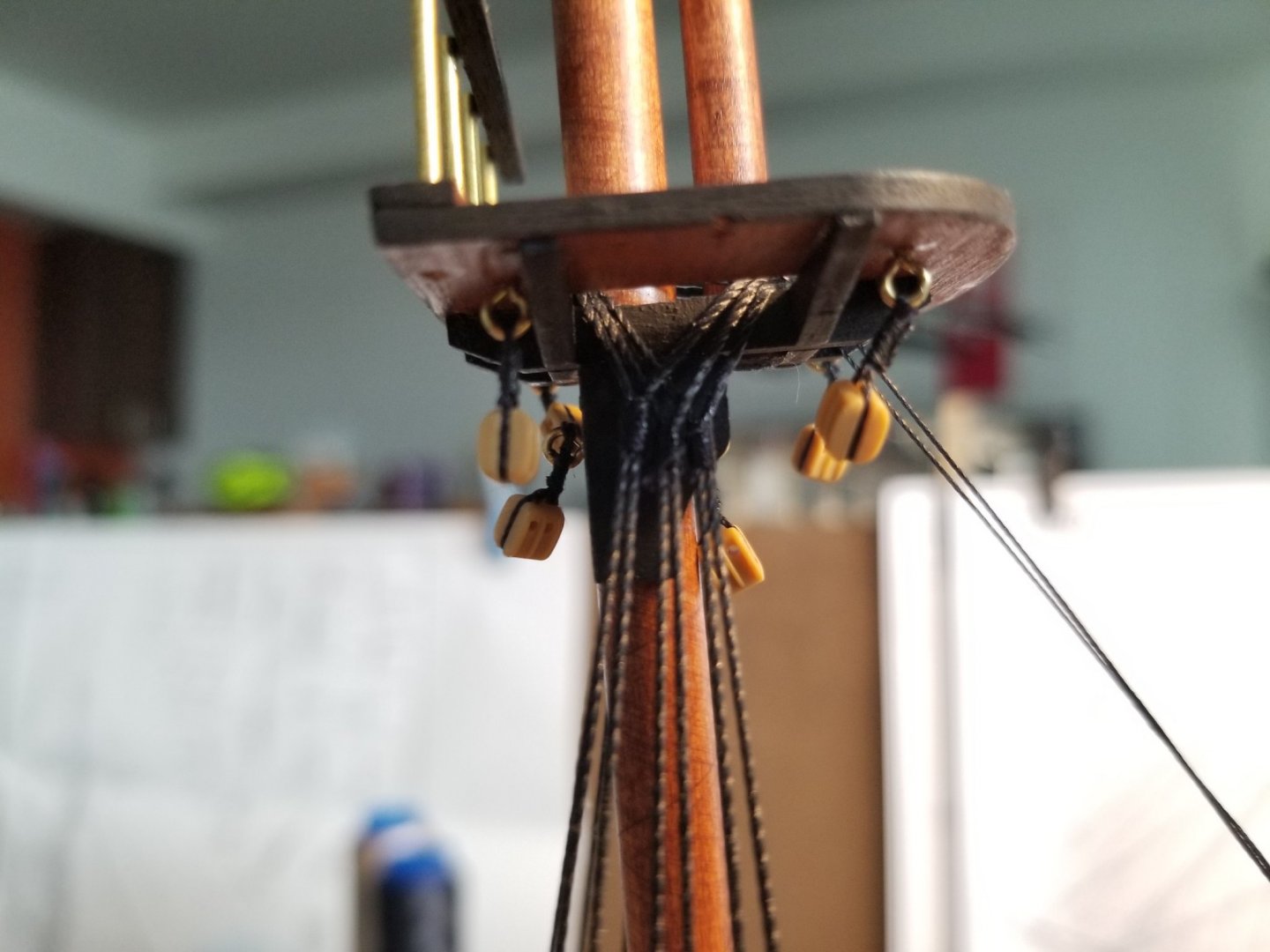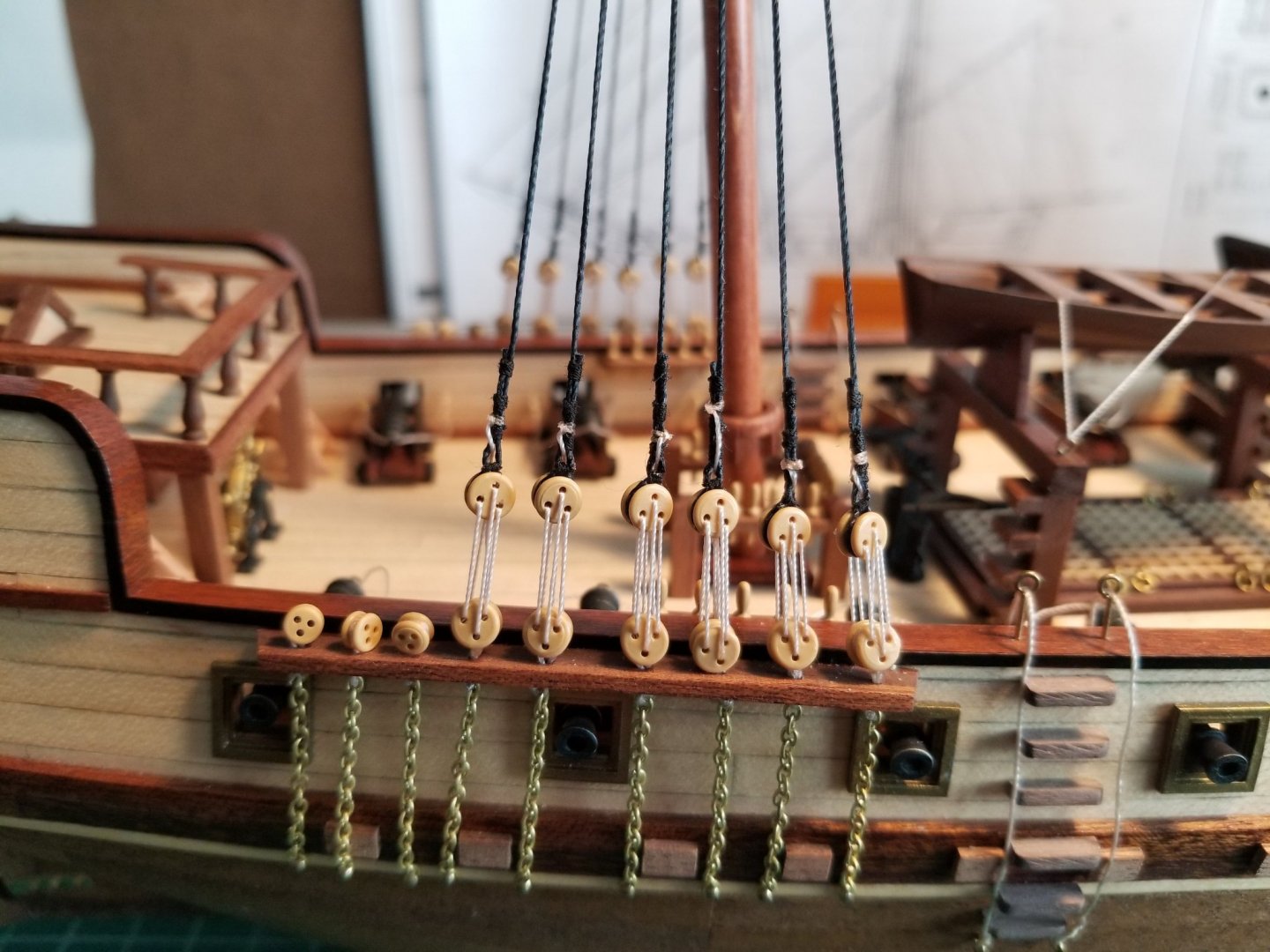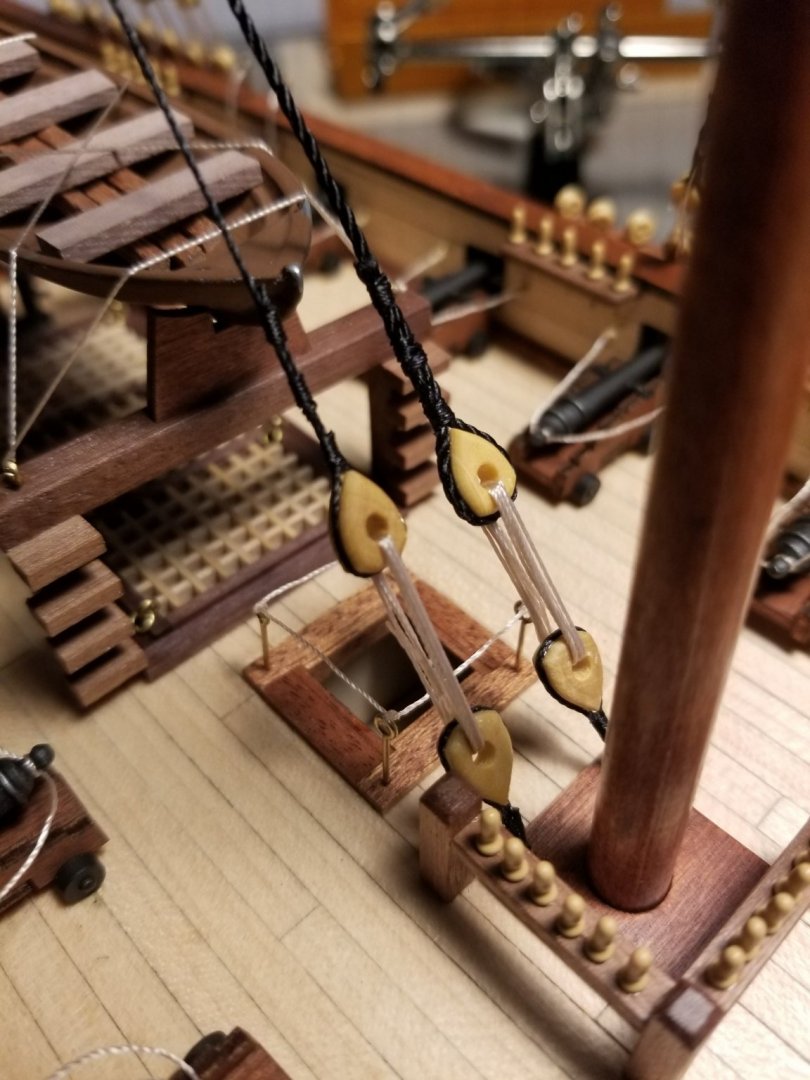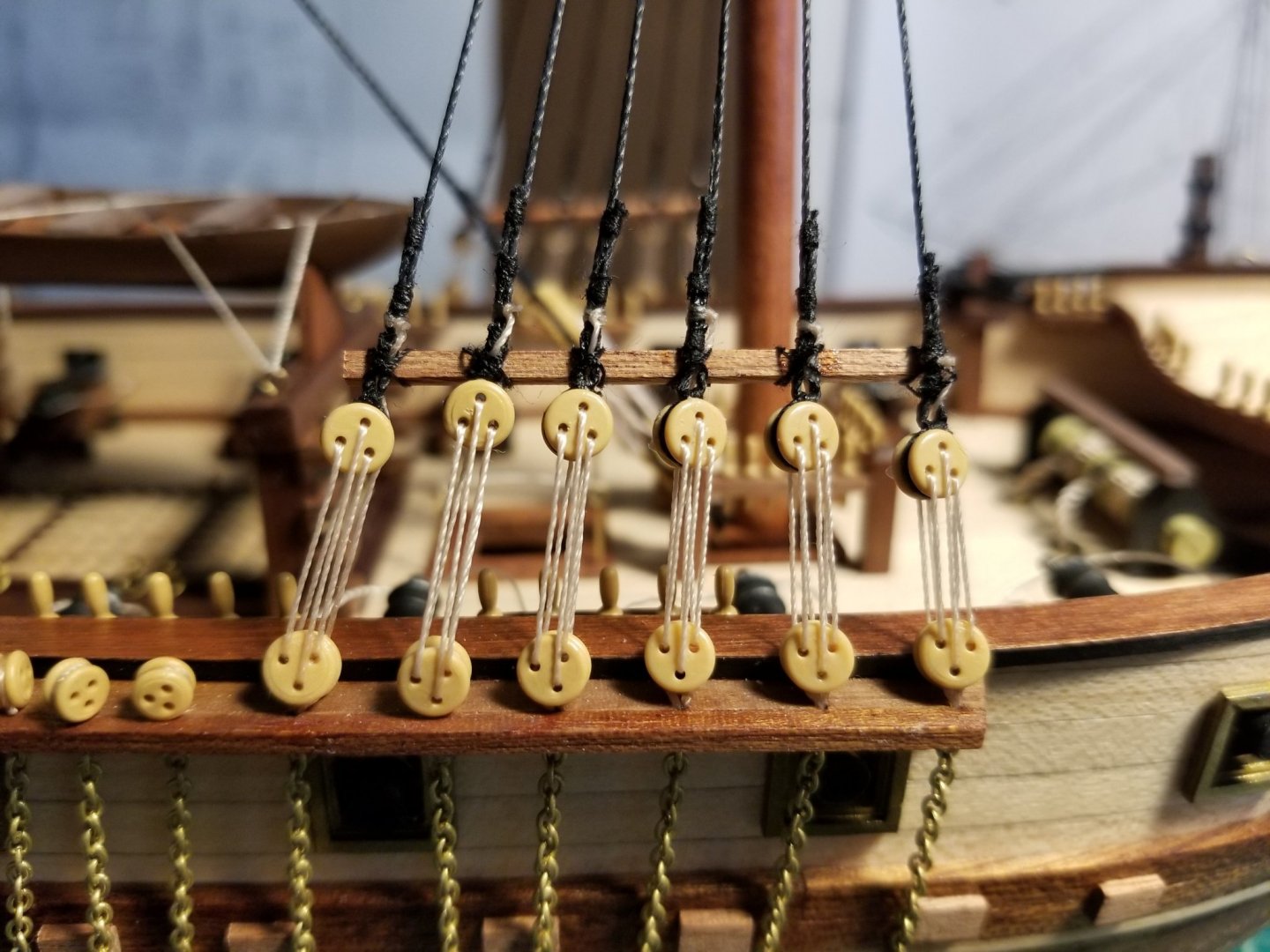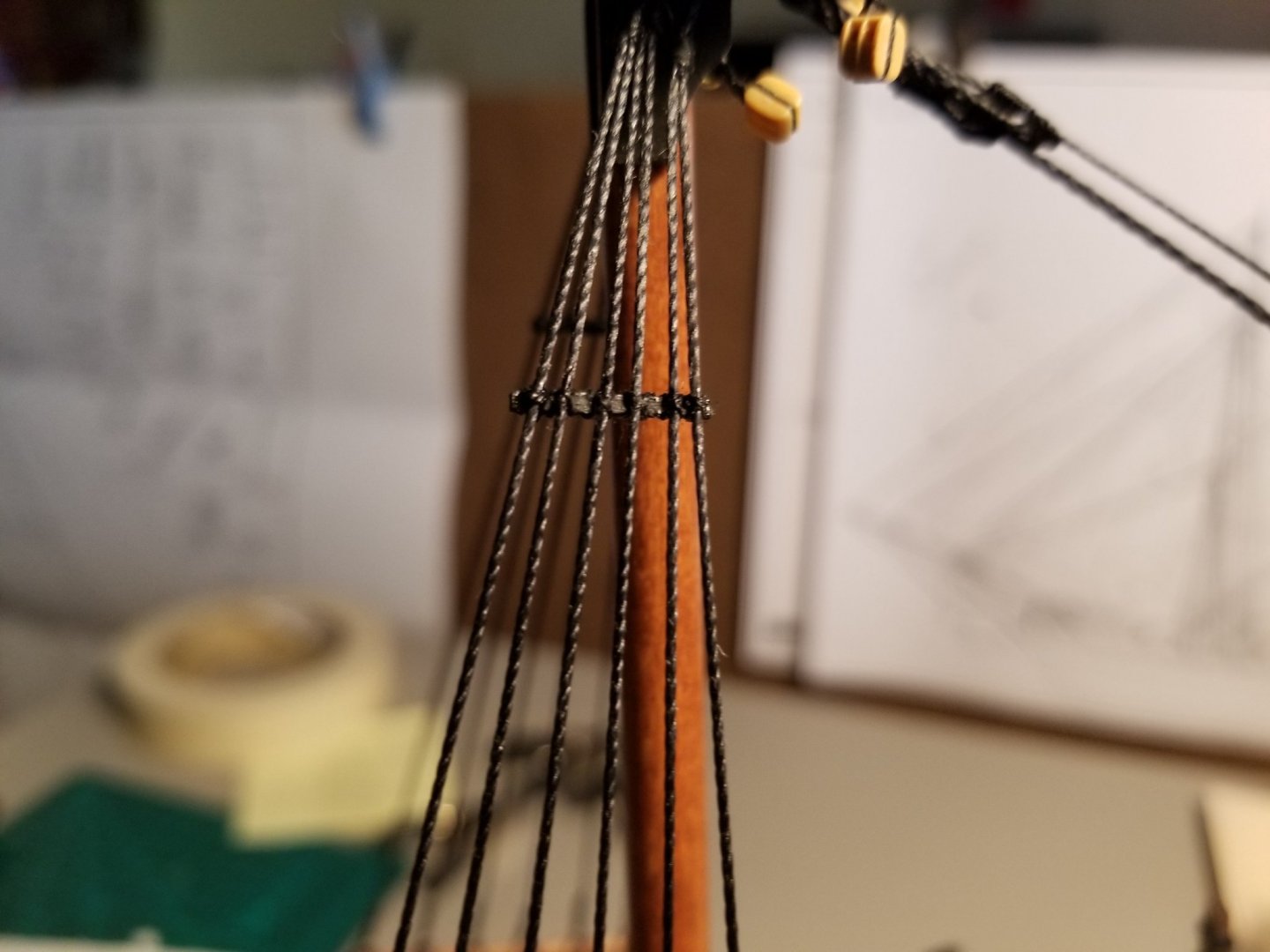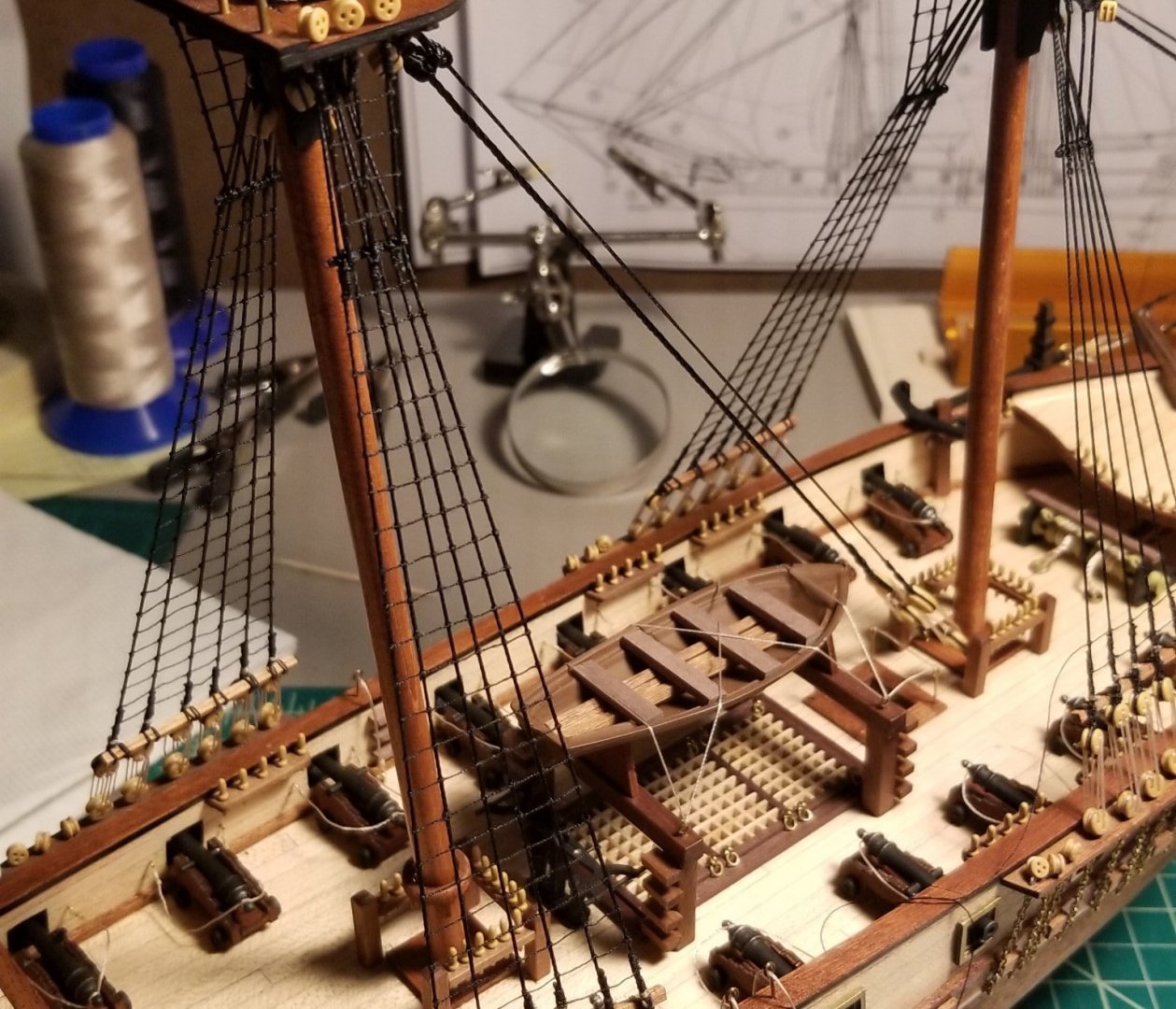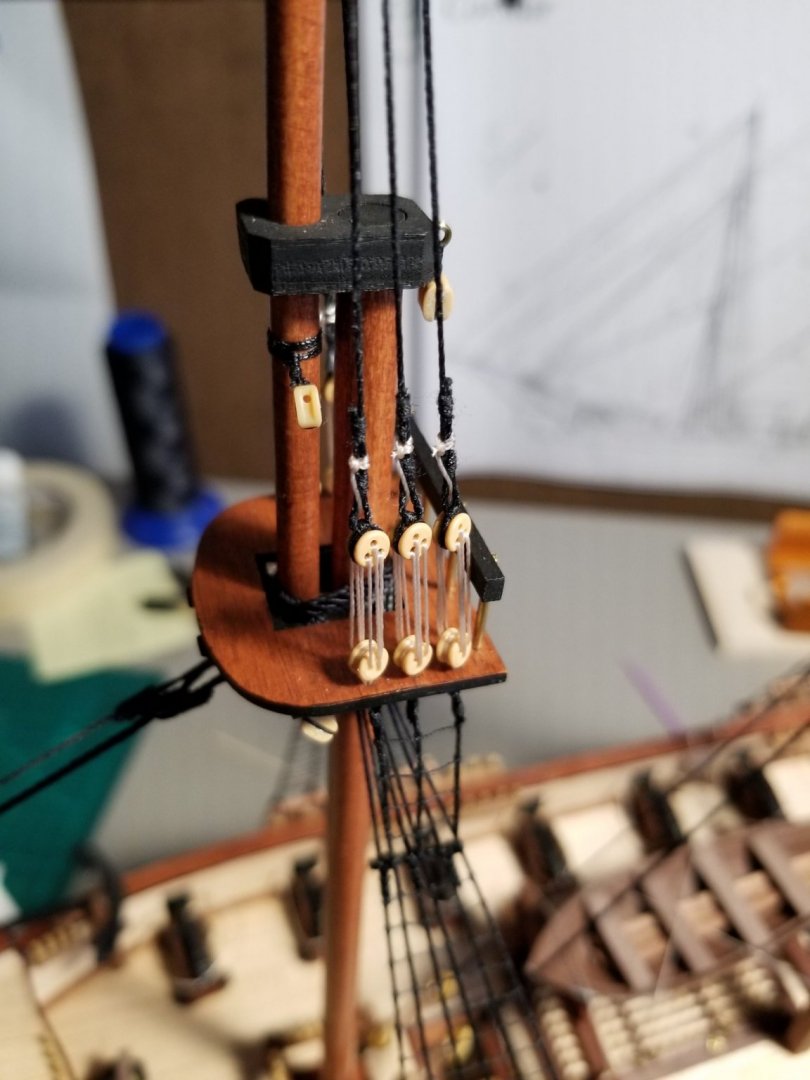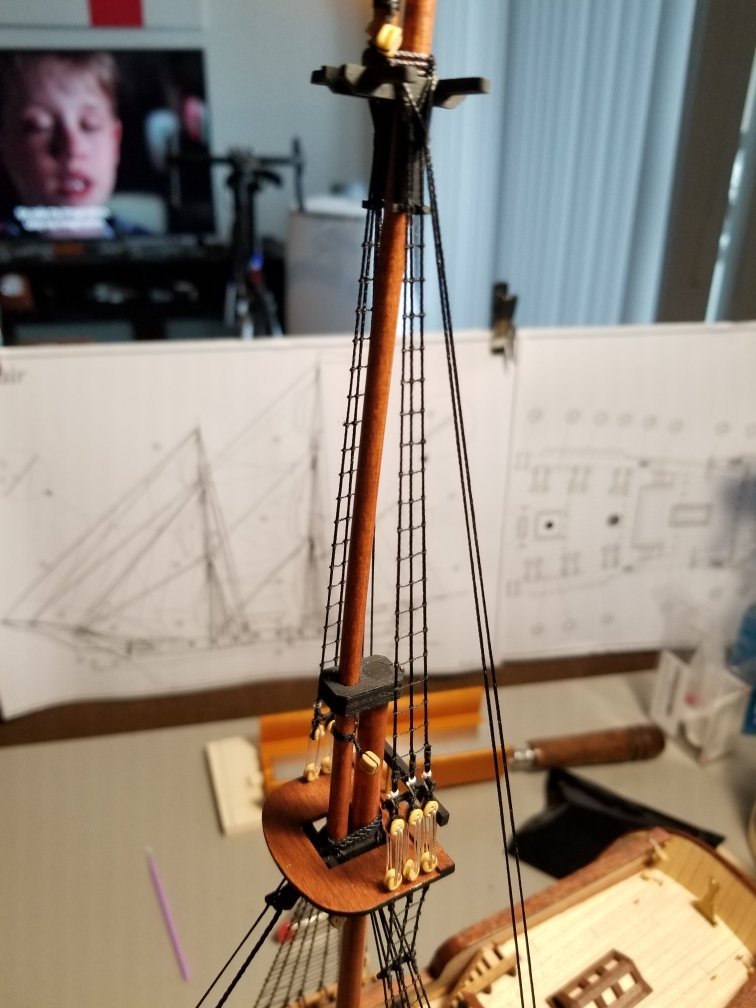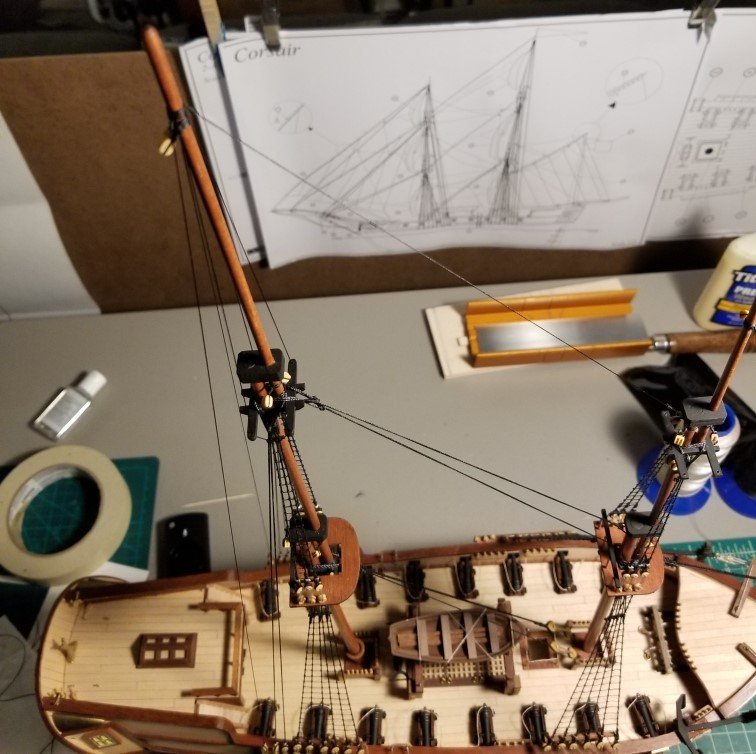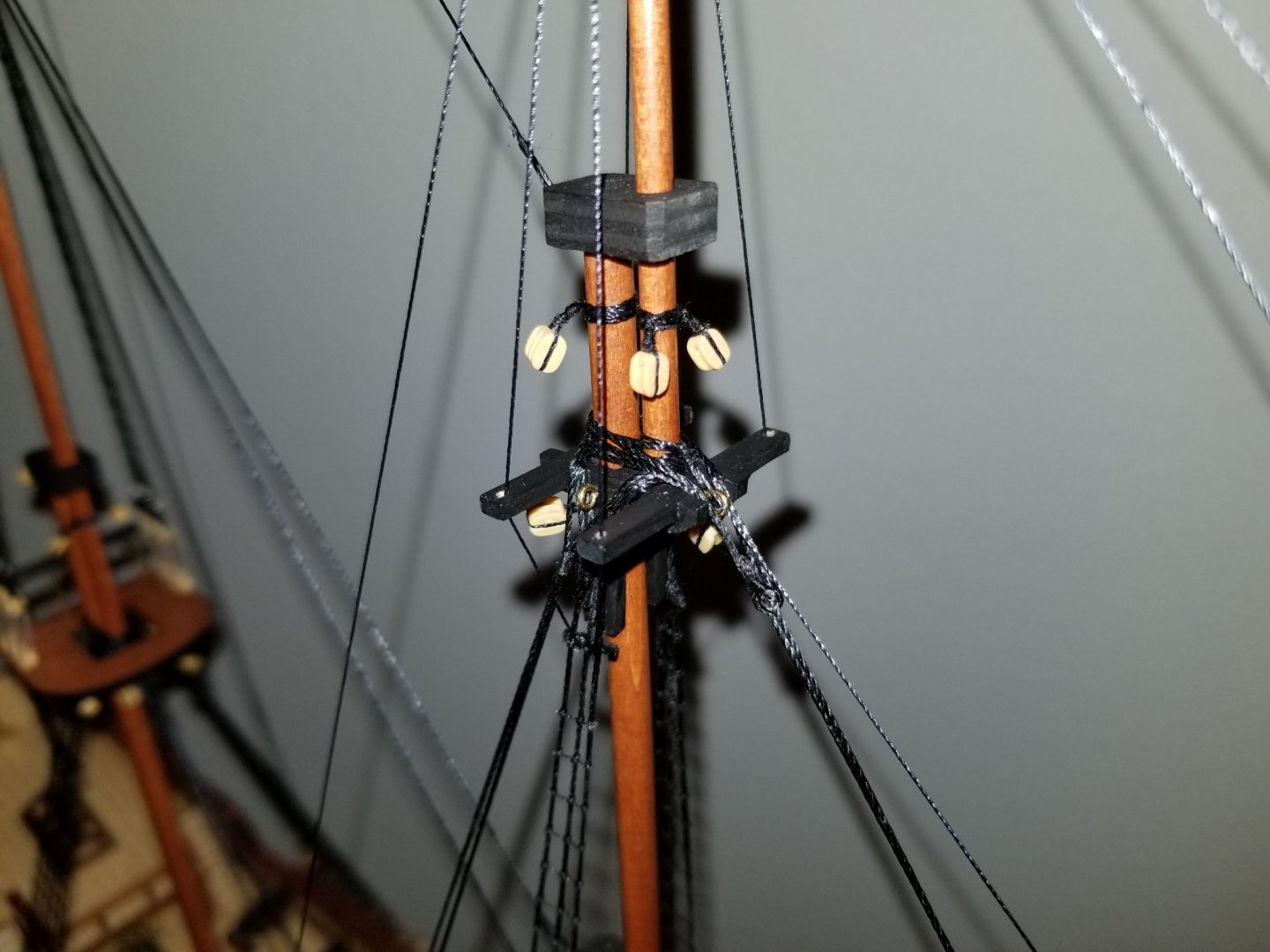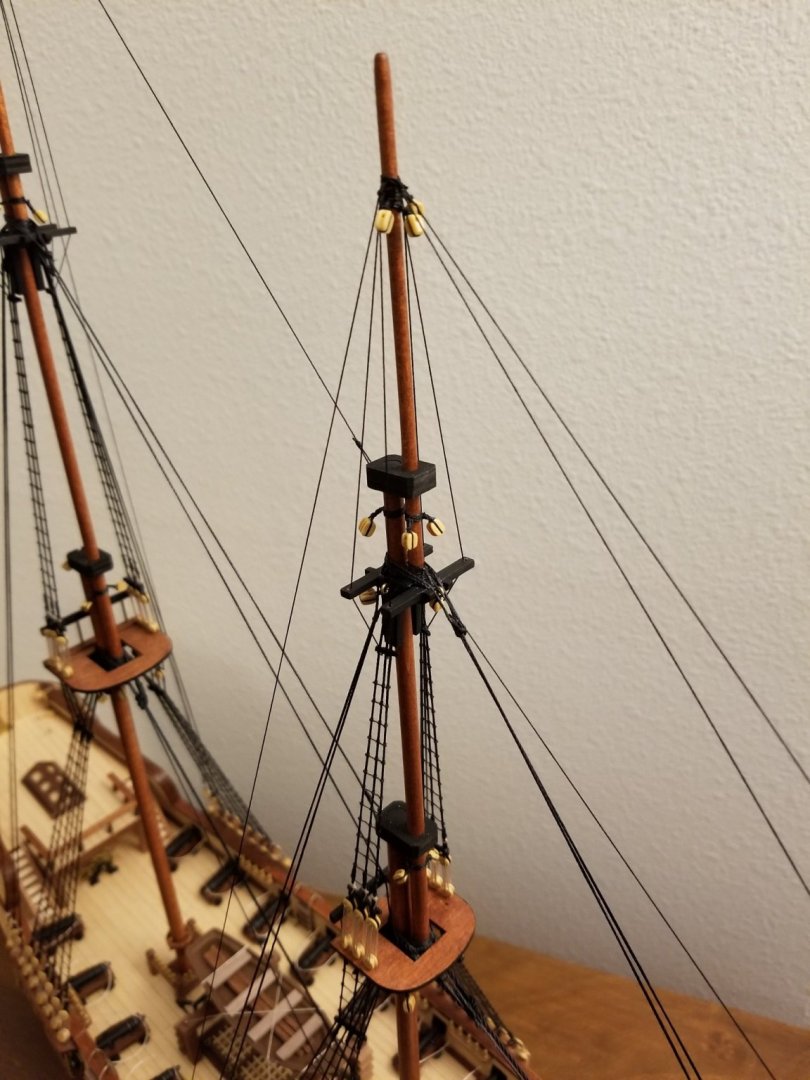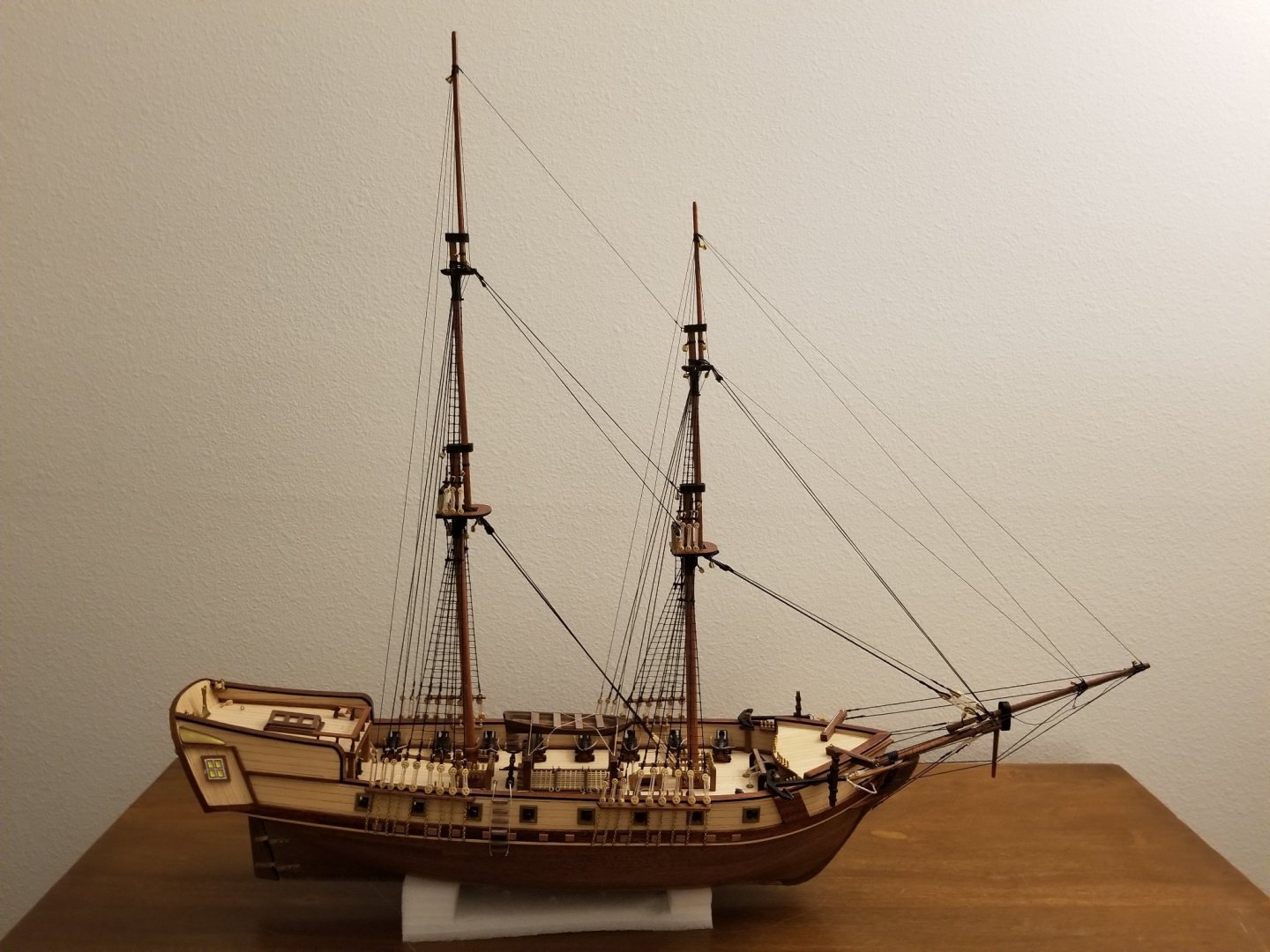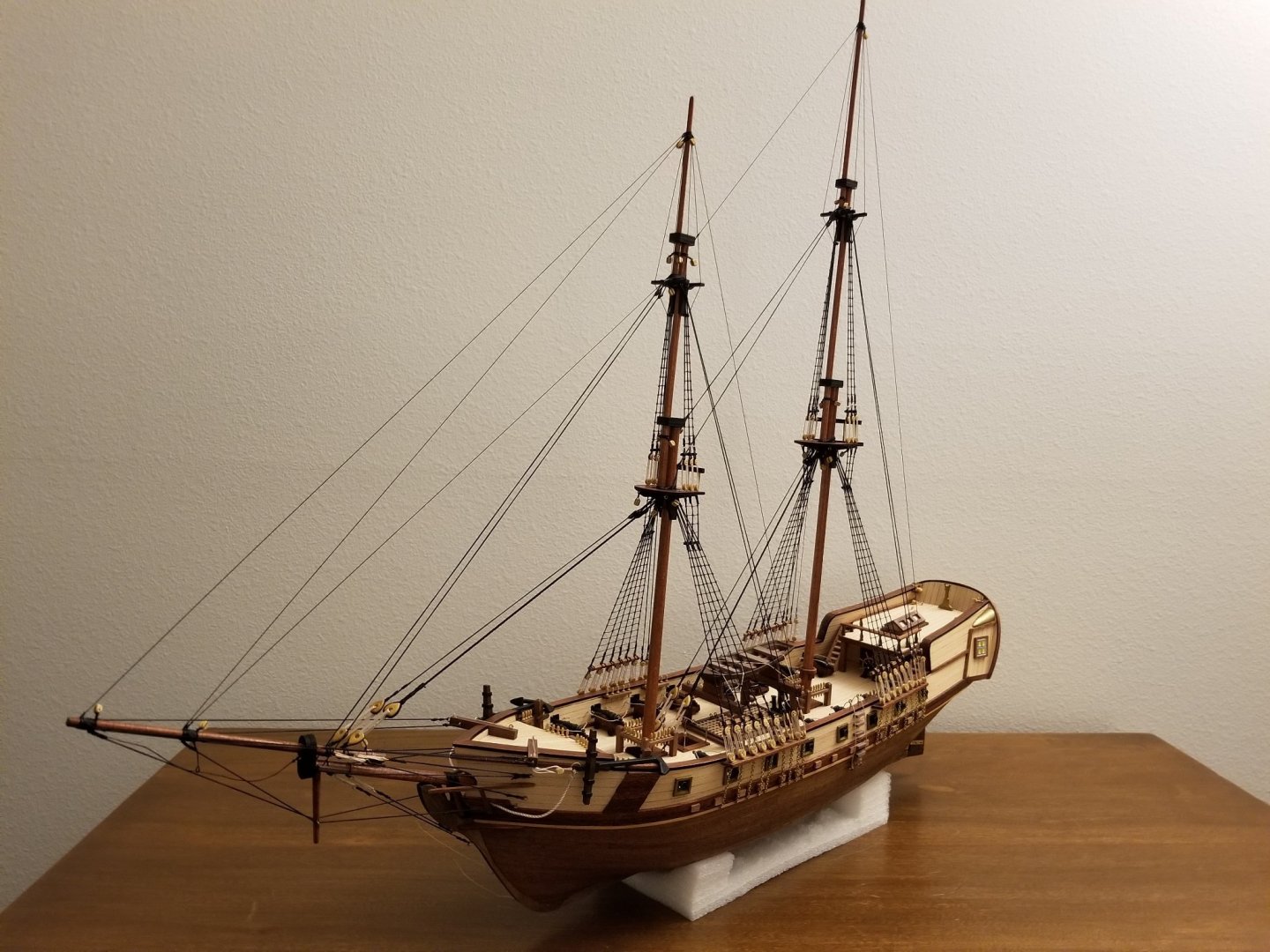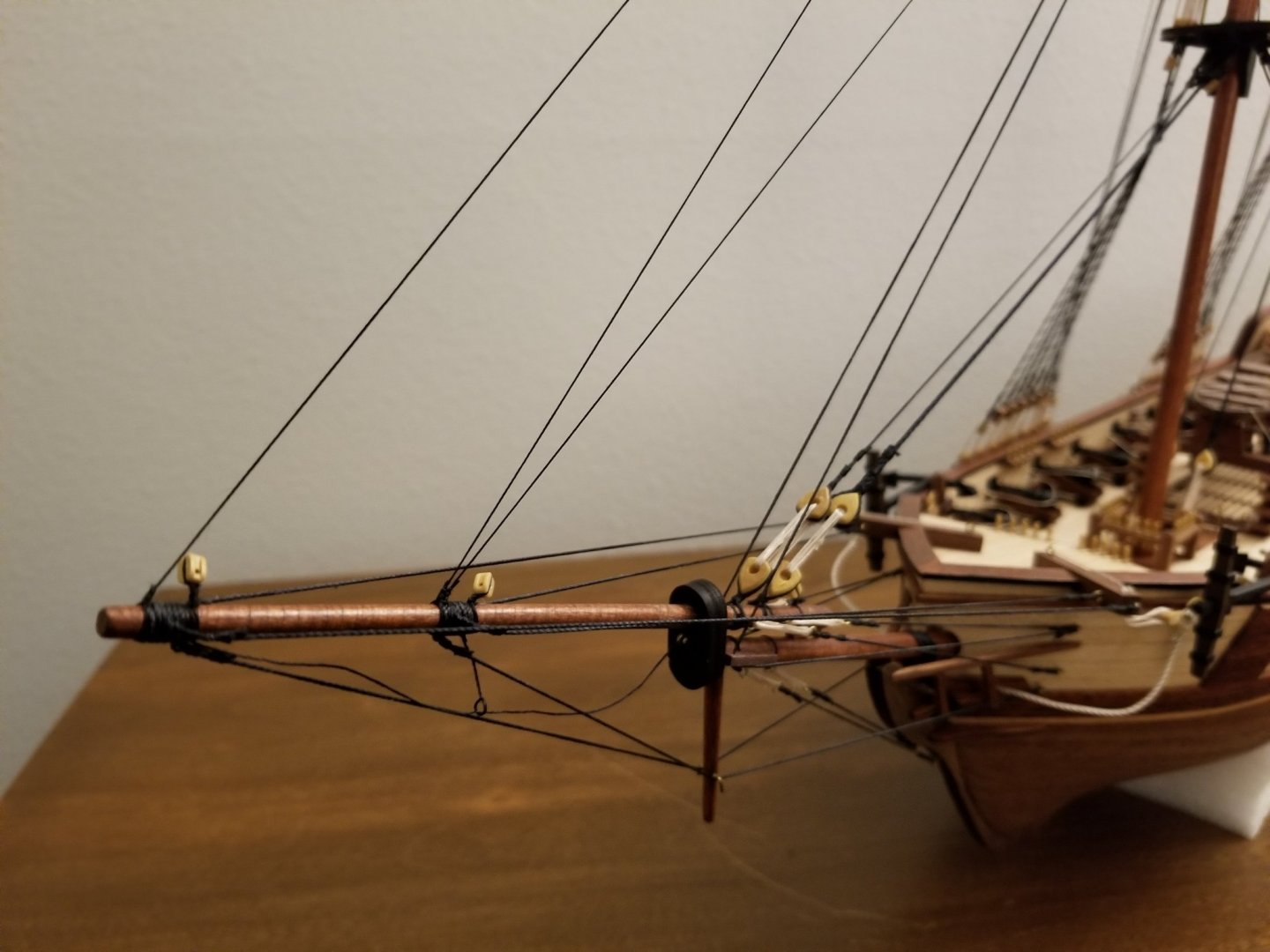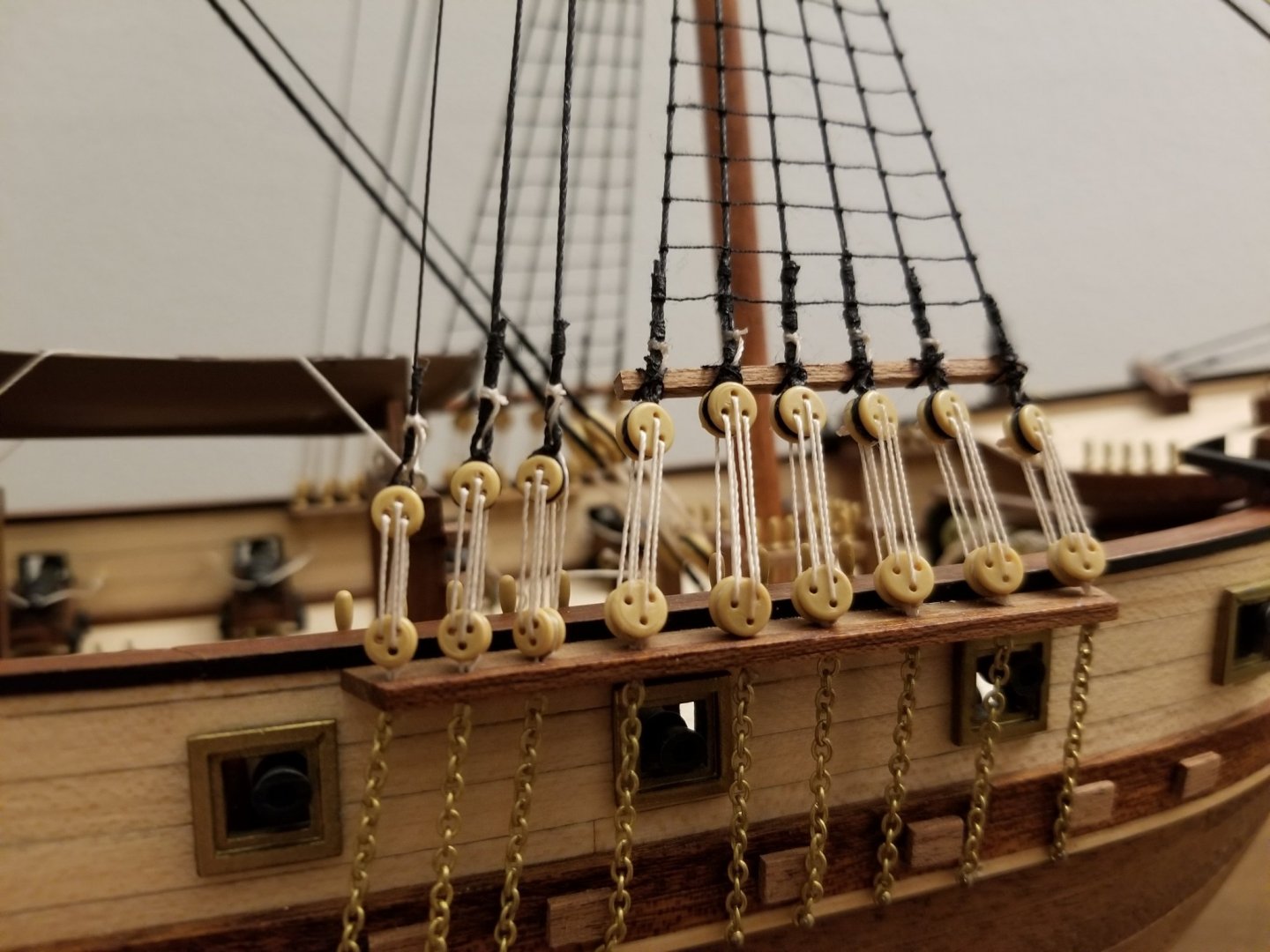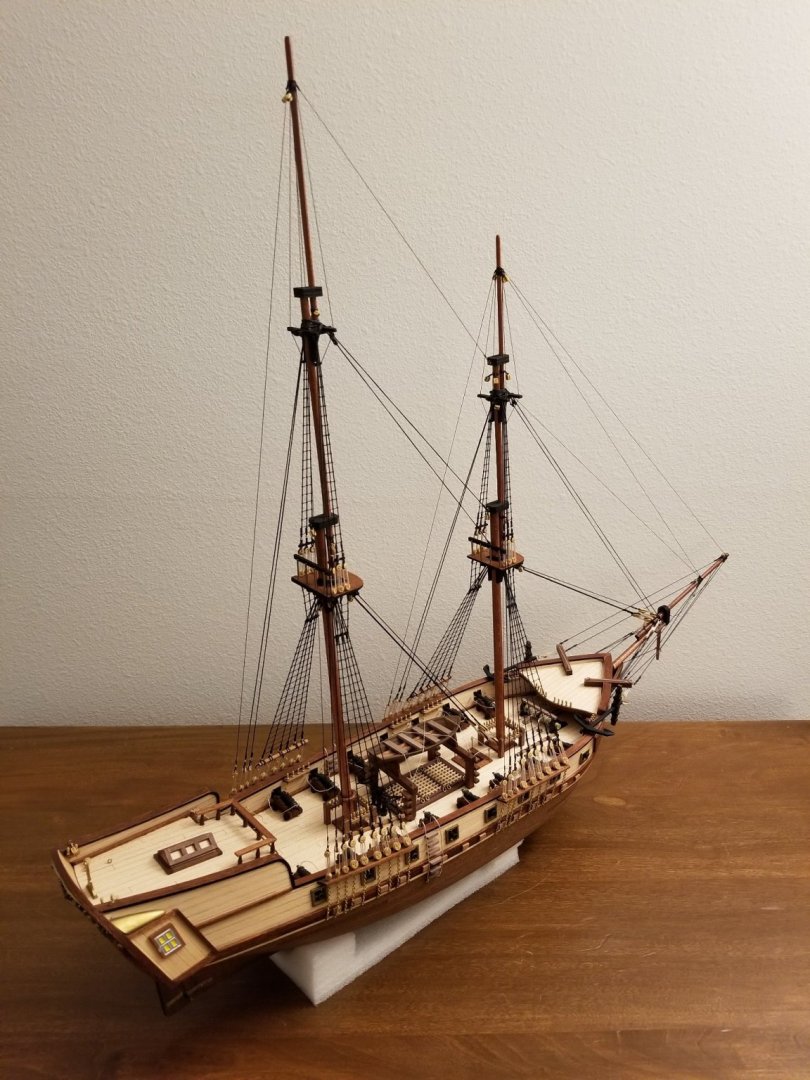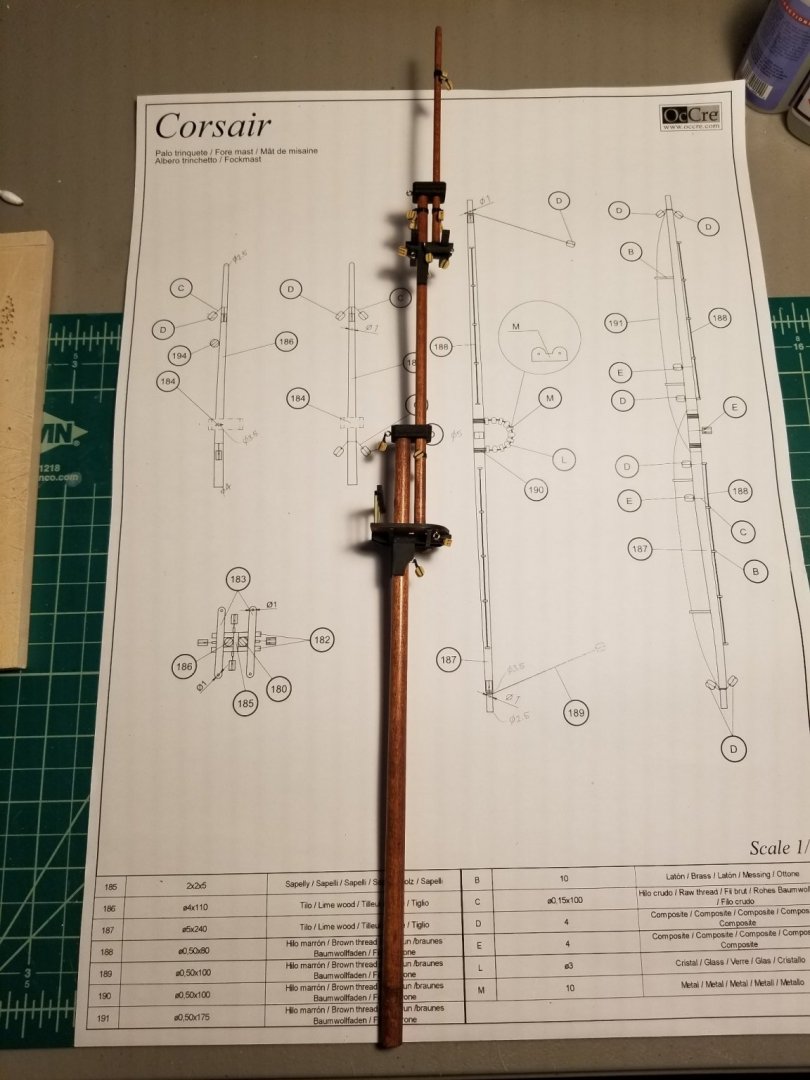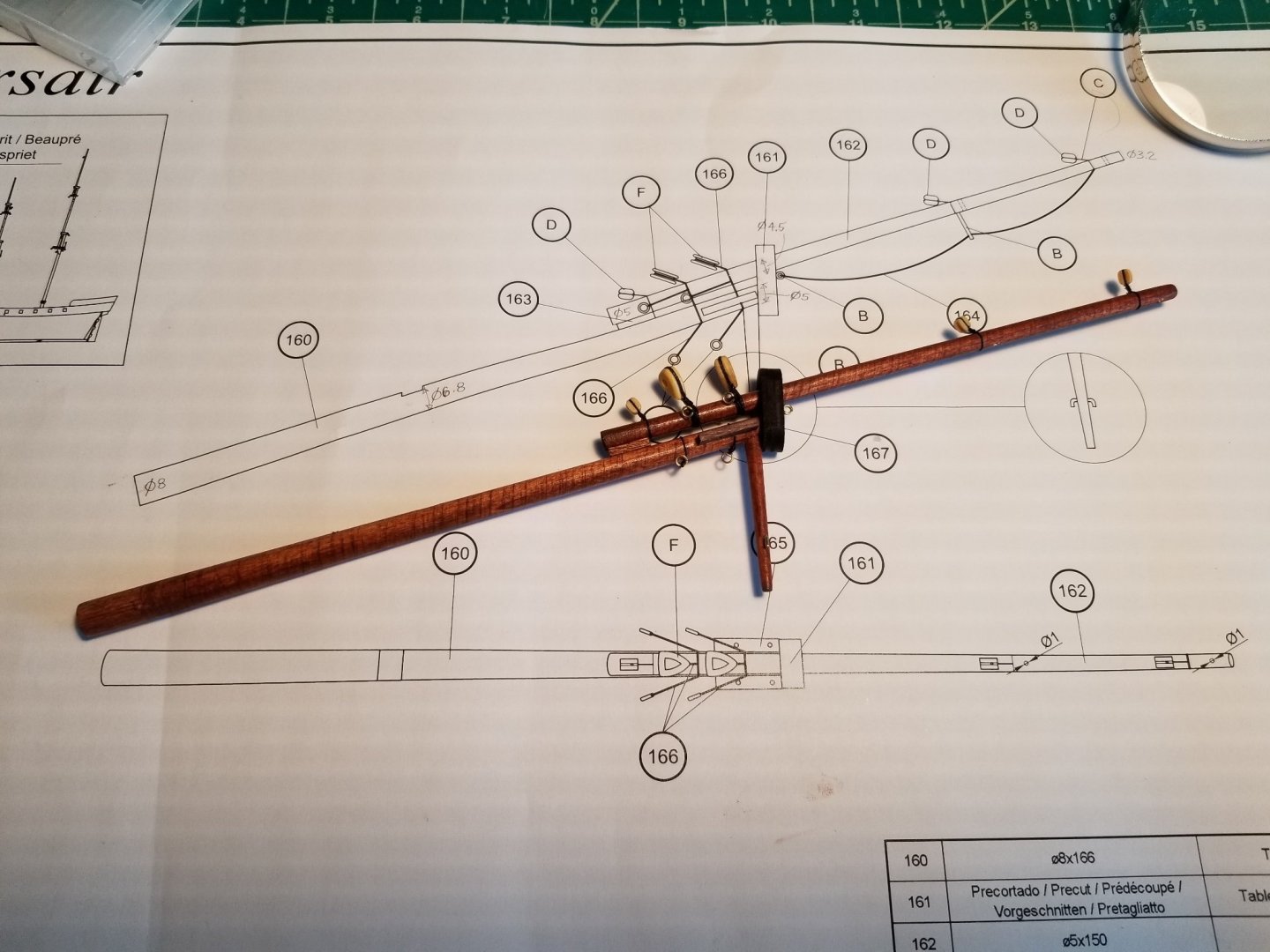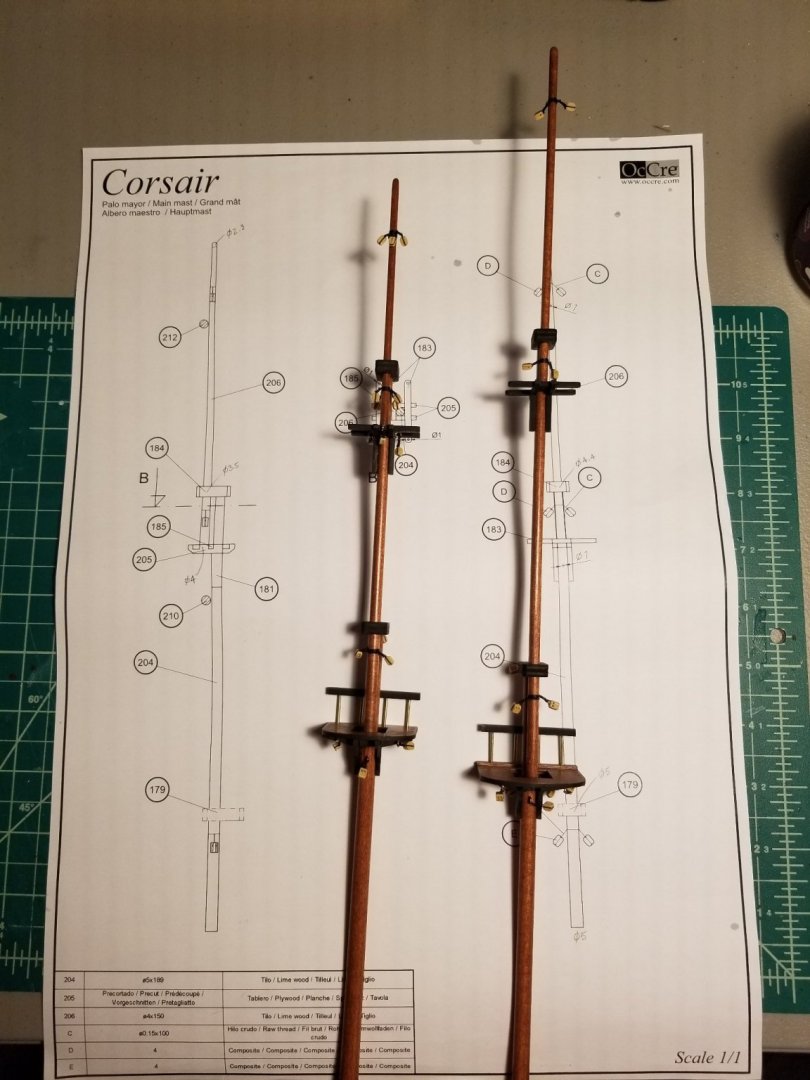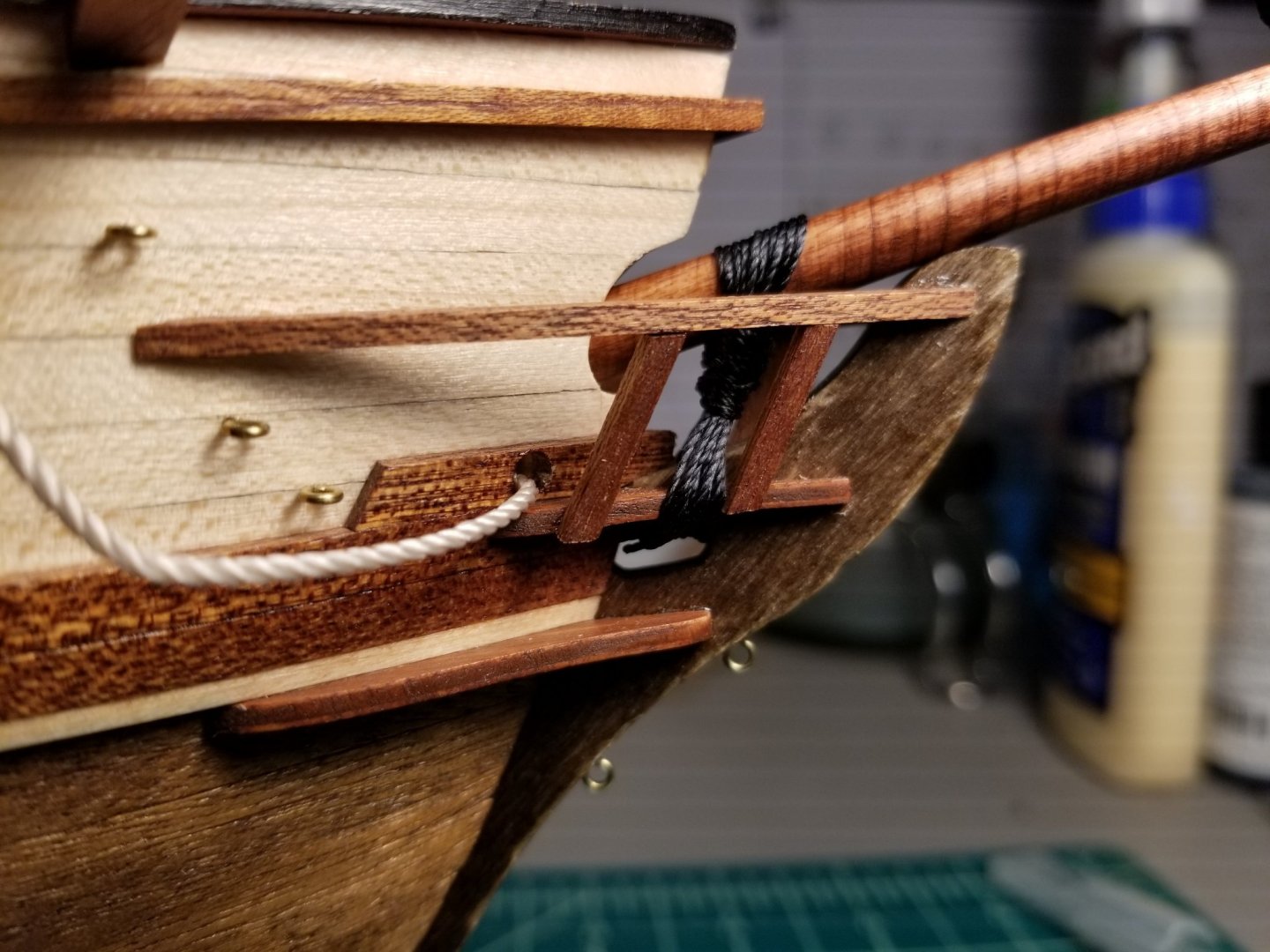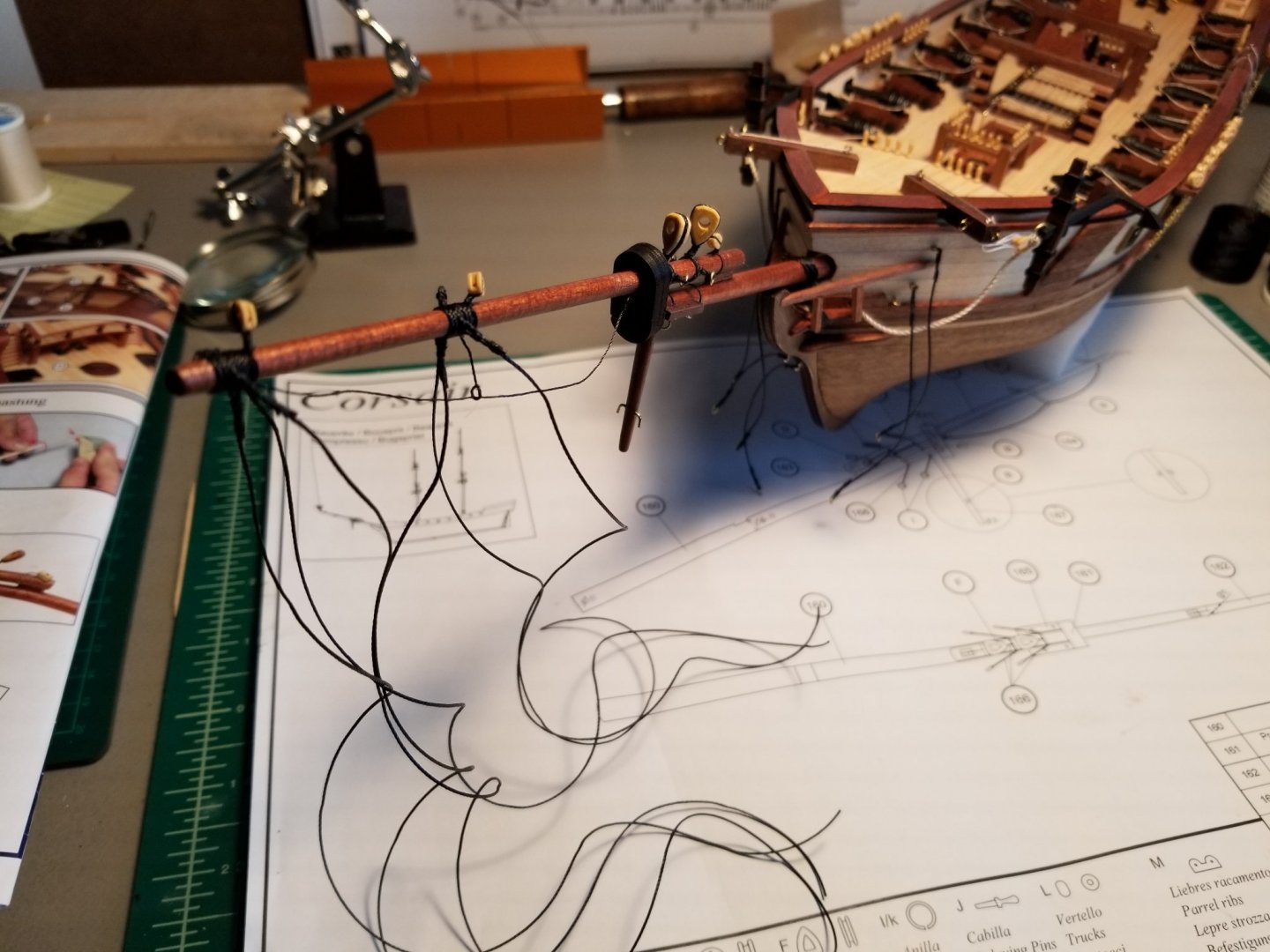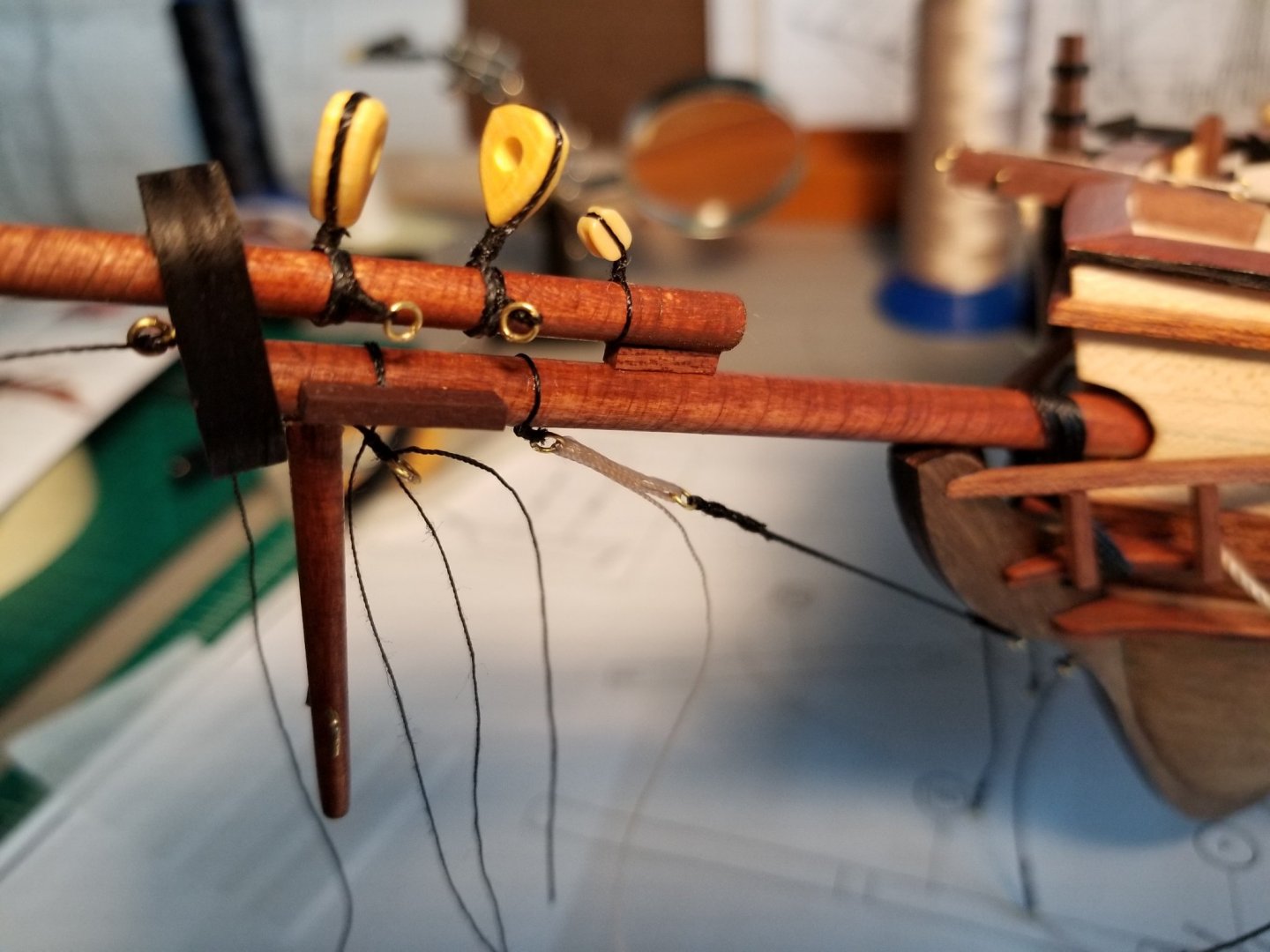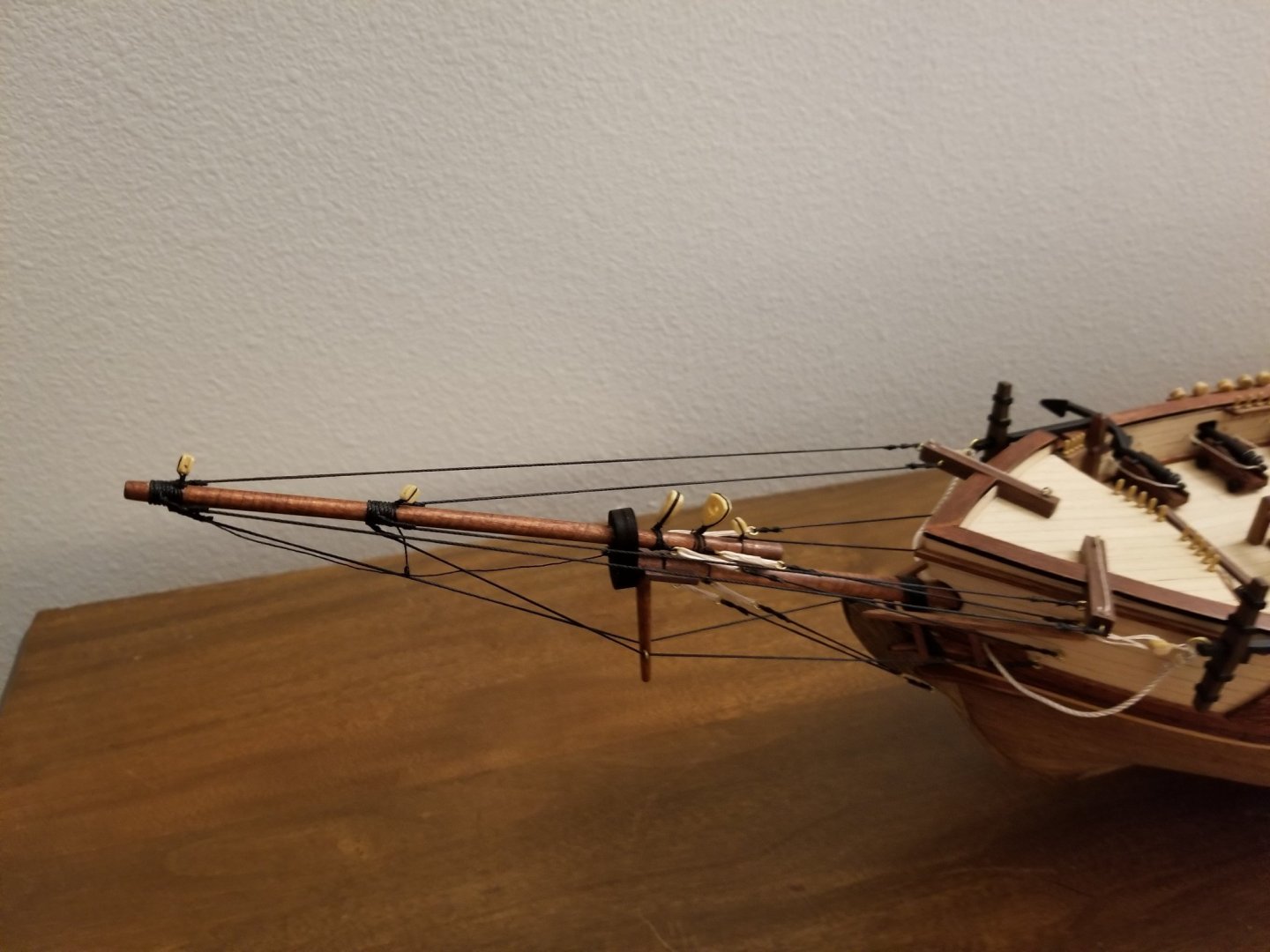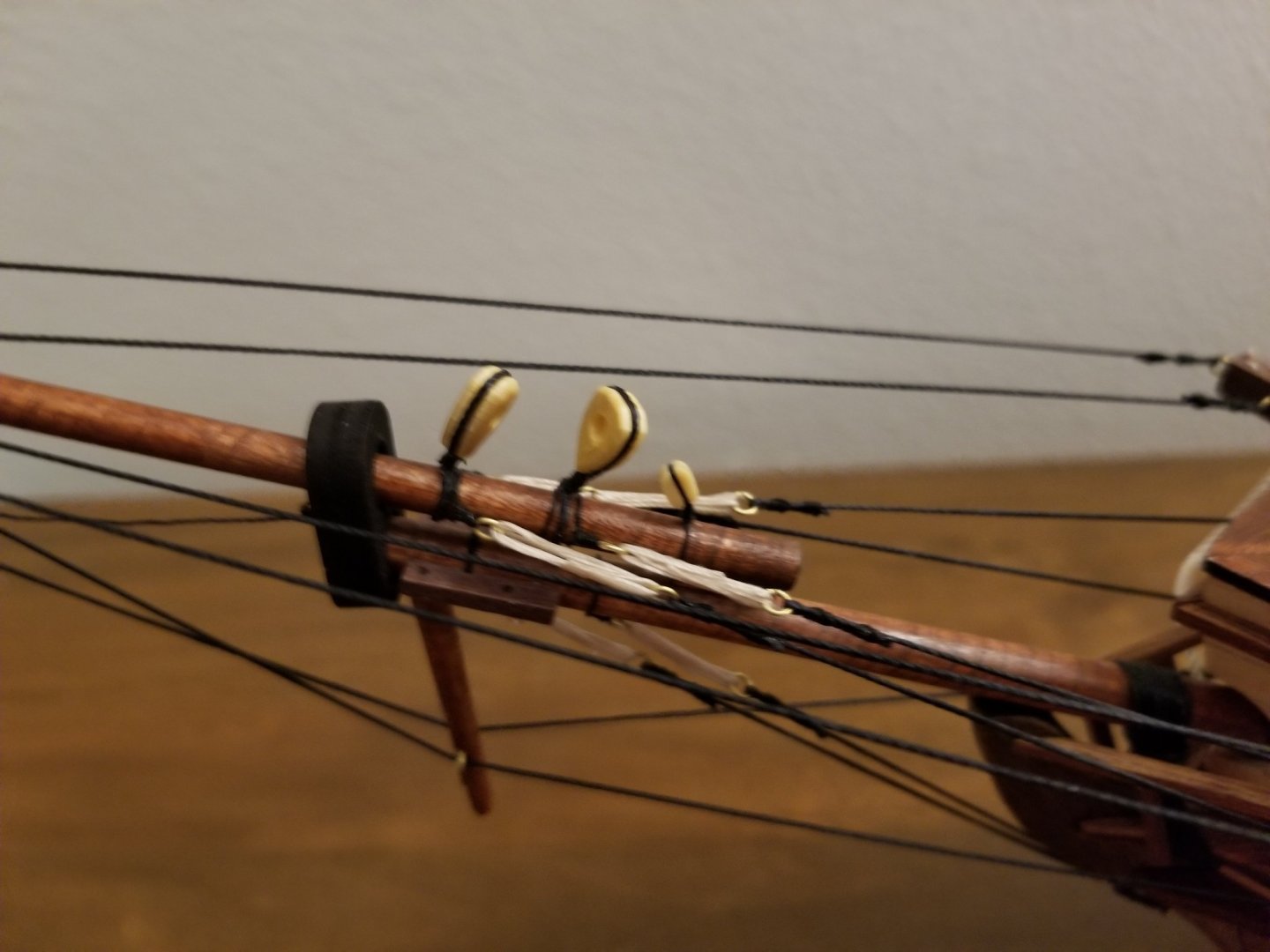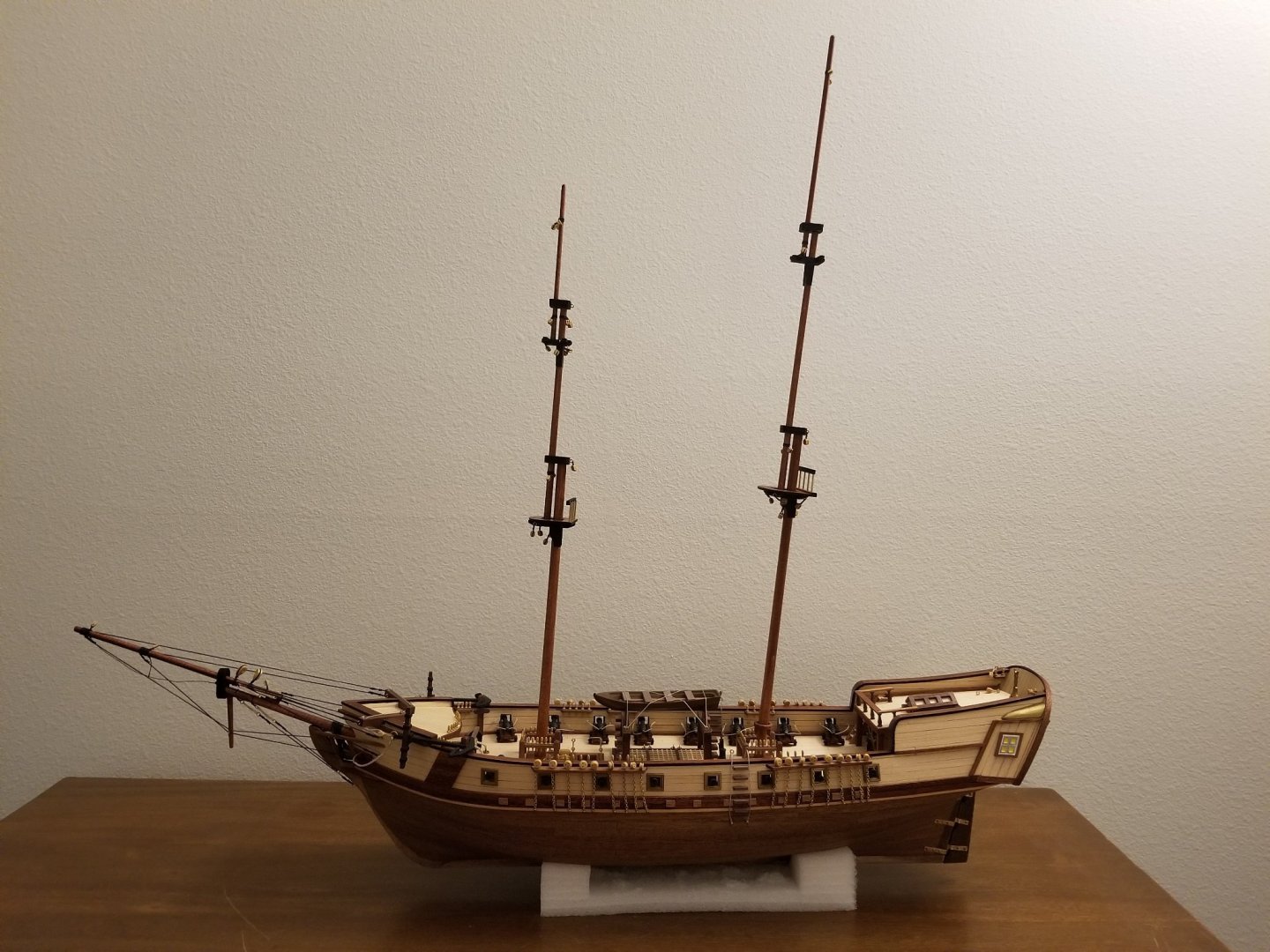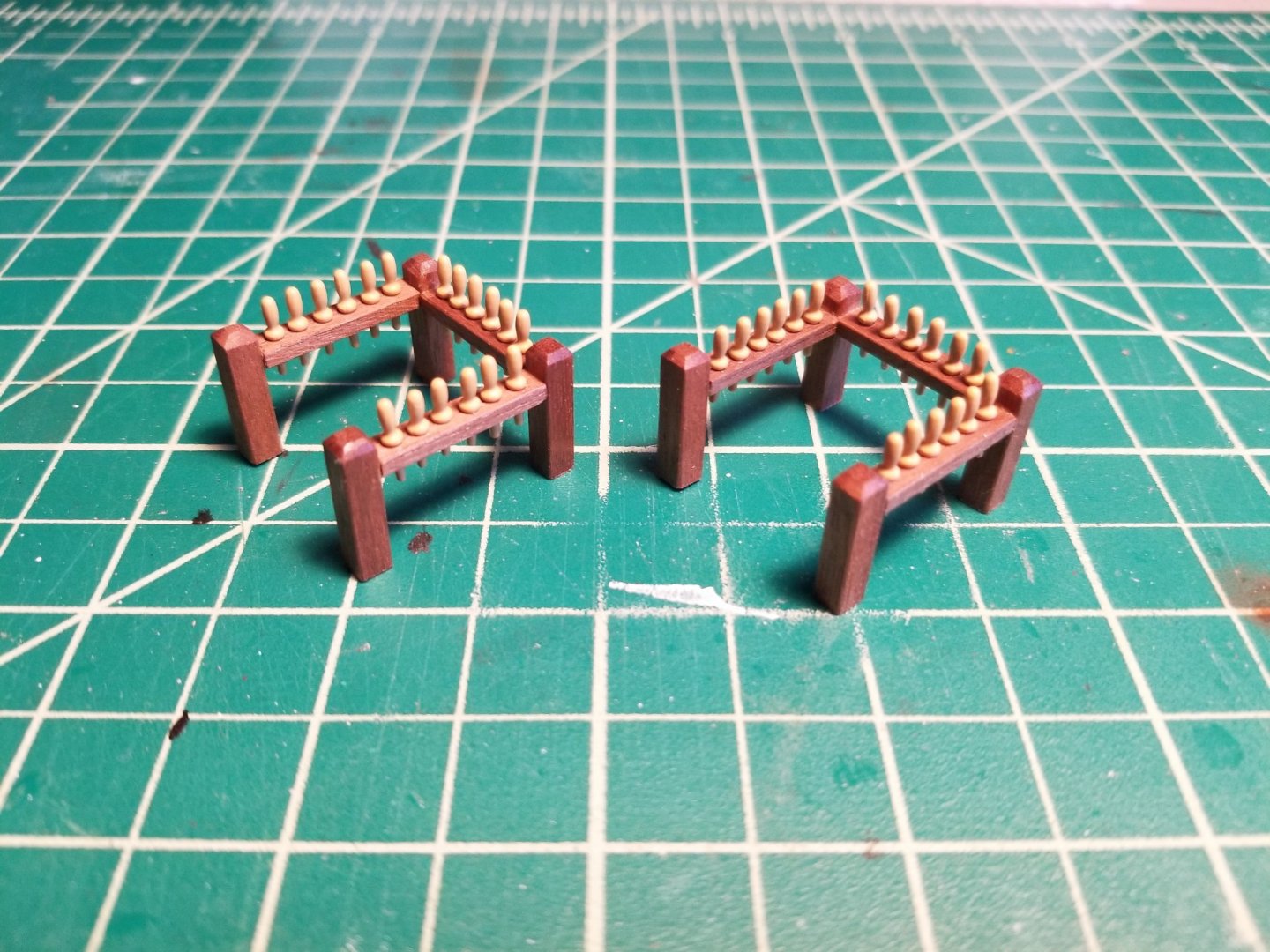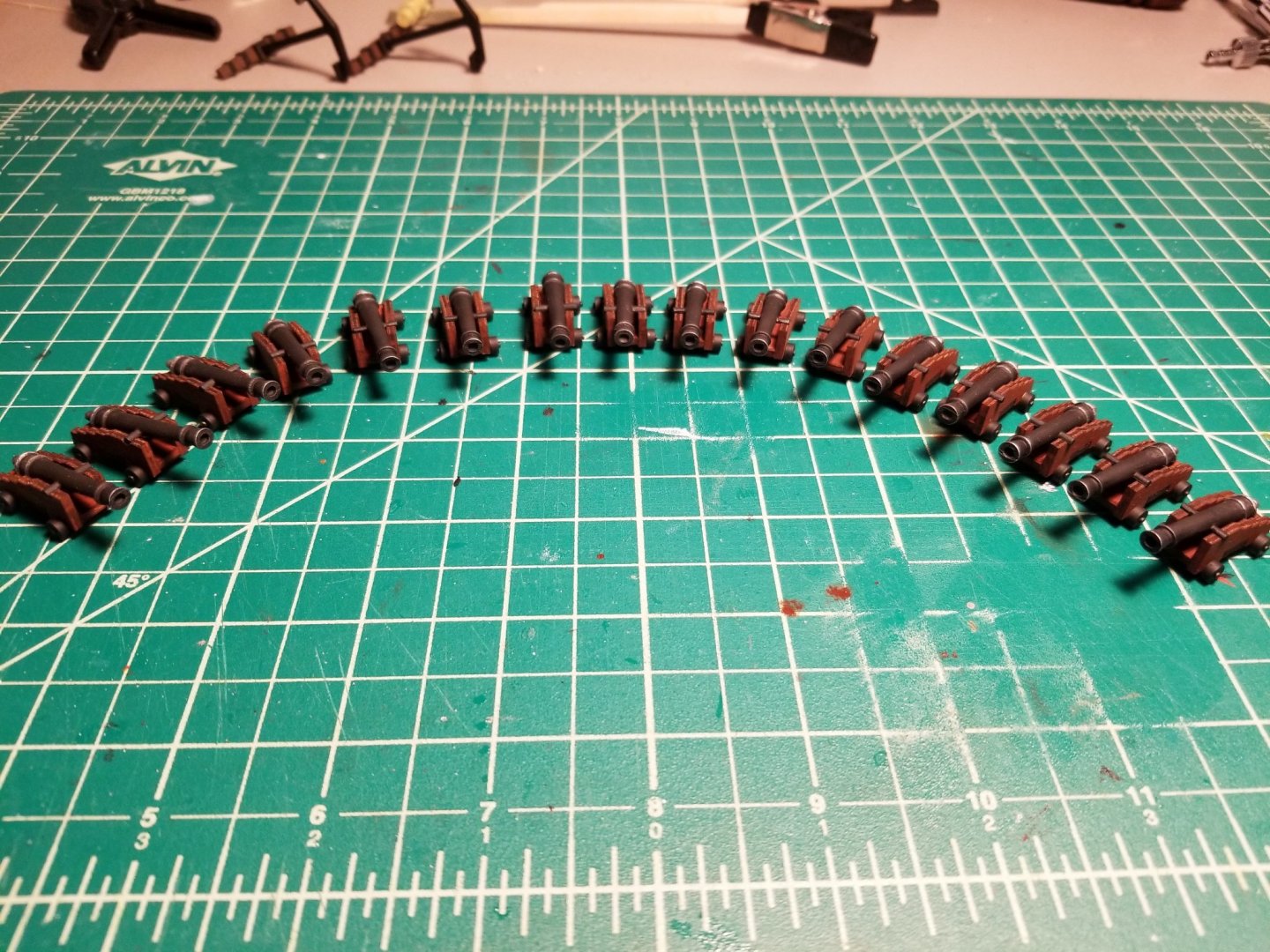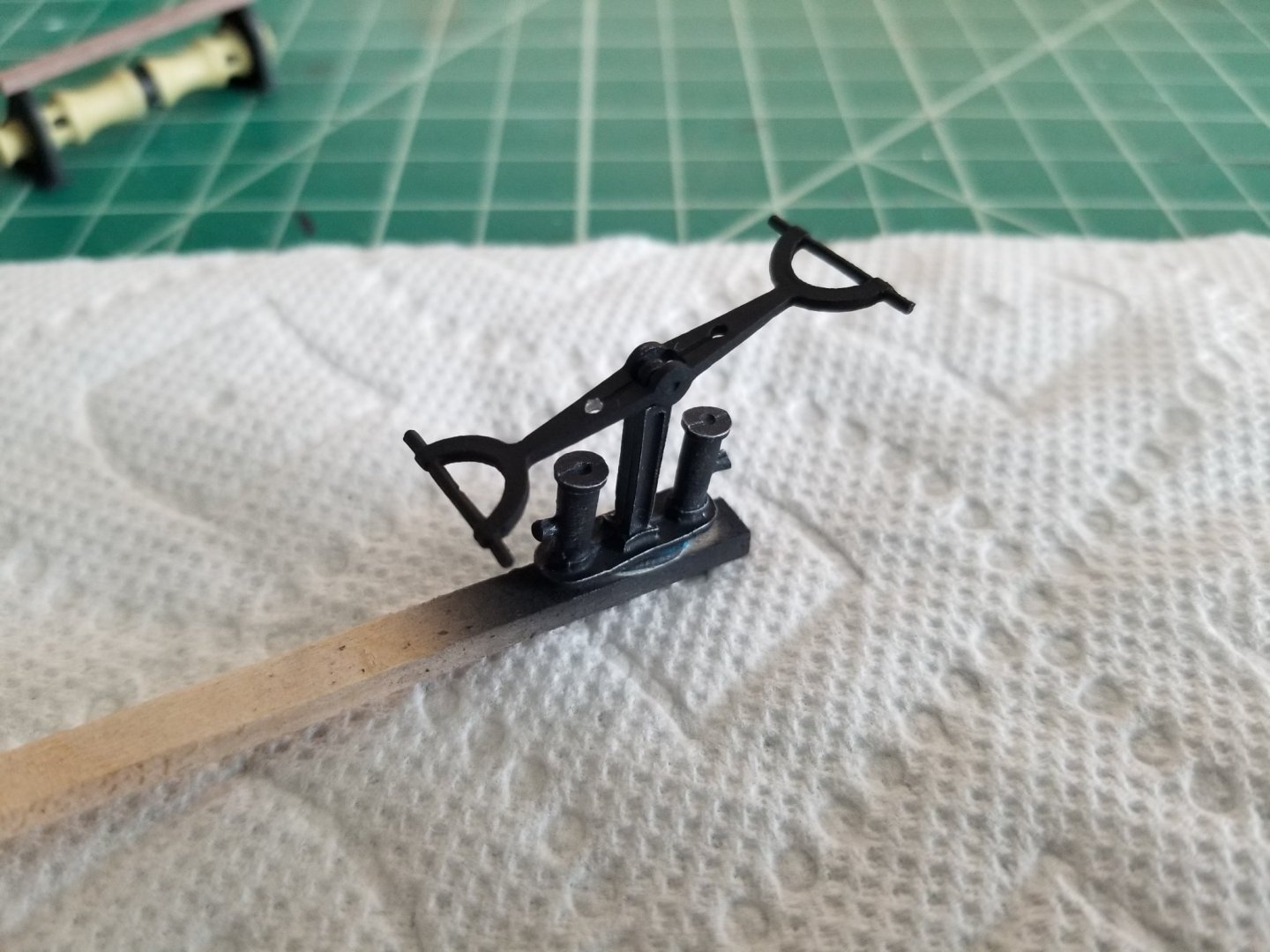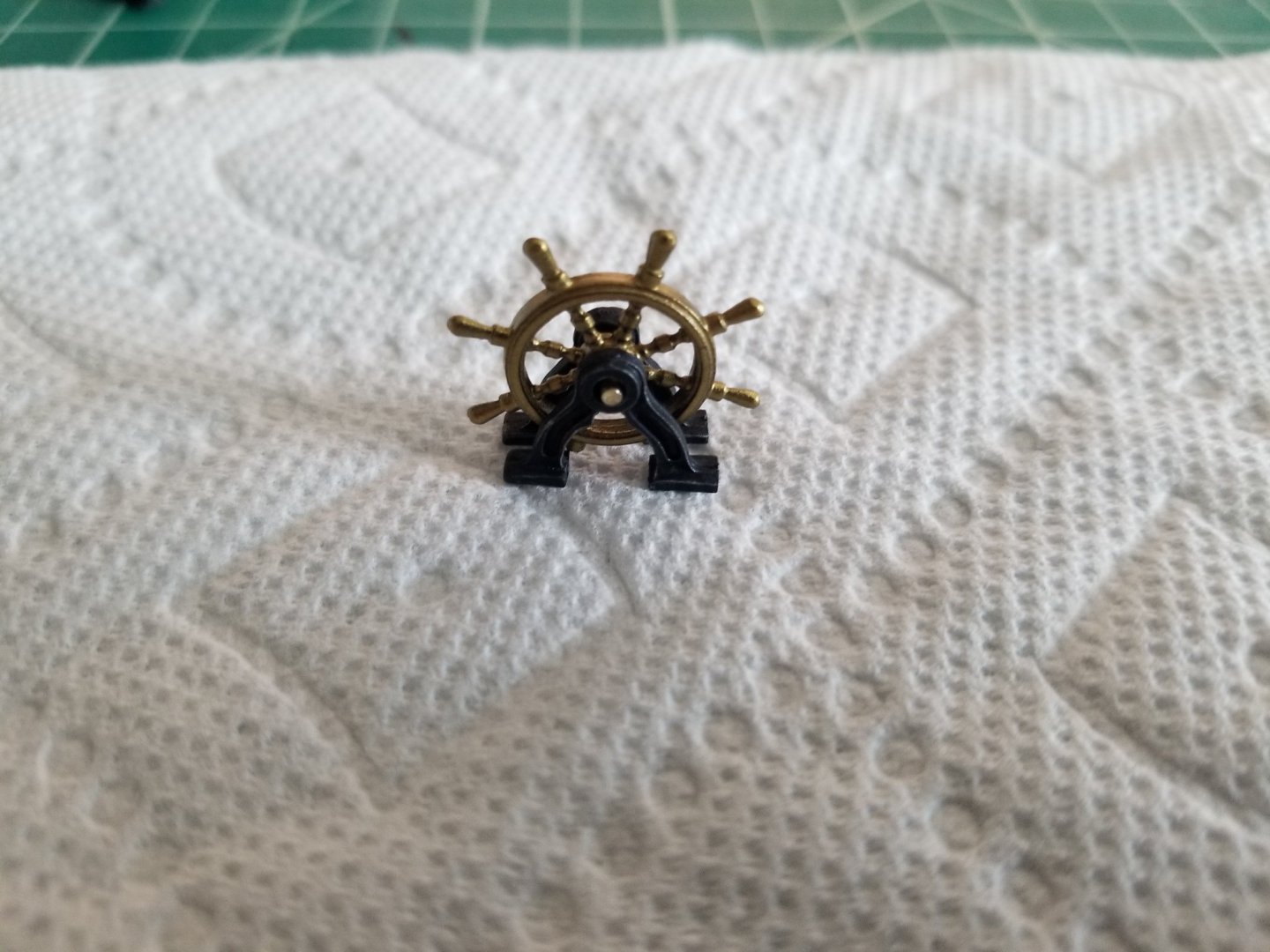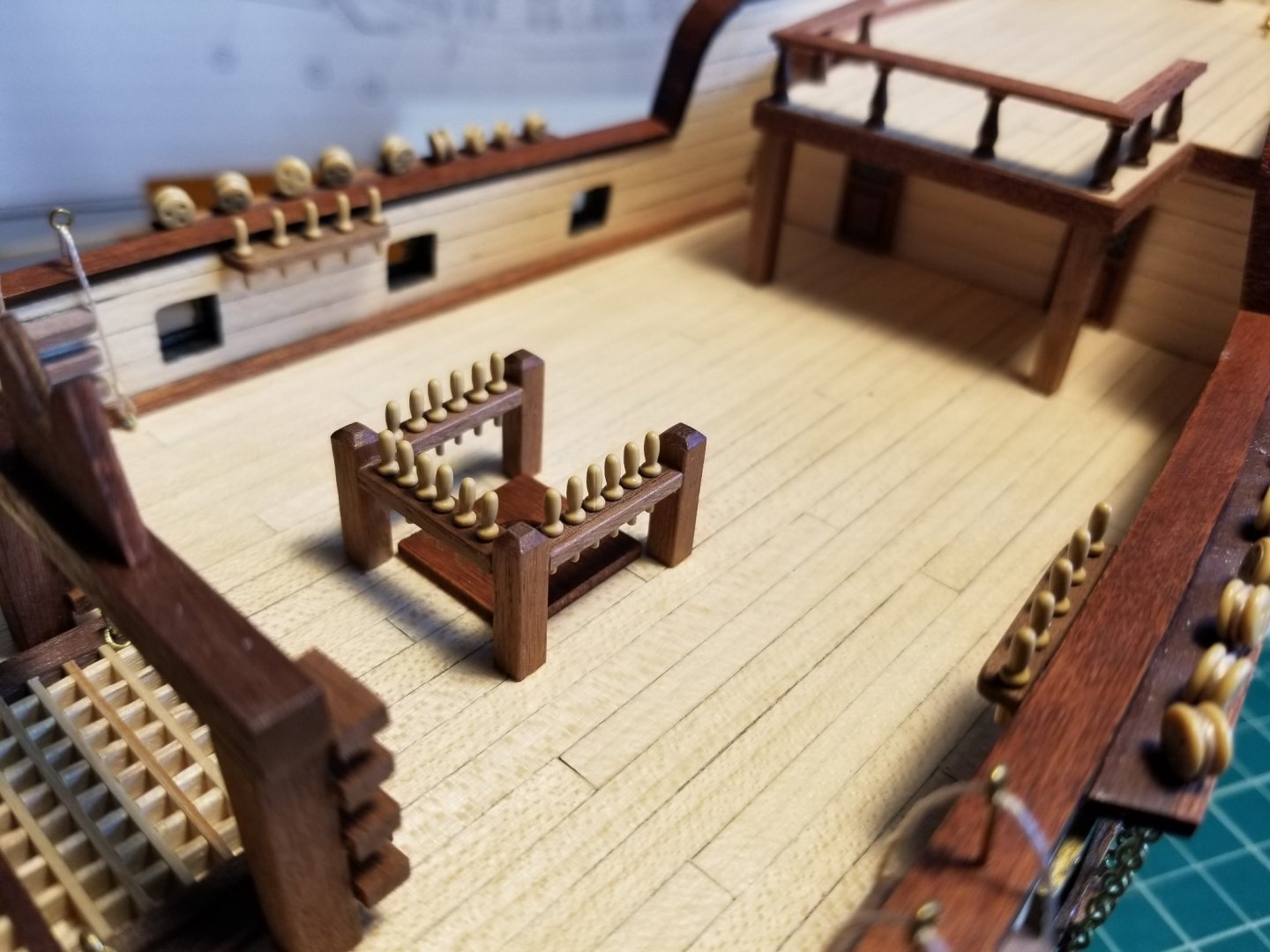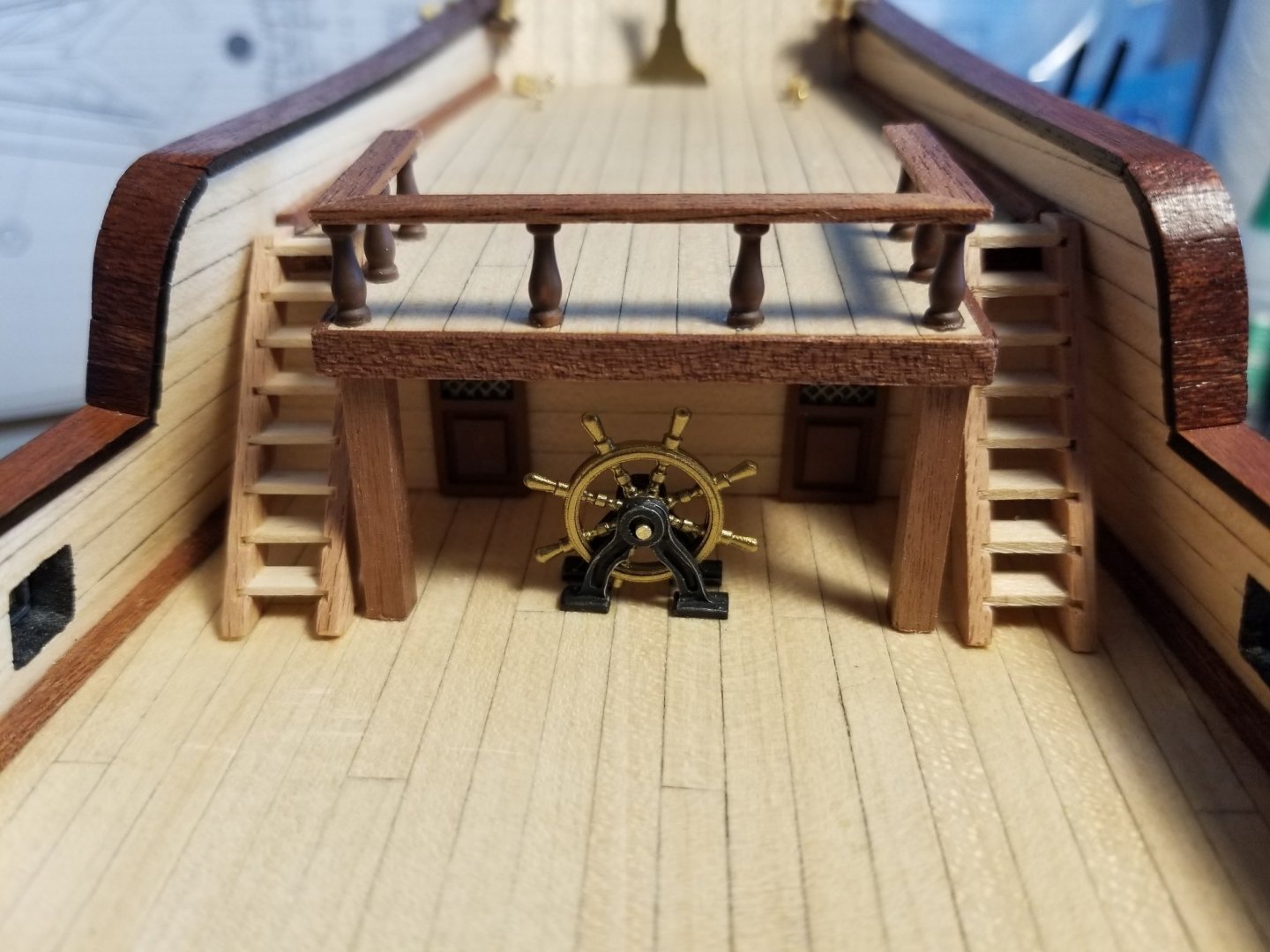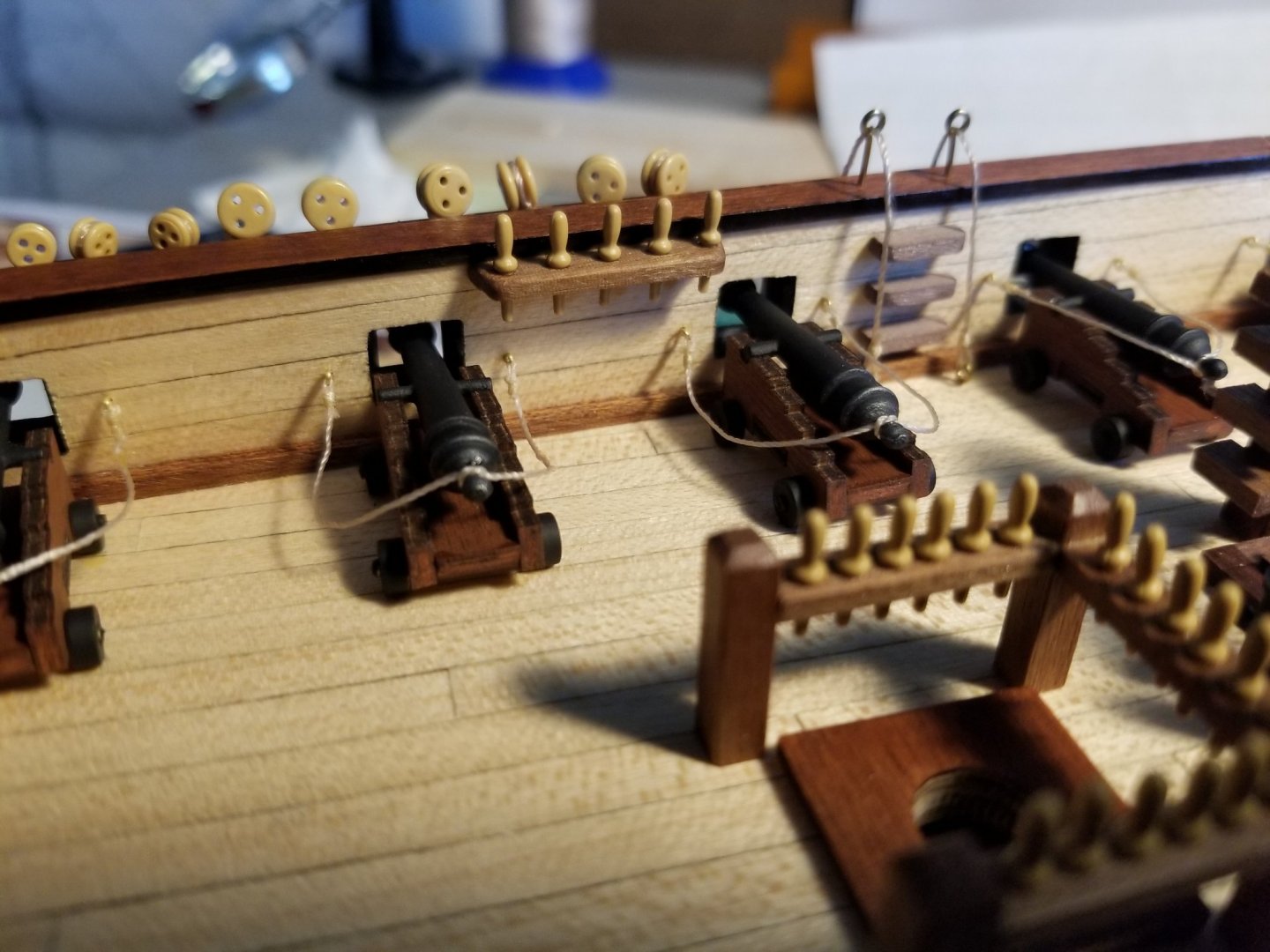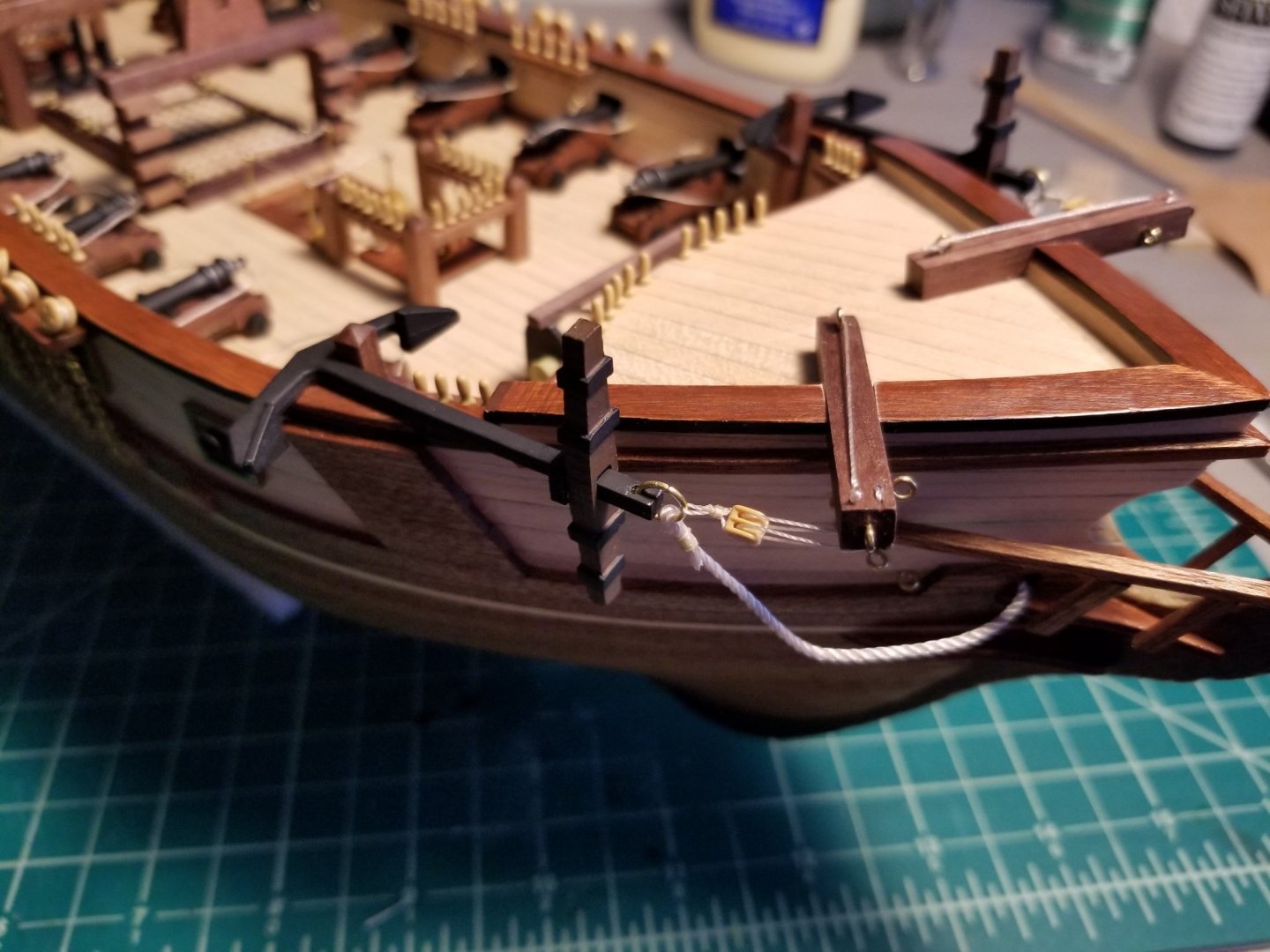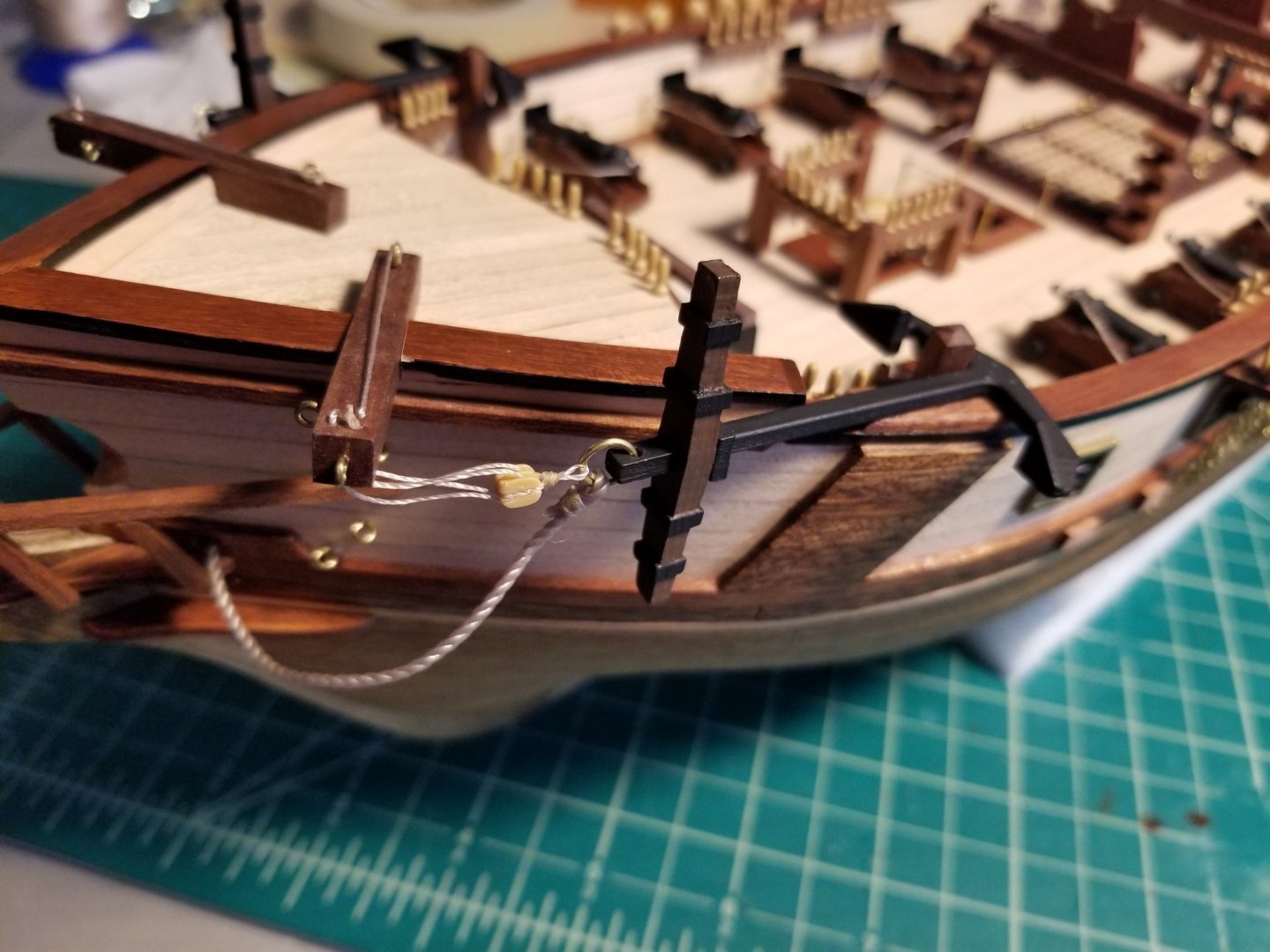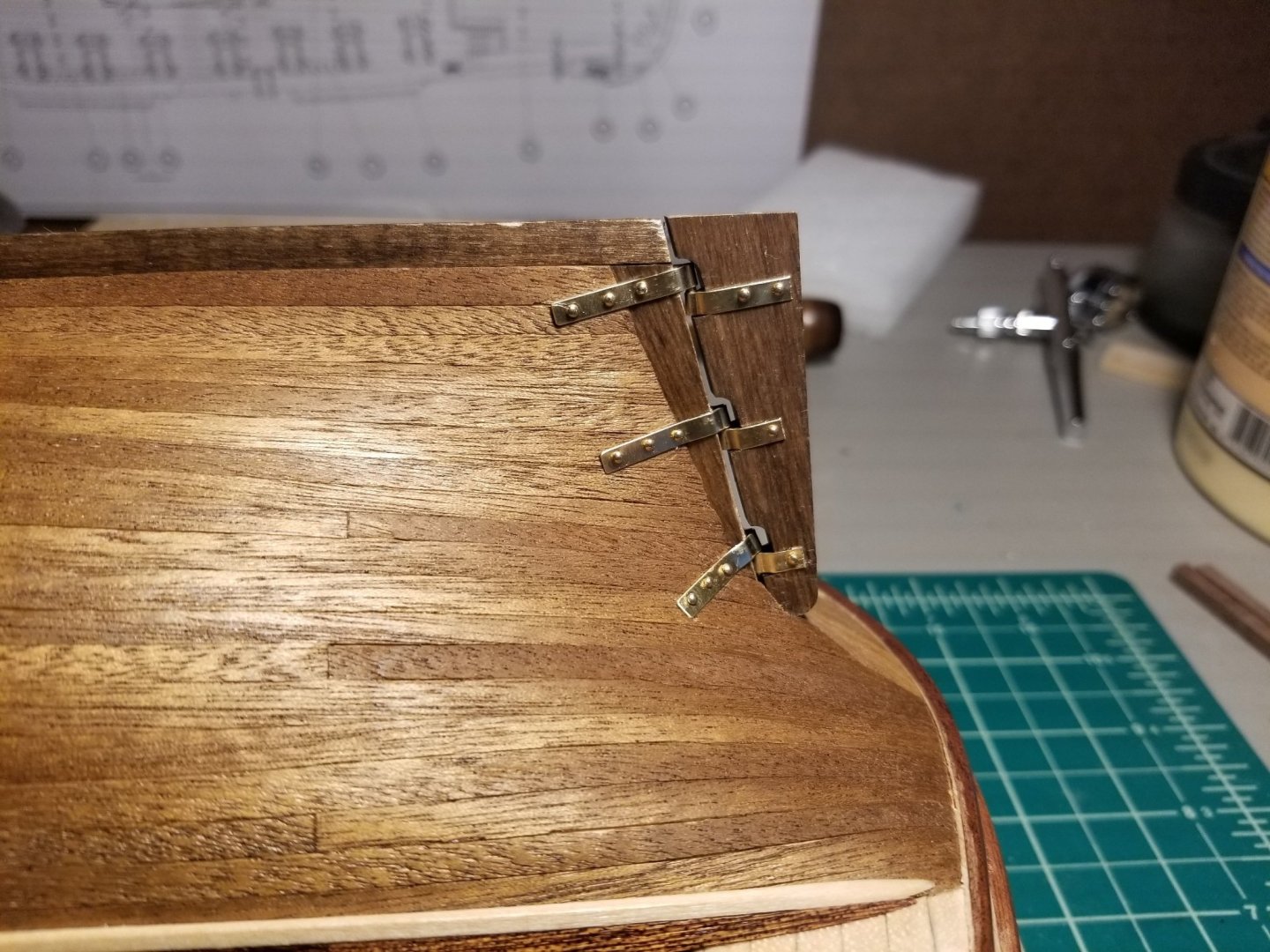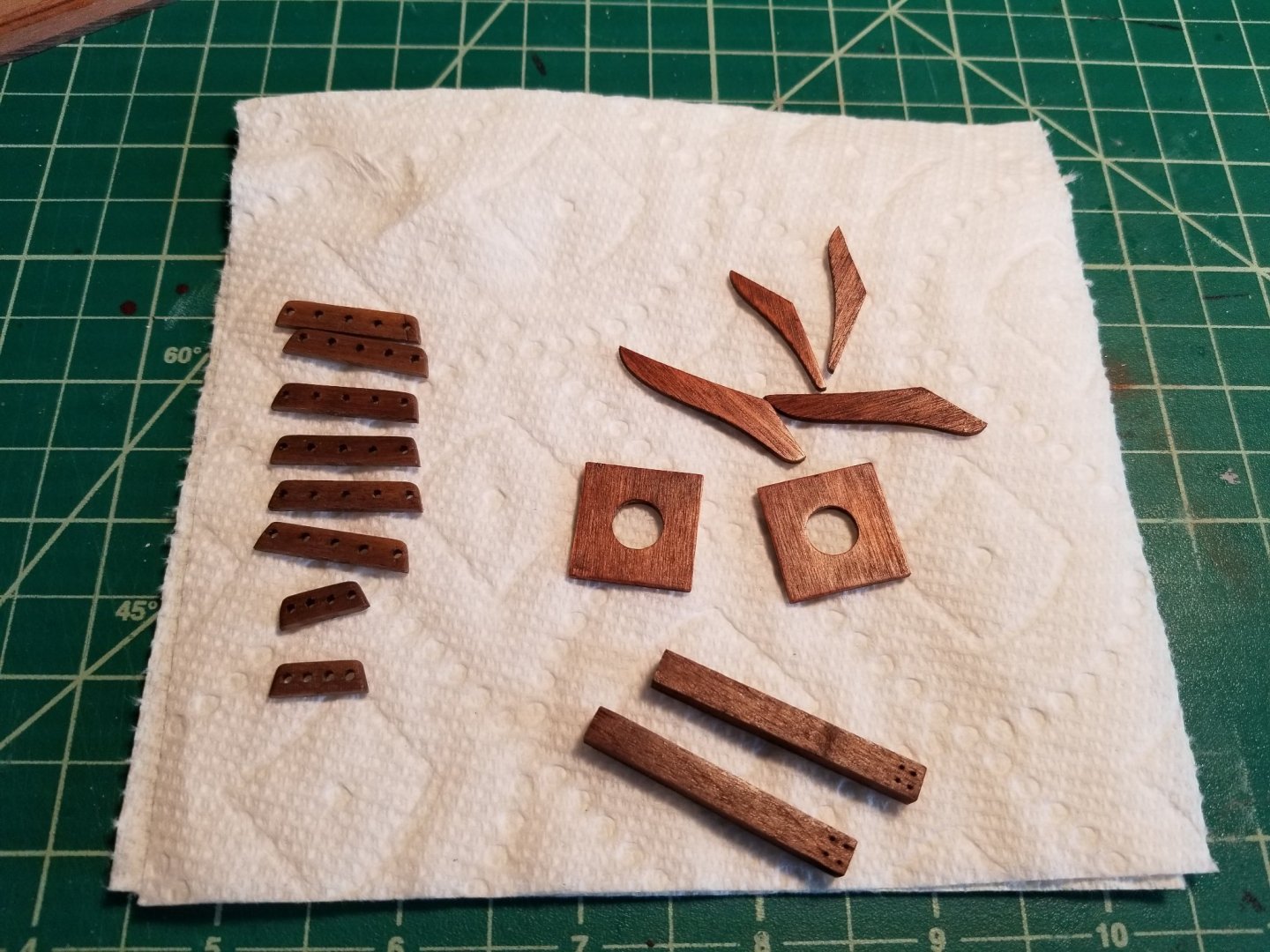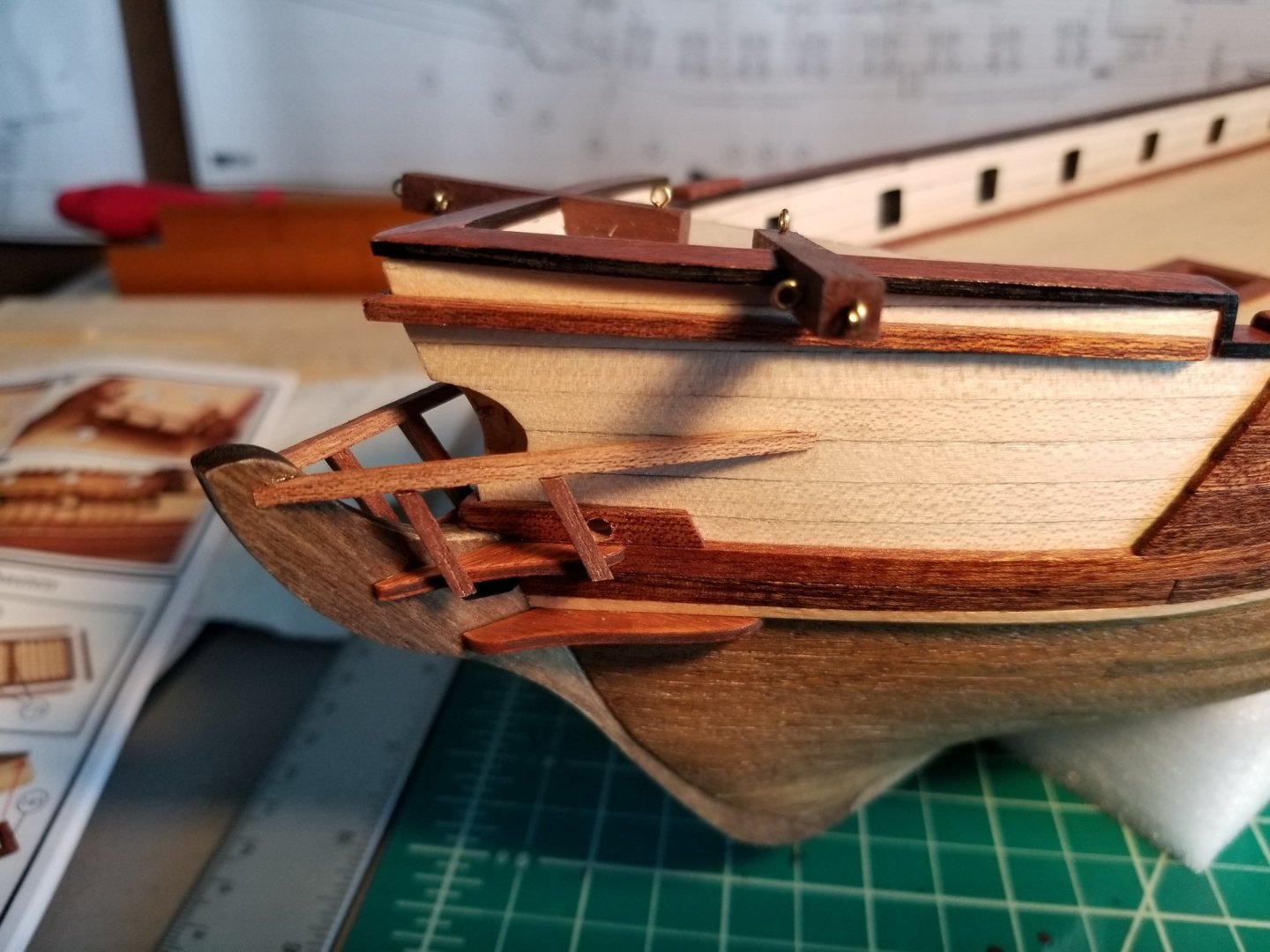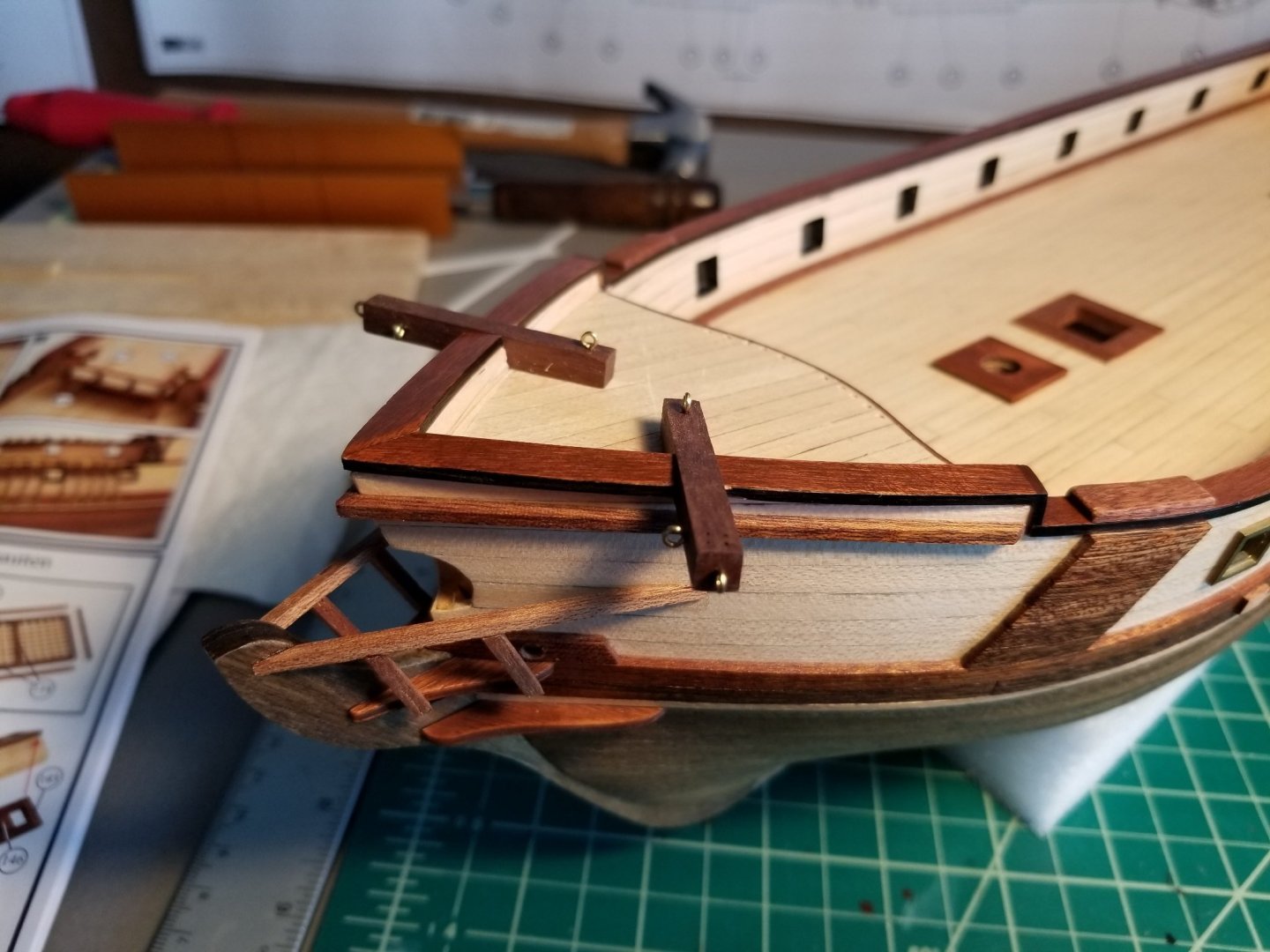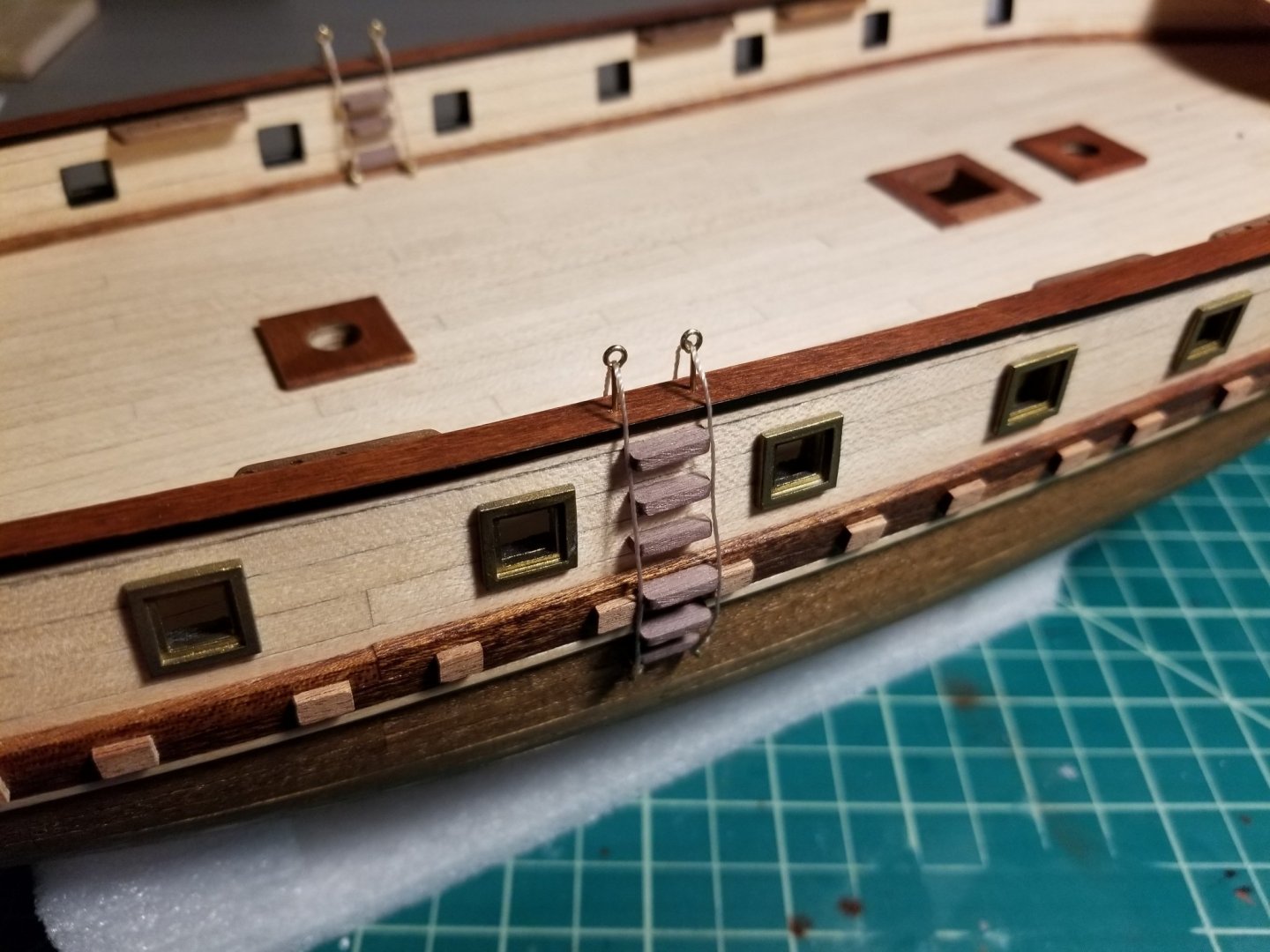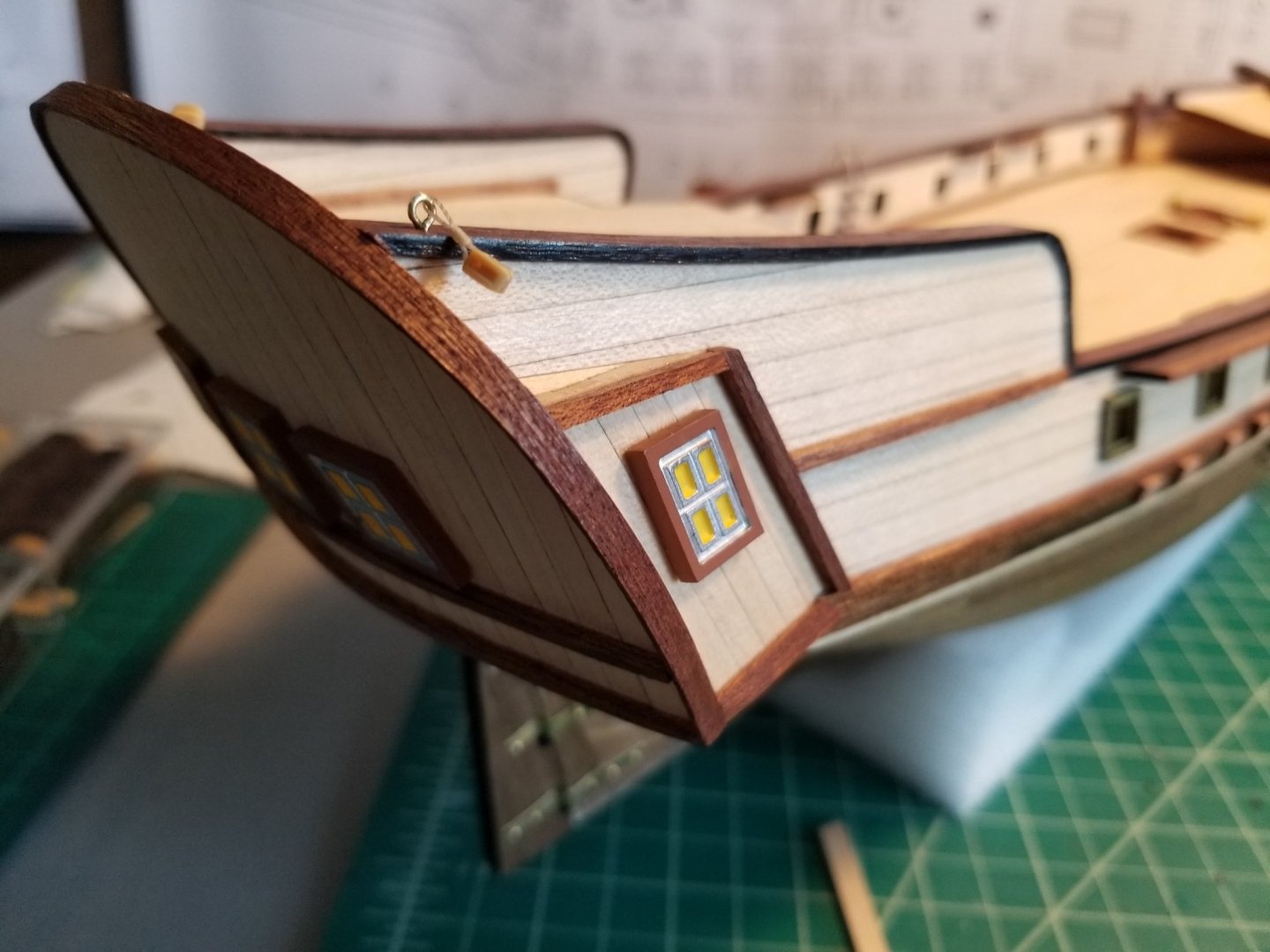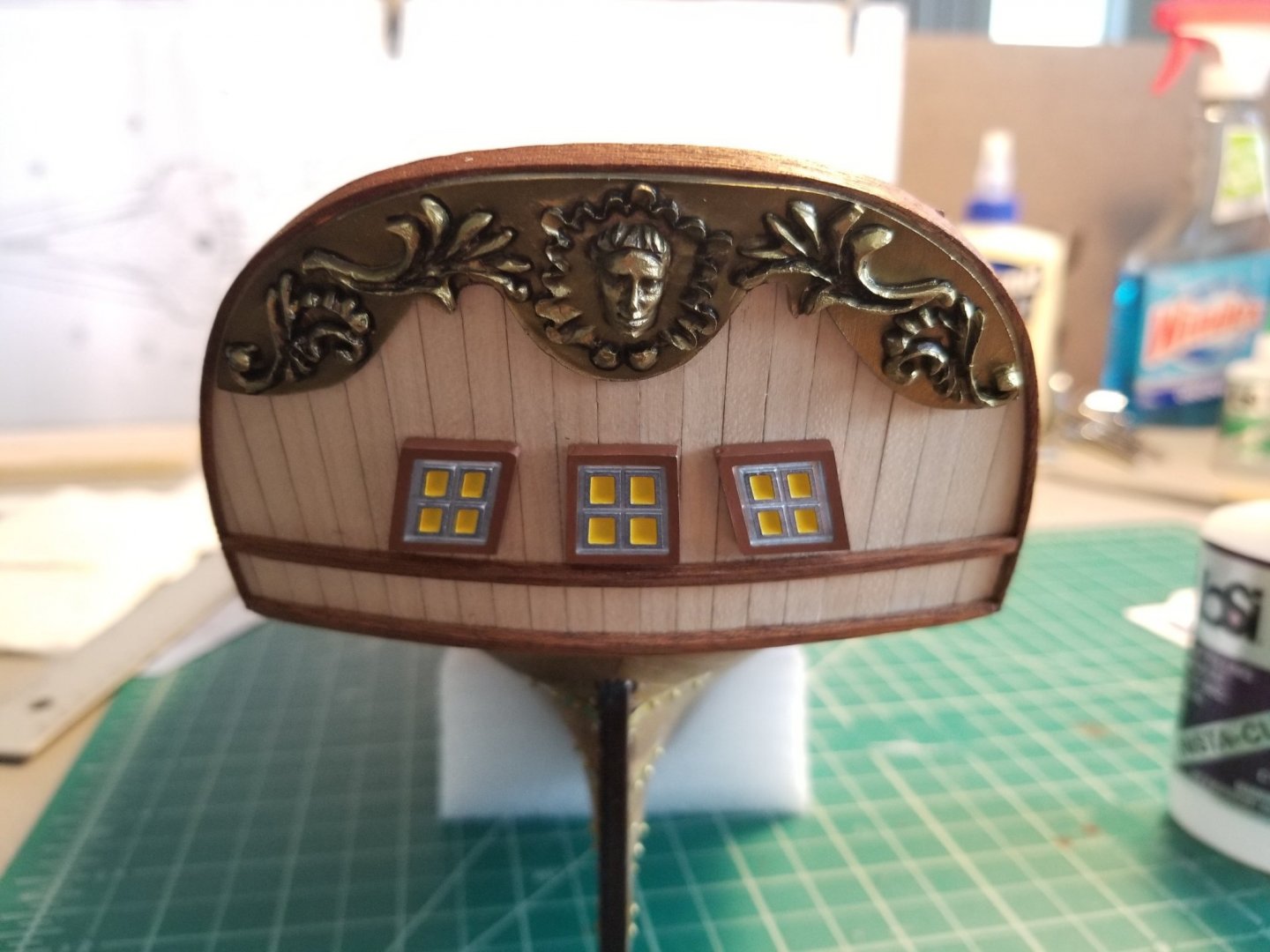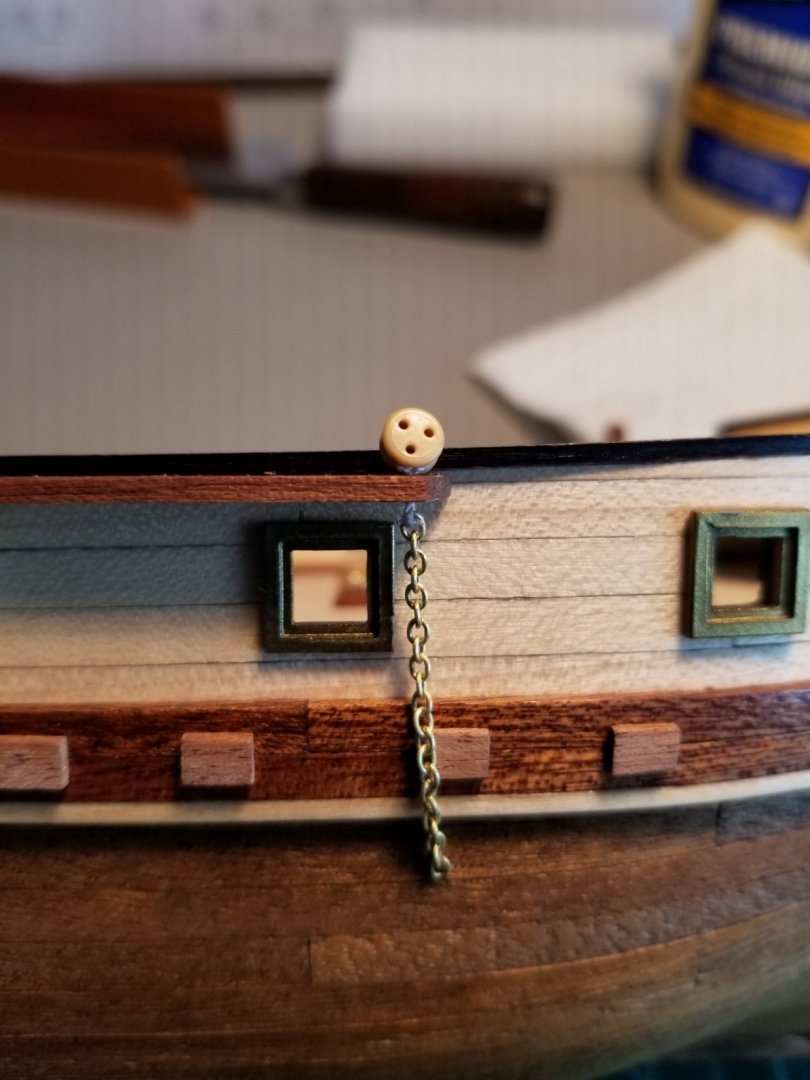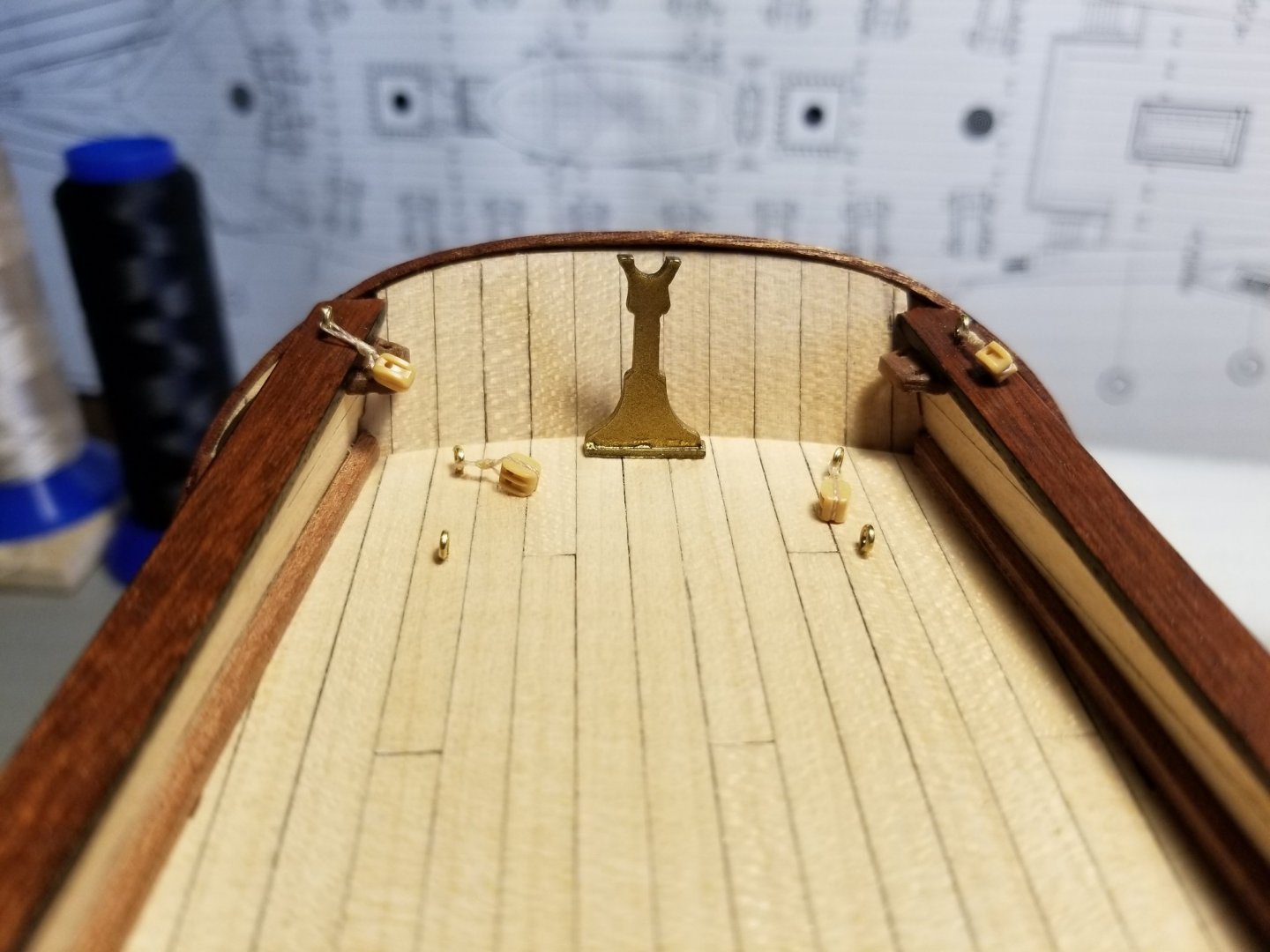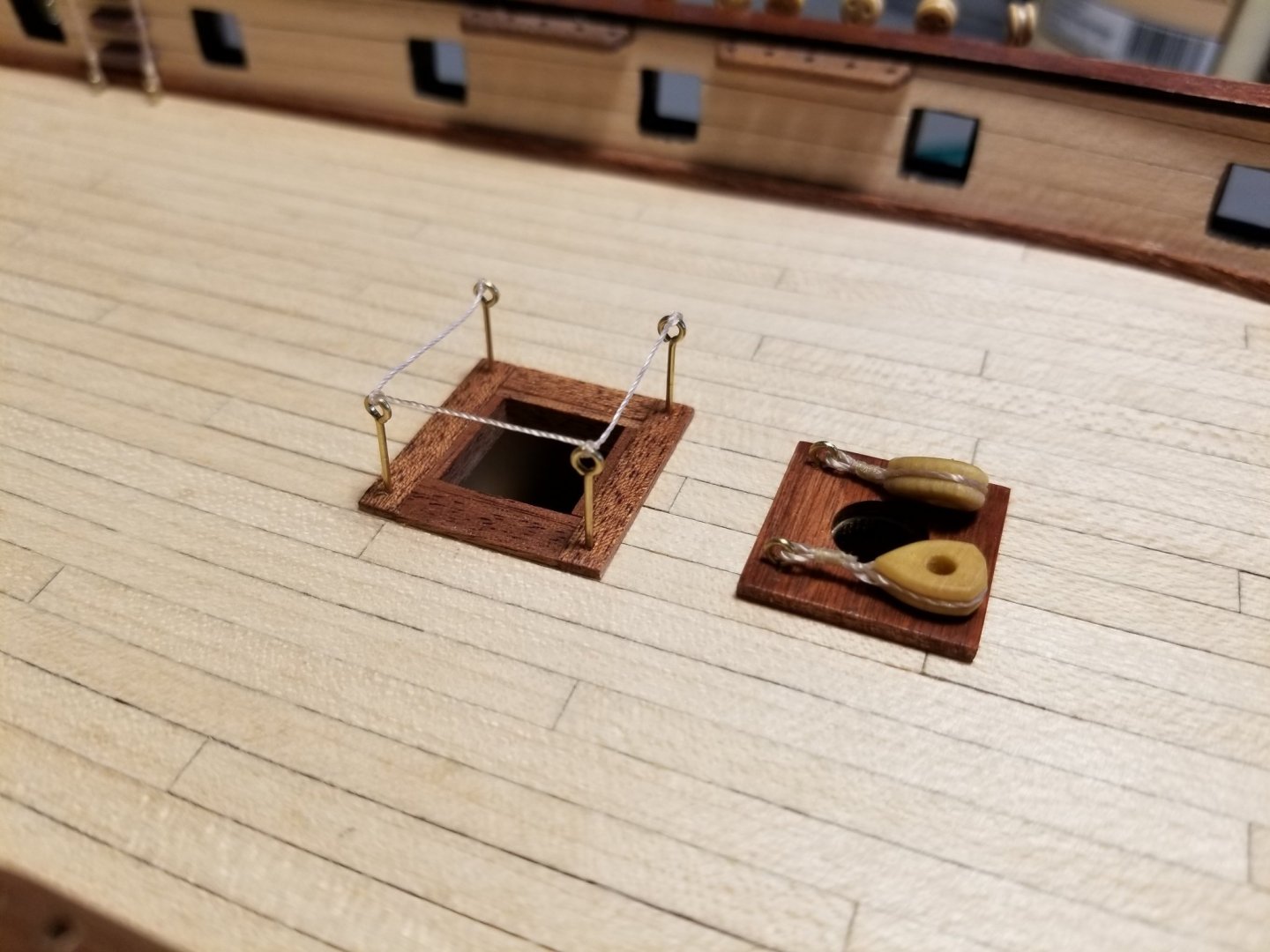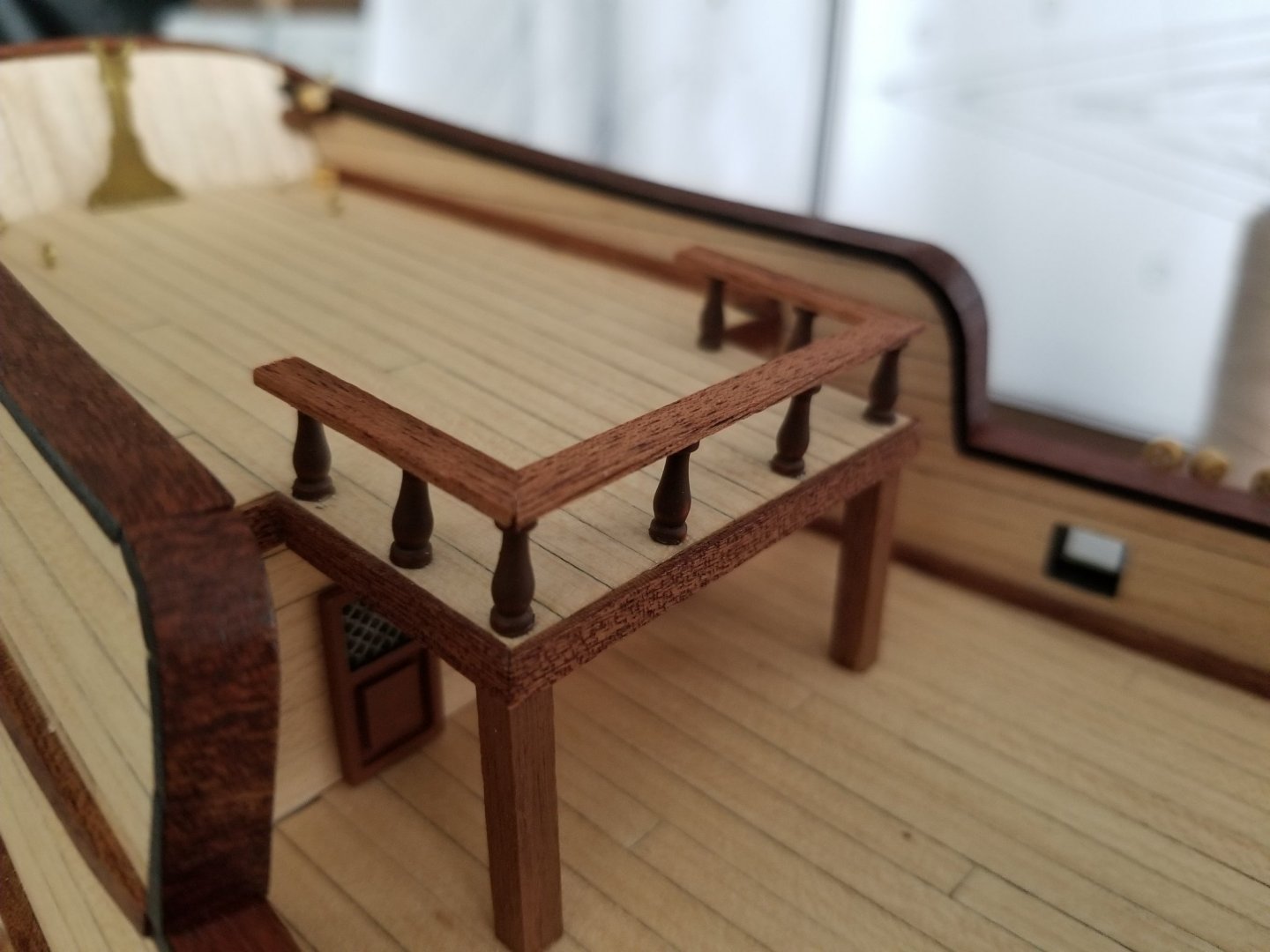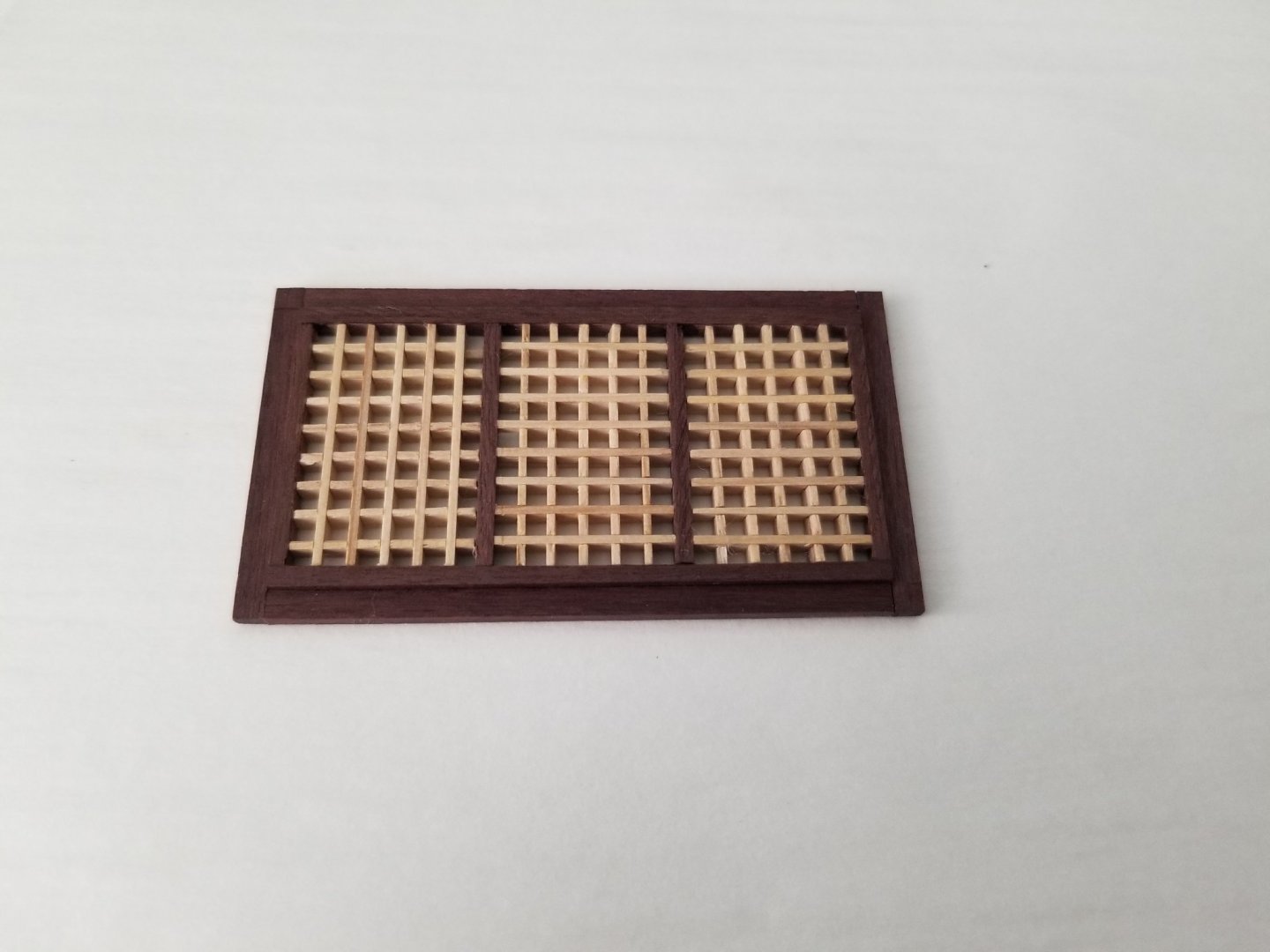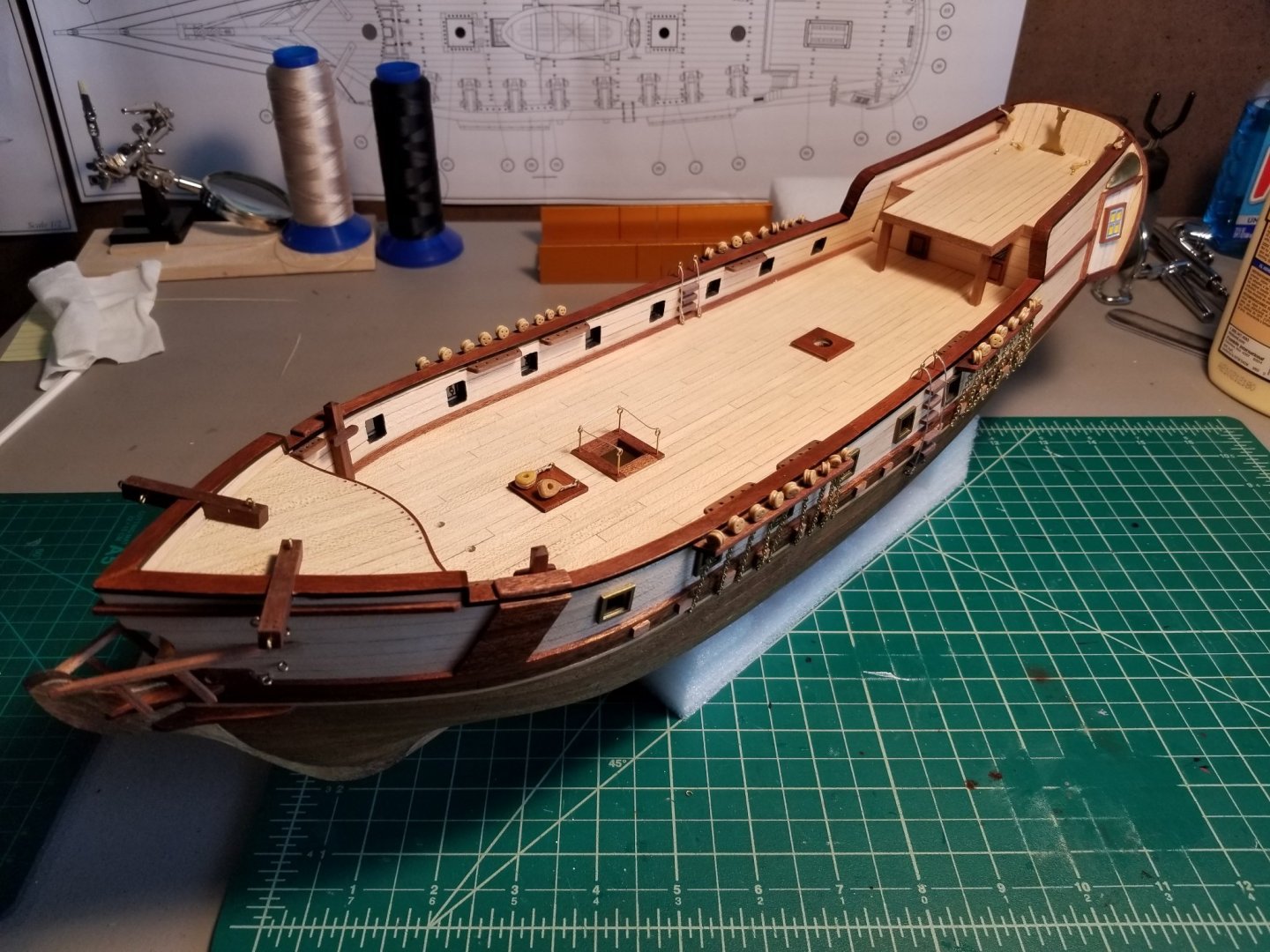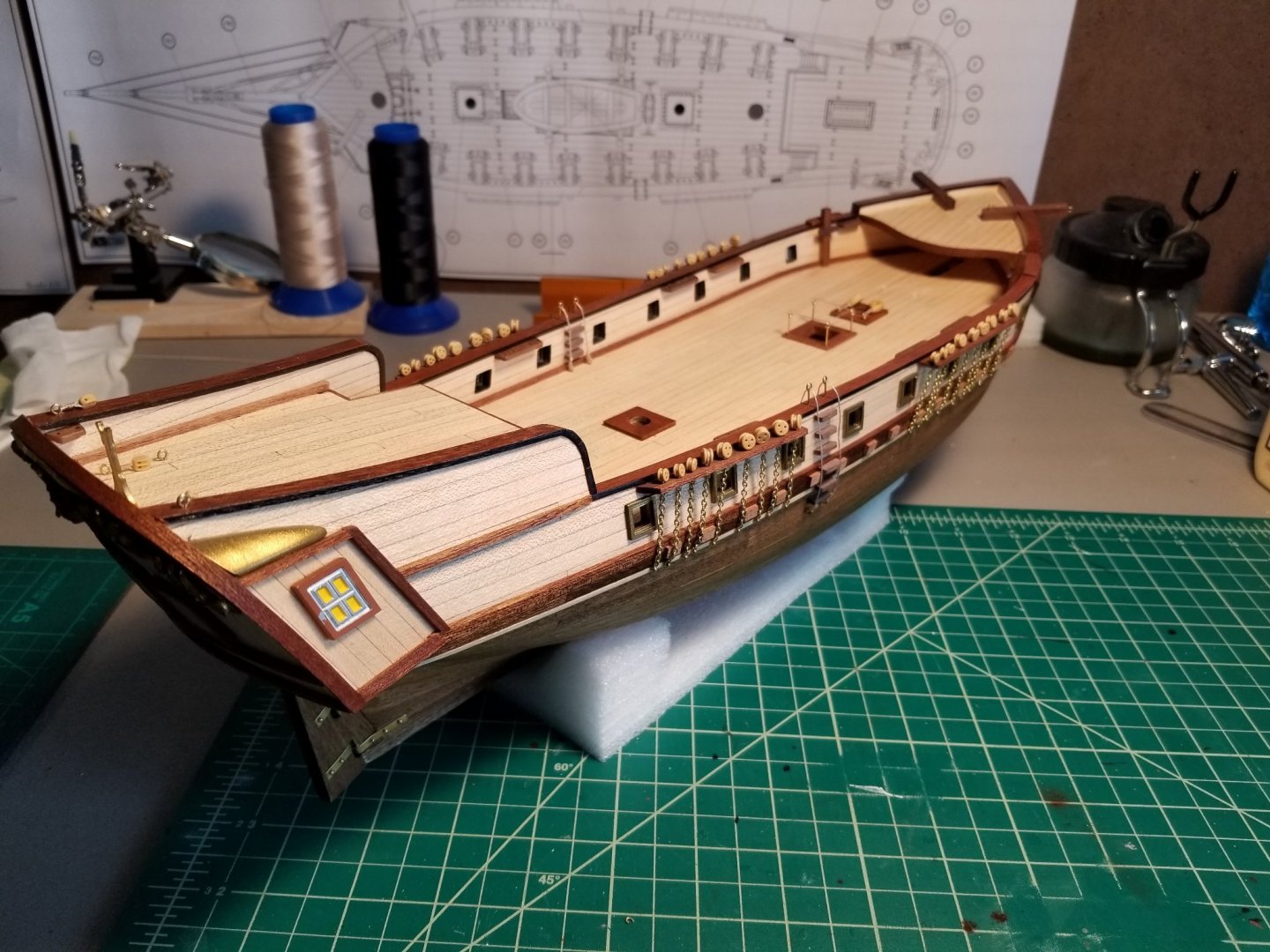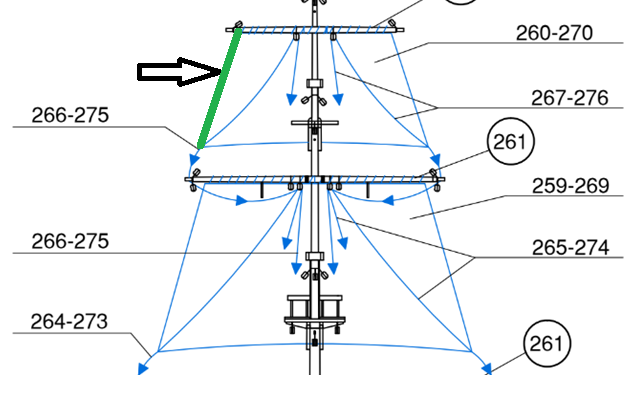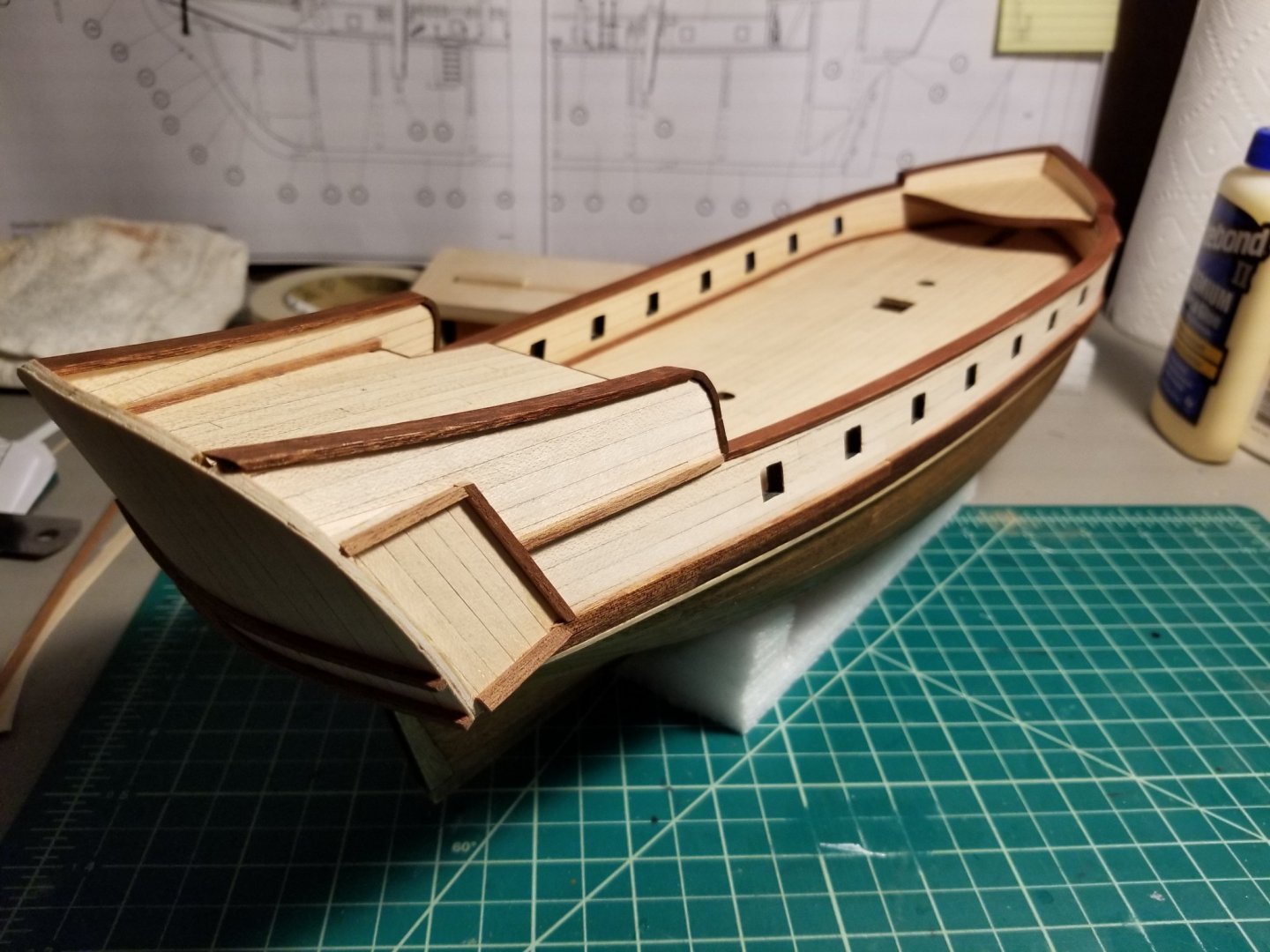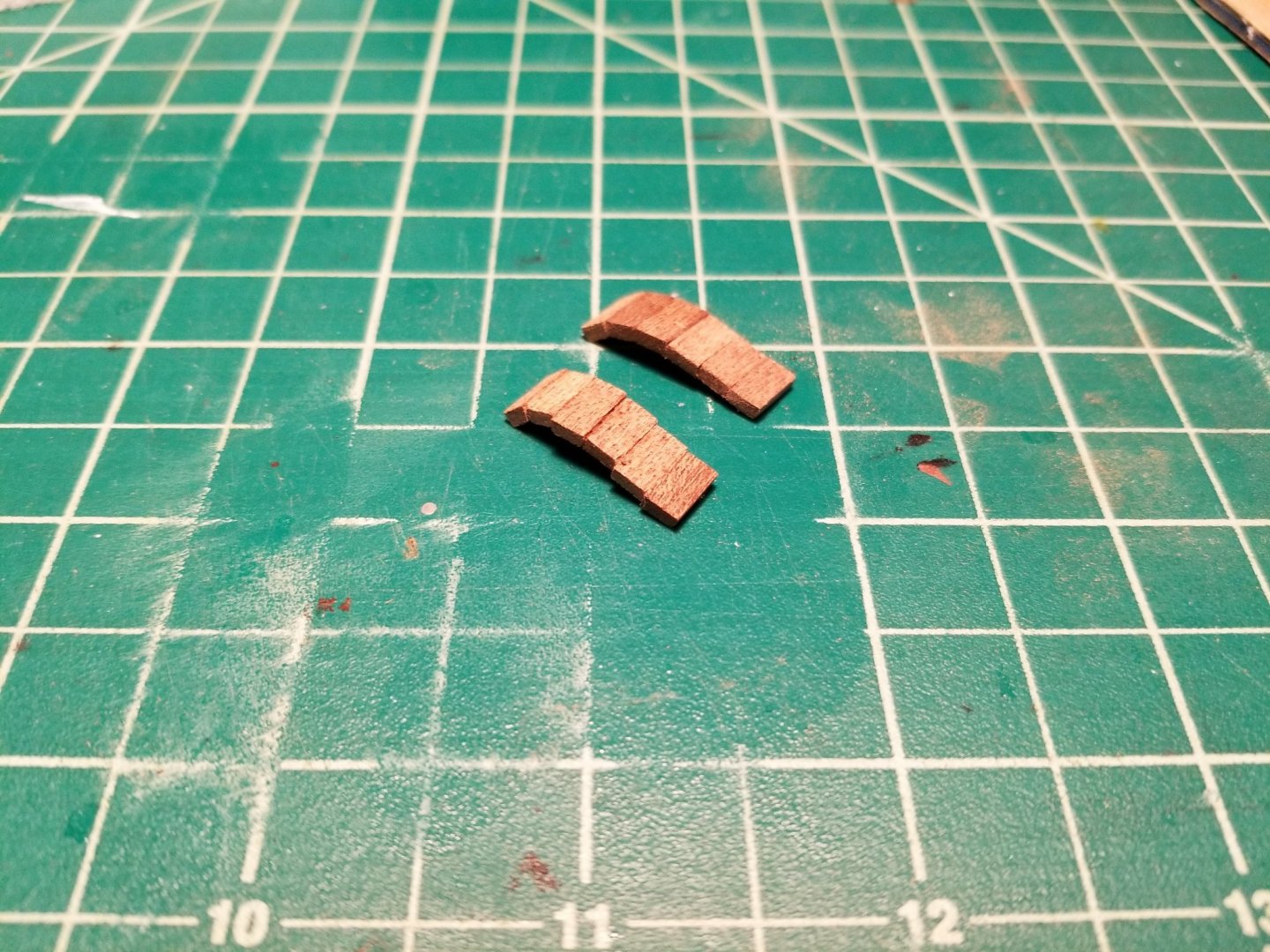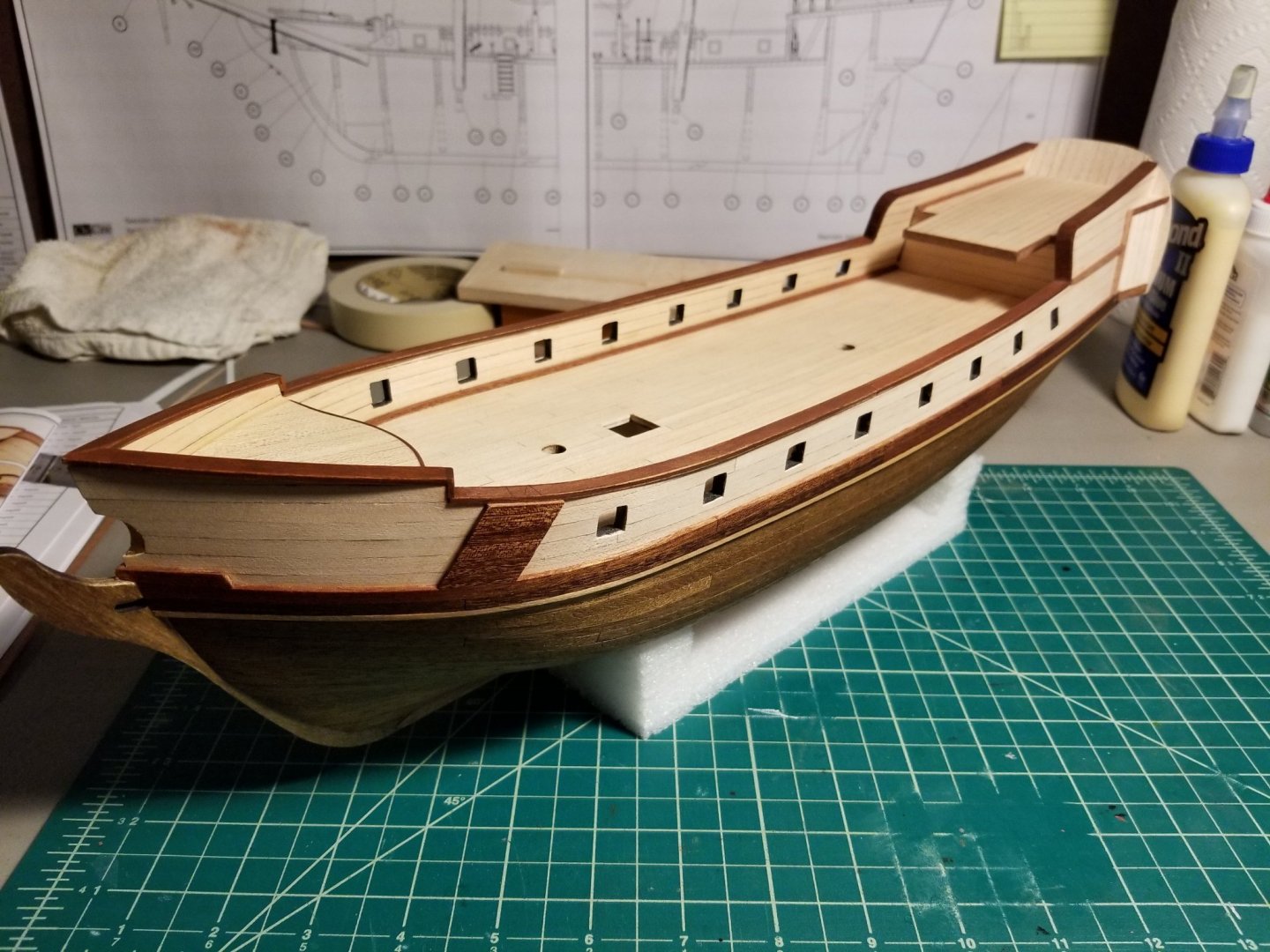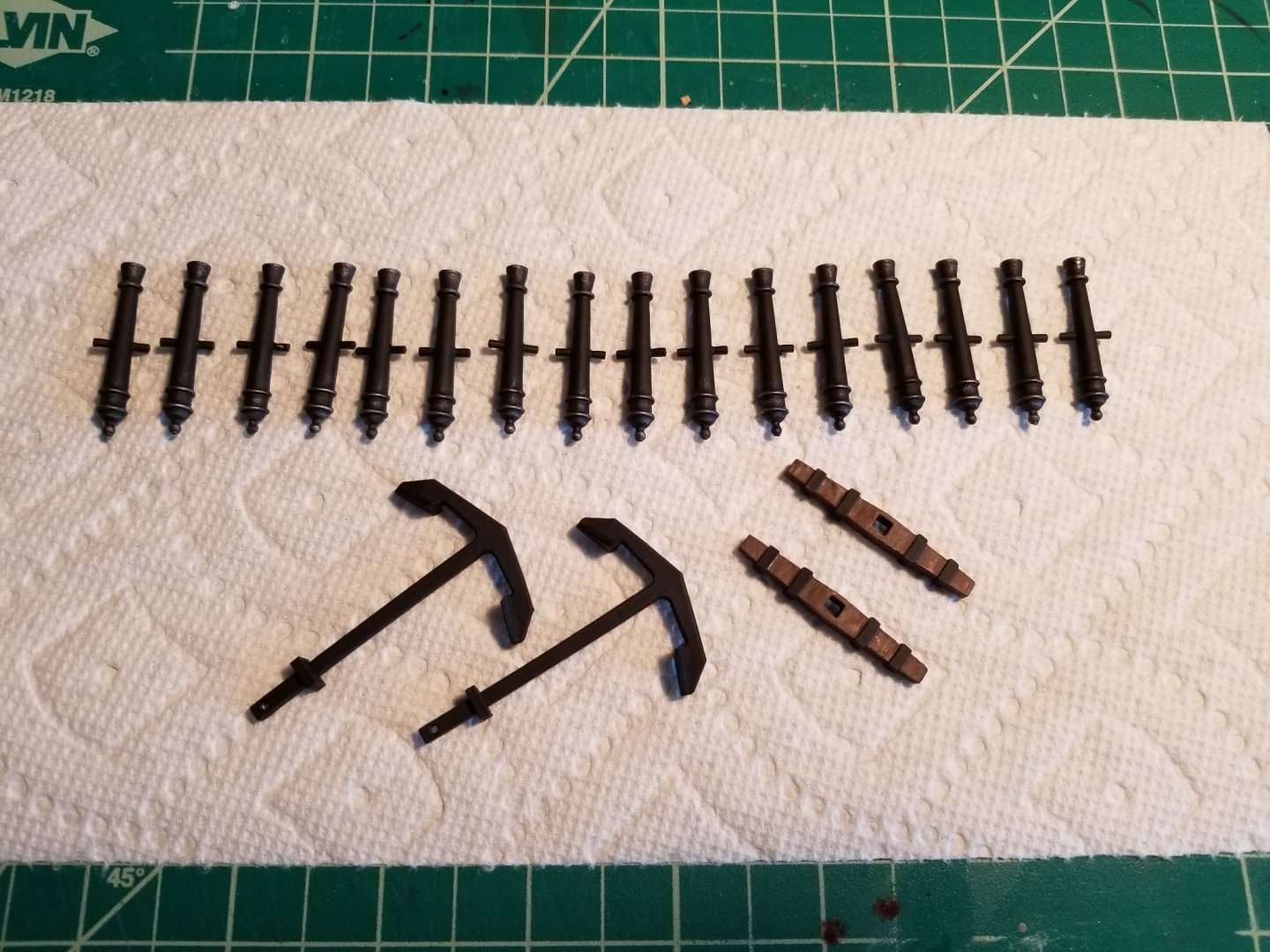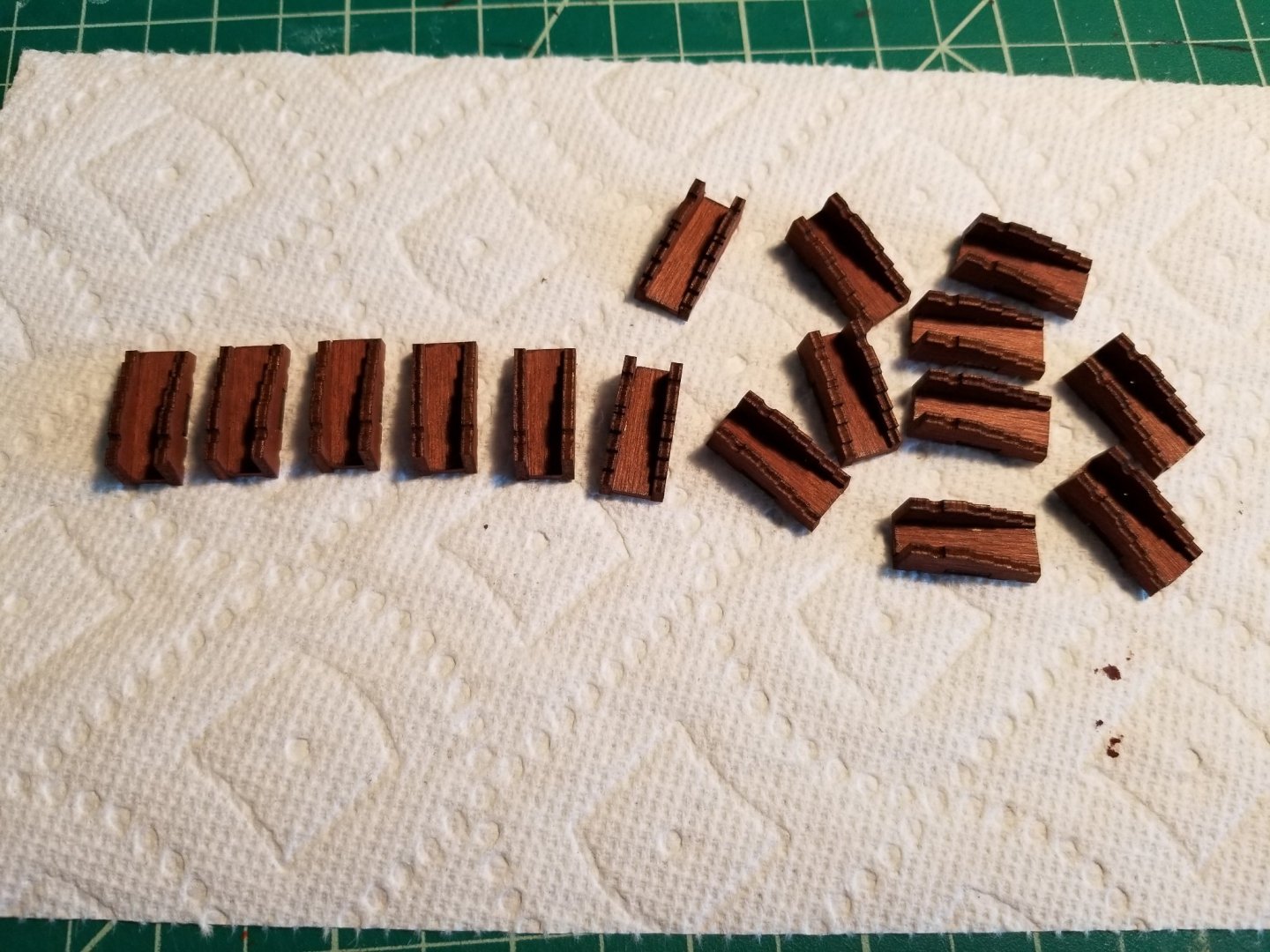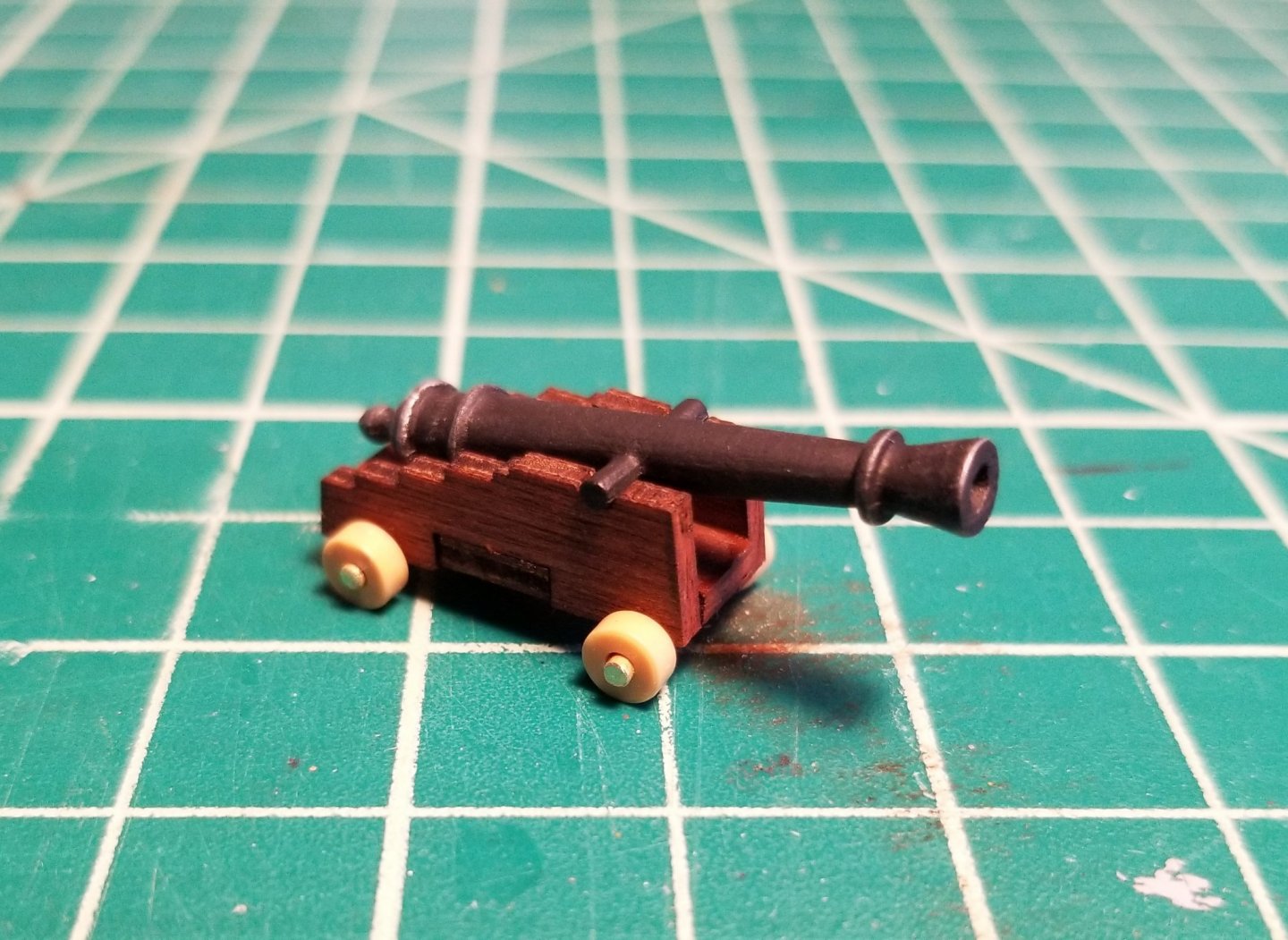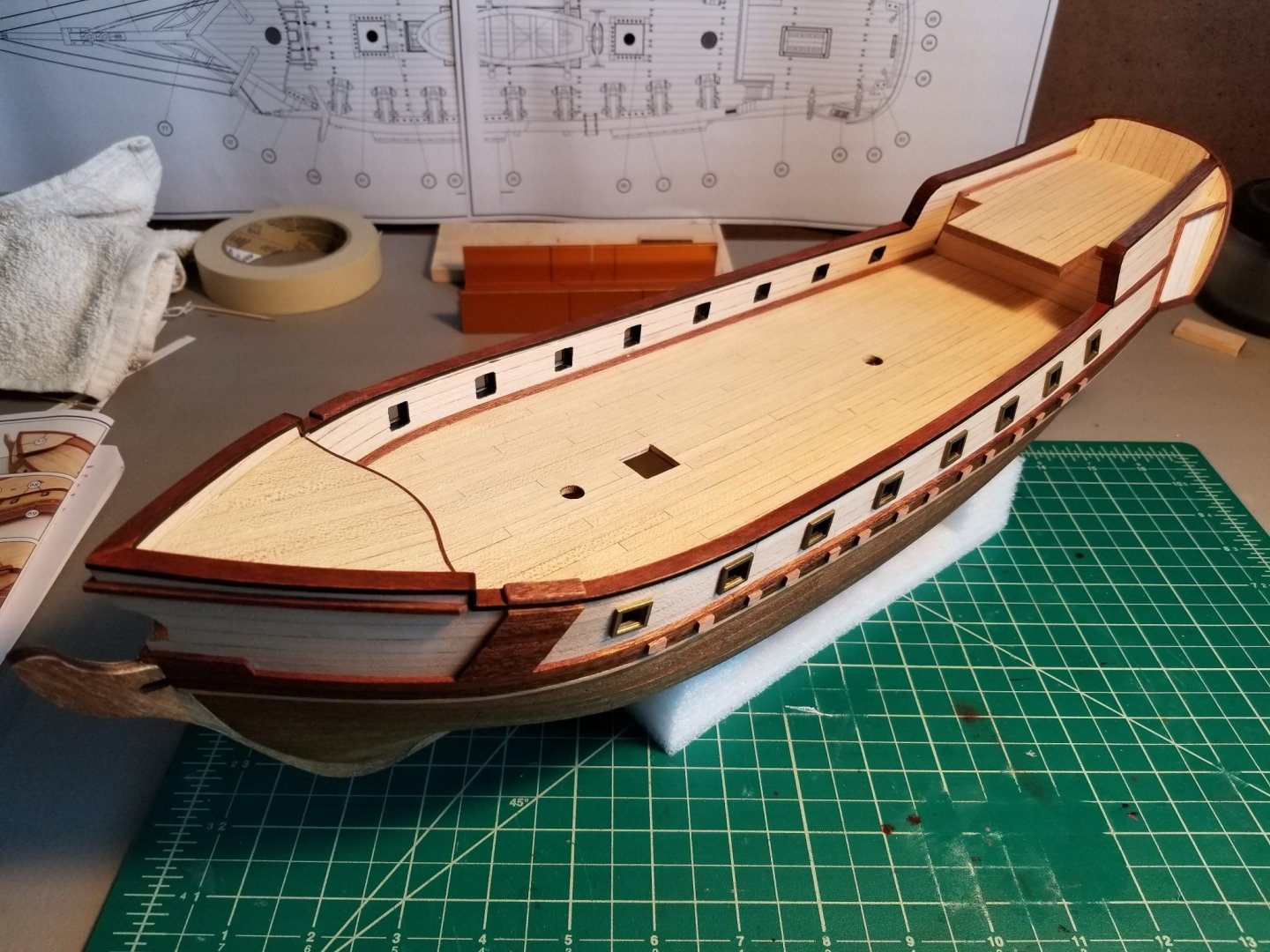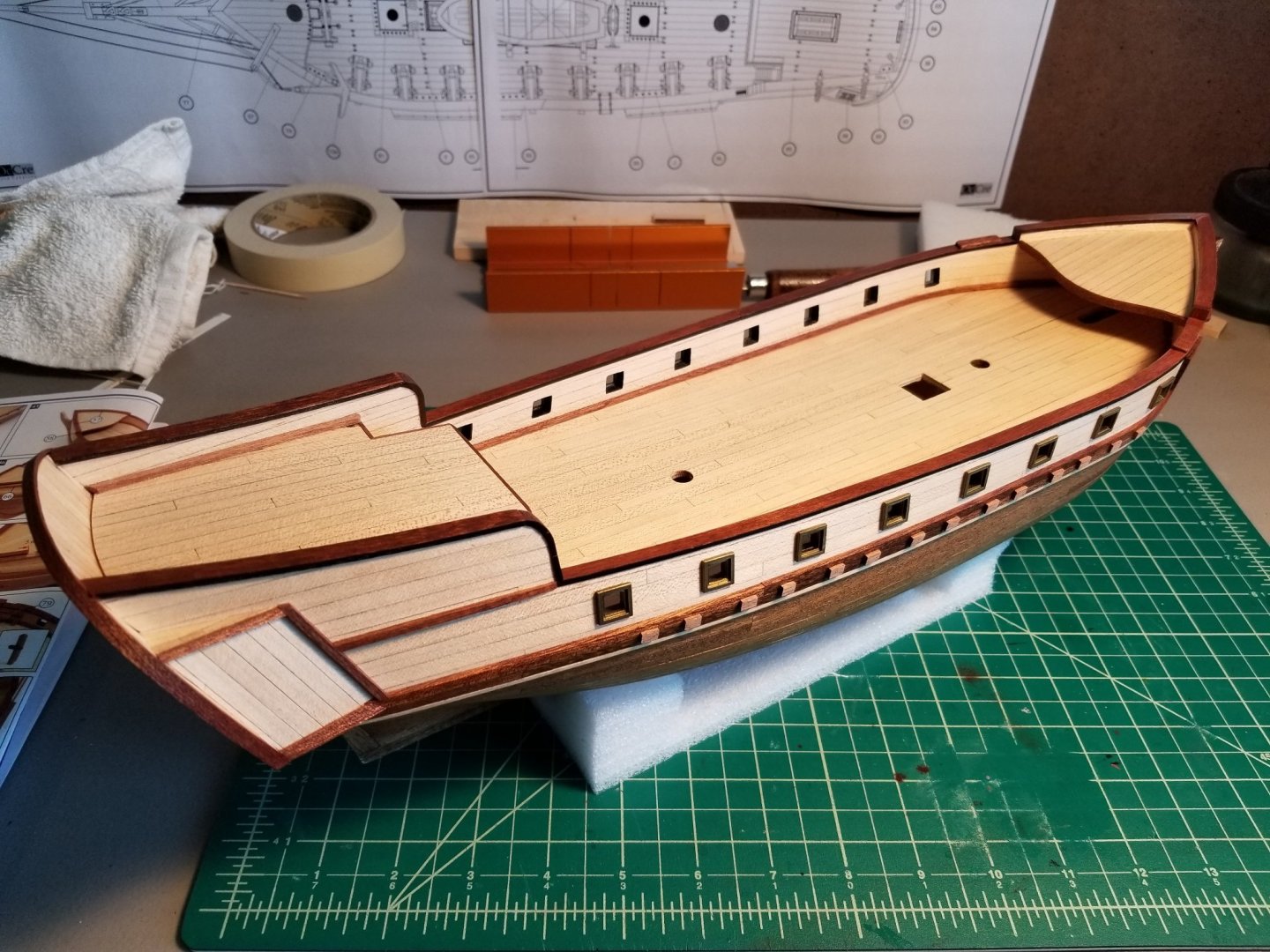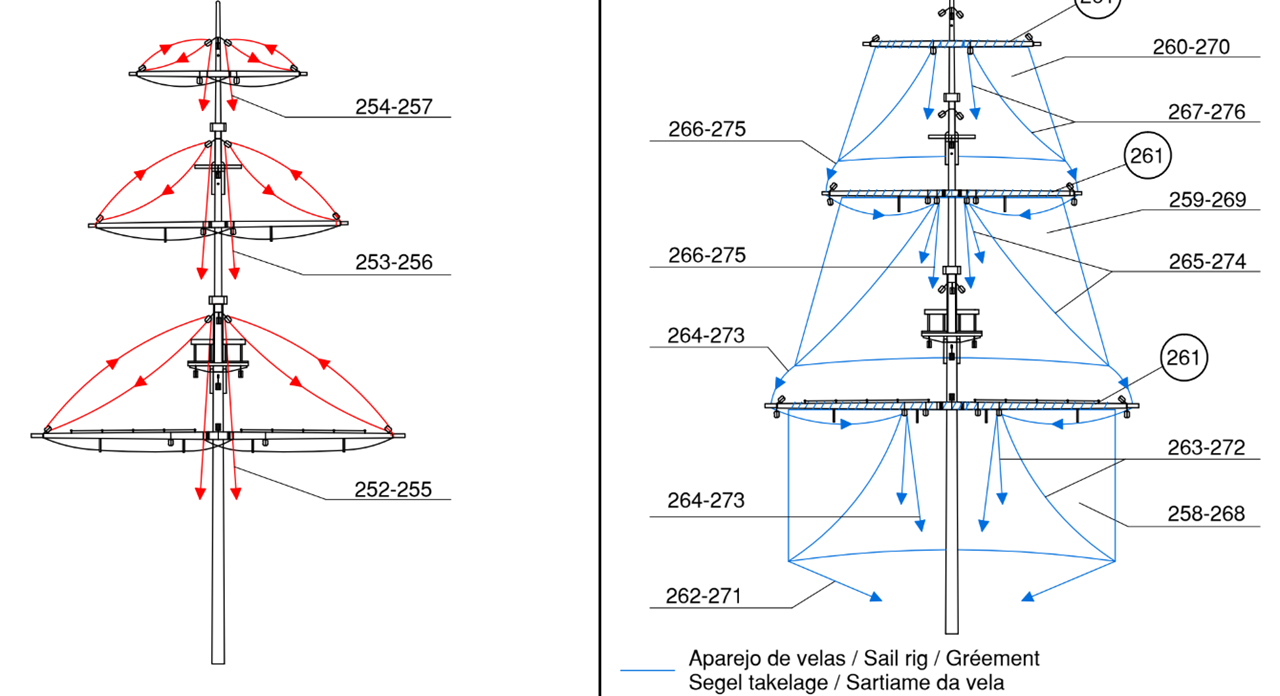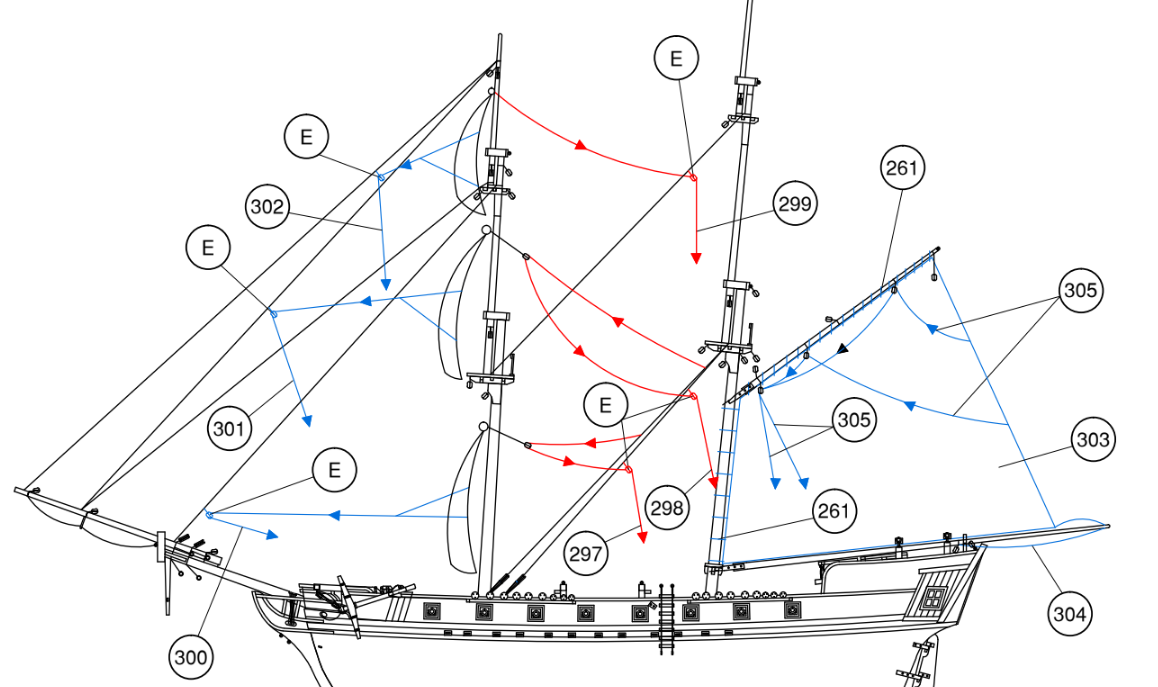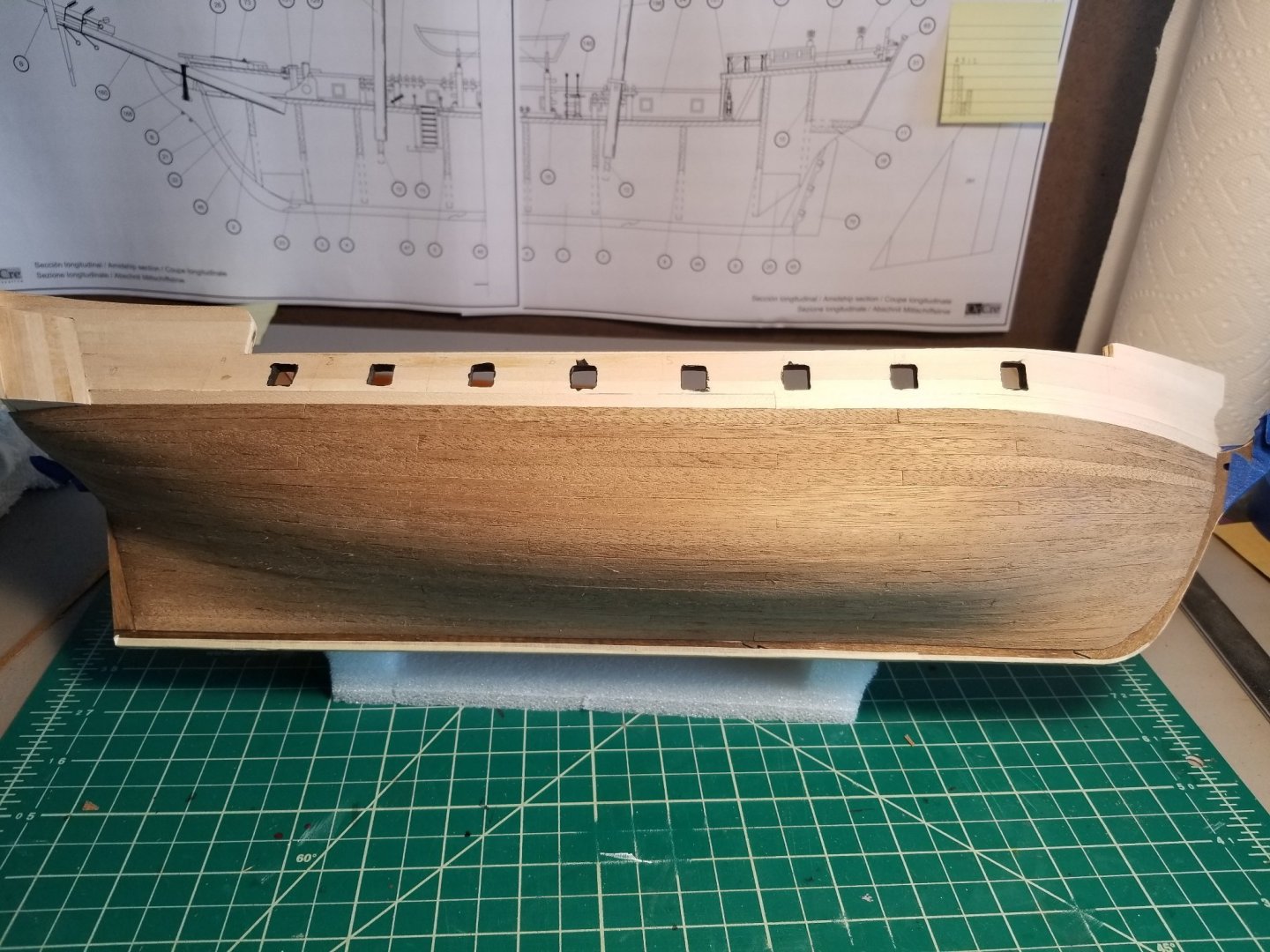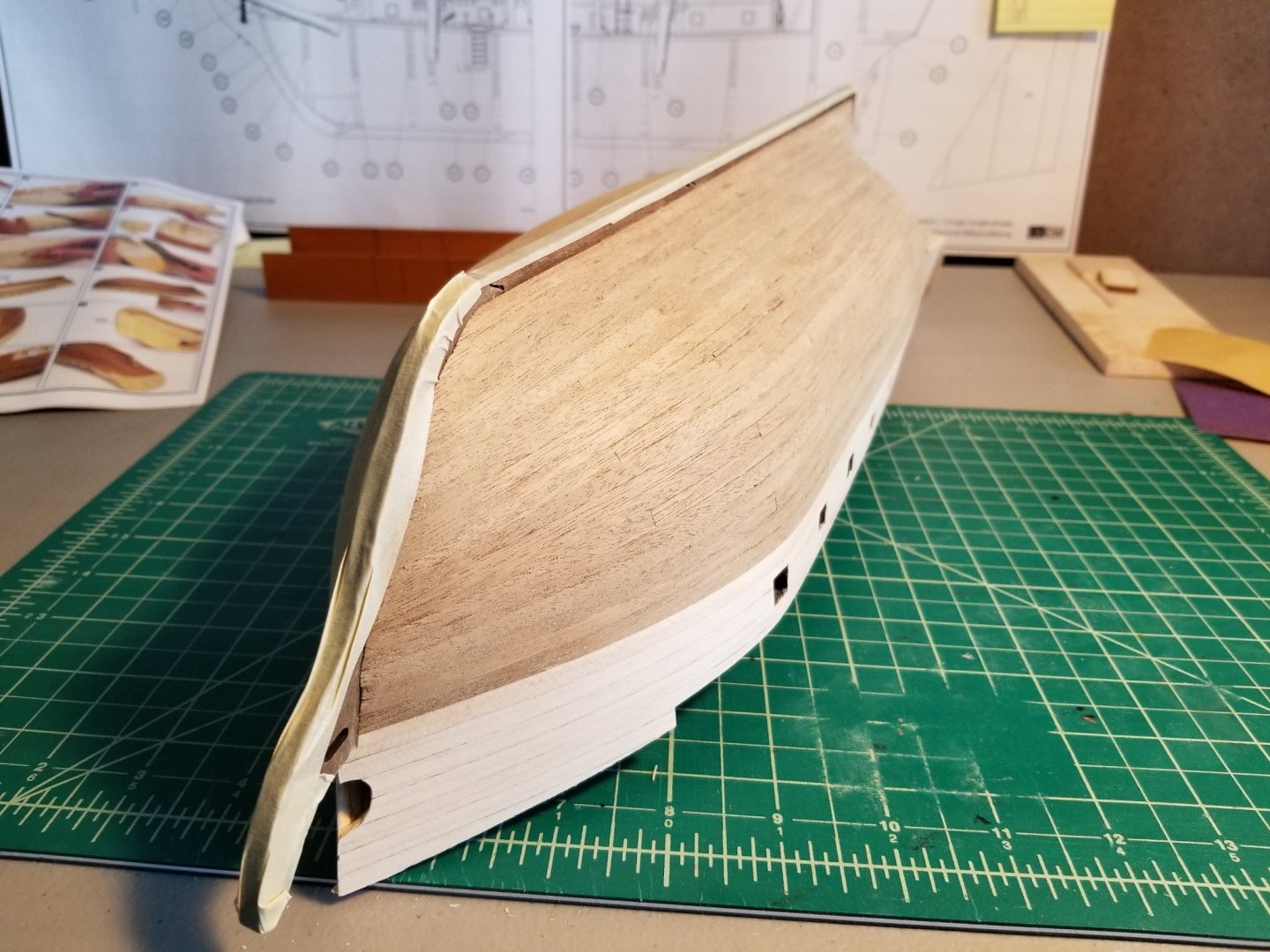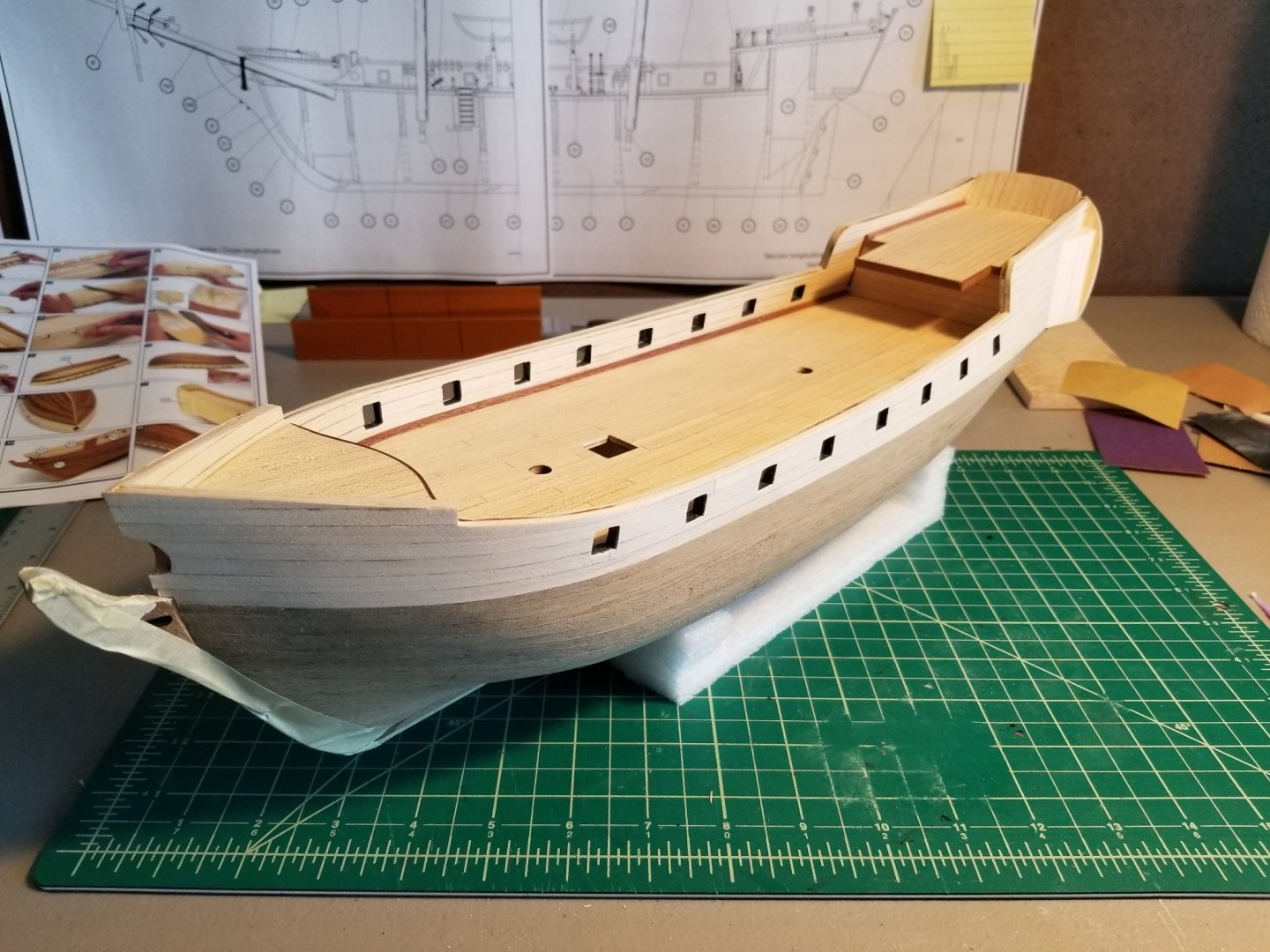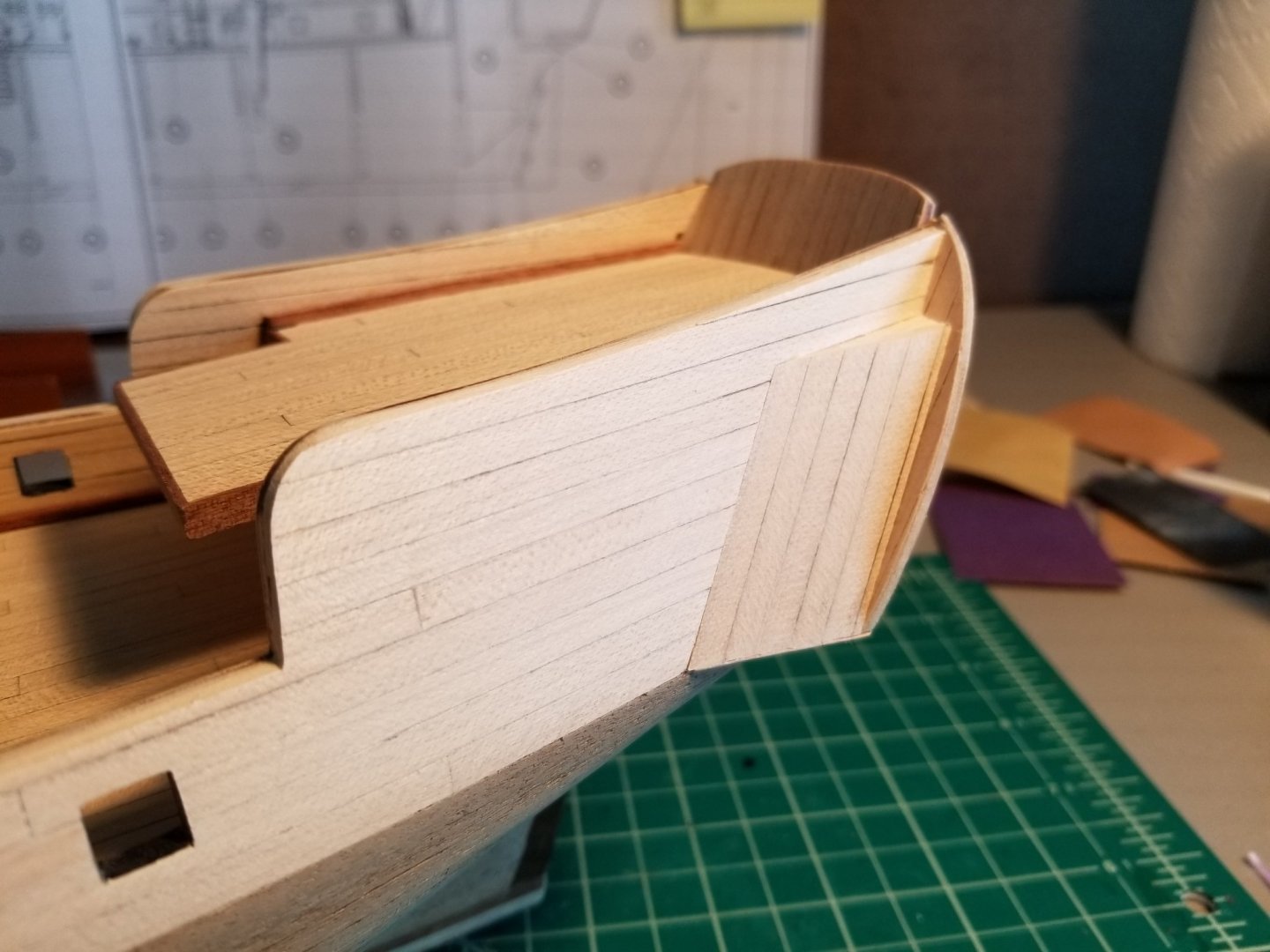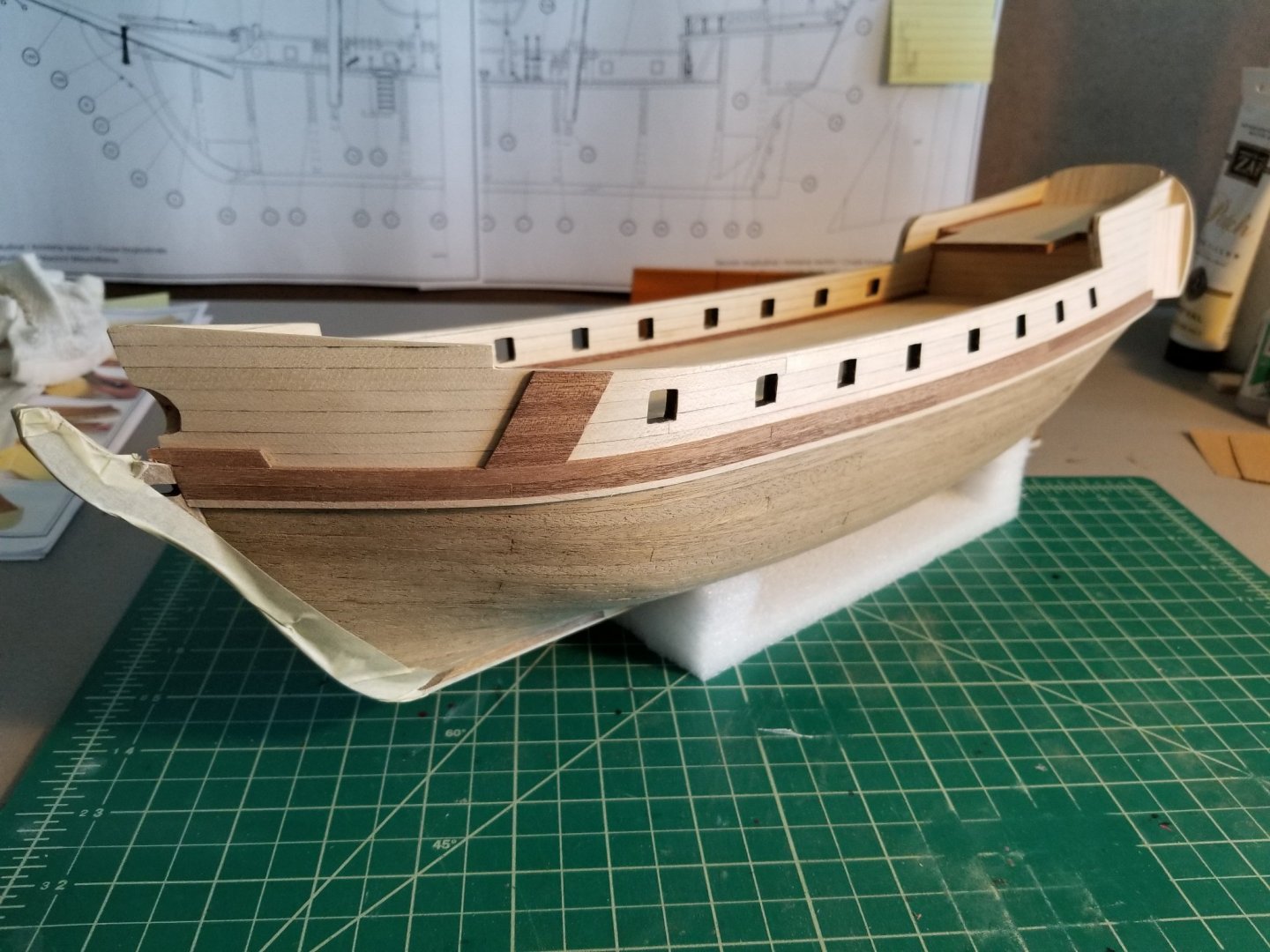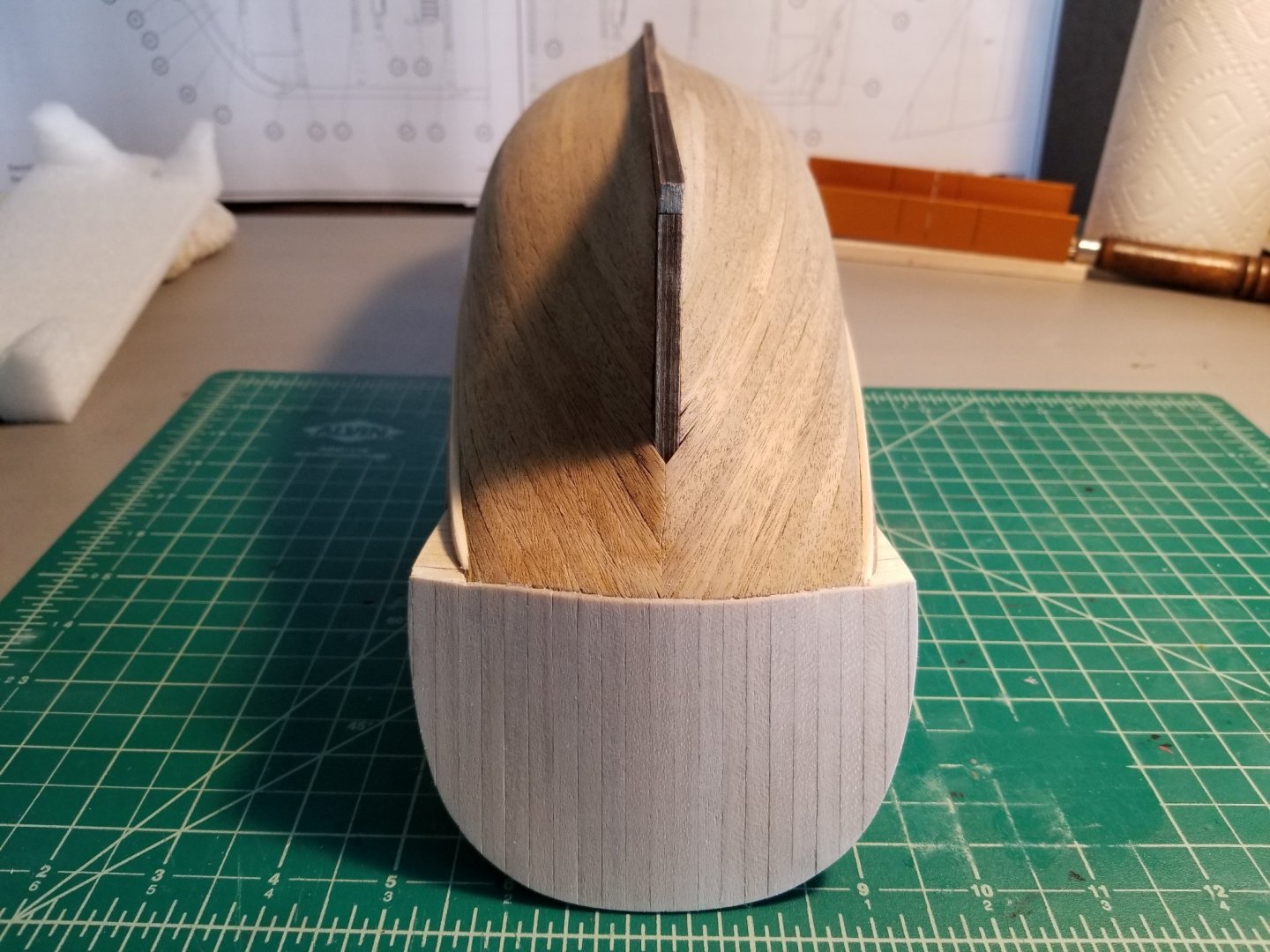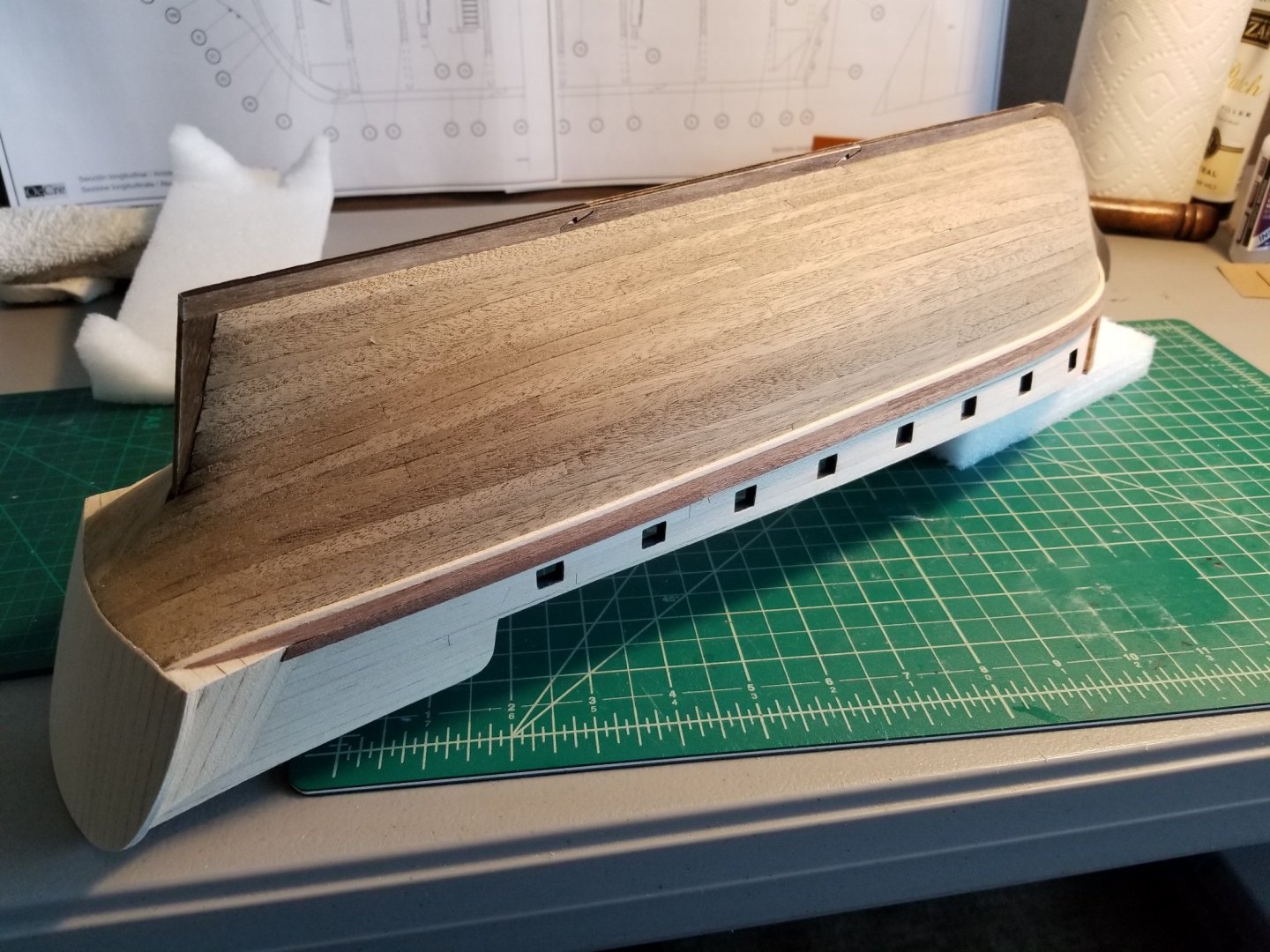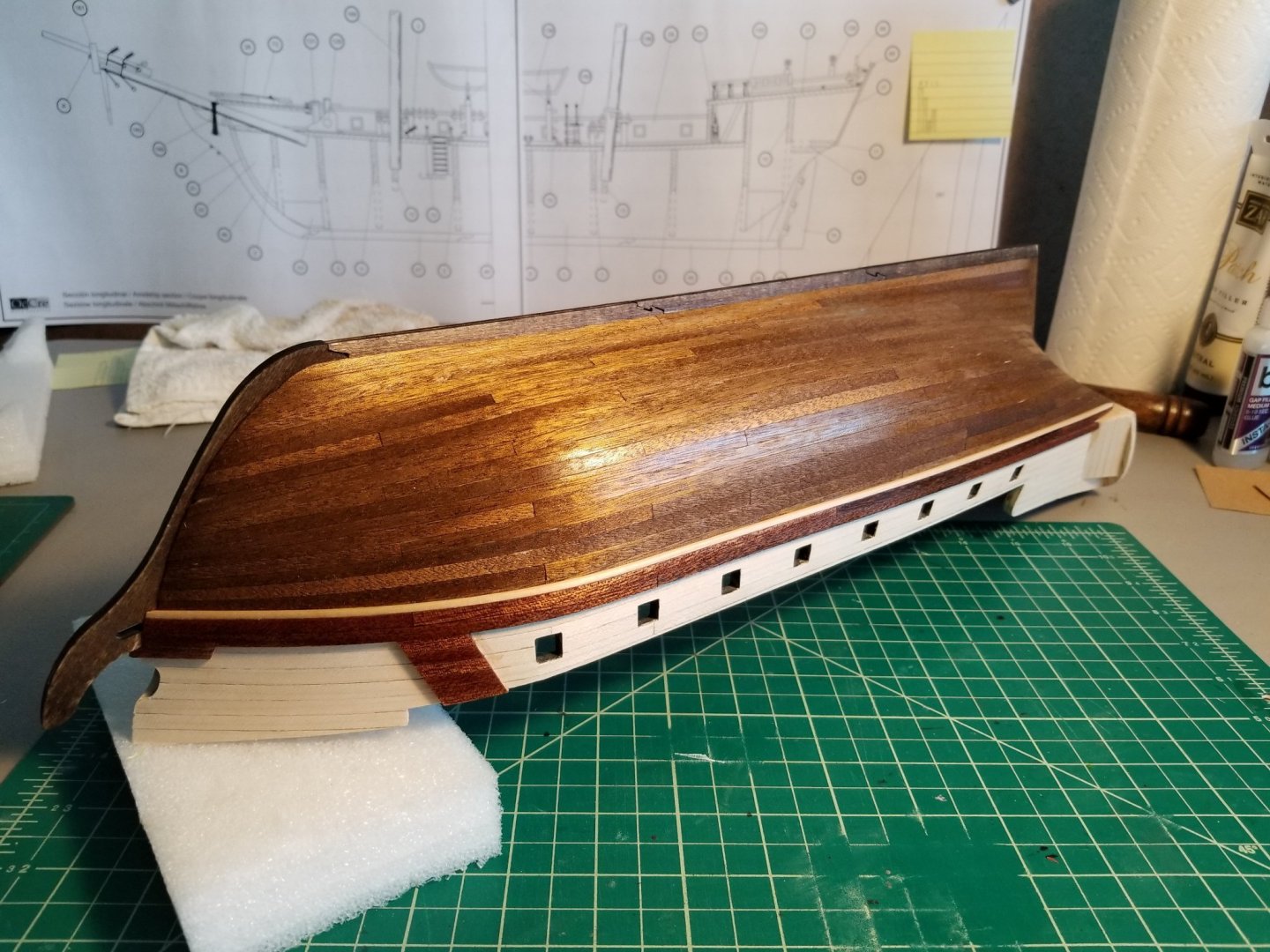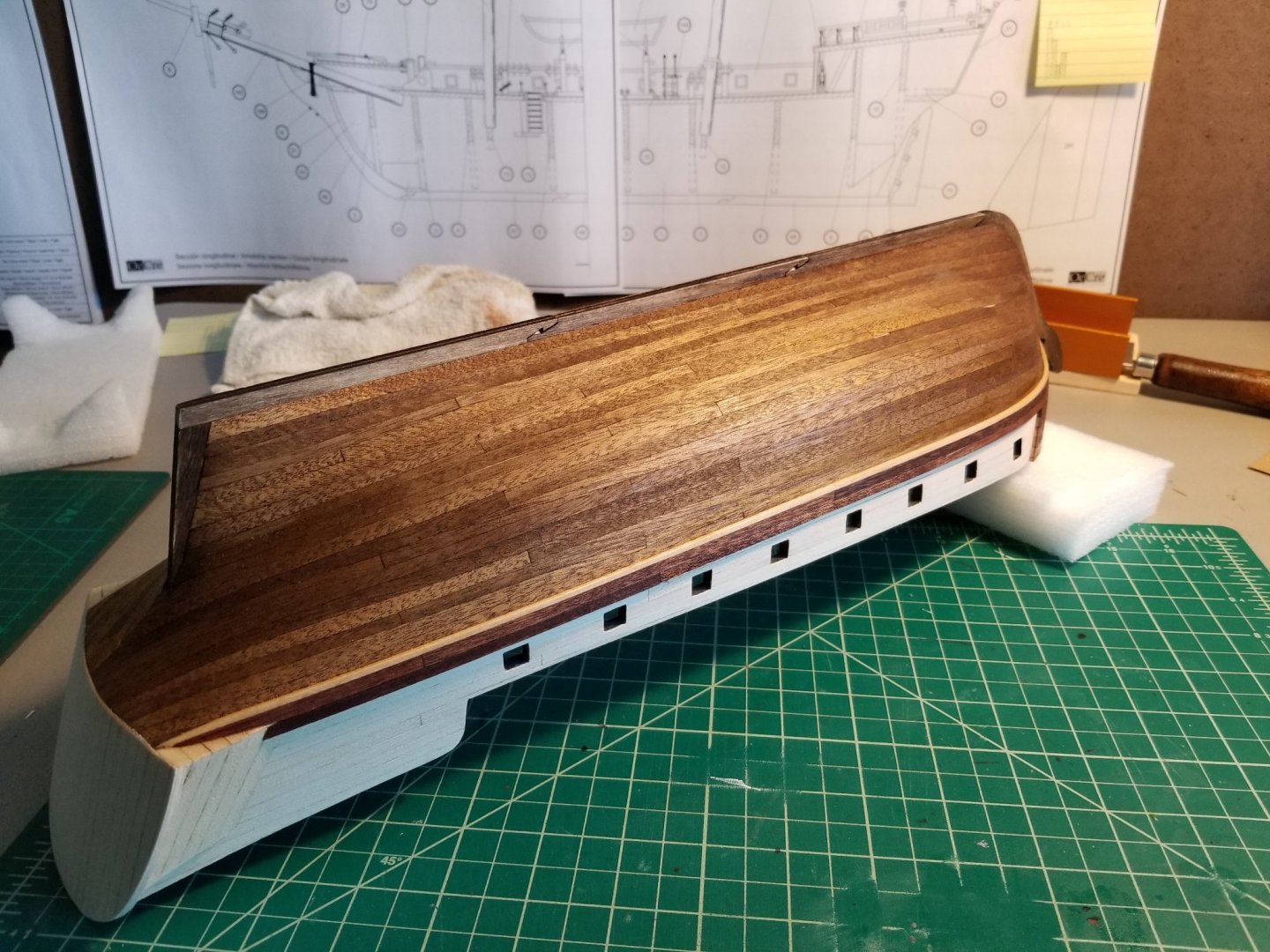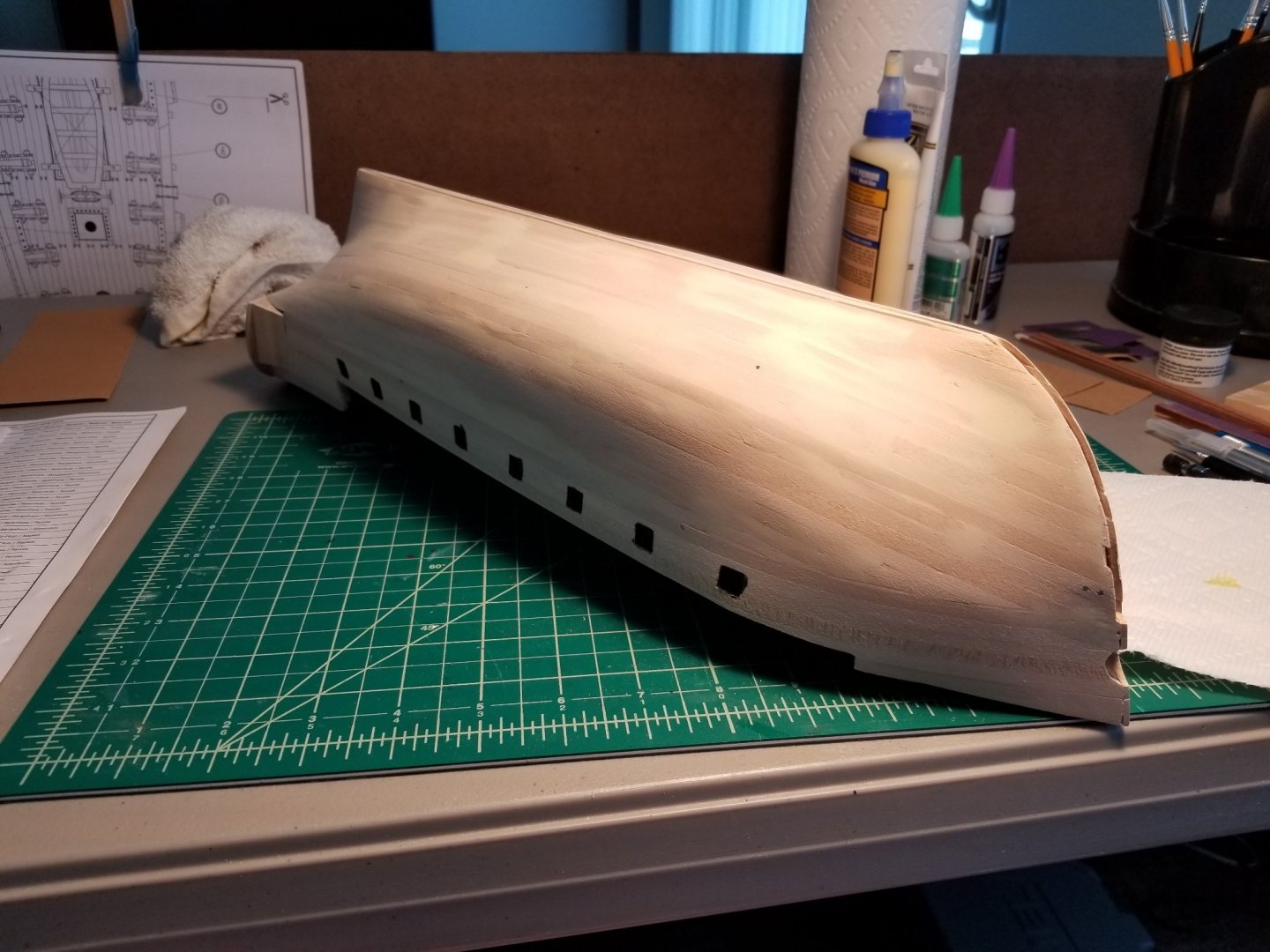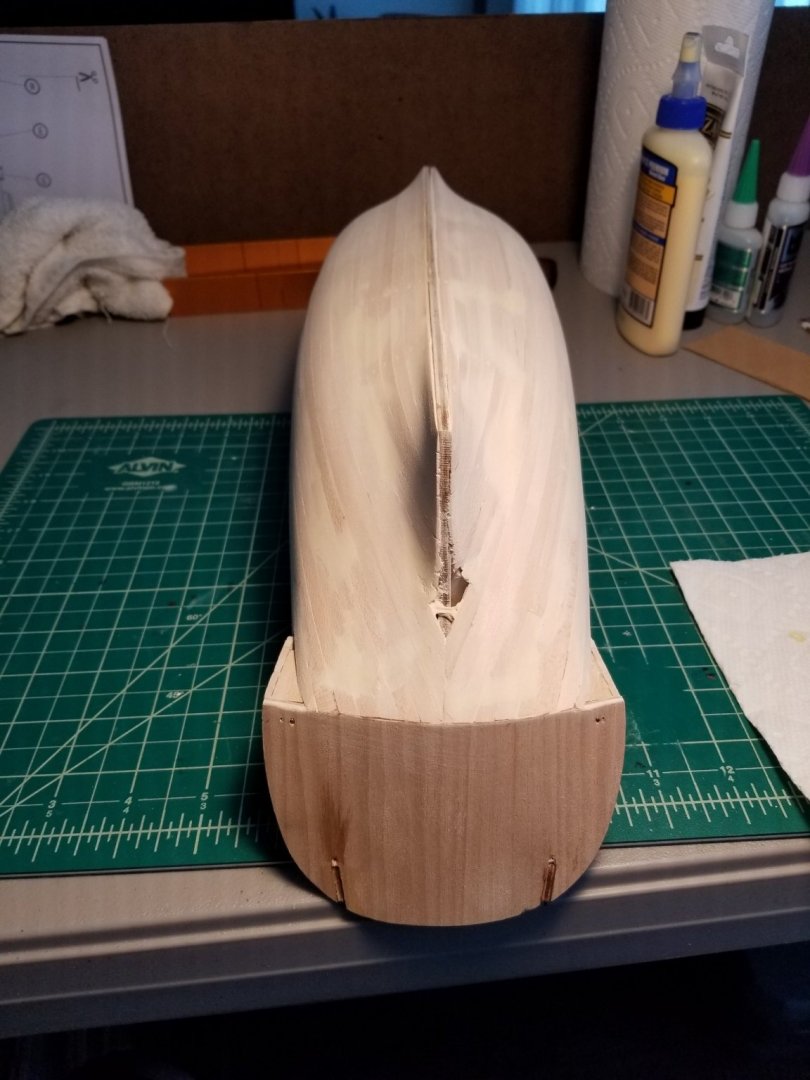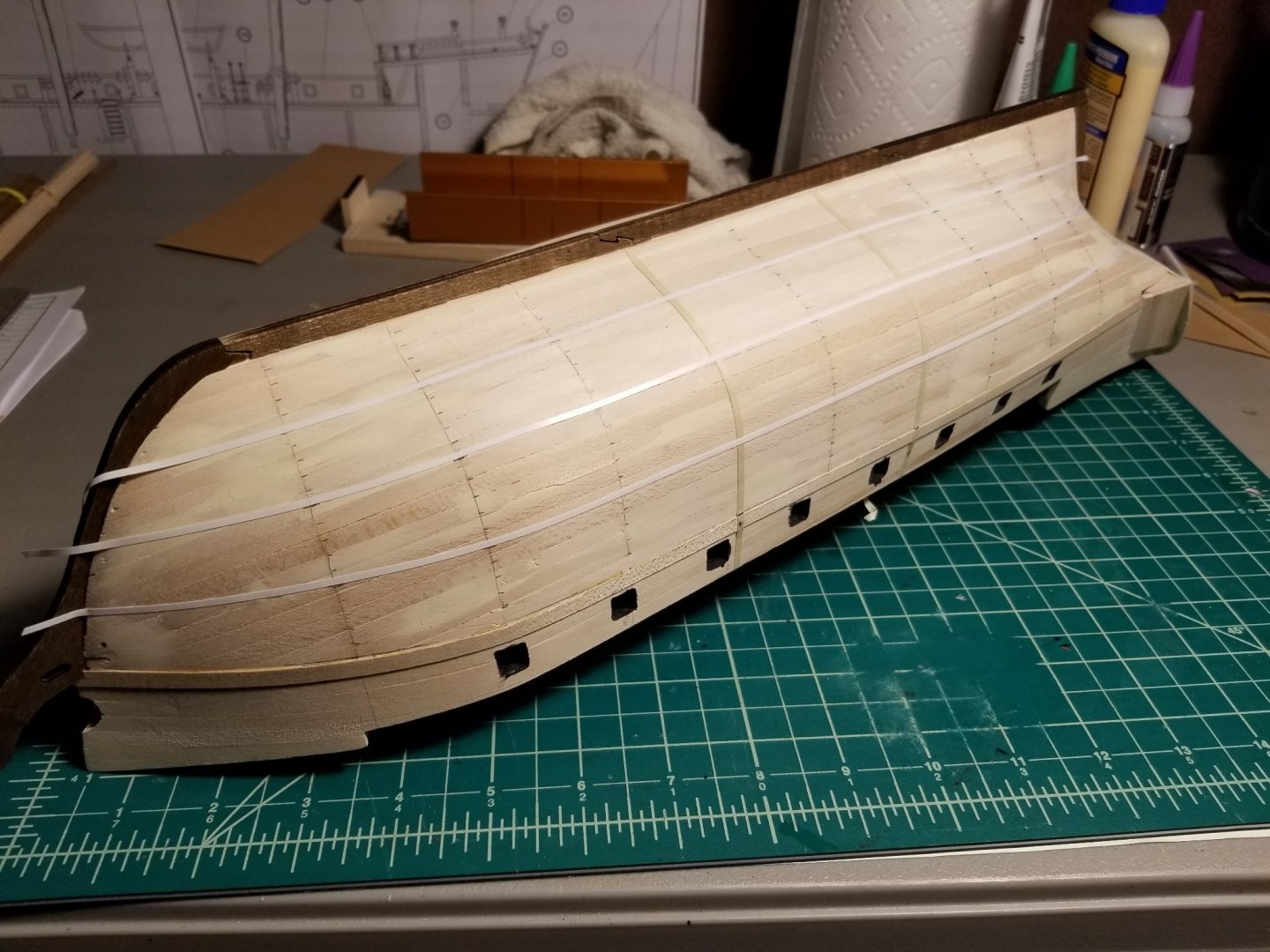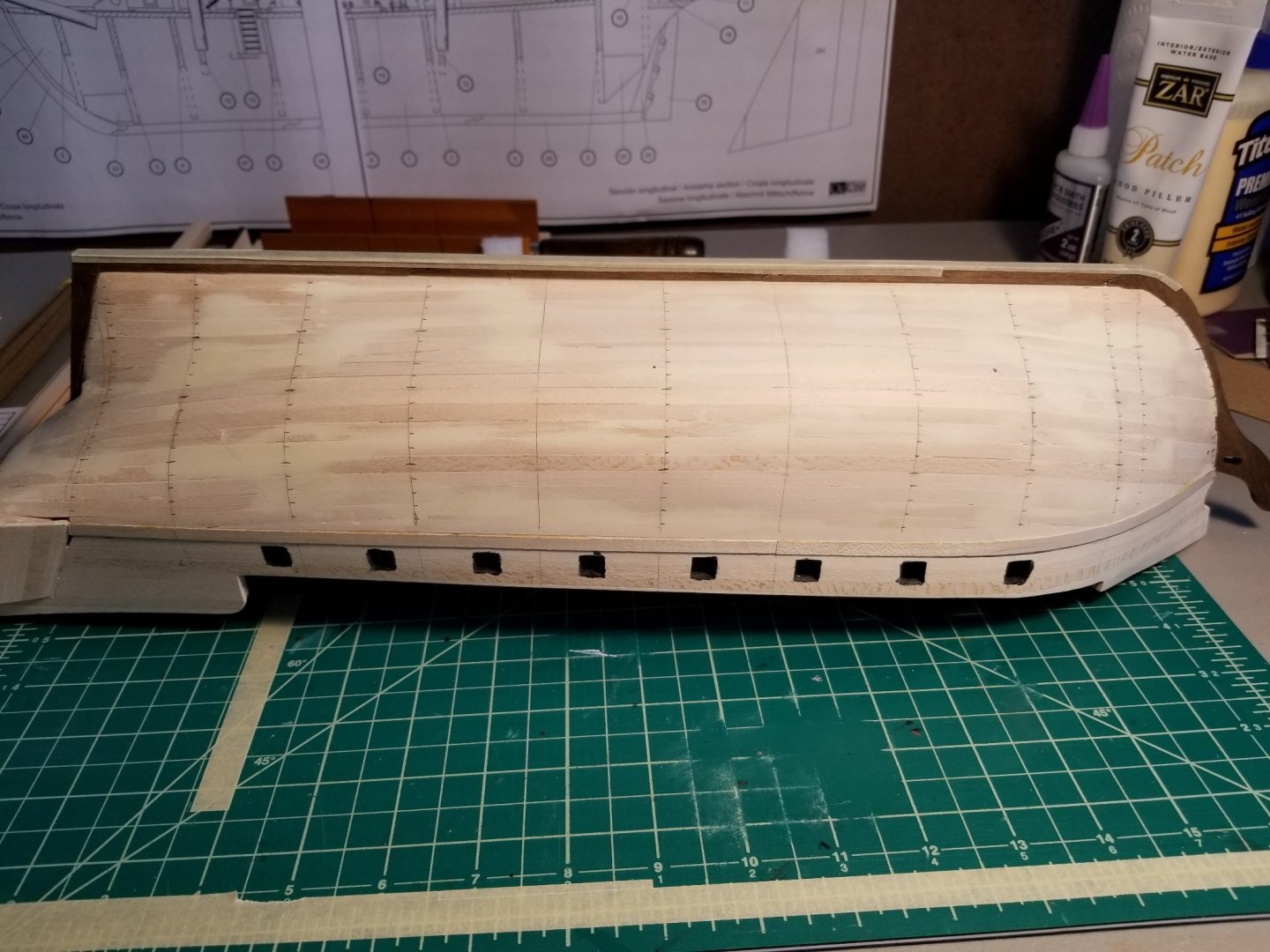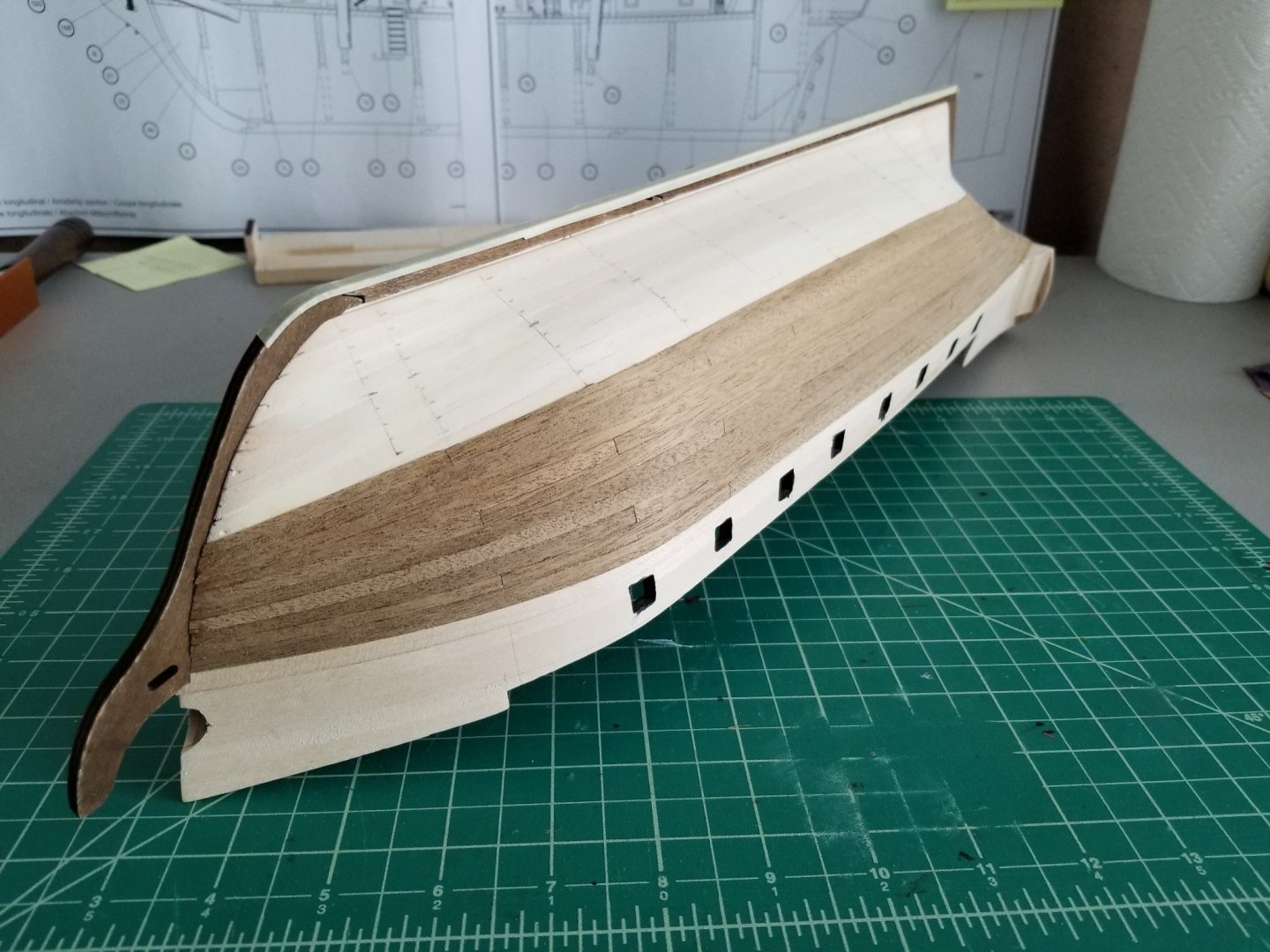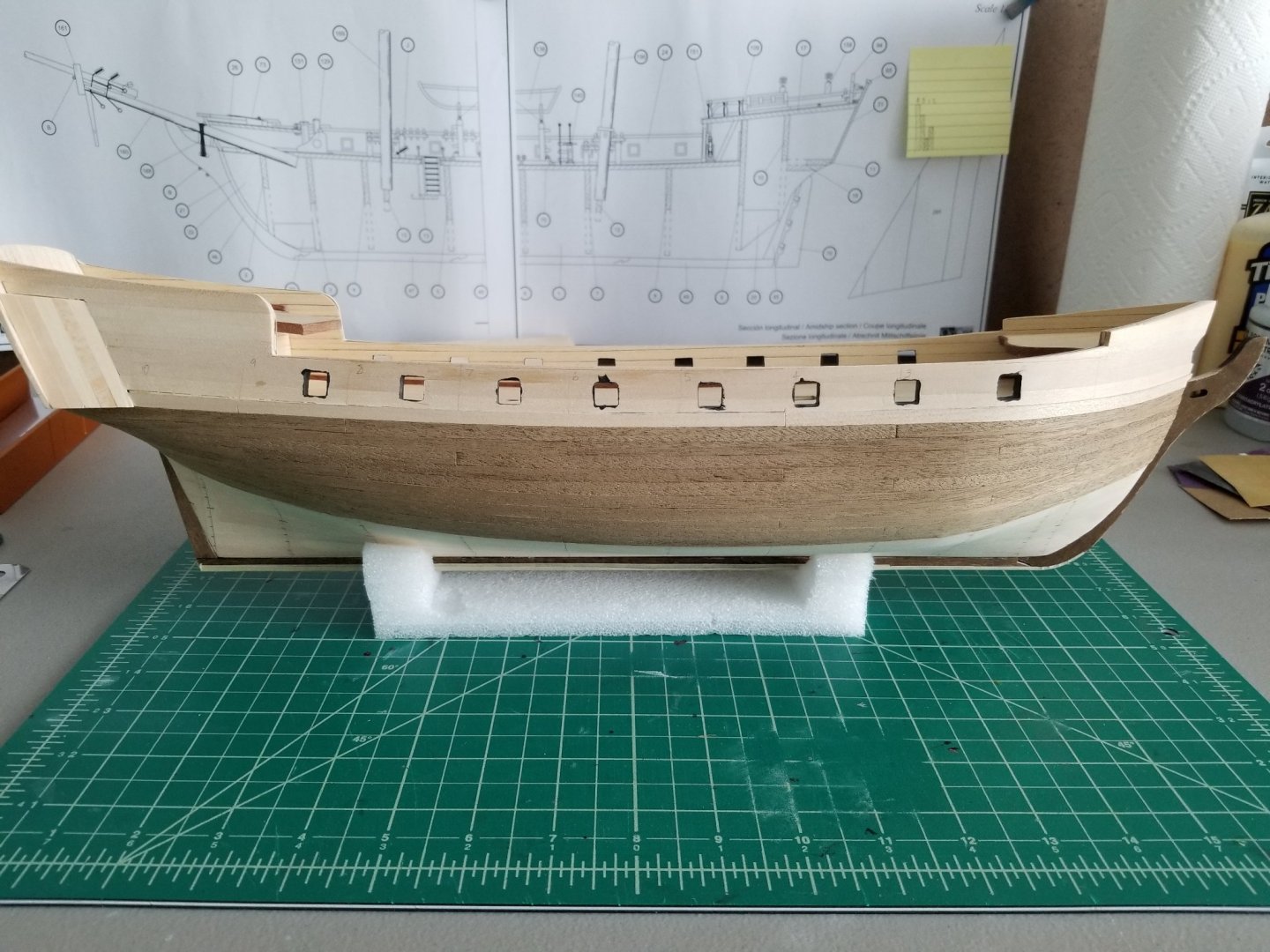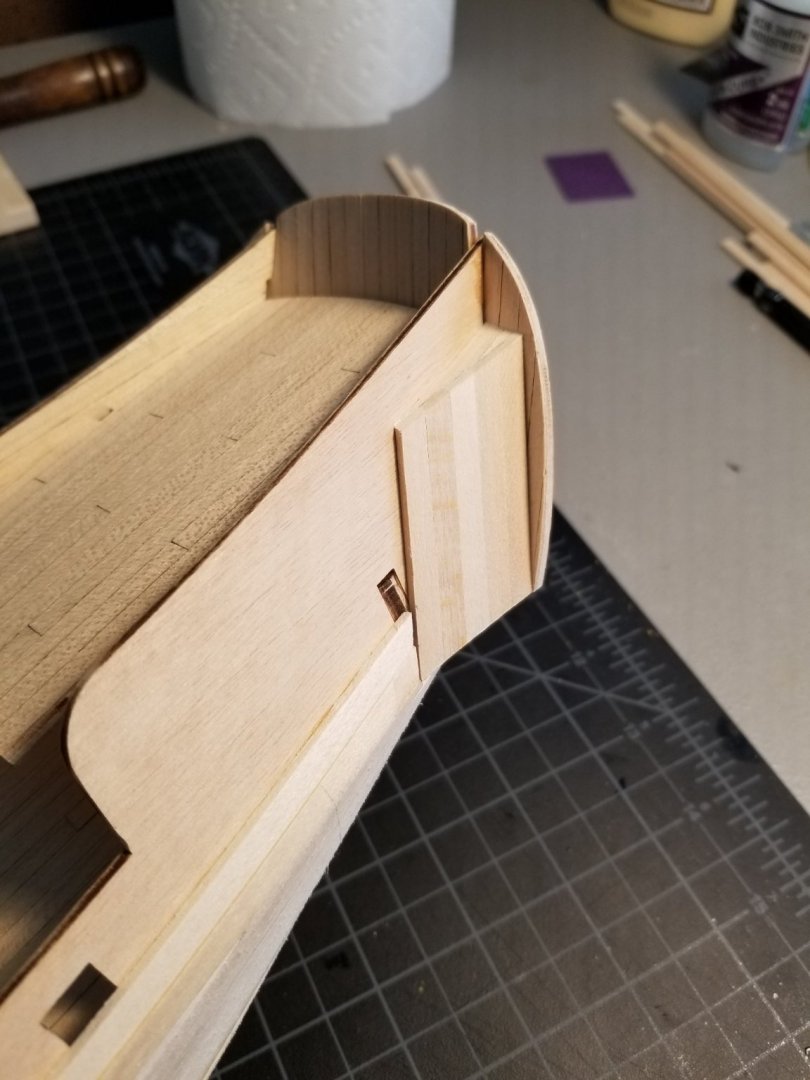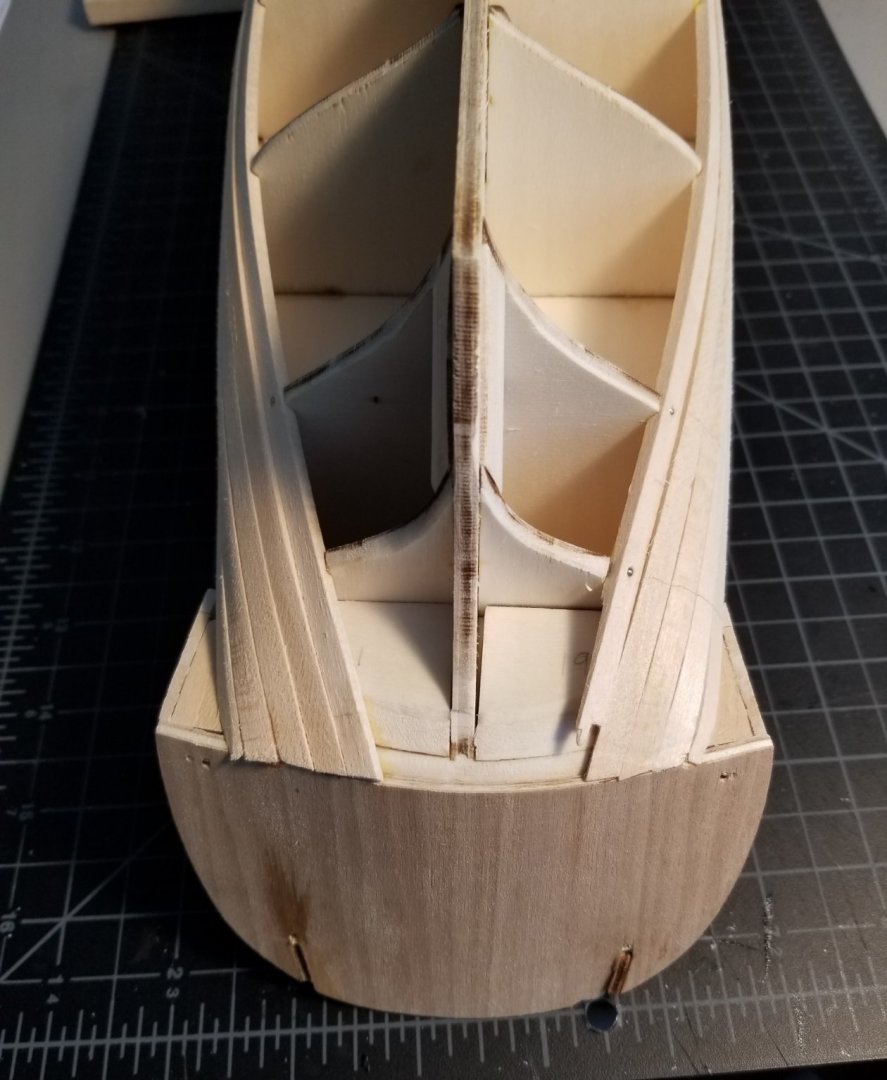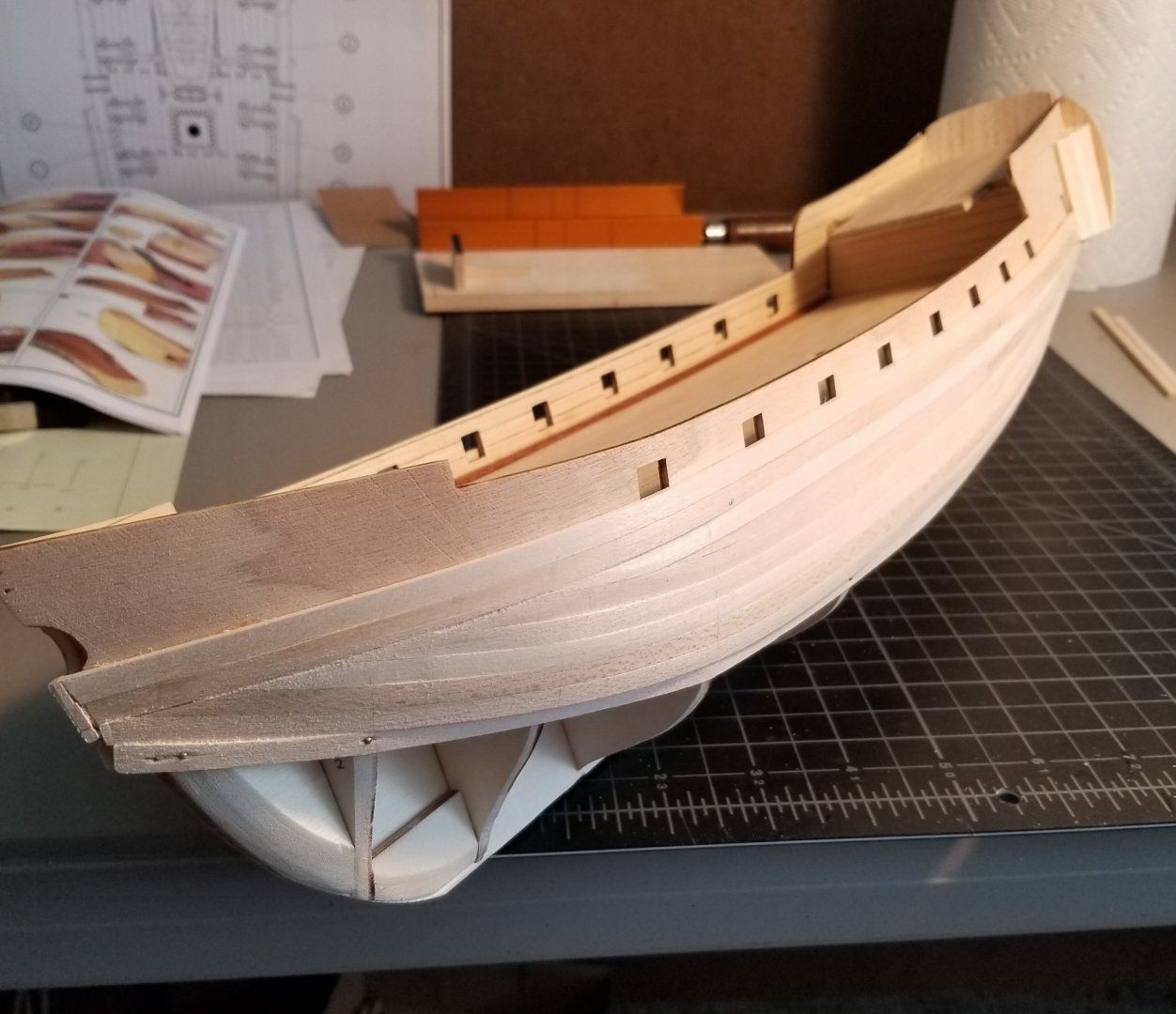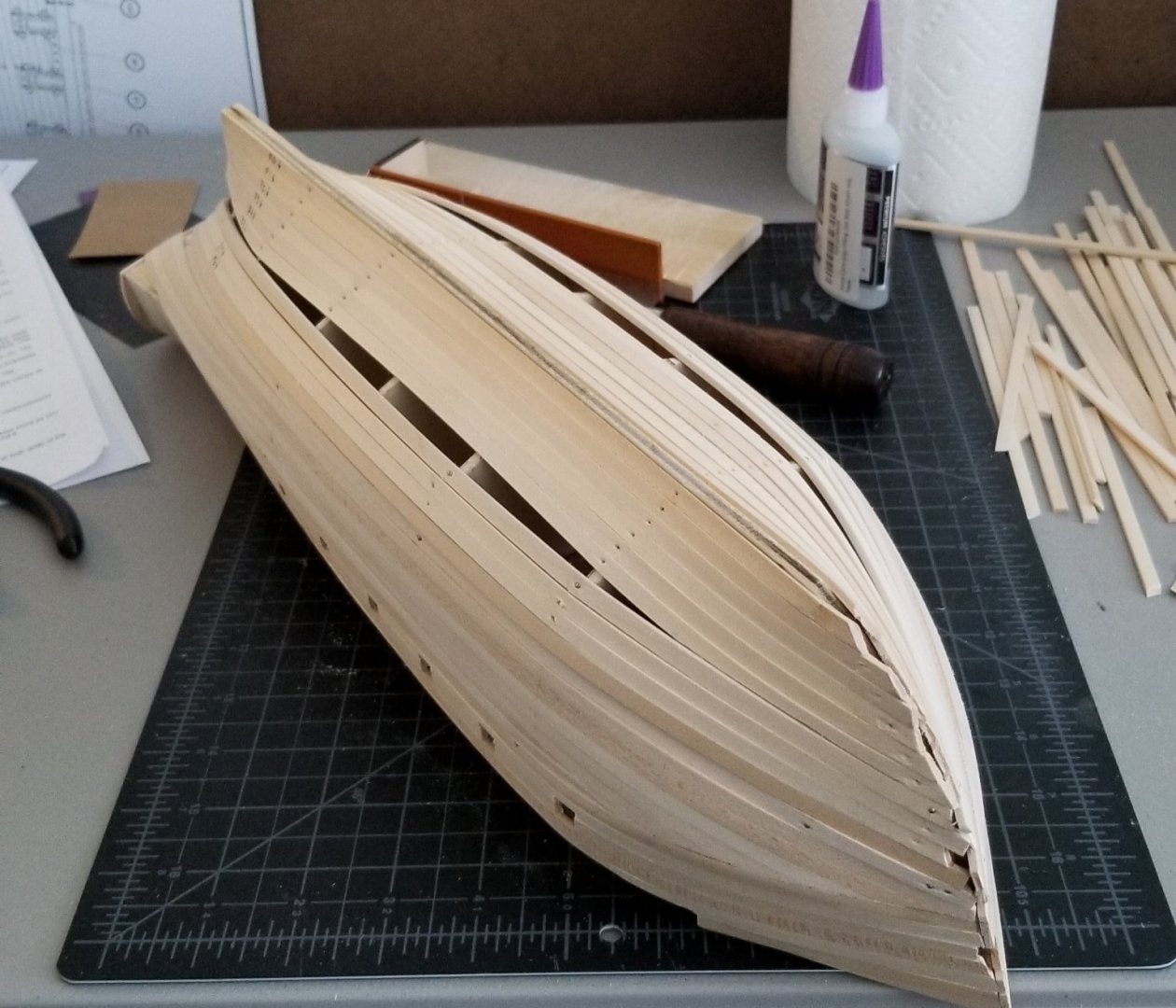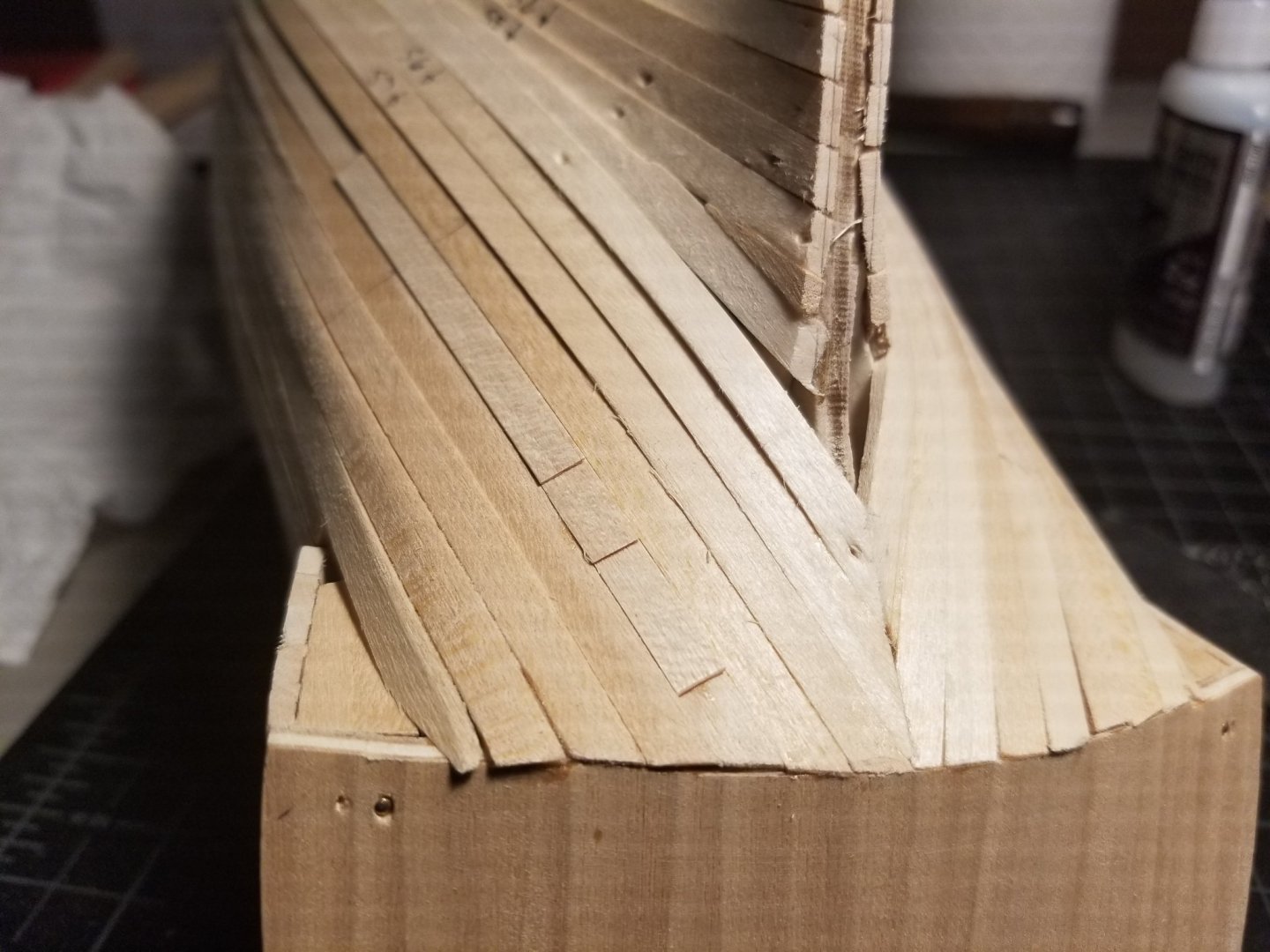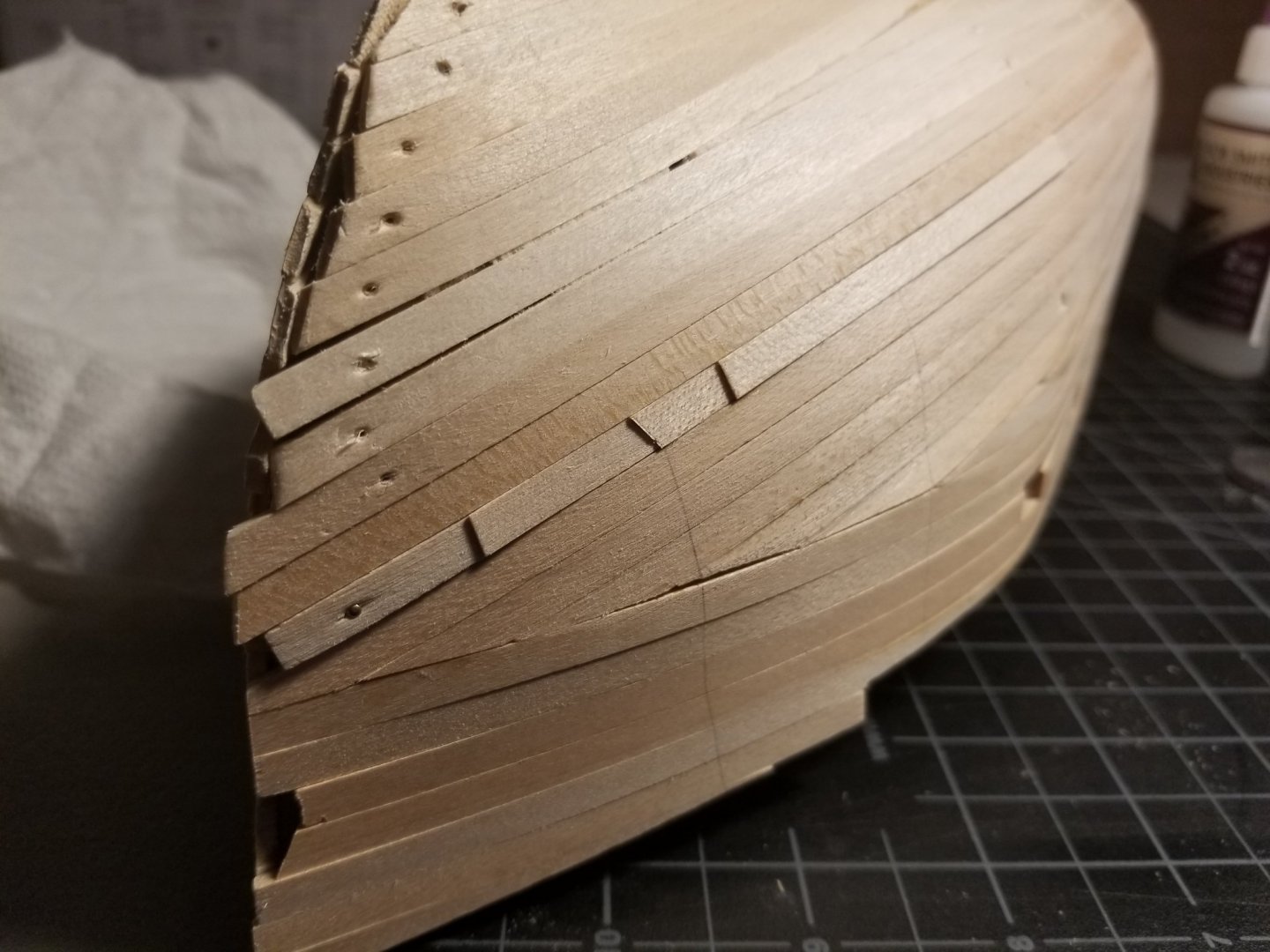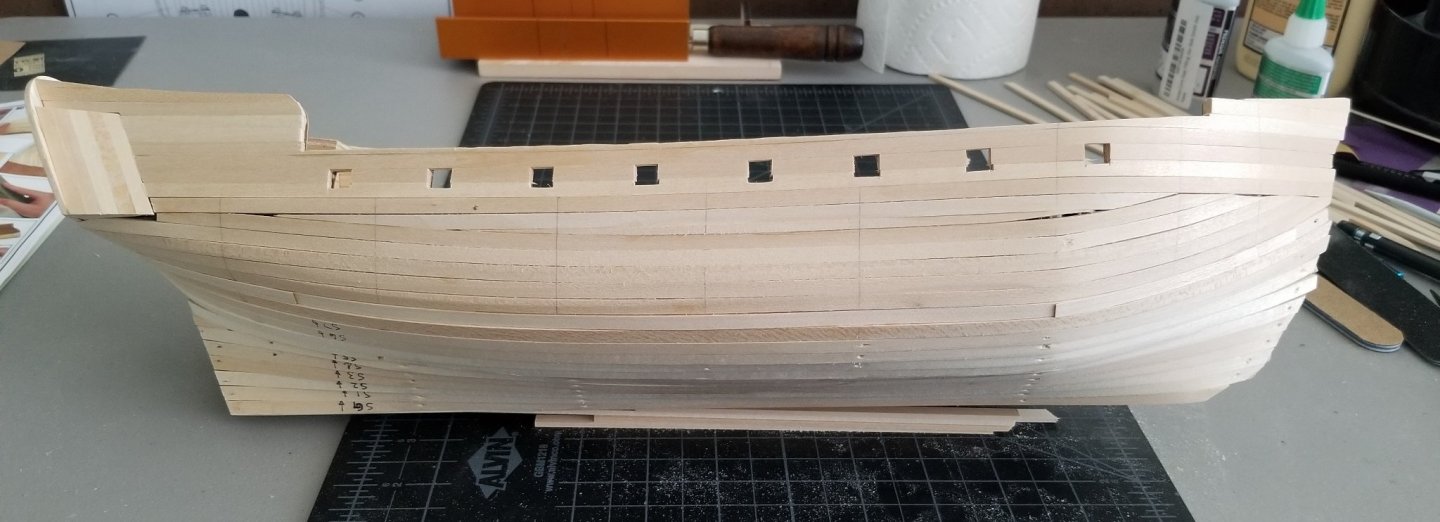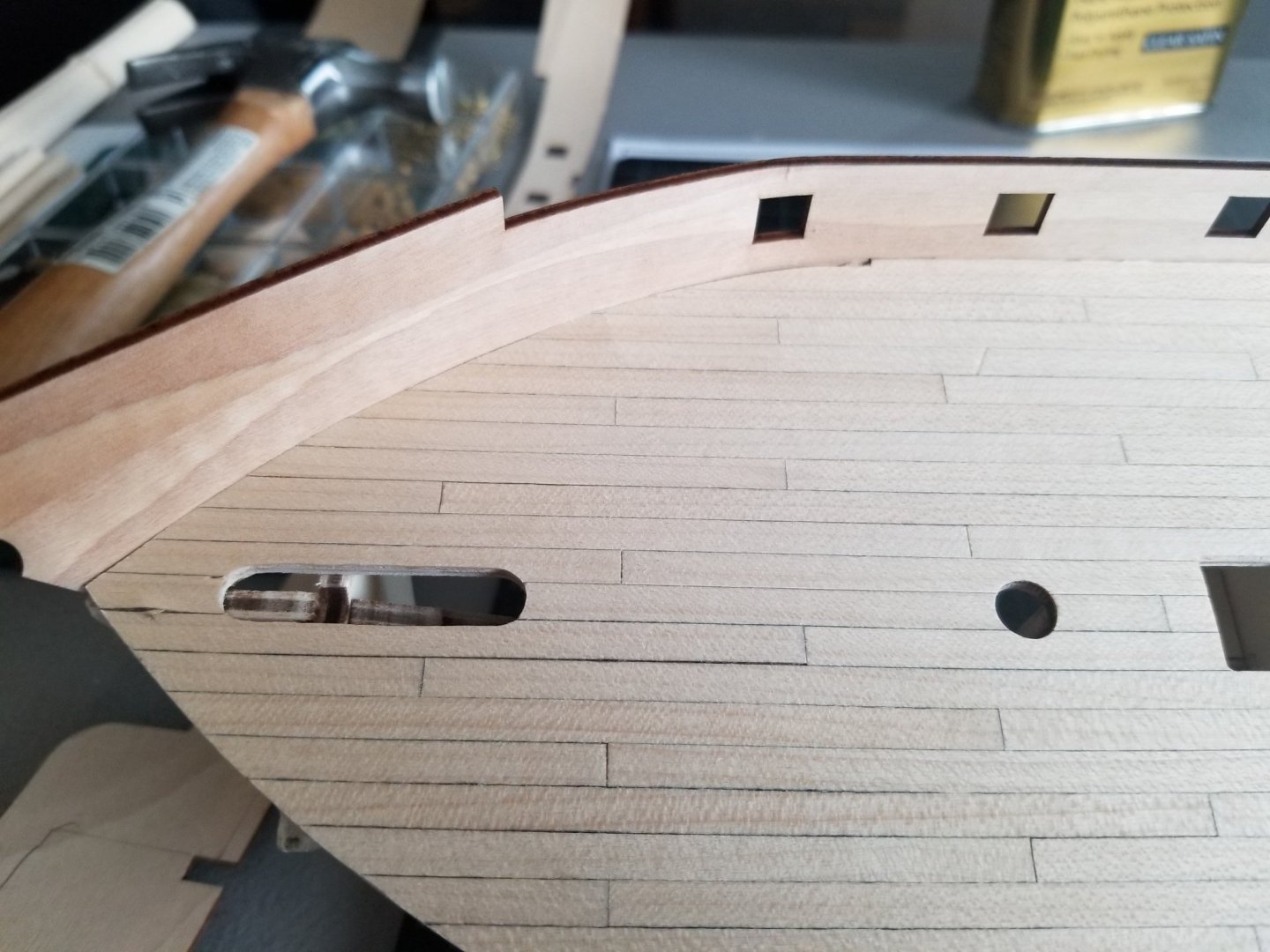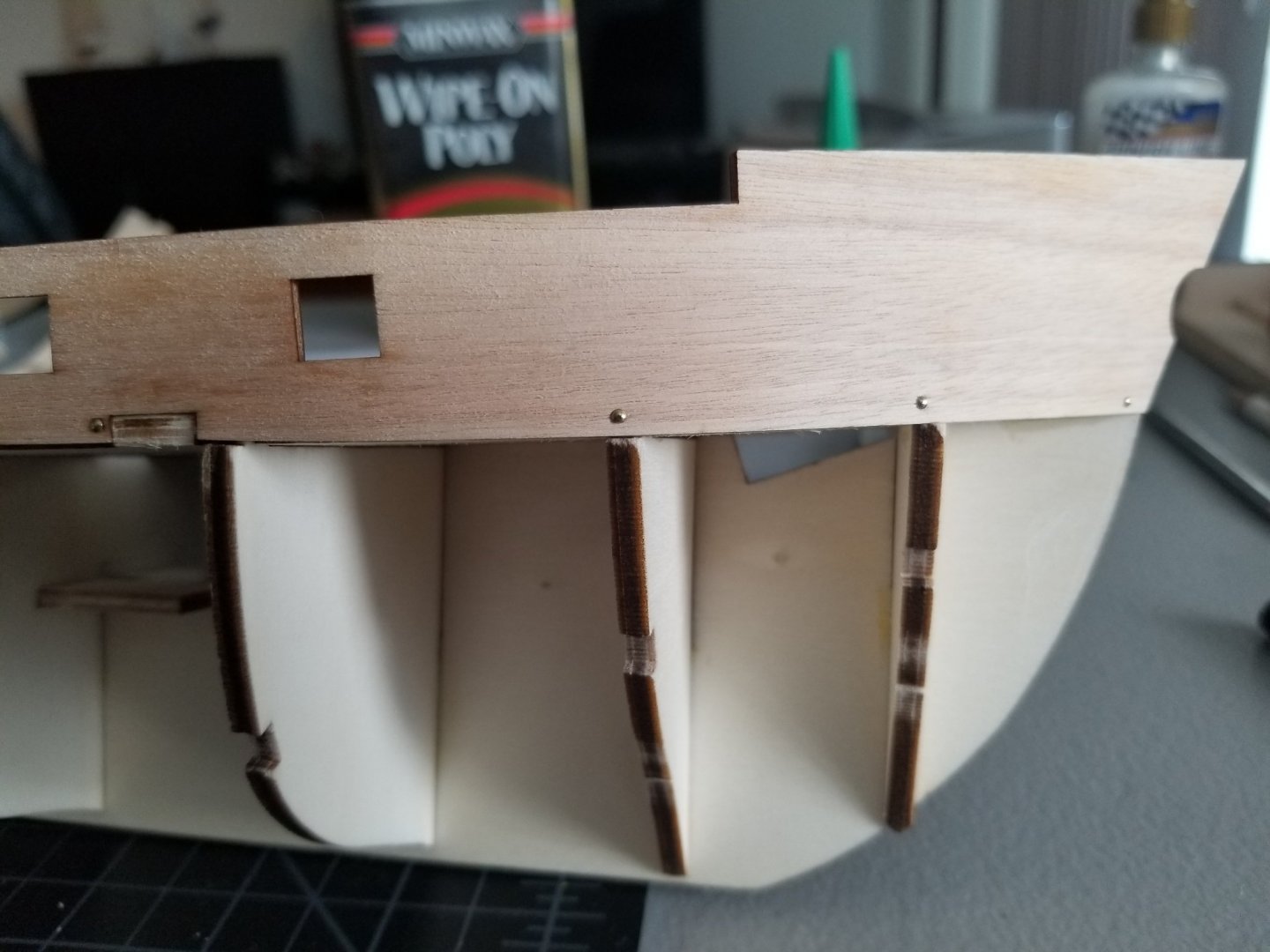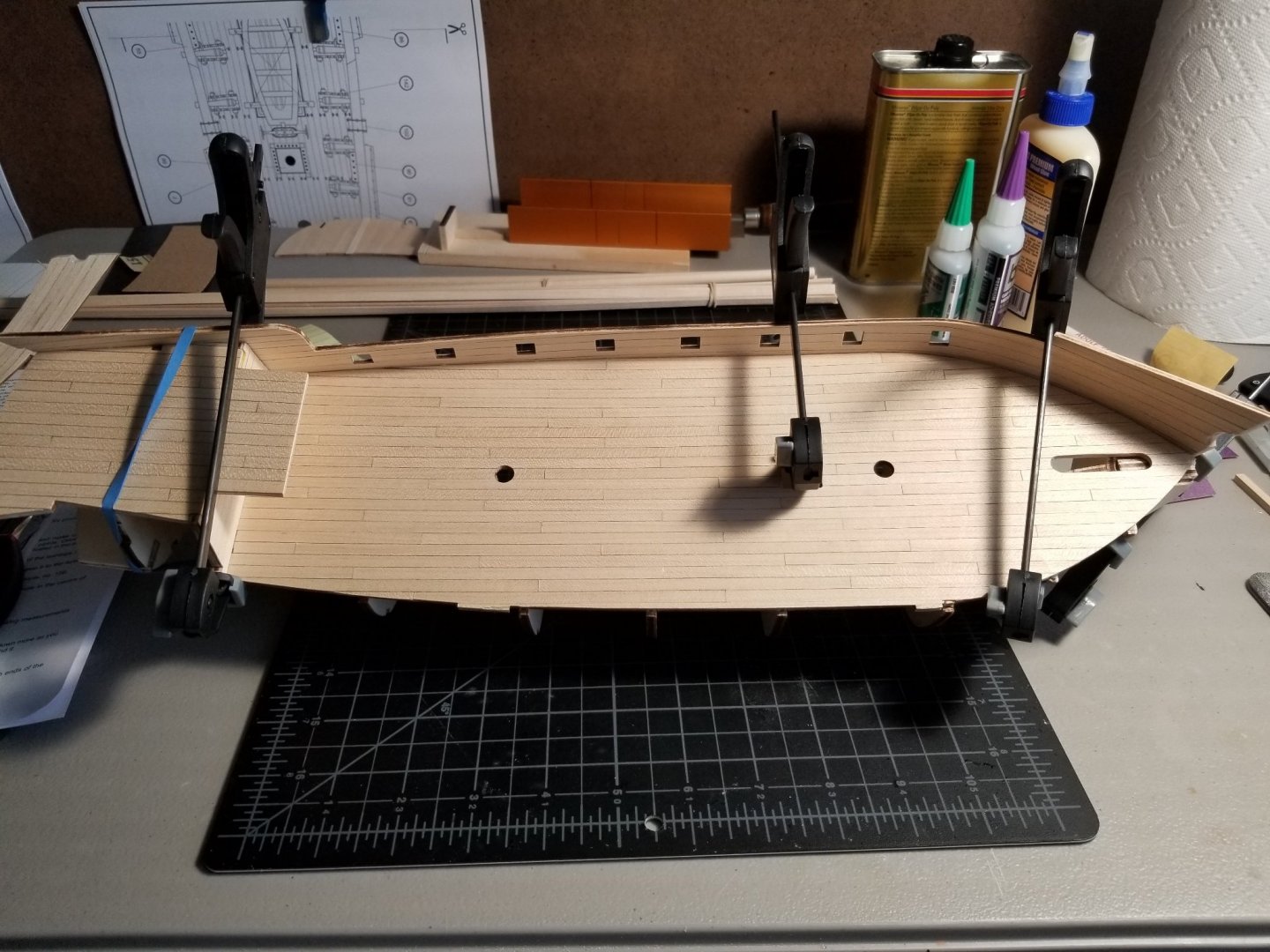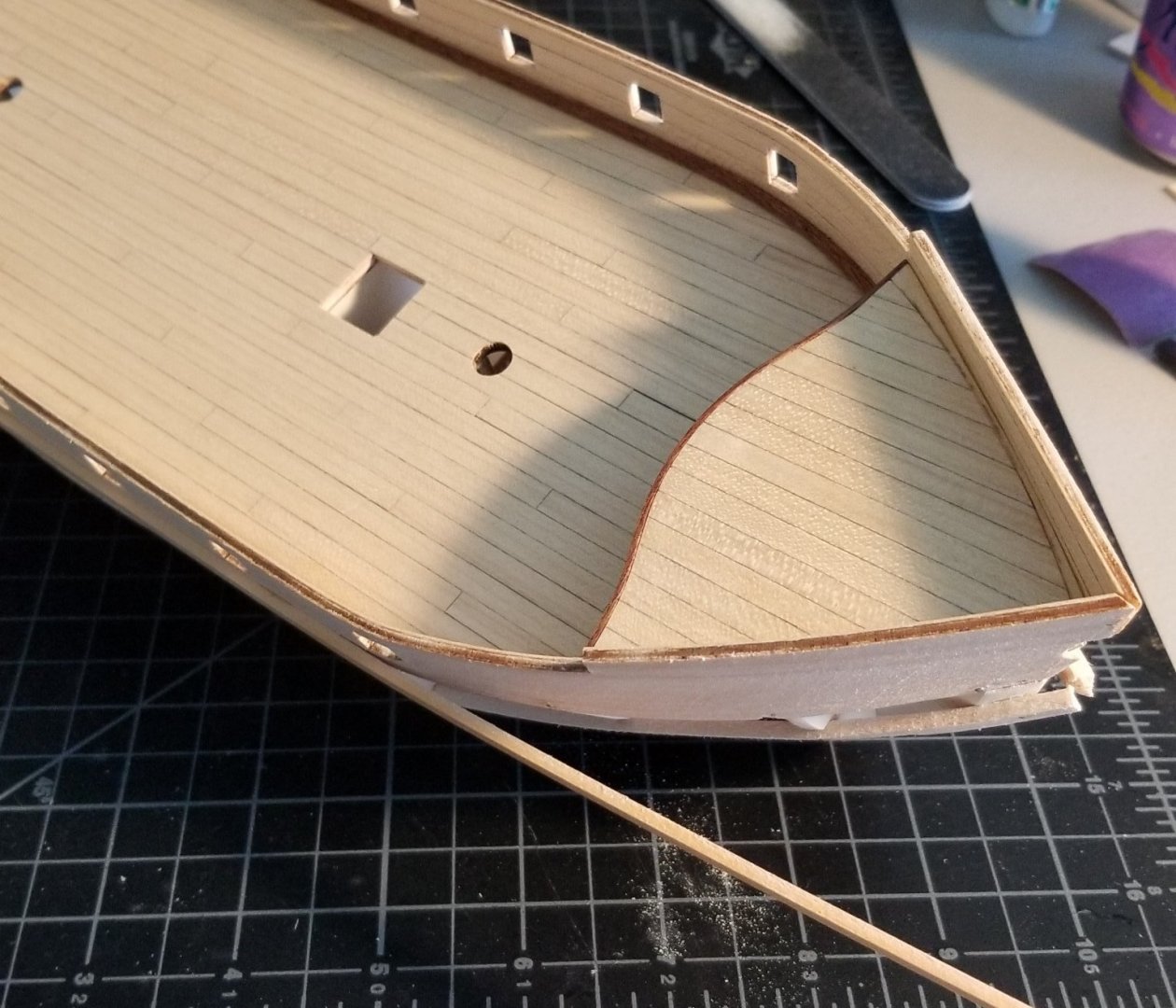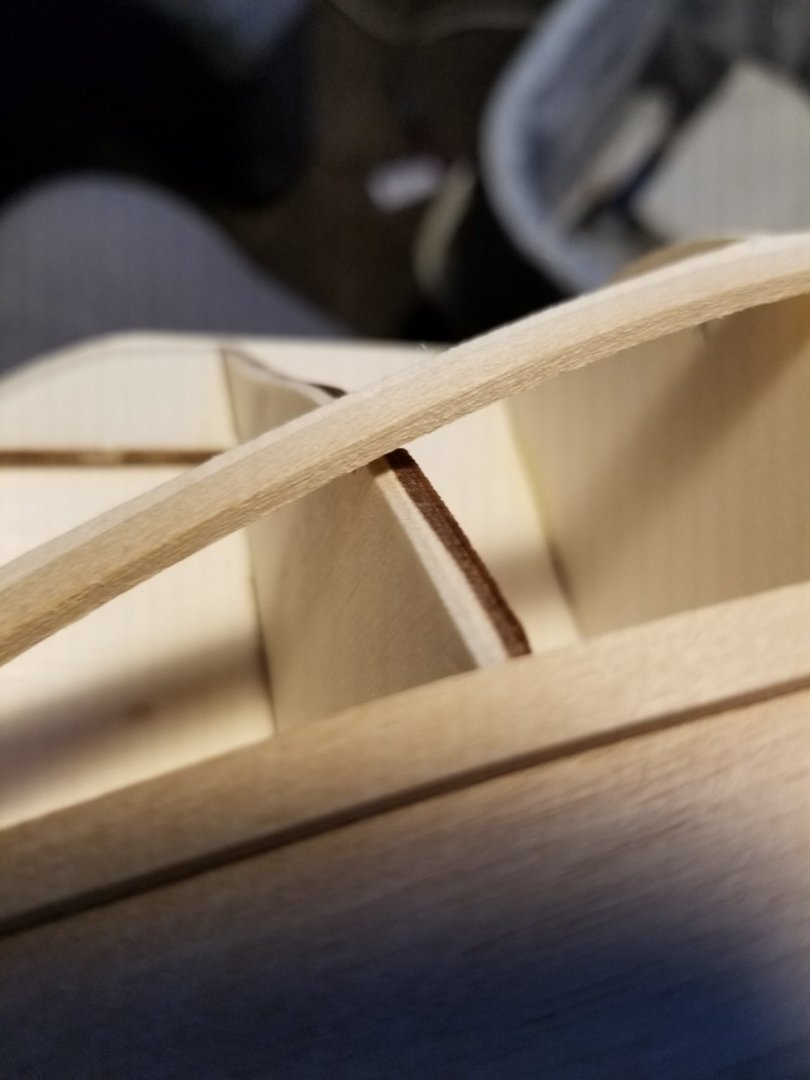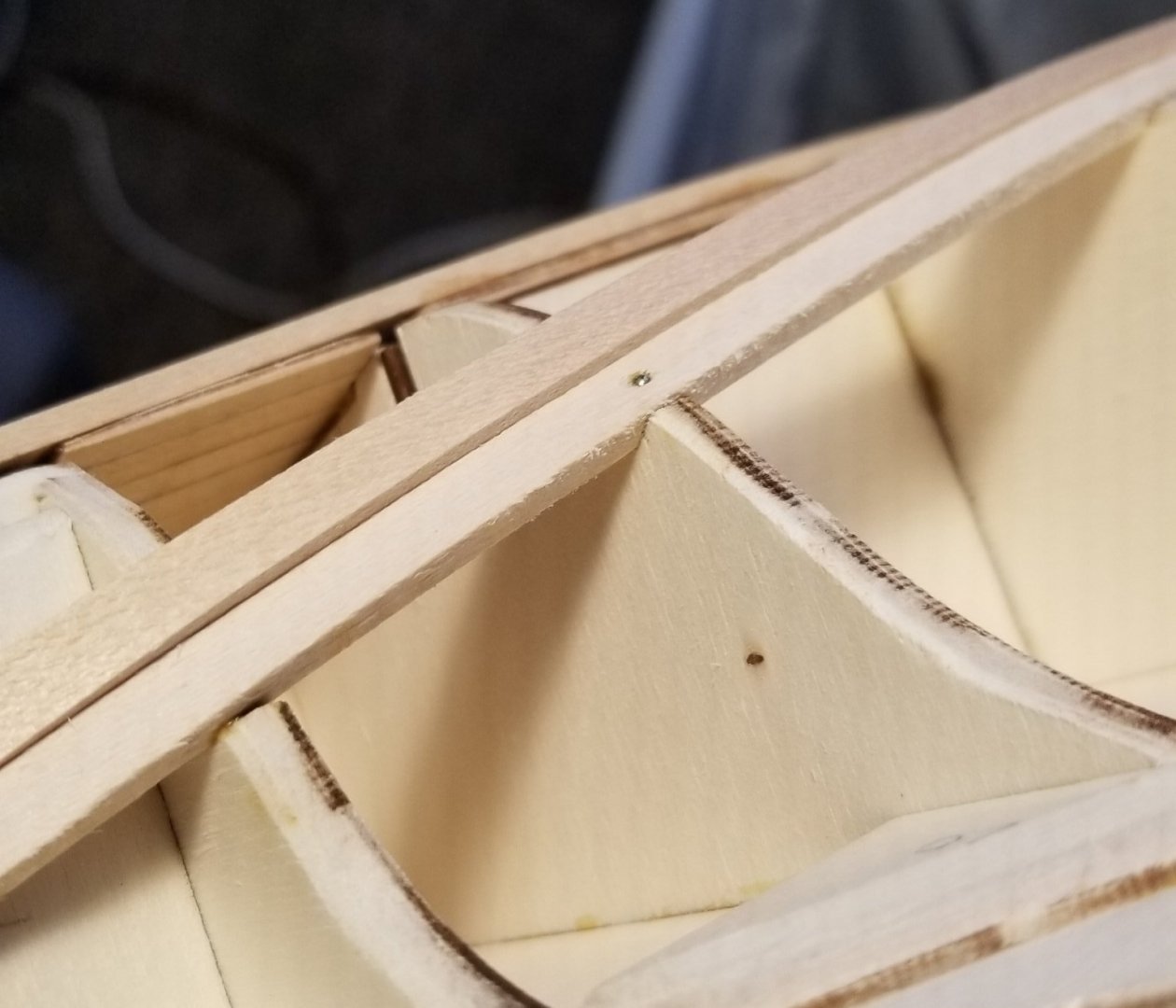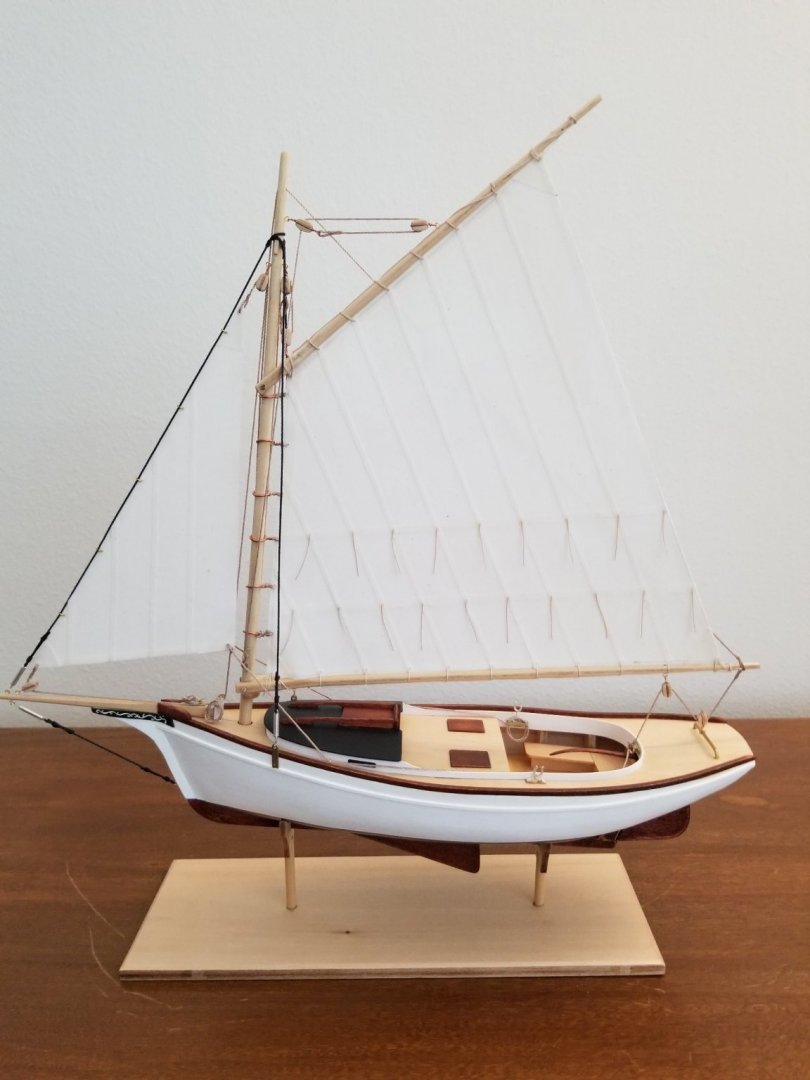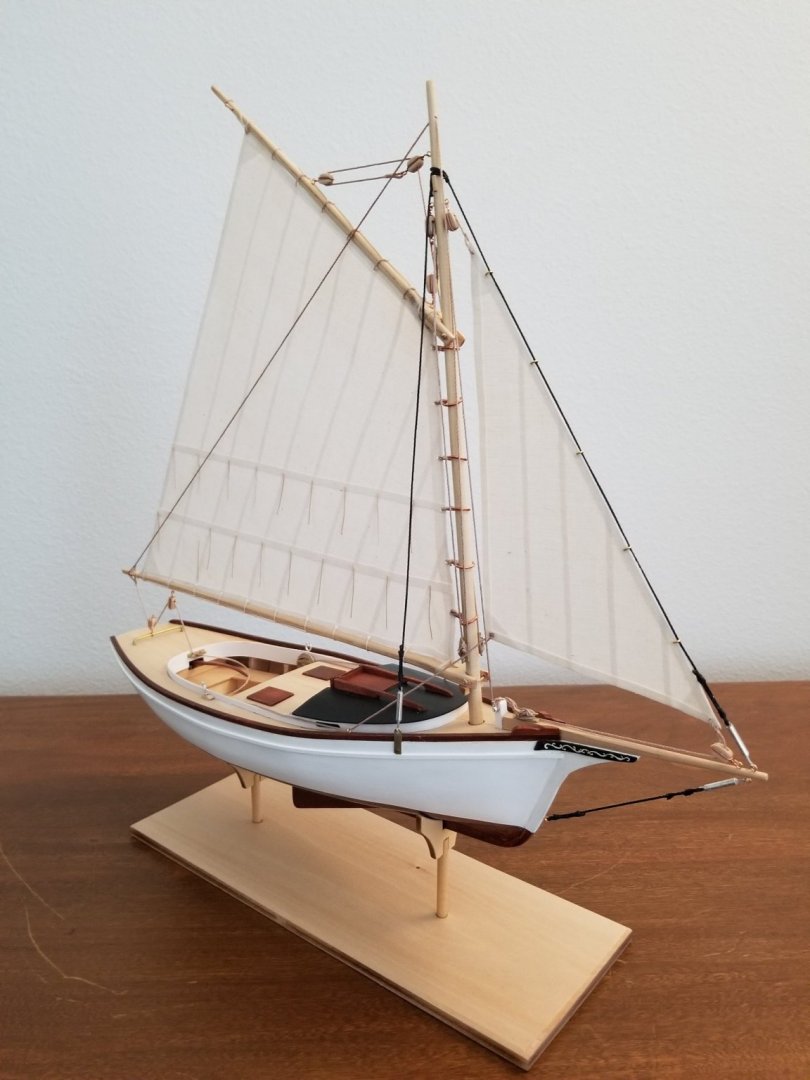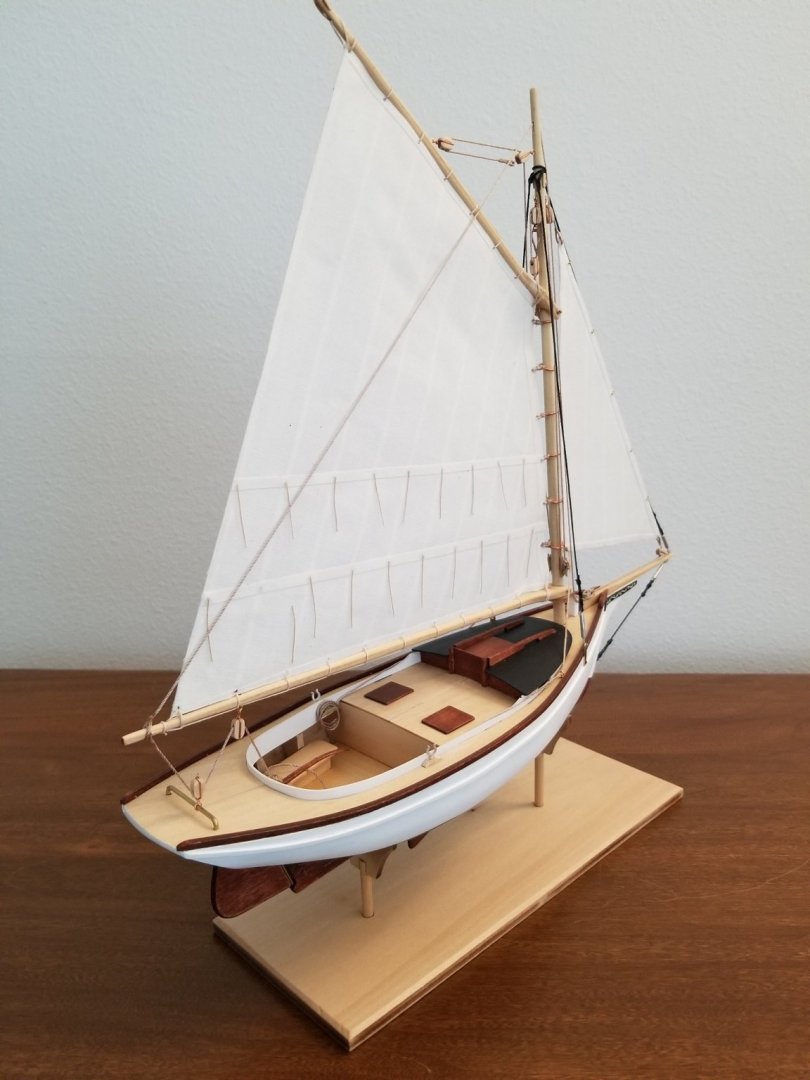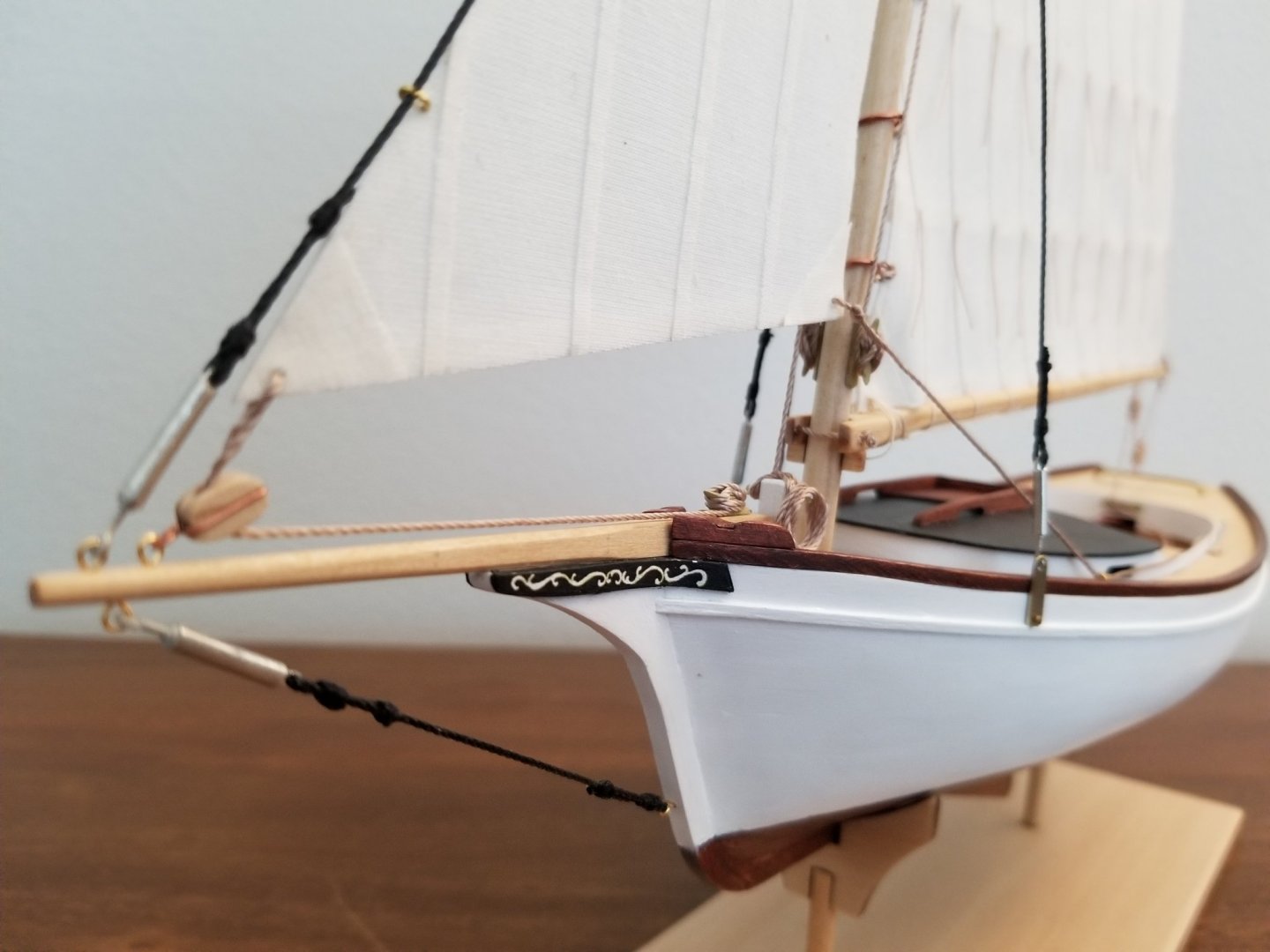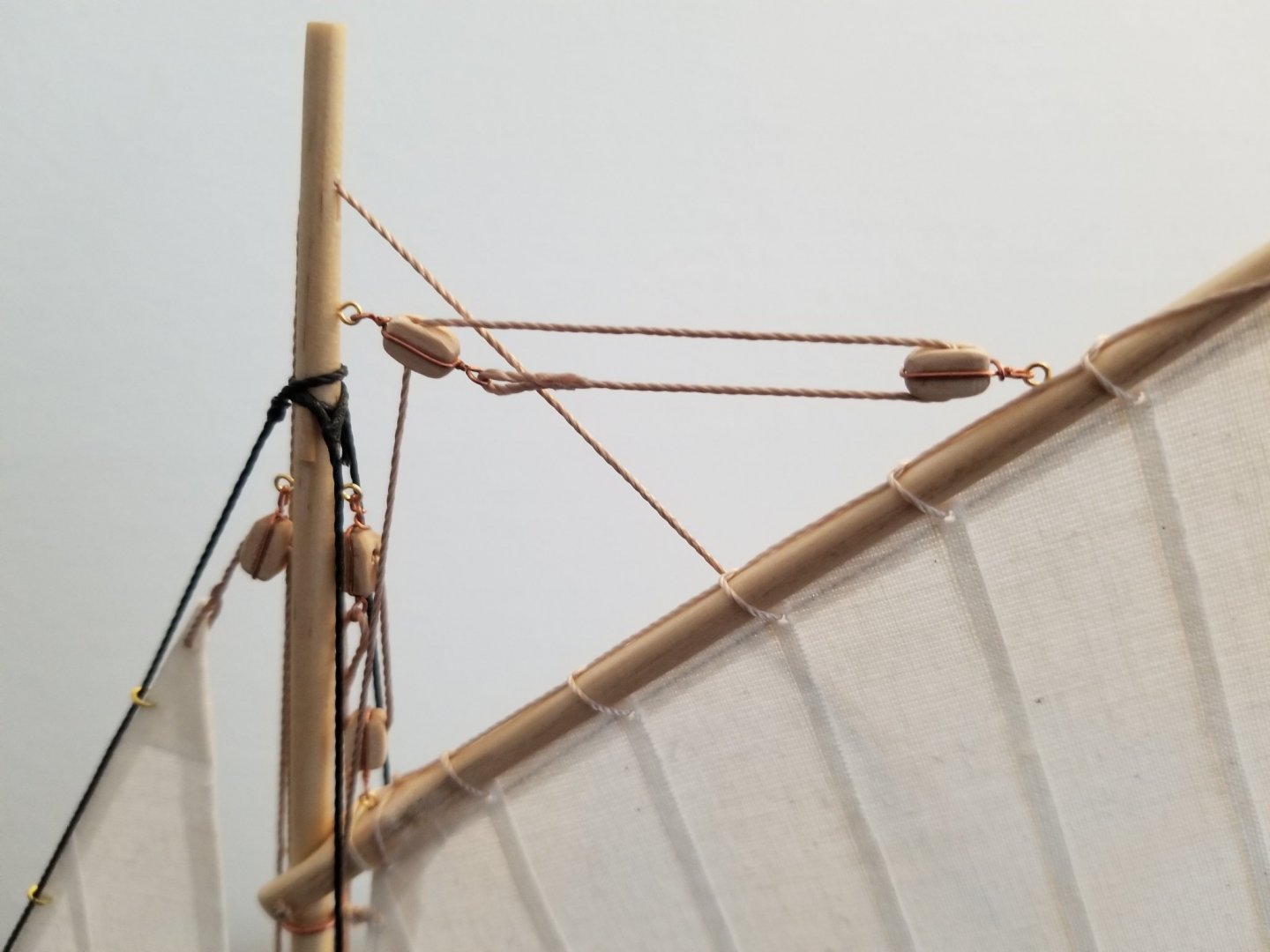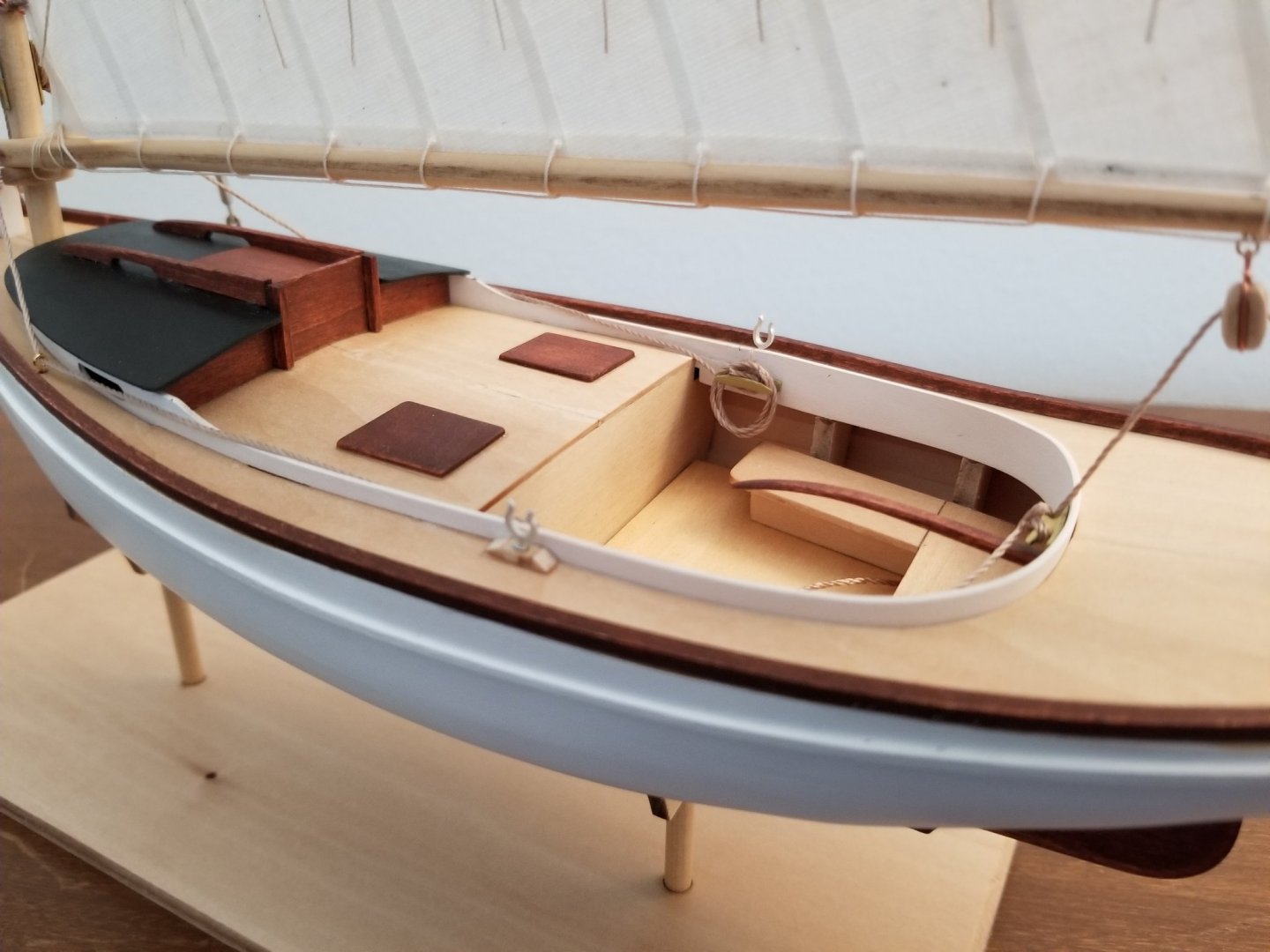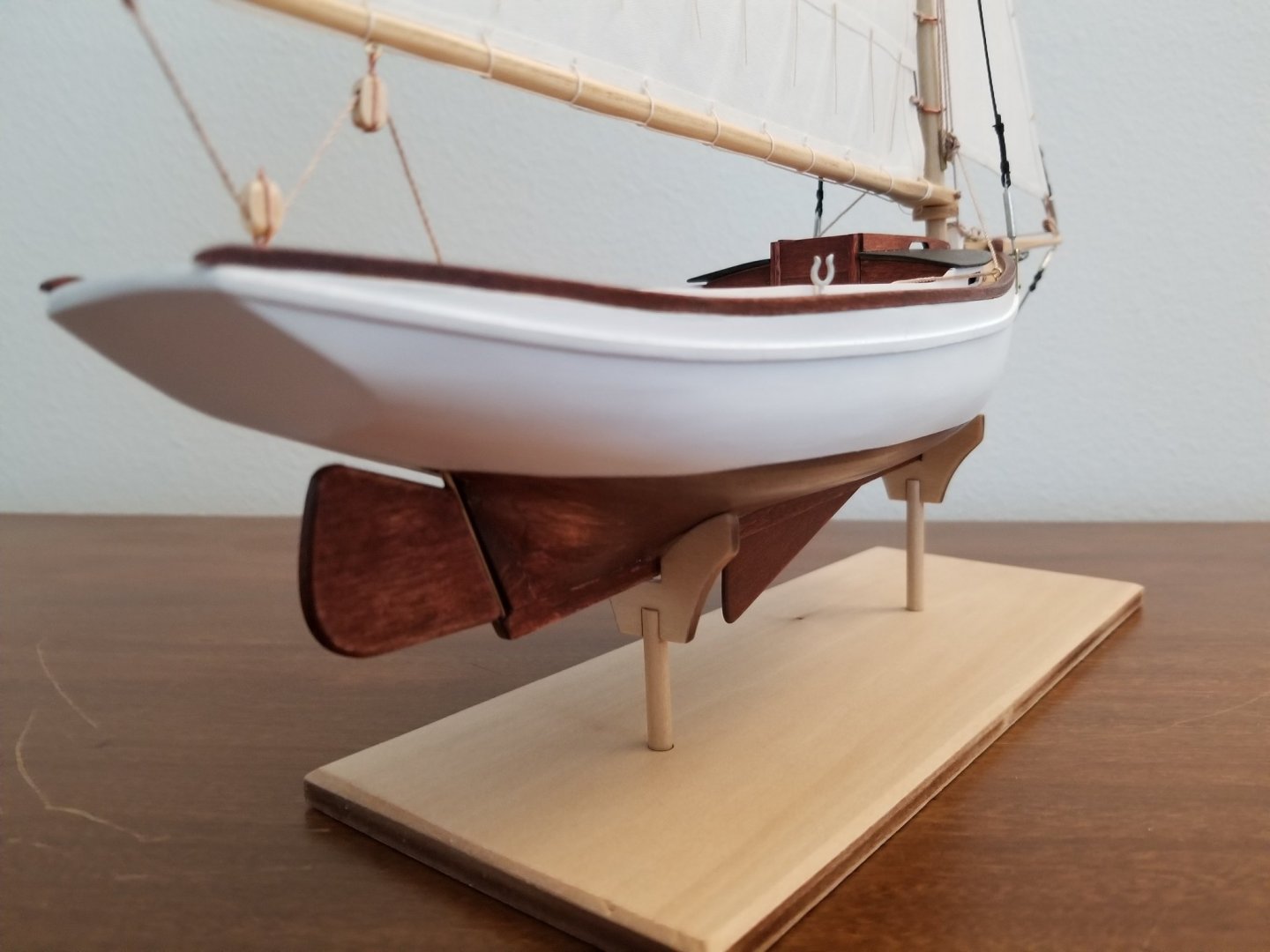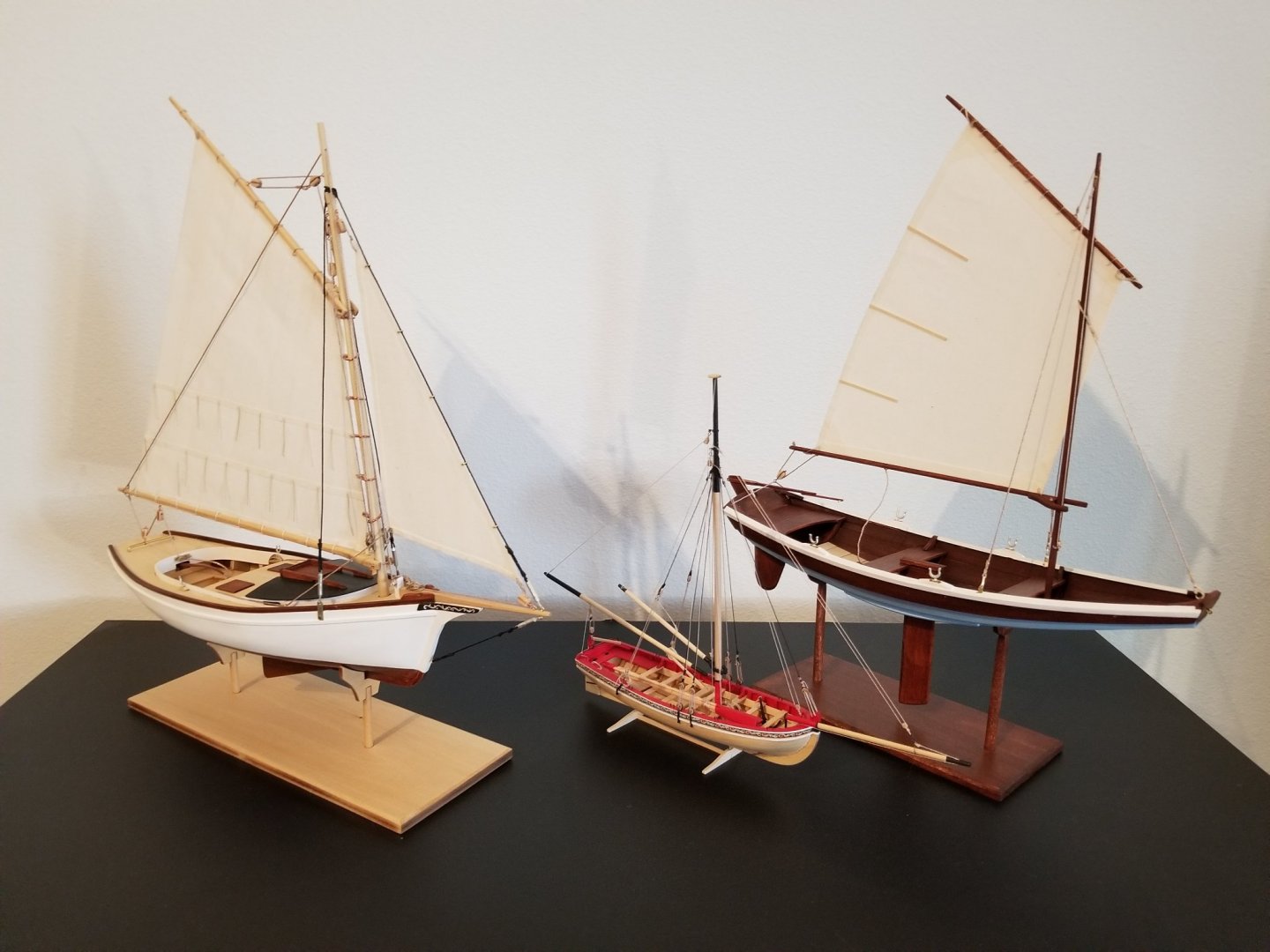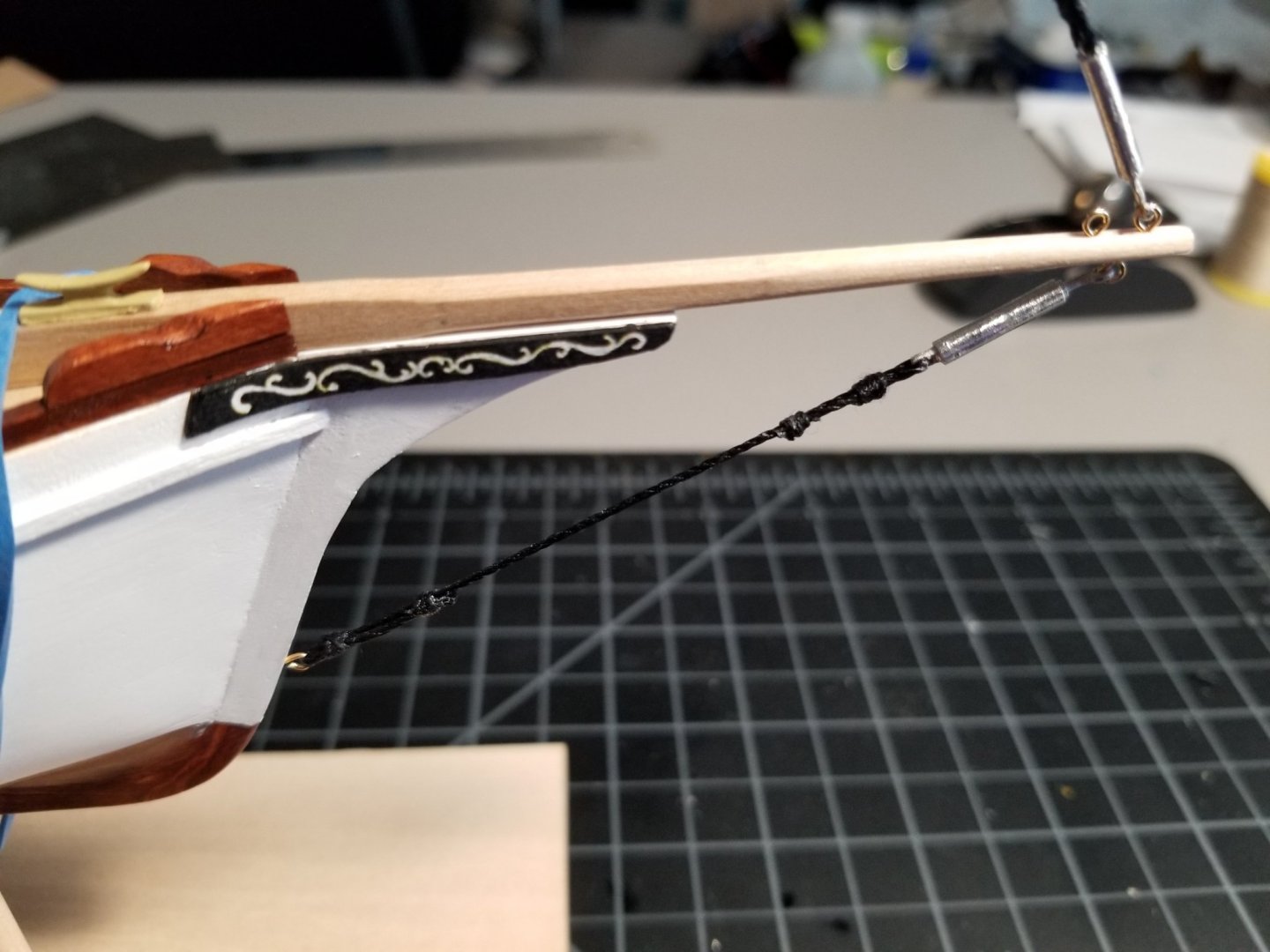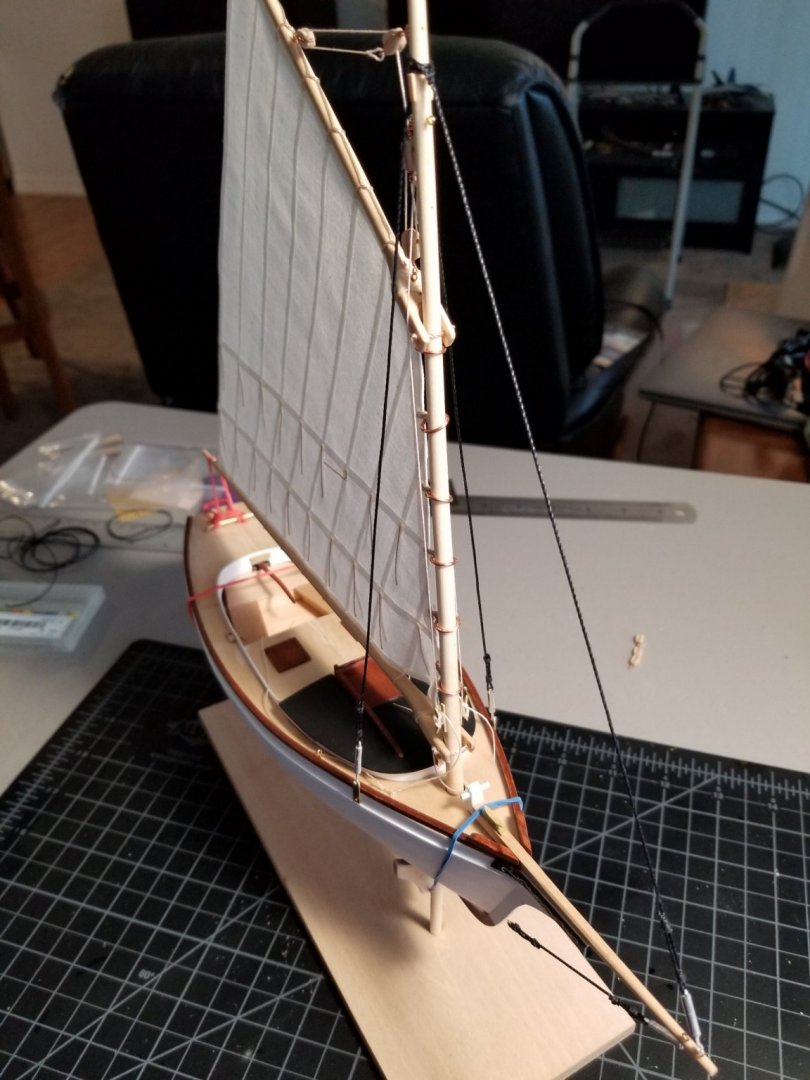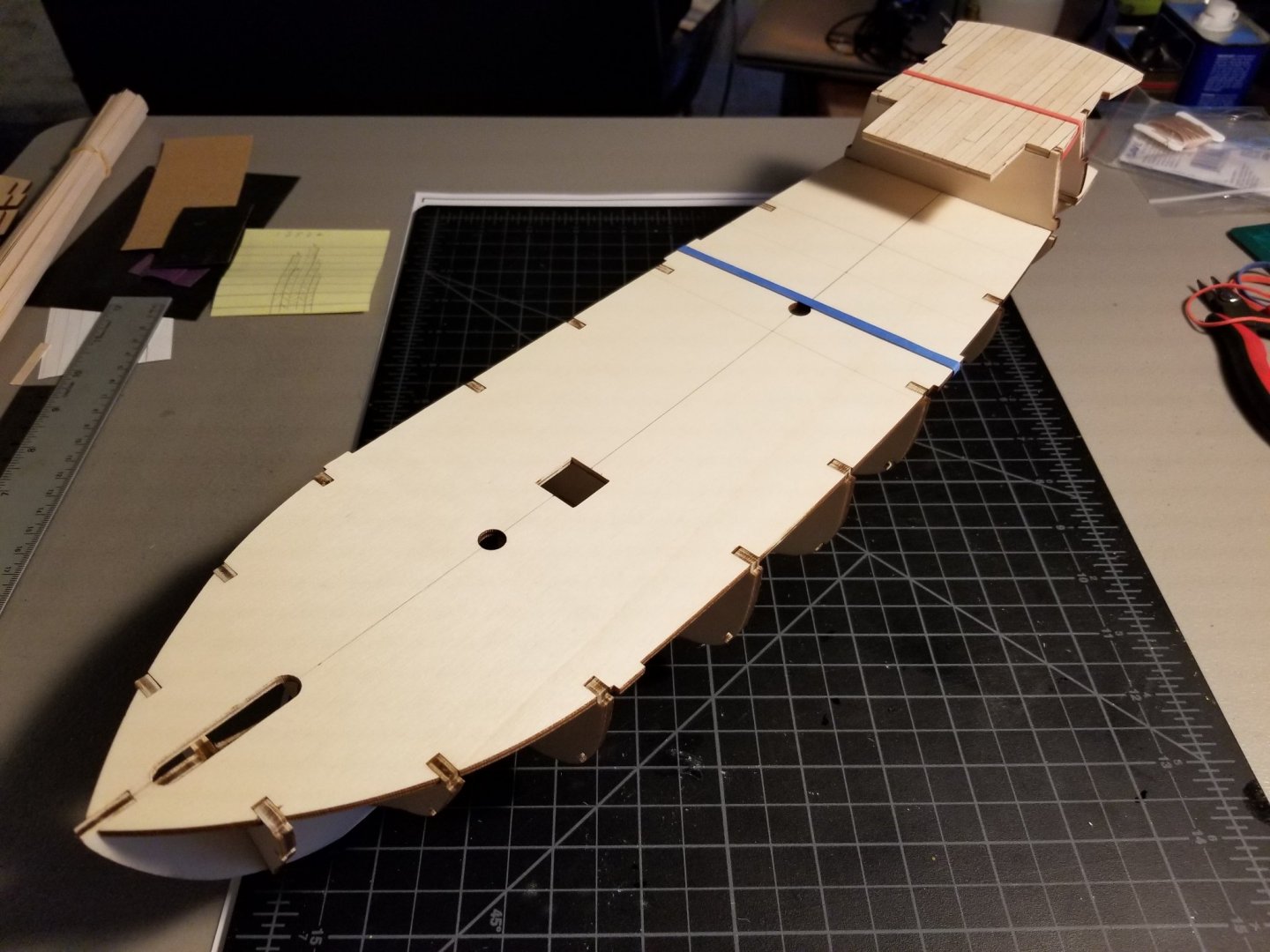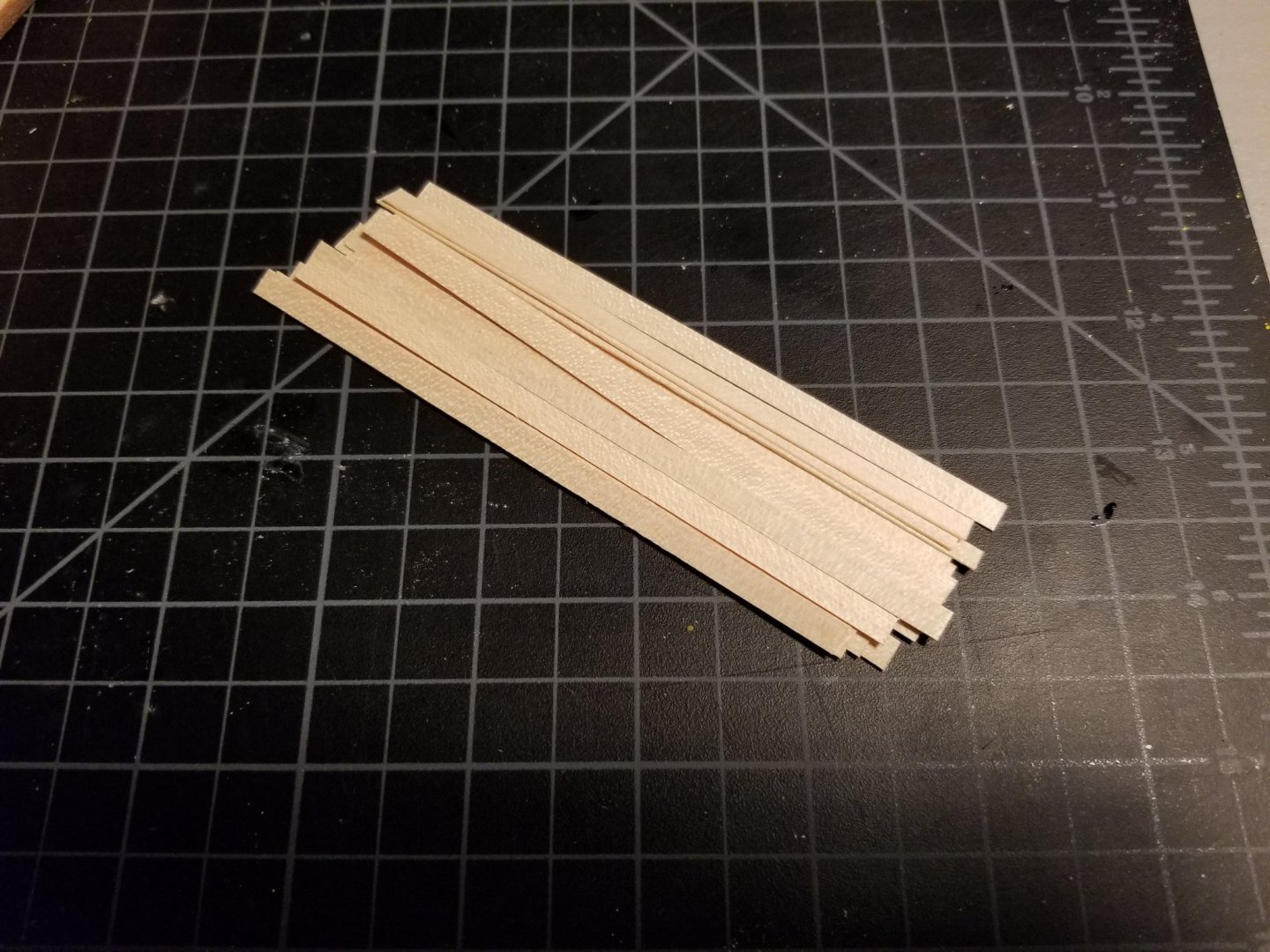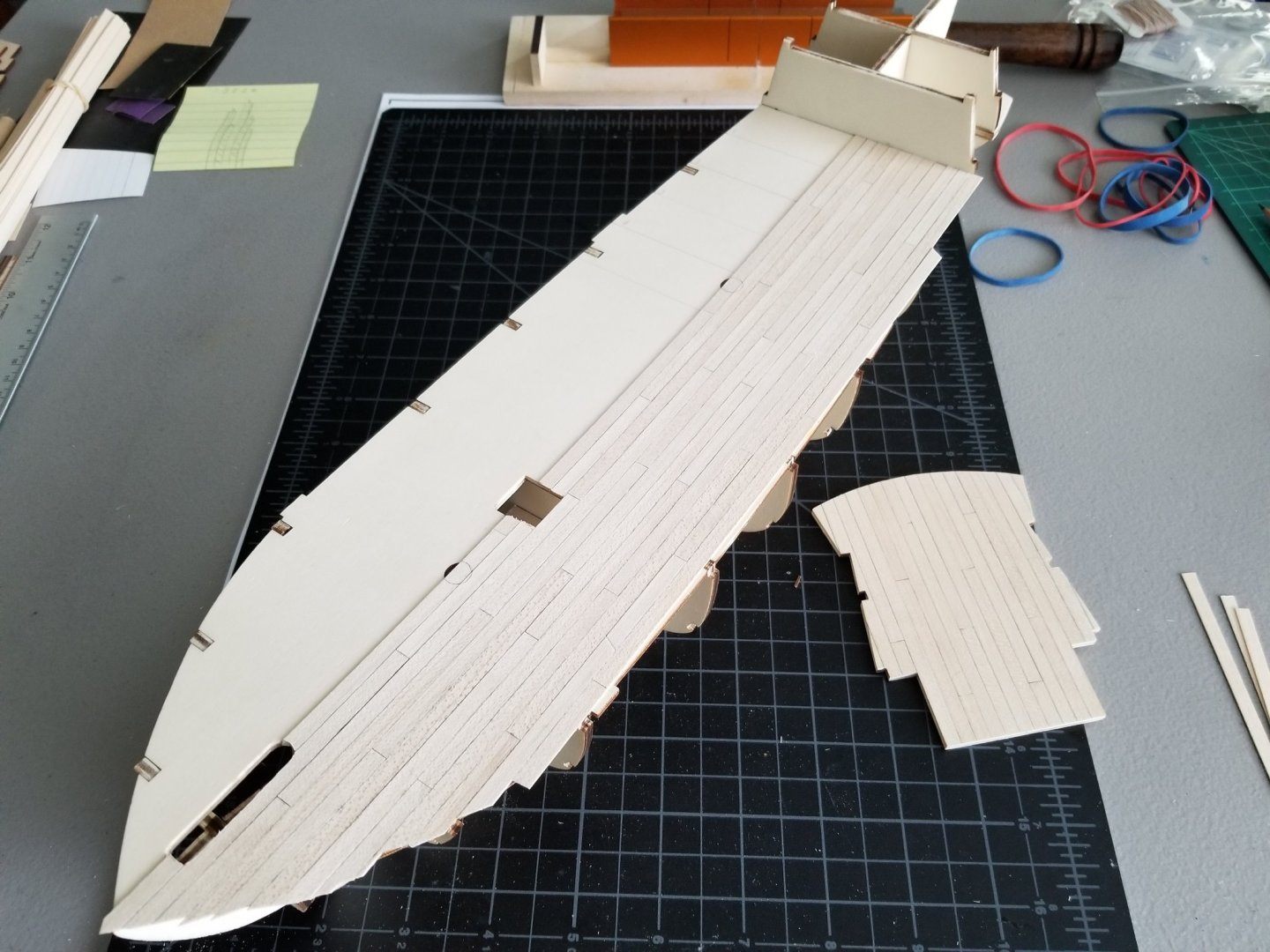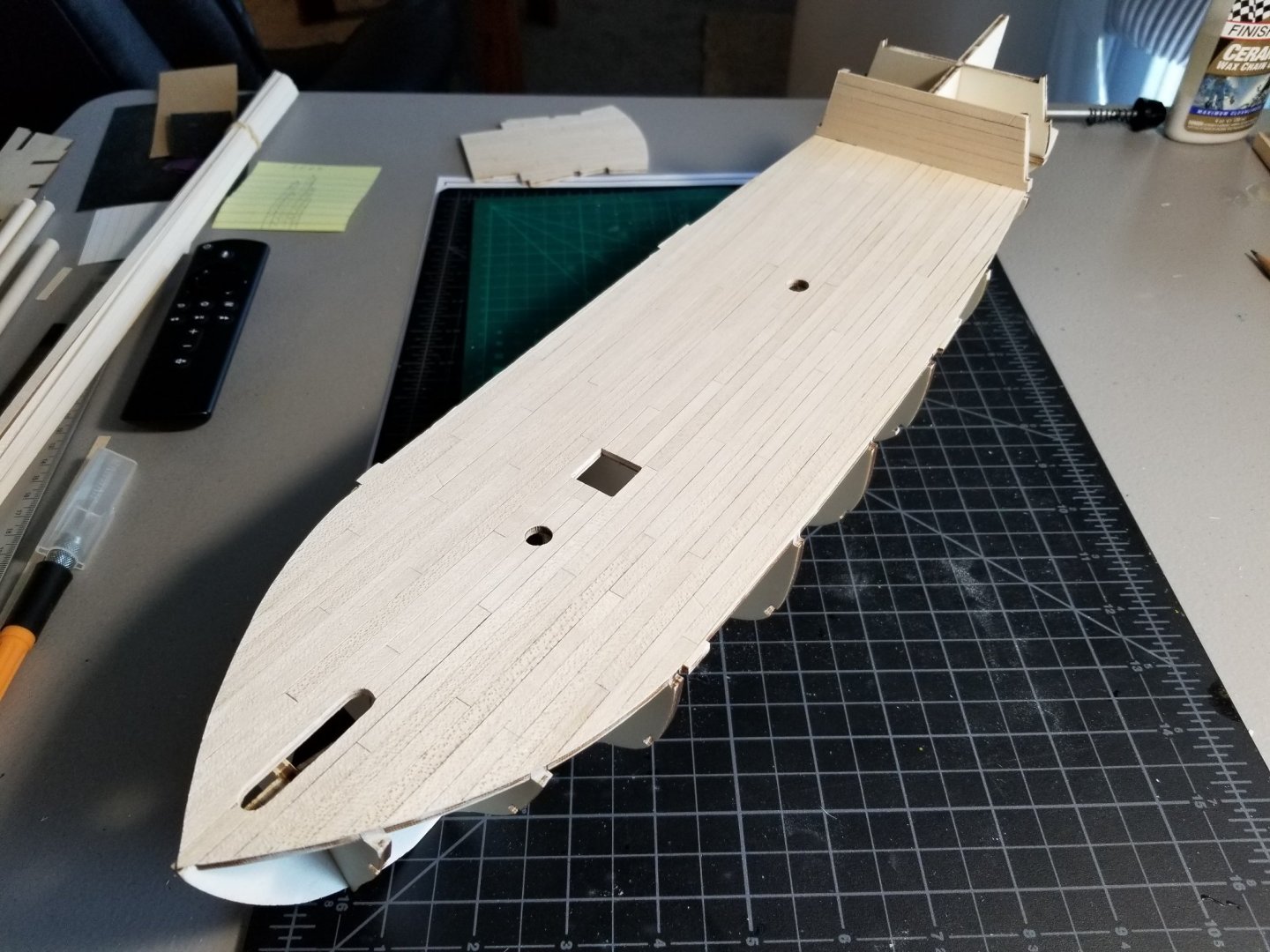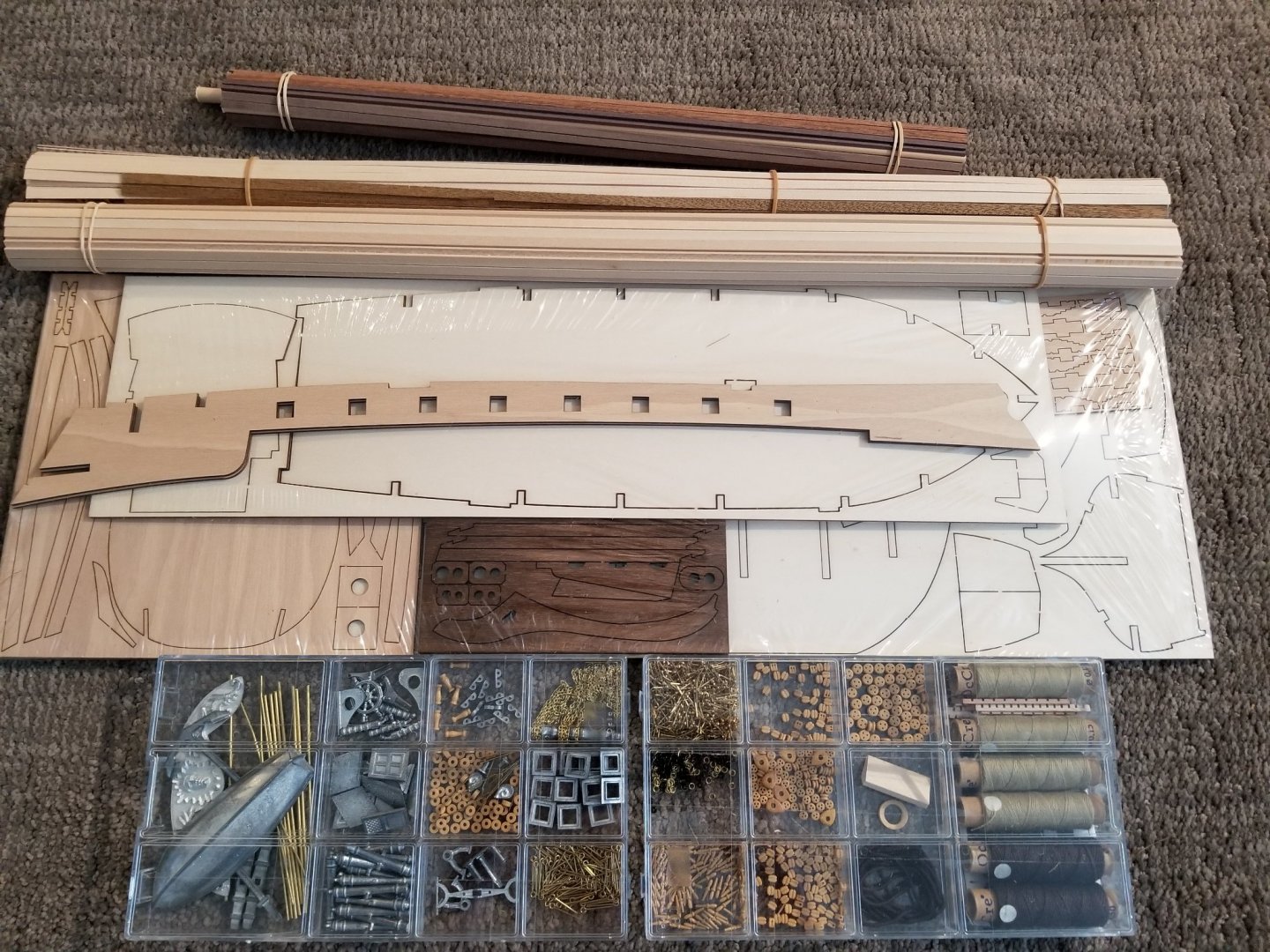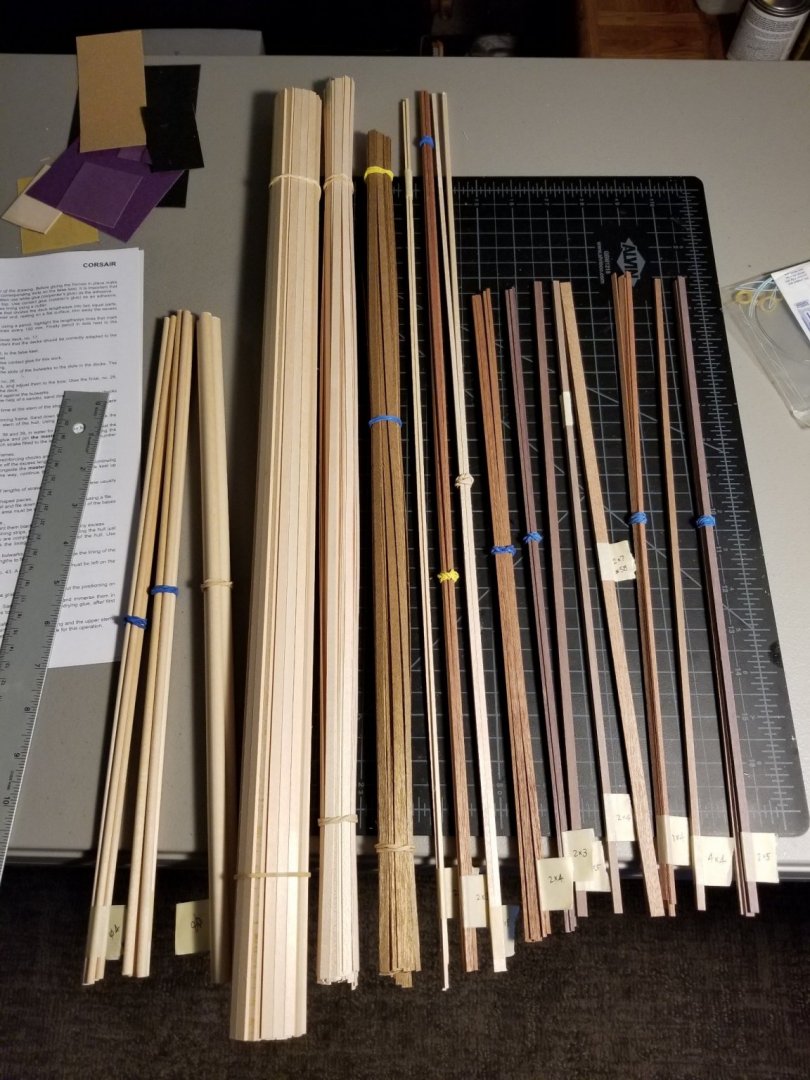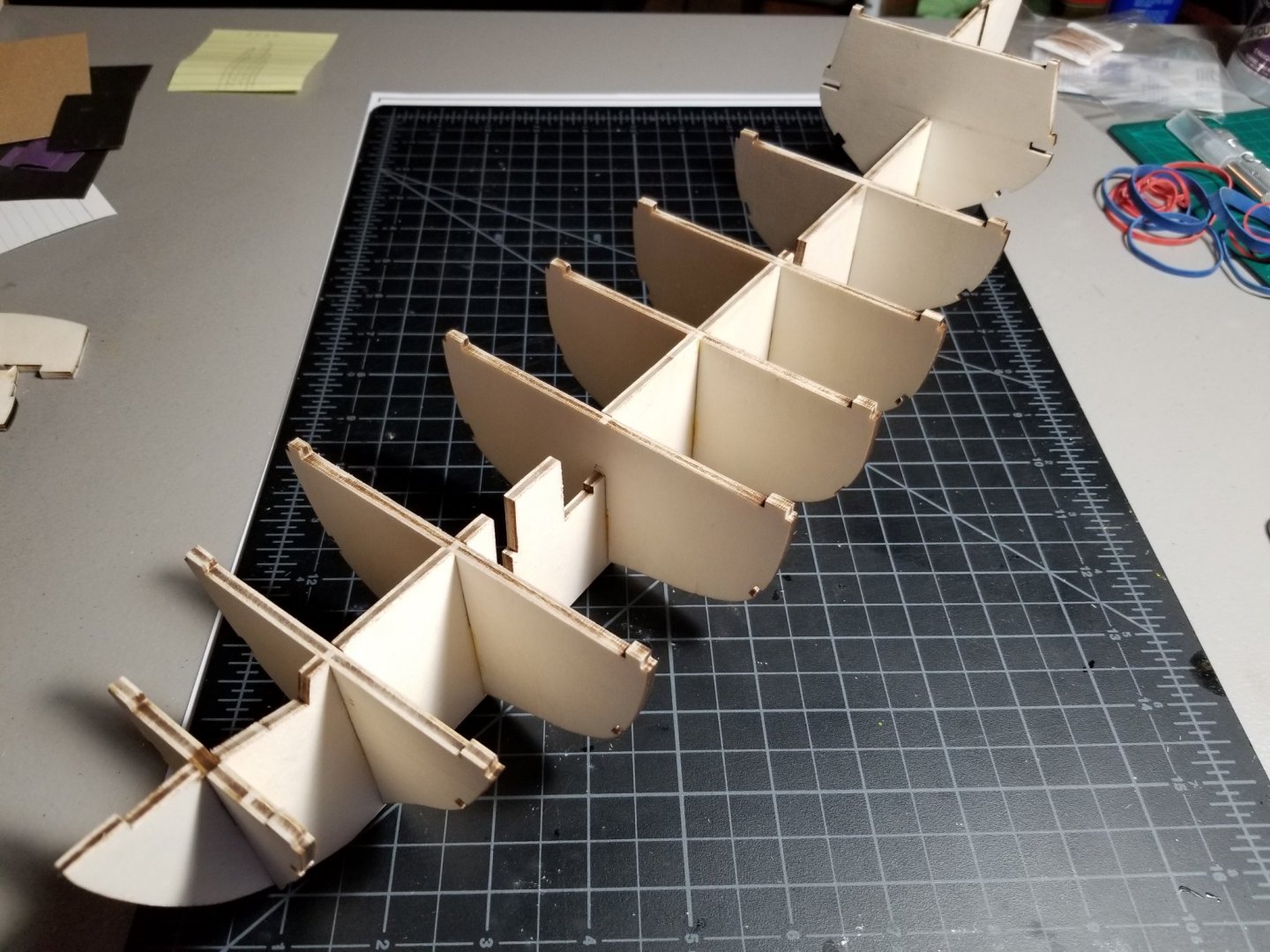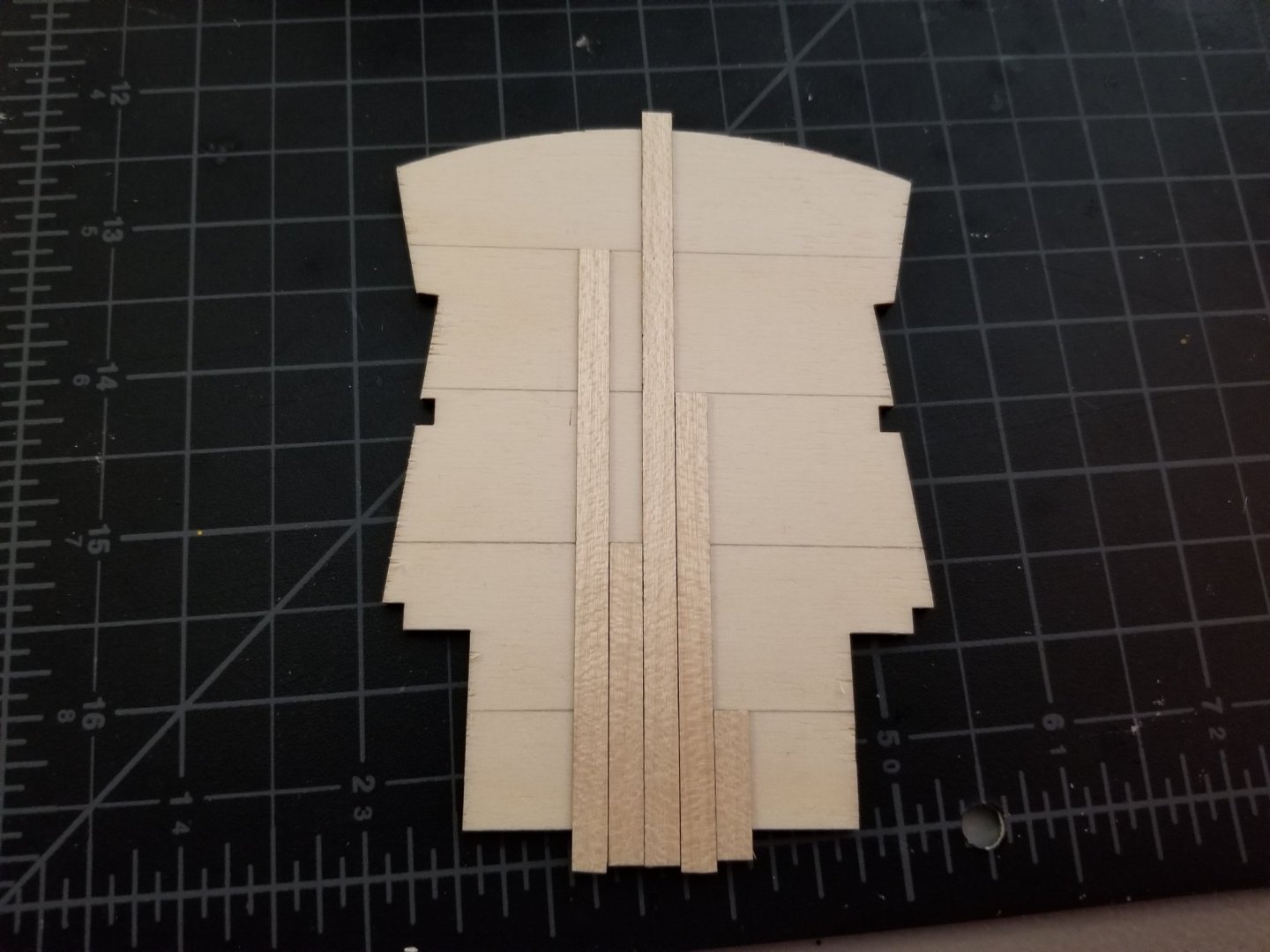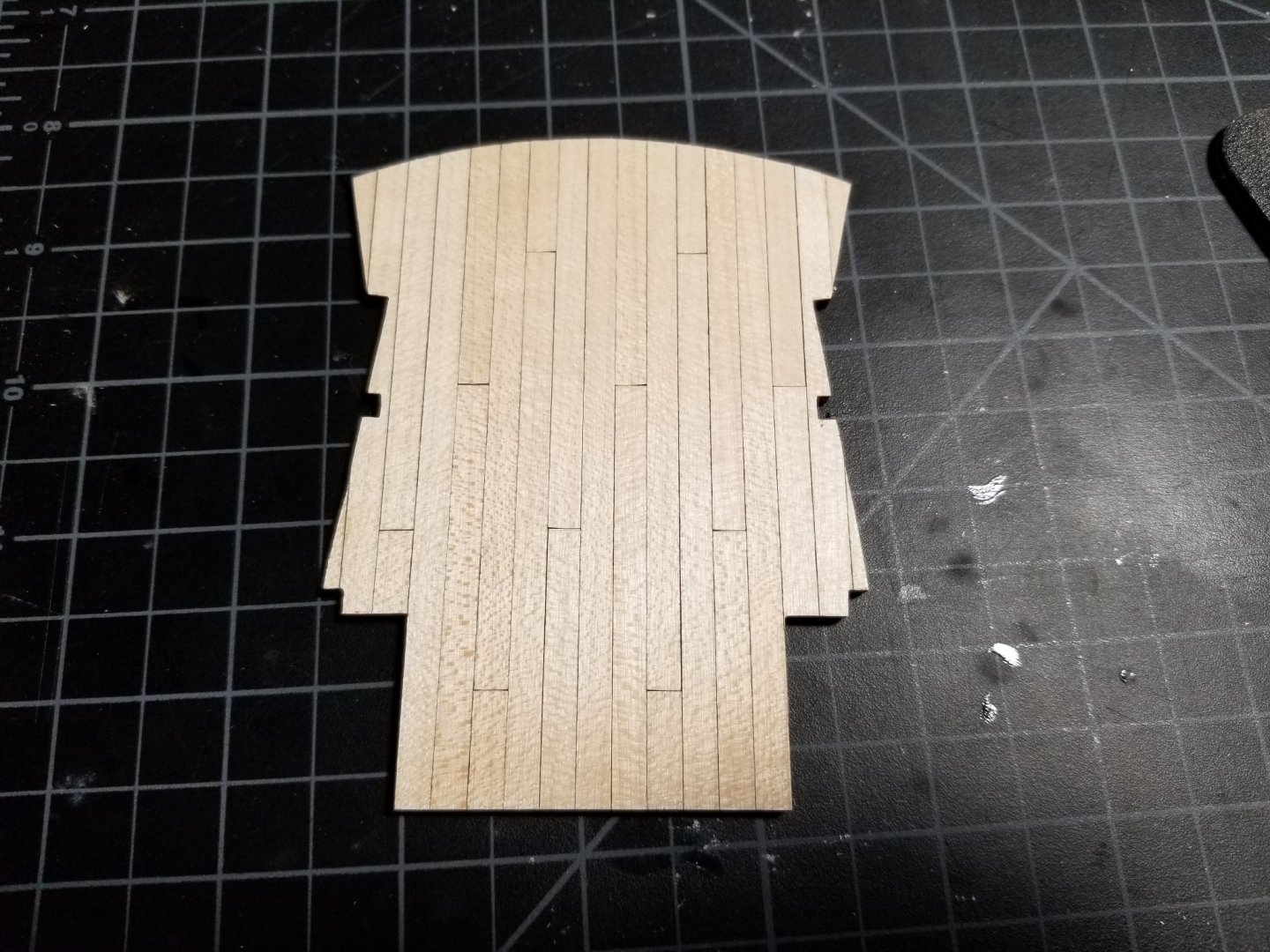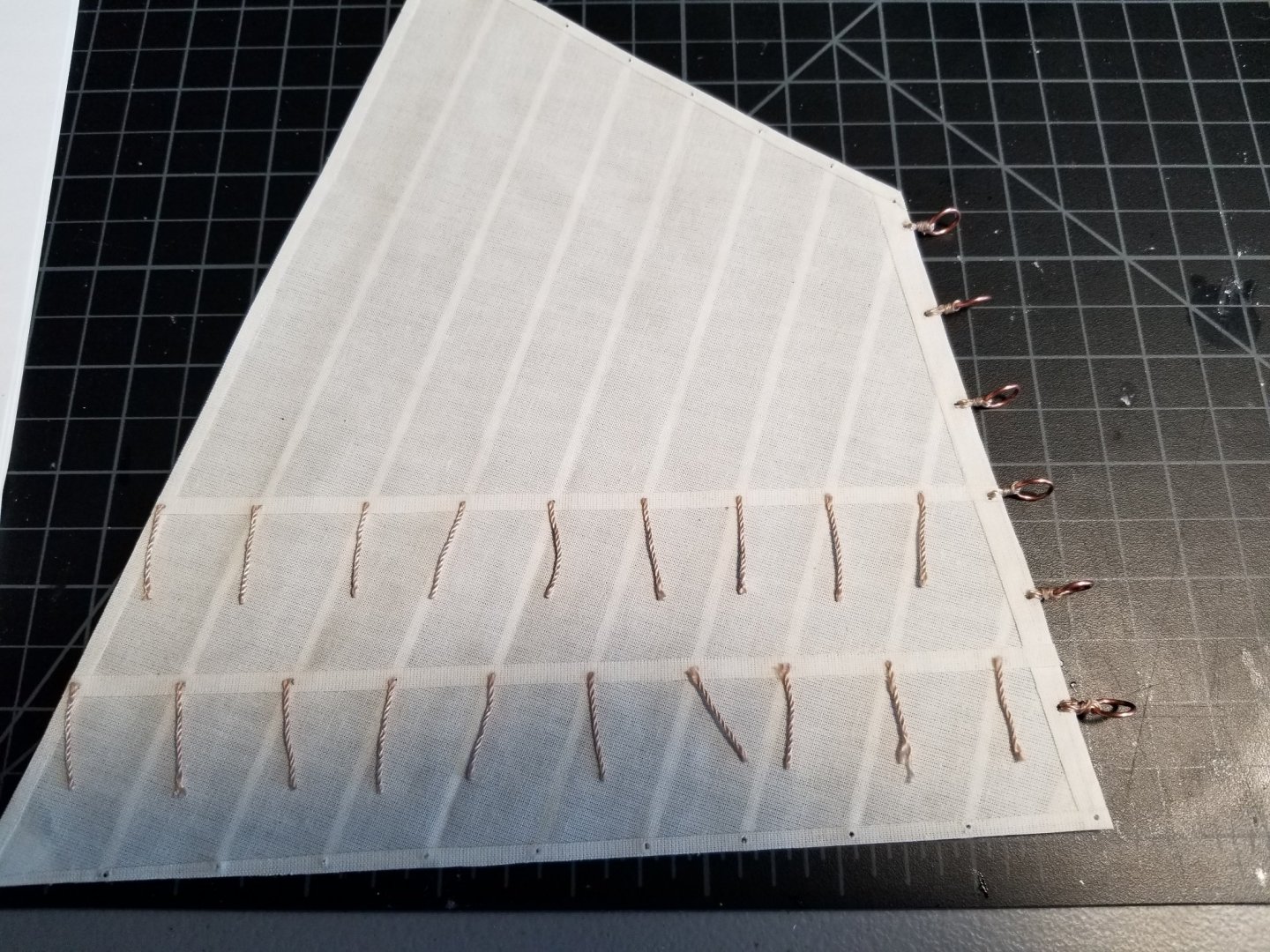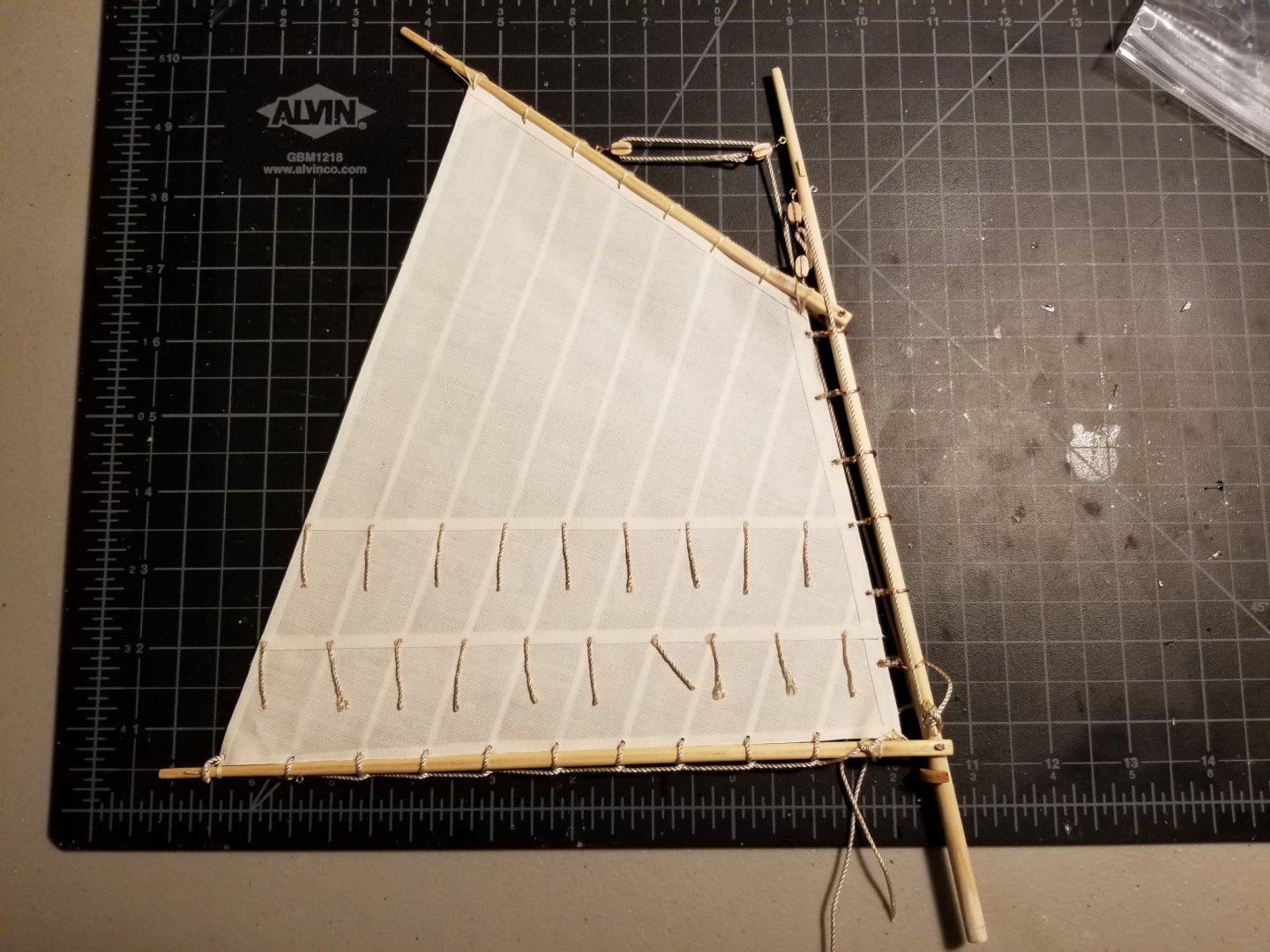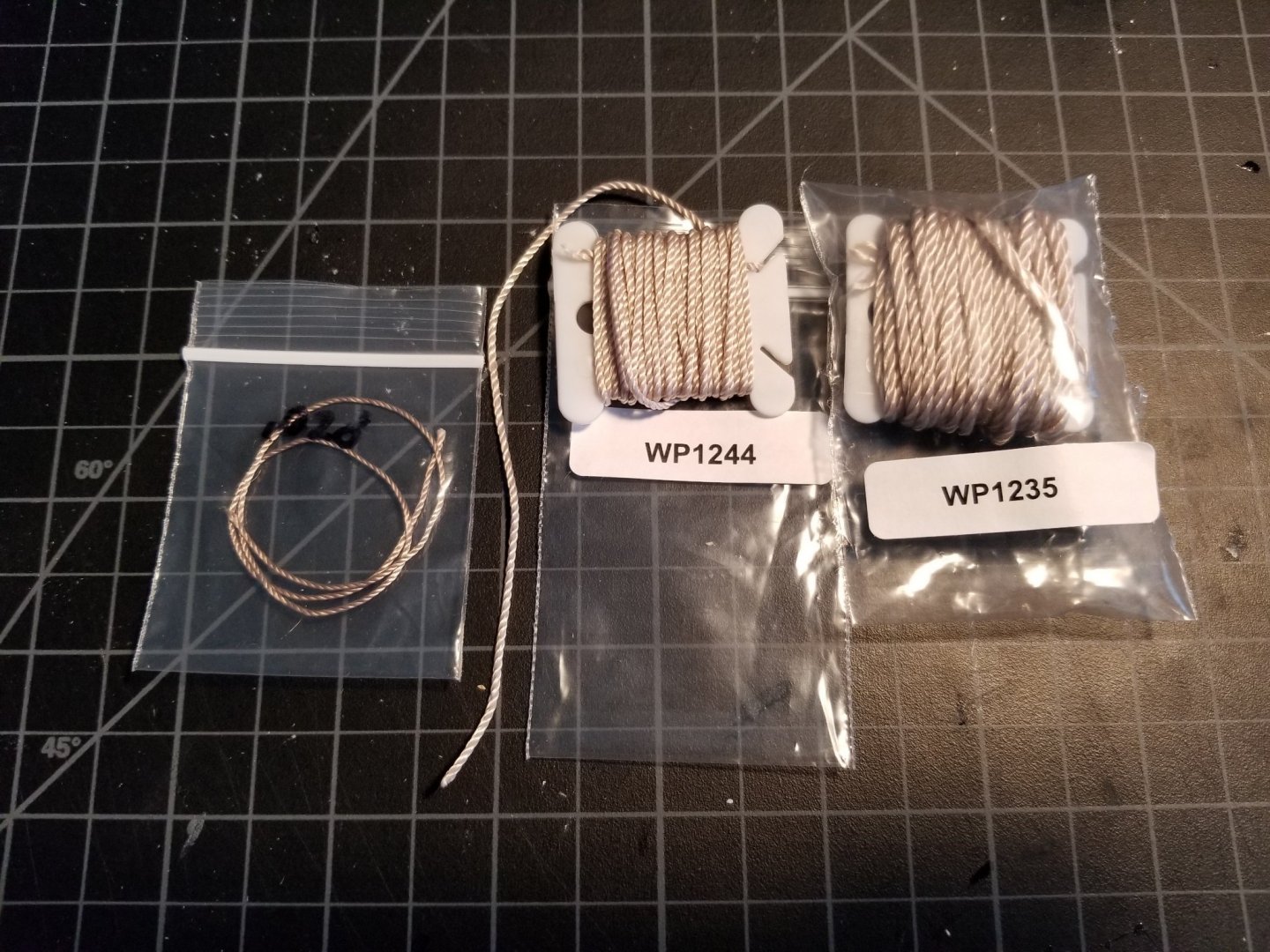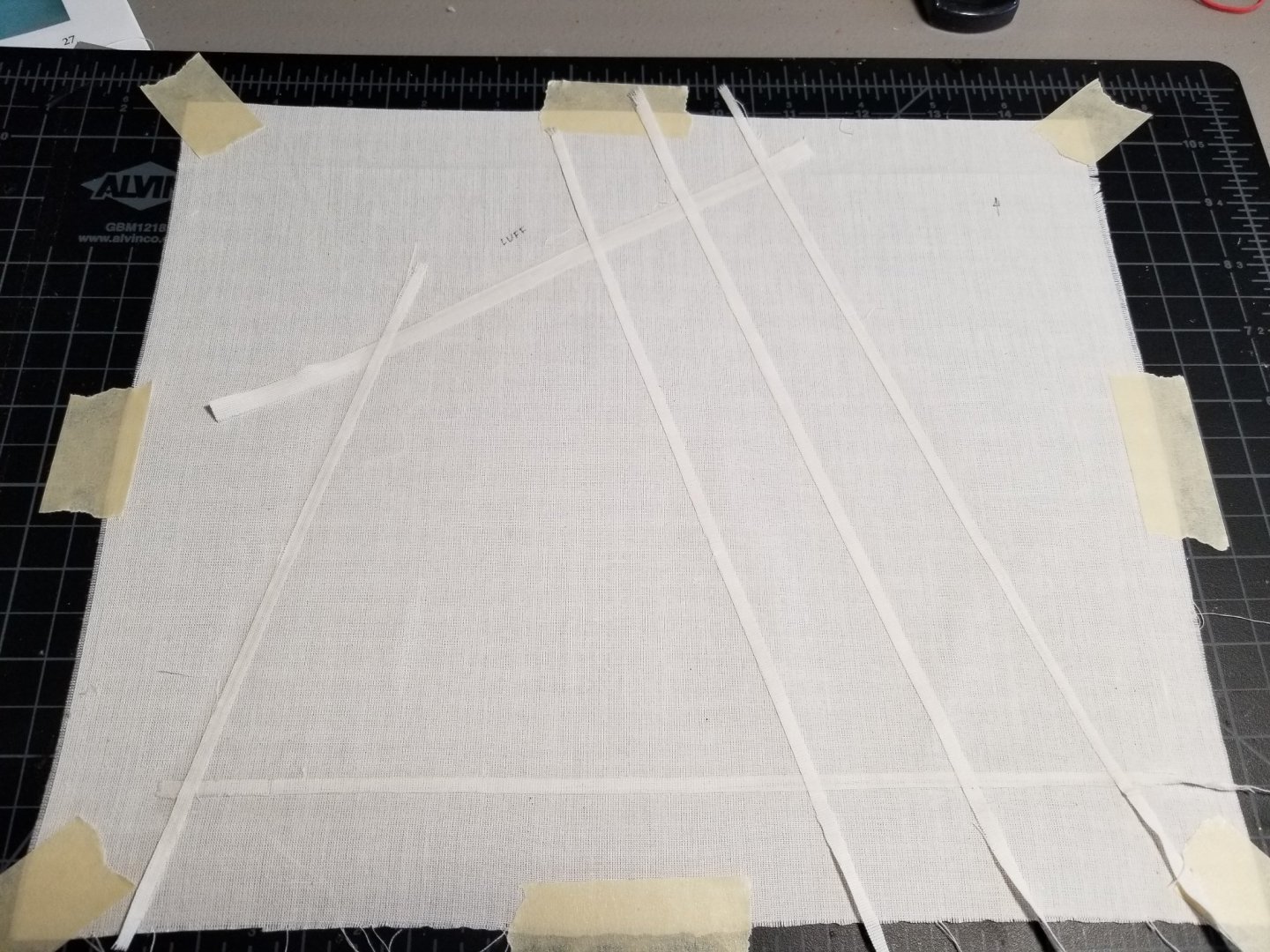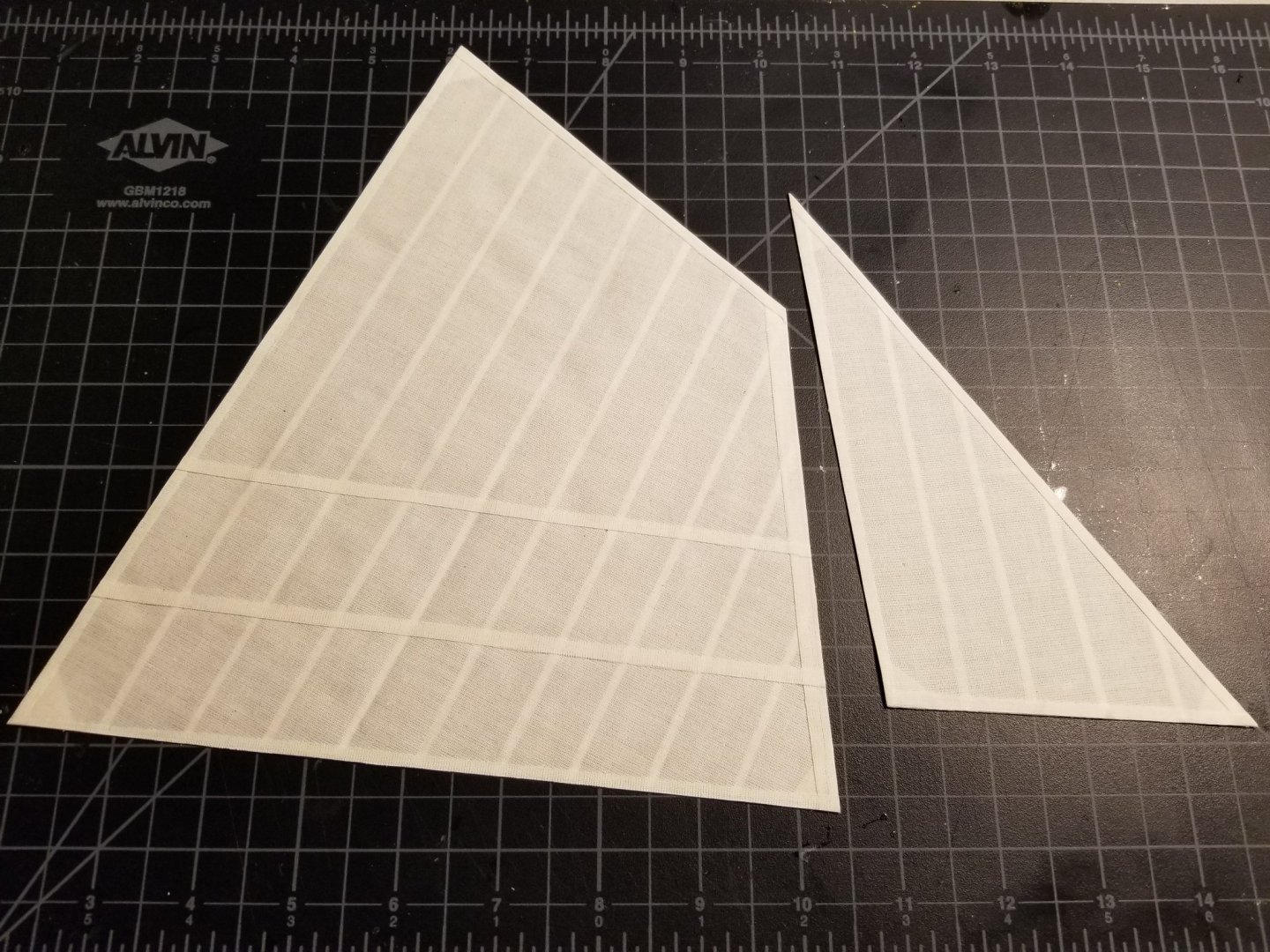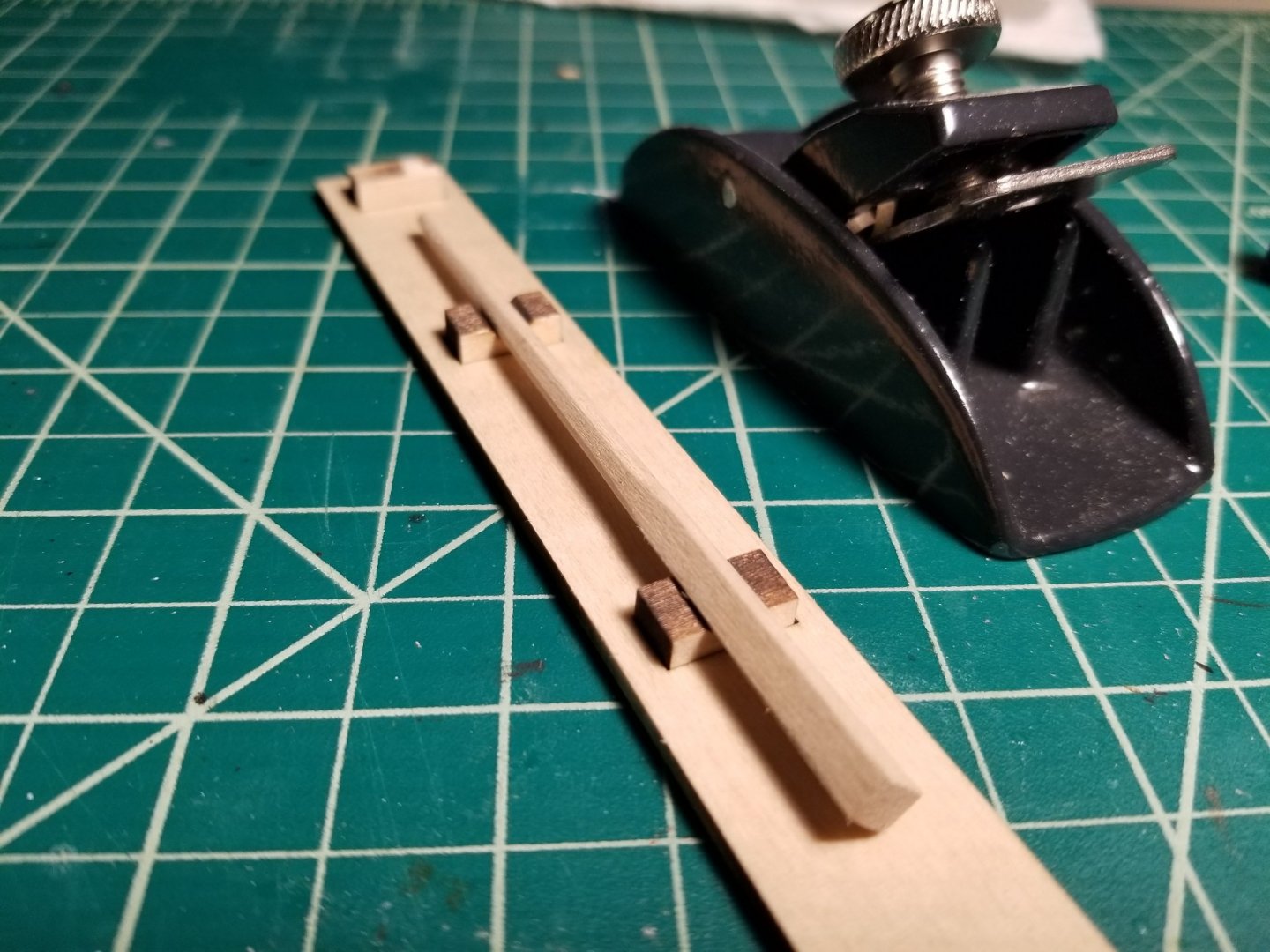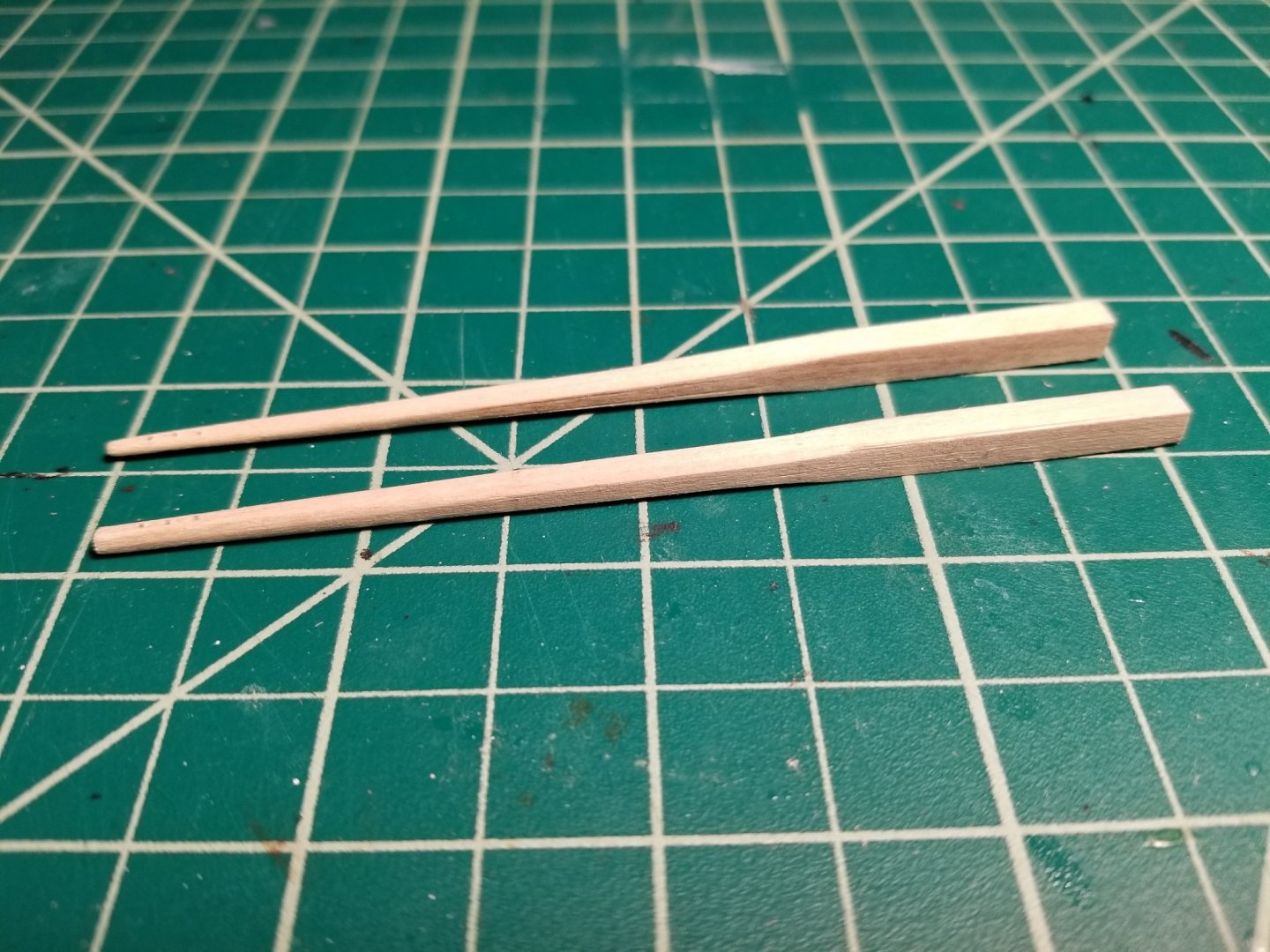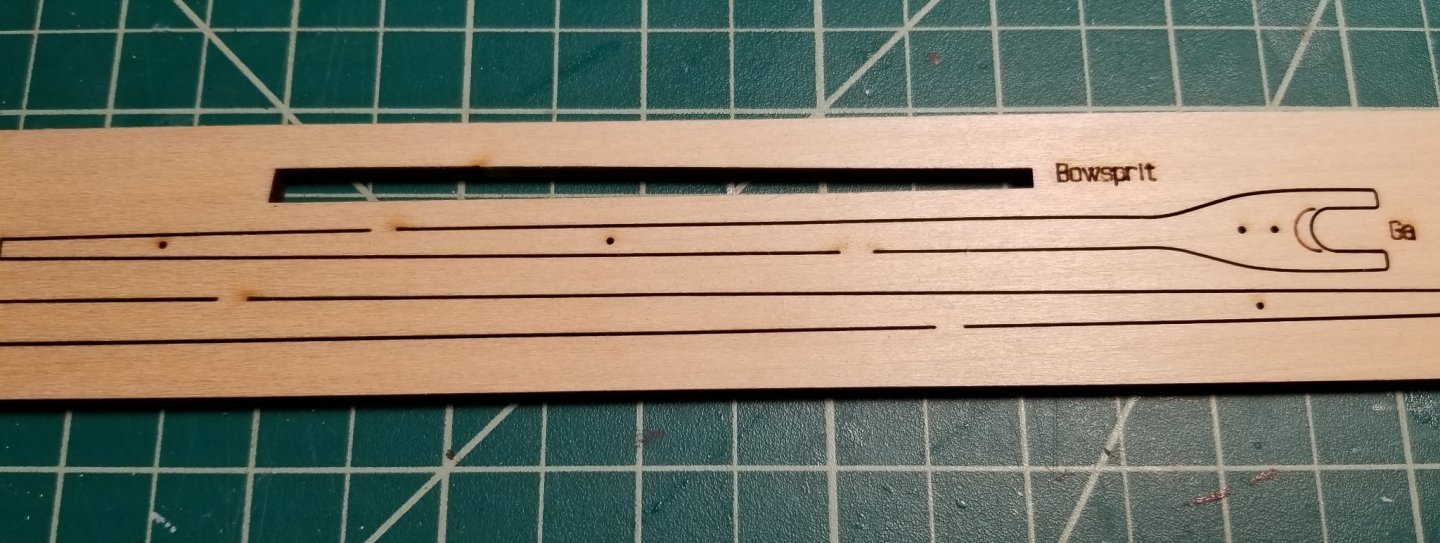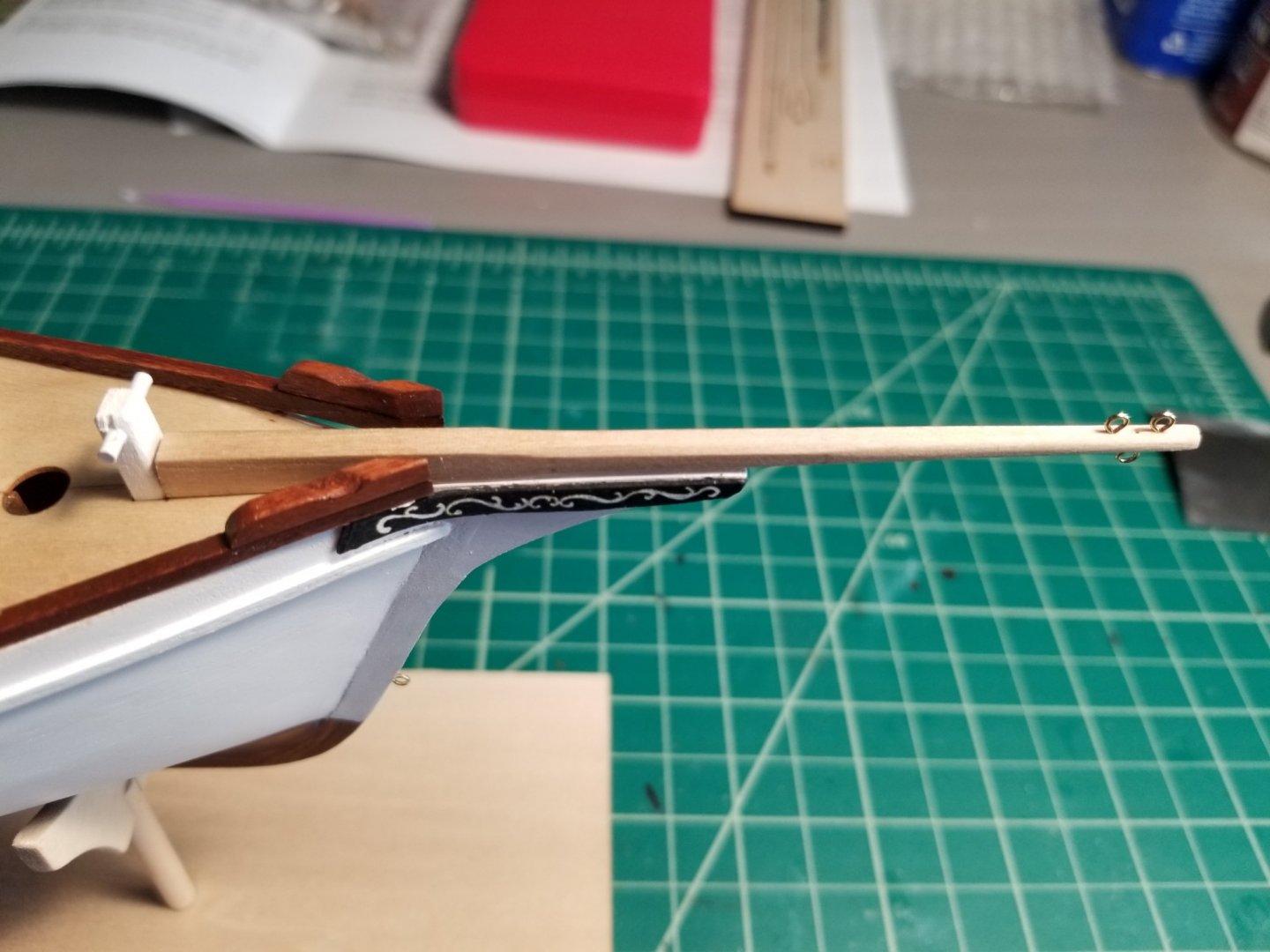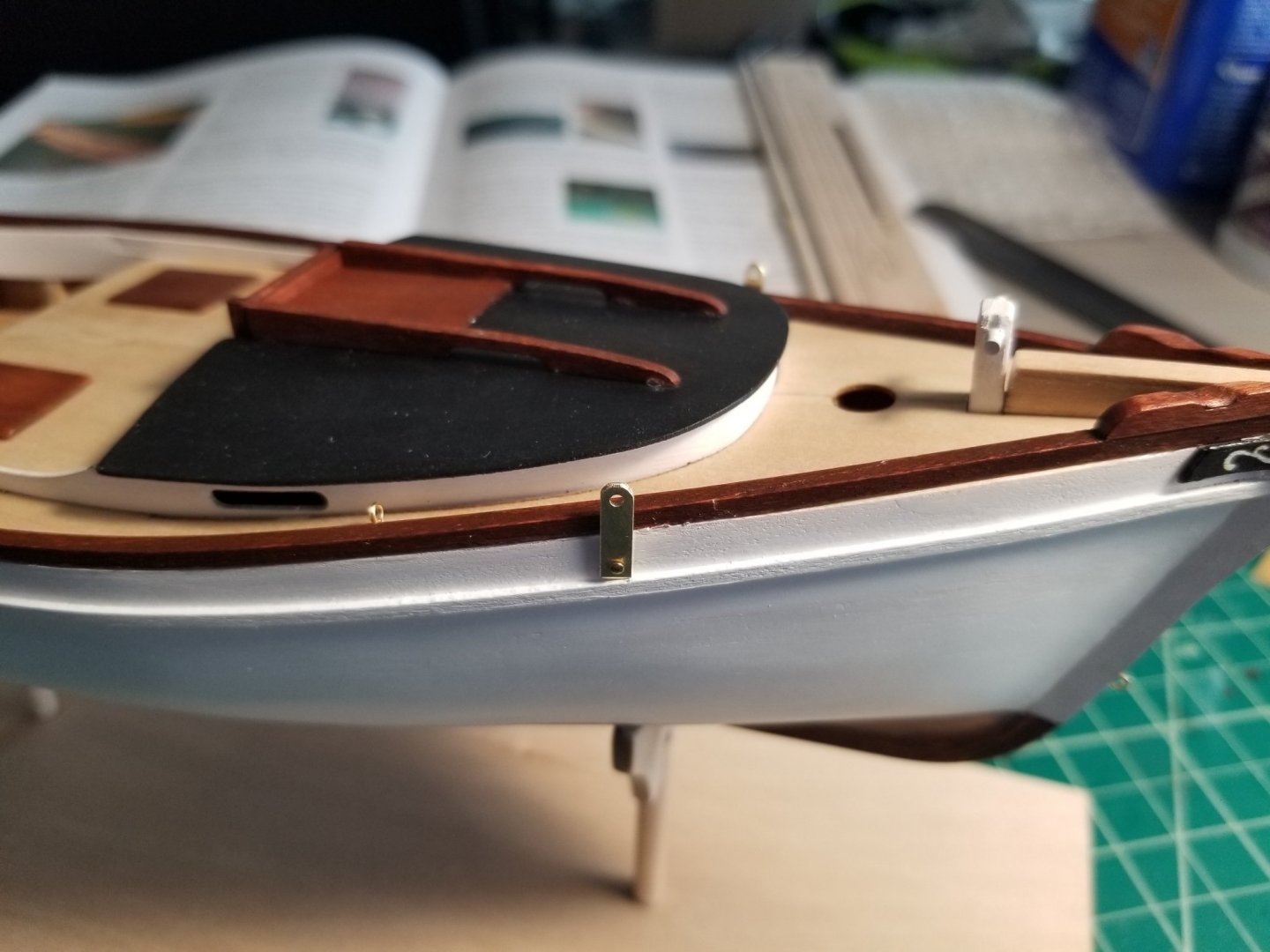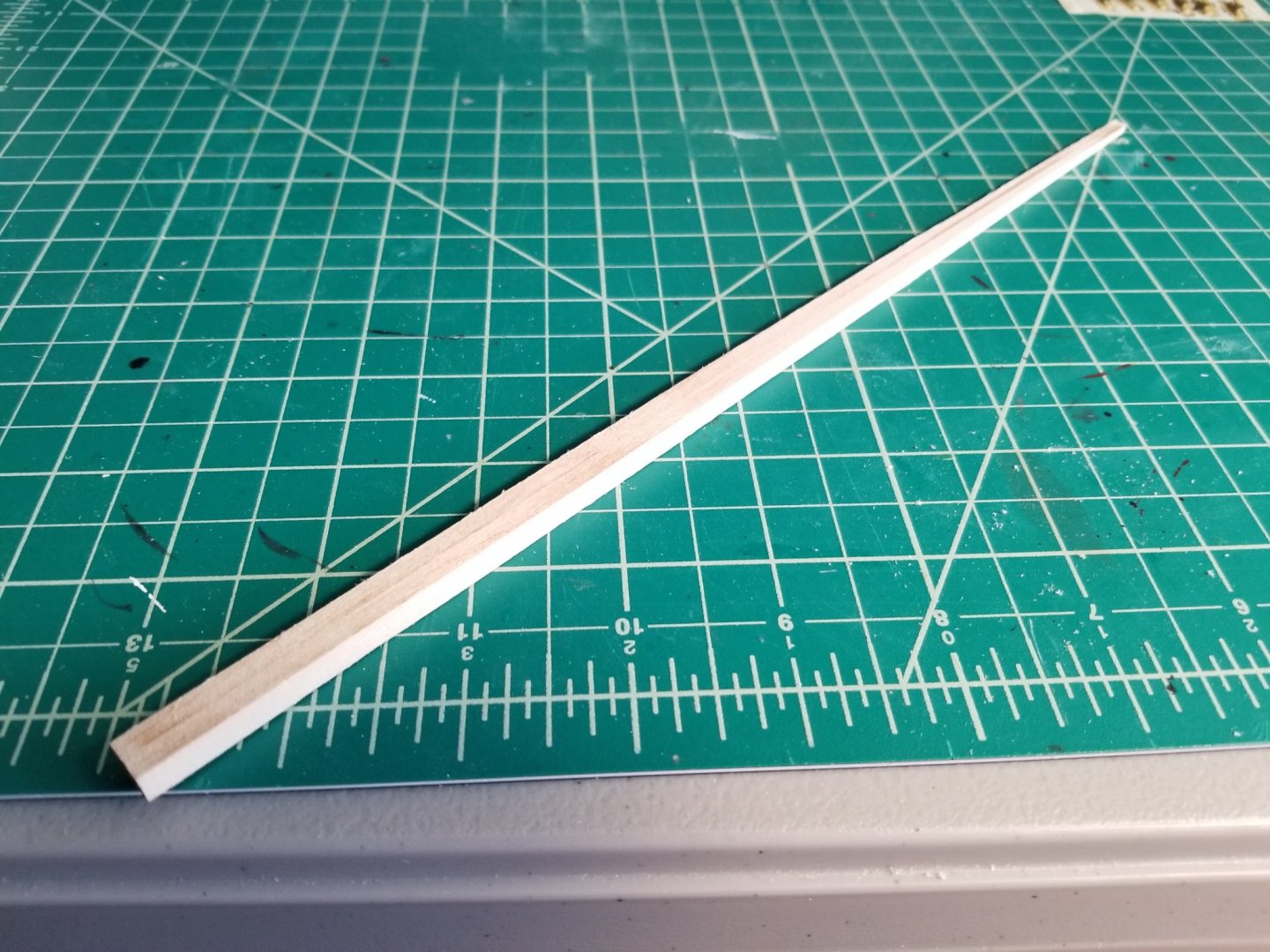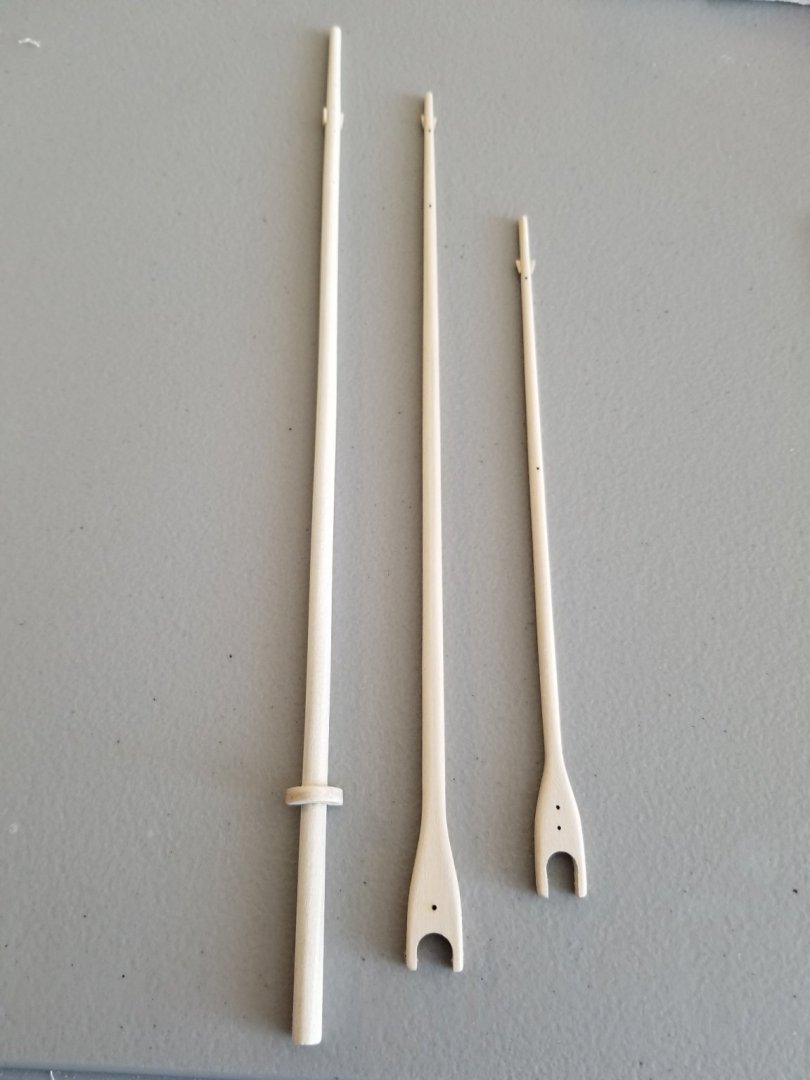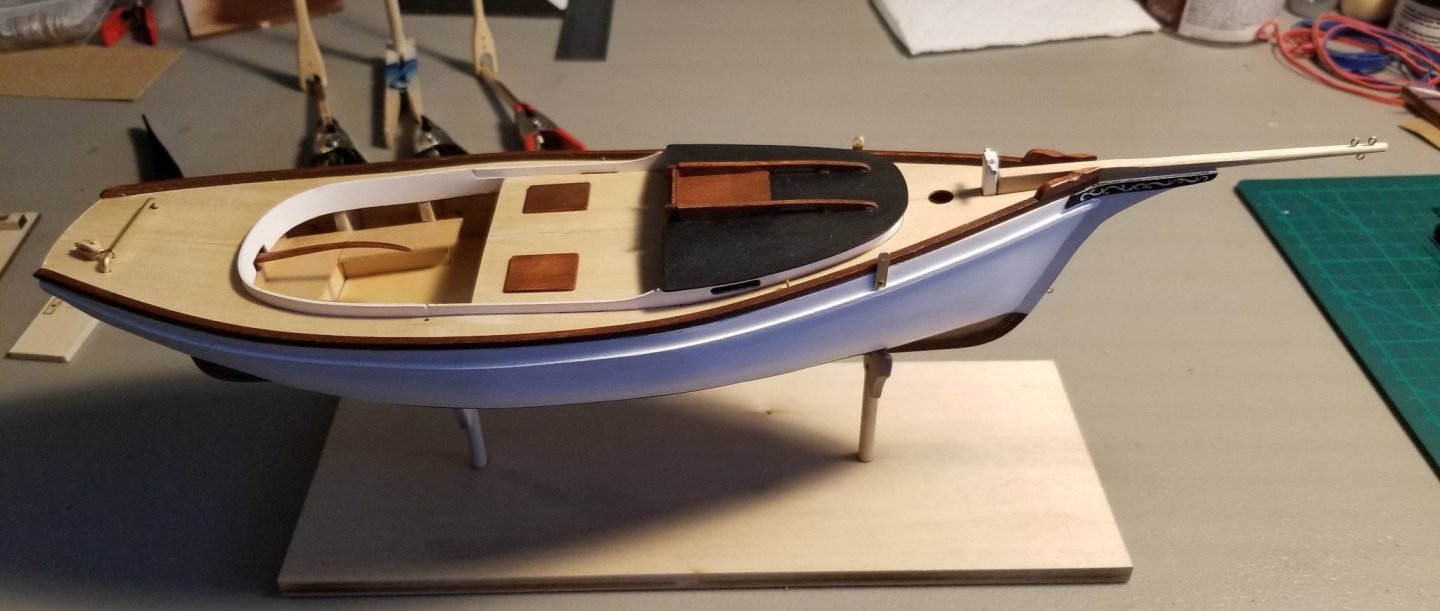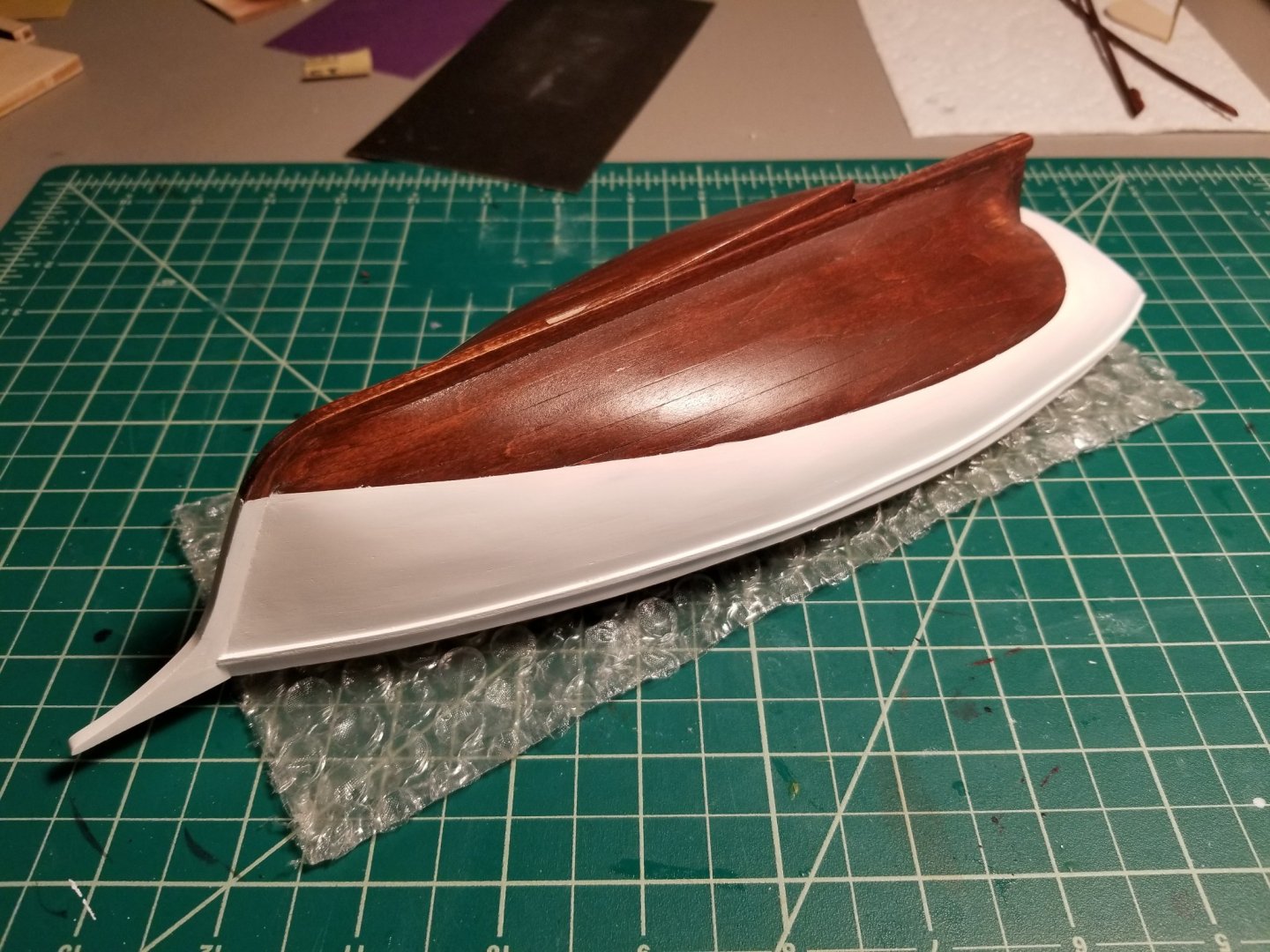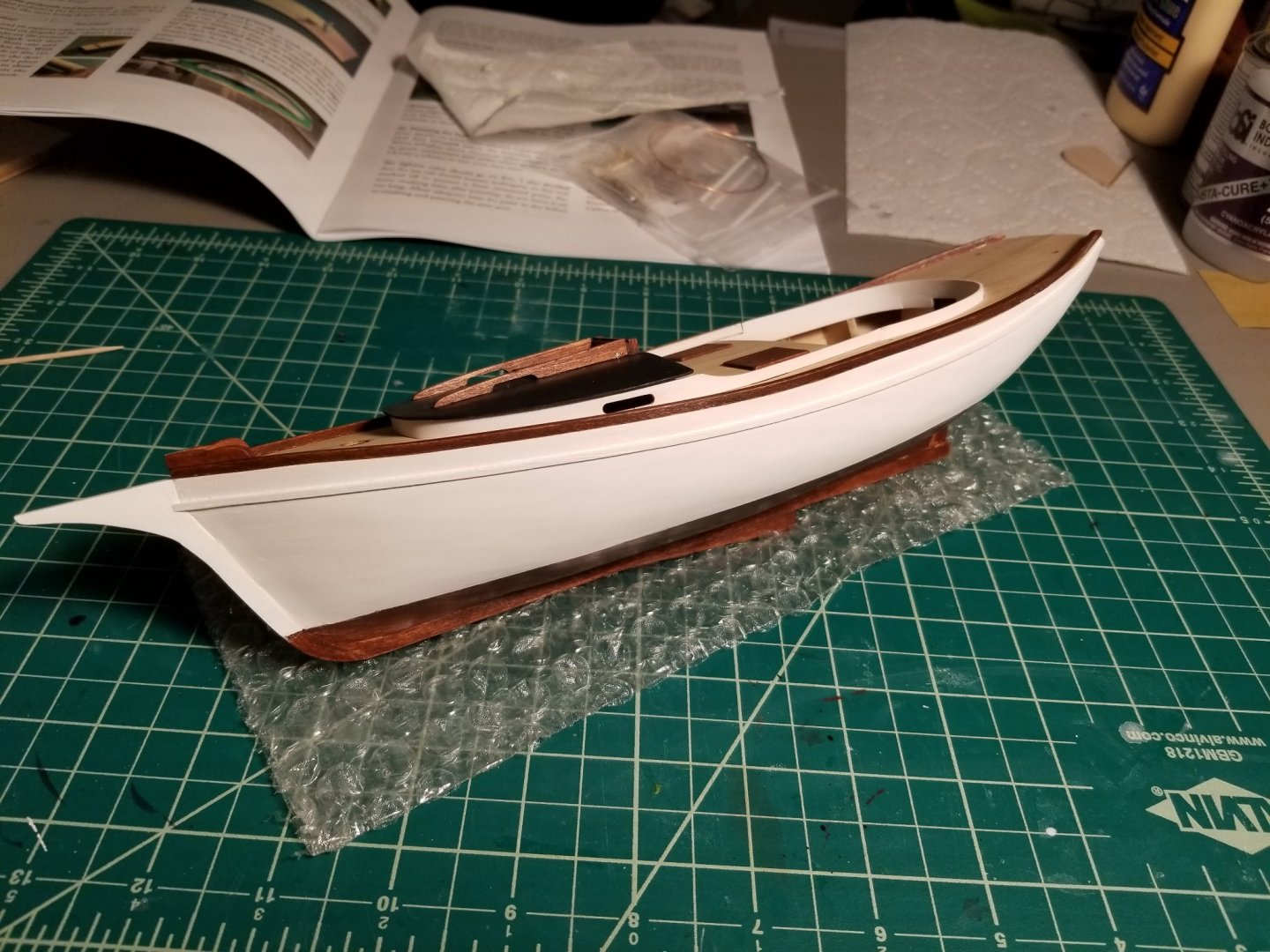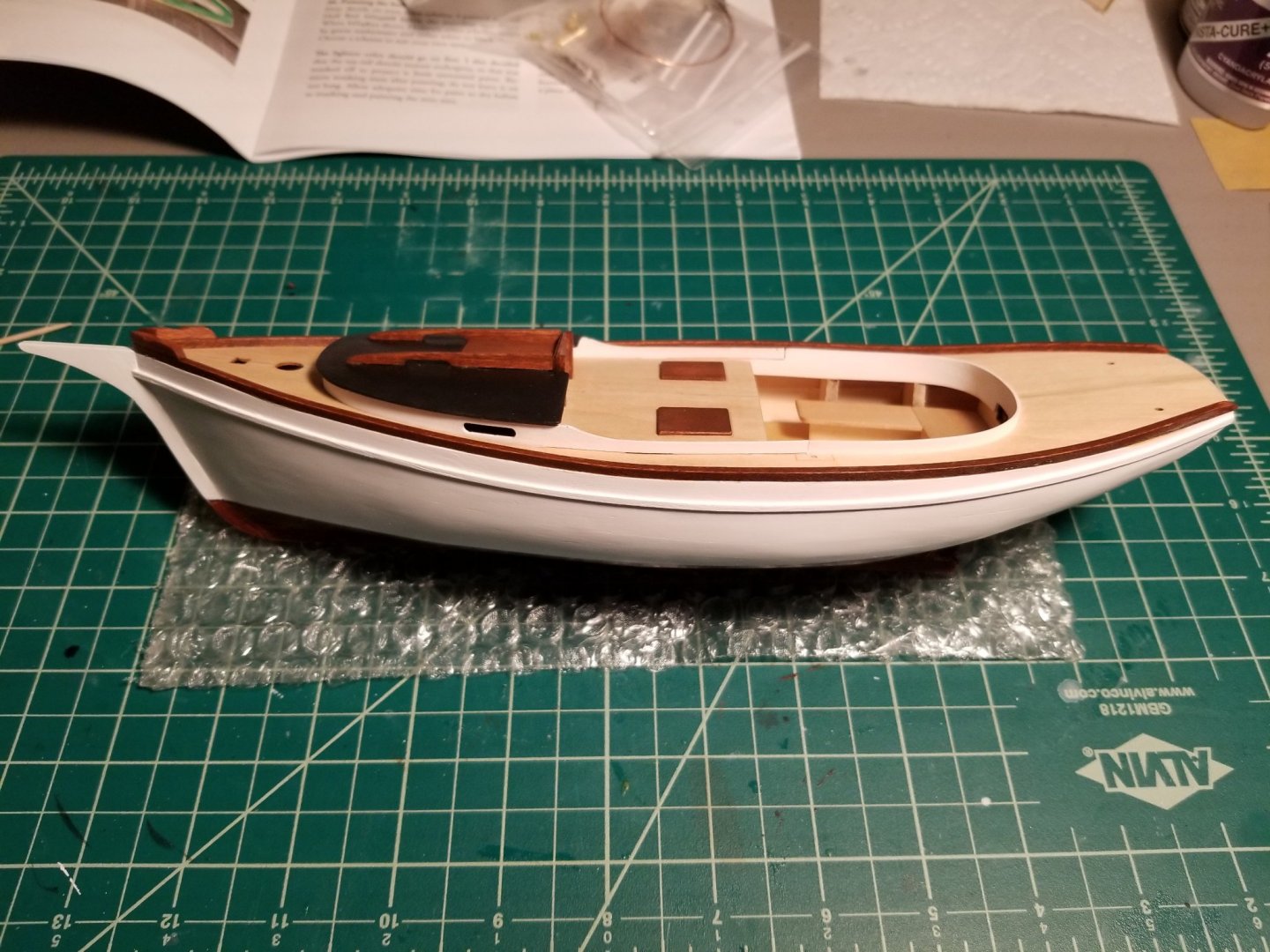-
Posts
32 -
Joined
-
Last visited
Content Type
Profiles
Forums
Gallery
Events
Everything posted by cbeckenb
-
Another very productive week. Had the whole week off from work so I had plenty of time to kill... I made the yards, gaff, and boom using the same method I did for the masts/bowsprit, using a handheld drill and sandpaper. For the yards that have to taper at both ends I left a decent amount of extra to go in the chuck, like this. I had one break when I wasn't careful enough while making those notches on either end but fortunately I had enough dowels not to run out. Here is all the spars ready for stain: They were then stained with the same stuff I used for the masts and a coat of Wipe-On Poly was applied. Naturally the next step was getting all the blocks and so on rigged. Here's the gaff and boom: And yards for one of the masts: For the footropes I used 26 gauge black wire. It's easy to accidentally bend them while moving the pieces around but the stuff is very malleable, so fixes are easy. The last thing to do before starting the standing rigging was some rework on a few blocks that should have had beckets on them. Occre's method (as shown in their YouTube videos) for blocks that should have a rope seized to them is to just tie it on the end with the sheave and call it good. I don't like the way that looks, so I just decided to re-strop the blocks with beckets... And so the running rigging has begun! Starting at the stern, with the gaff and boom: I belayed the boom sheets to the nearby belaying pins since there is nothing in any of the drawings showing where those should be tied off.. With the stern rigged, next up was the lower main yard: After getting the lower yards on, I got into the zone and got both fore and main topsail yards on and rigged, though I neglected to take pics as I went.. I pinned the topsail yards to the masts for peace of mind, though I think the rigging alone keeps everything quite robust. Not having built a square-rigged ship before, I had expected that the yards would swing around a lot, but to my surprise the opposing tension of the various lines keeps it all in place very well even though I did not make them as tight as I did the standing rigging. The belaying pin racks are getting crowded! With every line that gets added, it gets harder and harder to get tweezers in there. The belaying pin diagram does not make much sense to me. It's not symmetrical and there are a few pins that are doubled up. Up next is rigging up the topgallants, and then finishing up the lower course braces, sheets, and so on. The flag(s) need to be rigged too. The kit came with sails but I decided against putting them on since they hide all the details (plus I just don't like the way they look, and they're heavy and thick which ruins the scale effect). Unless I am forgetting something, which I usually am, I think that is all that is left for this one!
-
Now for the standing rigging. I used Chuck's Syren practicum and instructions from the Fair American as guides for the rigging, since the Corsair instructions really don't tell you much. Started off with the shrouds: I am reasonably happy with the deadeyes and lanyards, though they could be more even. A note to anyone using this build log as a reference for this model: Make sure your knots and string tying the deadeyes to the chains are VERY strong! I had to redo at least 5 or 6 that broke while I was tightening the lanyards. And I'm not entirely sure that all will stand the test of time, though so far they're holding. Next was the main and preventer stays. I used 1mm cord for the main stays and 0.5mm for the preventers. Again, the eyebolts pulled out of the deck a couple times while tightening these up... Consequences of making everything taut, as I like to do. Next up, the sheer poles and futtock staves were lashed and glued: Now for my first attempt at doing ratlines: I used thin thread and a curved needle, clove hitching every knot. I used some very thin superglue to hold it all together. They could do with some sag in between the shrouds, but I'm happy with the way they look. After my ~4 month hiatus, I picked up this weekend with the topmast shrouds: These deadeyes turned out more even than the lower shrouds and I'm happy with the way they look. Next were the ratlines for the topmast shrouds. After that, I got the backstays on followed by the main and preventer stays. I had to be a little creative on where to attach these on the foremast... it seems that the proper way to do topmast stays is to reeve them through blocks and down to the deck. But, for this model, it seems the intent is just to seize them on the foremast, so that's what I did. Topgallant shrouds, backstays, and other stays were then put on. Once all that was done for the mainmast, it was all repeated for the foremast. The masthead looks pretty busy with all those stays and shrouds. The final pieces were the fore topmast/topgallant stays and jib stay. Here we are, standing rigging all in place! (At least I think so! I may have missed something...) I'm very pleased with the rigging so far. All the lines are tight and none of them are slack; I managed to get the tensions balanced very evenly. Everything is very robust and stiff now. Now the next things I need to do are to shape and rig the yards, boom, and gaff. Then it's the standing rigging, and I think that's just about it.
-
After getting all the deck furniture in place, finally it was on to masting and rigging. I did not take many pictures of the masting process, but the way I shaped the dowels was using the drill and sandpaper method, using calipers to get the diameters correct. A lesson learned is to make sure that if you use very coarse sandpaper, make sure you use finer paper for long enough to really get out all the gouges. On the bowsprit, I just ran the finer grits over it until it felt smooth. The stain, though, reveals the spirals of where there were some deeper cuts I did not get smoothed out. I was more careful with the masts. After the masts and bowsprit were all put together, first up was to step the bowsprit and start getting it rigged. The gammoning turned out well for a first try: The bobstays, martingale stays, shrouds... I'm not crazy about Occre's way of doing lanyards with brass rings.. there is a high potential for them to split open while reeving the lanyard if you're not careful. After only a couple of redo's, it all came together. So here it is with the masts stepped:
-
Time for a LONG overdue update! I have not built for a few months, first due to some mental health stuff, then due to some COVID stuff... Anyways, I pulled everything back out this weekend to get some rigging done. I have lots of photos of the progress I've made between the last post and now, so I'll break it up into a couple posts. To start with, after that last post, some deck items had to be fabricated, like the pin racks, wheel, cannons, etc. I decided to do some very minor rigging for the cannons, rather than just gluing them in place. I would do all the tackles and so on if I had the patience, but I don't. I got the anchors on as well..
-
More good progress this week. Started off getting the gudgeons and pintles nailed on and the rudder attached. Took a while longer than I thought to cut the hole in the stern for the top of the rudder but managed to get it all done. Then I made pinracks and cat davits, and started on the beakhead. I stained the laser-cut parts to get closer to the color of the kit wood. Other various details were added on, like ladders, windows, and the decorative sternpiece. I experimented with making my own windows but after spending an hour on one of them and then messing it up, I decided it wasn't worth the time investment.. The first rigging is on the model, which is just some blocks and hearts attached to the deck: Other major item this week is getting the deadeyes installed: Took a few tries to get the process down for these, but it went somewhat quickly once I had it figured out. I'm not entirely confident in the ability of those chains to take very much tension since the links come undone pretty easily, so I will have to be careful when tensioning the shrouds later on. The spacing of the chains bothers me too, but between trying to stay in line with the shrouds and avoiding the gunports, I guess that's the way it has to be.. A couple other details, I managed to get the railing on the upper deck last night and got the grating made. The ship is really coming together! Masting and rigging is not far away.
-
Hmm good point. The Occre Corsair is fictional and does not really have a time period established anywhere that I can find so I am not too concerned about being period-correct. Only hint is that it's supposed to be a merchant vessel converted for privateering, but that doesn't really tell me anything. "This originally merchant brigantine was transformed when it got into the hands of the corsairs, and fitted out with 16 cannons and 4 falconets, which all helped them to carry out their misdeeds with better chances of success."
-
Thank you for the advice, everyone! I am examining some photos of brigs in the RMG collection trying to get an idea of what lines are included. Not being familiar with them all, it is taking some research to figure out what line is what. Lennarth Petersson's book is a great resource while I figure this out. I like the idea of leaving on as much as possible (where it makes sense) since I think rigging is one of the most impressive features of model ships (and it's my favorite part of the build). So the strategy will be to leave the blocks and such on the model, and as I get closer to the rigging stage I think I will get a better understanding of how it will all go. If it turns out too busy I might end up leaving some out.
-
Progress update. Since varnishing the lower hull, I have made some decent progress this week. I started off getting the railings on and some other decorative strips along the bow and stern. I am rather proud of the way the curved pieces at the top of the poop deck worked out. Per the instructions, they were made out of some little 2x4mm pieces. All sanded down and stained they look pretty good on the ship. A coat of poly was then applied to the hull above the wales once all those pieces were on. While waiting for that to dry, I decided to get started on painting the castings since they'll be going on the model pretty soon. I airbrushed the stern decorative thing and the gunports gold over black primer, which turned out pretty well. Cannons and anchors painted with black primer, with some drybrushing to add a little depth. I spent way too much time mixing the brown to go on the anchors, since I can't seem to find an appropriate shade ready made. I also built and stained all the cannon carriages: The little wheels provided are plastic and a kind of light tan, which I think makes the assembly look like a toy. Since I can't seem to find a brown paint I'm happy with, I'm thinking I will just paint the wheels/axles black.. any thoughts? The gunports are now on the hull along with a couple small additions, which sums up the progress this week. I am reaching the point where I need to cut into the railing on the forward deck for the cat davits. I realized that I had installed the fore deck much too low for the cat davits to end up flush with the railing so I also pulled that off and reworked it a bit to install it at the right height.
-
Hi all, I am working on the Occre Corsair, which comes with sails and the instructions assume you will use them. I do not want to put on sails, but I am not sure what things I should leave off or not. The instructions are pretty good about showing what rigging belongs to the sails: But there are things like the blocks next to the mast on the yards that don't appear to be used except for sails.. do I just leave those off then? Or in this diagram there are obviously lots of lines for sails, but should I just leave those out entirely? Would some of these things be left on the ship even without sails? (there are 8 sheets of similar diagrams) Any of you more experienced folks and ship experts have advice on what I should do?
-
Great progress this week. I have finished the second layer of planking. Despite the roughness of the wood the lower hull turned out great. Yesterday I got the upper hull planking finished up which was significantly easier, not needing to spile every single plank. Stern galleries planked over: And then today I got the rubbing strakes put on and the upper stern planked over. The strips provided for the rubbing strakes aren't quite long enough to run the full length, so I ended up cutting them into 16cm lengths which split the strakes into three pieces, which I think turned out to look better. So after getting all these pieces on, I figured it was time to put a coat of poly on the lower hull to protect it while I move the thing around getting the other decorative pieces on the wales. Quite a large contrast! I think it looks fantastic, much better than I anticipated to be honest. I'm really glad I went with splitting up each plank into ~20cm lengths, I think the variation makes it much more interesting to look at. We'll see what it looks like after the poly has all soaked in and dried overnight; I don't think it will be as glossy but hopefully still keeps the color. There are a few little gaps where the wood splintered at some point and you can see through to the first layer of planking.. had I seen those earlier I would have tried to fill them in. As it is, though, you can't seem them when the ship is sitting upright so I'm not too bothered.
-
Planking update! The first layer of planking is all filled and sanded and I have done about a third of the second layer. Sanding and filling took a good several hours this weekend but turned out much smoother than I anticipated. (I did a little cleanup at the stern after taking these pics) The hull has quite a nice shape to it and should look pretty good in the end, I think. Once that was all cleaned up, I glued on the keel and stem parts. It took some sanding and cutting away bit by bit at the upper bow to get the stem in place but ultimately it fits pretty well. Next I spent a few hours planning out the second layer, including measuring and lining off the hull. I may have gone overboard but this is my first shot at doing it this way, with spiling all the planks at the bow and stern. So far so good. You'll notice I put some masking tape over the keel to stop it from getting scraped up as I move the thing around. Turns out those pieces are just regular plywood dyed that dark color, so any marring of the surface really shows.. Next is the second layer of planking, which is this nice looking walnut: I'm not sure if it's actually walnut or something else dyed this color. Anyway, it's paper thin and easy to bend and twist. However, it is really fragile. it will splinter and fall apart really really easily. Dampening each strip with my finger before working with it seems to help. I decided to go with a 3-butt shift, my first time attempting it. It's actually pretty quick using Chuck's method found in some YouTube videos in the Planking section of the forums. About 20 minutes per strake so far, though I'm getting quicker. I think it is going to be a handsome looking ship, I like the wood color. I will leave it natural like this and just put on a few coats of Wipe On Poly. I've learned it is best to cover one side of the ship with masking tape while I'm planking the other side.. otherwise these planking strips will catch on anything cloth and start to splinter.. I'm not sure if that is typical of this kit, but the wood is so fragile that I'm kind of worried I'll run out if I'm not really careful. All said, I think I'll be done with the second layer this week if all goes well!
-
I couldn't figure out how the outermost planks were supposed to sit at the stern so I decided to build up the stern galleries first.. this is out of sequence with the instructions but it made it easier for me to figure out how planks are supposed to sit back there. Once the top was done, I started from the garboard up and the master strake down to meet in the middle. I was more intelligent about the bottom planks and soaked one end in water, nailed it in place and let it dry to get the twist at the stern easier to deal with. Then took it off, soaked the other end, and nailed it in place at the bow, and let that dry. Once that was done I took all the nails out and glued them into place. This of course led to some weird shaped planks needed to fill in the gaps but that was not too hard a chore. So the next problem to solve was the aforementioned depth of the master strake: The discrepancy is almost 2mm at the curves at the bow and stern and clearly can't be managed with just filler. So I decided to stack up some 0.5mm strips to fill it in. I'm not sure how well this is going to hold up during sanding but we'll see... So there we go! First layer of planking done. Thank goodness there is a second layer because this looks terrible. I don't like the way Occre wants you to plank the hull. Instead of doing it properly and having a consistent number of planks that taper at the bow and stern, they have you do it this way where the planks are attached as they would be if you just lay it on the side and bend it into place without any tapering or spiling. Look at the way the planks curve upwards at the bow vs. what the correct way would be: I know they do this to make it easier, but to me it makes it more difficult to figure out whether they are twisting or bending the right way as you go. I will definitely do it the right way for the second layer of planking, as the way the first layer is done just looks very unnatural to me. Unfortunately, if you attach the master strake in the notches on the bulkheads you have no choice. It may have taken less time but I feel like it will make it more difficult to do the second layer properly. I also wish the strips for the first layer were thinner, as that would have made it easier to twist and bend them and get them to lie more correctly. Well, in any case, next up is a few hours of sanding and putty to get a decent foundation for the second layer of planking.
-
It has been a long time since my last post, but I have made some pretty good progress despite a break of a few weeks. I decided to bend the bulwarks before planking the insides to make the job a little easier, and I think it worked well. I soaked them for a long time in hot water and nailed them into place before letting them dry overnight. They kept the shape pretty well when removed. After planking the insides of the bulwarks they were glued on which took some time but worked out okay enough. I also planked the fore deck, upper stern, and attached them but neglected to take photos.. The upper stern was soaked and bent before planking, similar to what I did for the bulwarks. I then faired the hull and started on the planking! Starting with the 'master strake' per the instructions, I planked upwards to the bulwarks. The kit comes with 2mm thick strips for planking, which are thicker than I would have liked and made it a bit difficult when it comes to curves at the bow and twists at the stern. Another point to watch out for, is that the second bulkhead is much narrower than I think it should be. Gluing it on the way it is set up would make for a very sharp bend at the third bulkhead and an almost straight run to the bow. I don't think that looks good at all and decided to let the shape of the bow follow the way the plank wants to bend, which leads to about a 2mm gap from the bulkhead. Ultimately I made a couple shims to keep the curve of the bow looking more natural. Another problem that needs to be corrected later, is the depth of the master strake. The master strake comes as a 4mm thick plank and sits in notches in the bulkheads. The notches are inconsistent and deeper than 2mm, so a 2mm thick plank next to it will not be flush at all in some places.
-
Thanks, SkiBee! As for comparison with the Longboat, I found the planking a lot easier on the Lobster Smack due to the fact that the planks are already spiled and do not require much, if any, edge bending. This is also easier, I think, due to the larger scale of the model. I enjoyed the higher complexity of the rigging on the Longboat, though. The other construction is difficult to compare since the two are so different, though I would reiterate that I do not like this method of making masts out of flat laser-cut pieces. The Longboat may be better for total newbies since there are dozens of references and build logs and the instructions are more clear, and I agree that full-scale drawings would be very helpful, for both this build and the Norwegian Pram. While the instructions are fairly thorough, the photos are really no substitute for drawings. My next build is the Corsair from Occre:
-
Well, it has been about a month since my last post! Model Expo kindly sent the replacement rigging line which took about 3 weeks to arrive. In the meantime, I found some suitable black bead cord to do the standing rigging. A couple of the turnbuckles broke when I tried to drill out the hole a little, so for those I had to file off the broken part, drill another hole, and file that down to resemble the original shape (you can see the result on the top of the bowsprit). Not ideal, but nobody will notice unless they know to look. 😉 Here is the standing rigging, with some different line used to temporarily rig the main sail. After this it was a waiting game for the new rigging line to arrive, then another couple weeks working on other things, until today I finally got her finished up and a couple rope coils added on.
-
In the past few days I got the main deck glued on and the main deck planking finished up. I used CA to do this rapidly, and as mentioned before I glued the deck on one bulkhead at a time to flatten it out. Then I moved on to the planking.. I created a little jig to cut 120mm planks and made quite a lot of them. Here is one batch: I used the same "Every 5" method as above for the poop deck and set to work.. This ended up taking much longer than I expected and was quite tedious.. here is a shot halfway through: And I managed to finish it up along with planking Bulkhead 9 this weekend. I also got the holes for the masts, bowsprit, and hatch cleaned up, as well as the outer boundary of the deck. This probably would have been easier to do before gluing the deck to the spine, but I do not think the deck would have curved correctly in both planes had I done it off the model. I put on one thin coat of Wipe On Poly to the surfaces that I have planked.. I expect I will put on a second or third coat later on but I wanted to make sure I could get one coat smooth before more assembly is done. Next up is the bulwarks... these are thick plywood and I am 100% certain they will snap when trying to bend them at the bow if I am not careful. My strategy will be to soak and bend them to the right curvature before I plank their insides.. the instructions would have you do the planking while the pieces are flat but I do not think you could bend the bulwarks correctly (or easily) if they are planked beforehand, so I will play it safe.
-
Hello everyone, This will be my second build log on MSW, now for the Occre Corsair! I saw this kit selling for a very good price and decided to snag one while I could. This will be my first actual ship, since the other kits I have built have been much smaller boats. I think this kit will be a good intermediate level build, since it only has two masts and the build does not seem overly complicated. Looks like a good opportunity to try planking and rigging for a larger and more complex subject. Plus, as far as I can tell, it is a fictional ship so I do not have to worry about being accurate with every detail. Plus, it's a pirate ship! So let's get started.... First up was to unbox the kit and sort/inventory everything. The blocks and deadeyes are made of plastic, but I think they will look quite good in the end. The metal castings look well done and it does not seem that there will be all that much cleanup required. I am less thrilled about the rigging thread, it seems to have quite a lot of fuzz and I do not really like the color of the lighter line. That will be simple enough to replace when I get to the rigging later down the road. I marked the laser-cut pieces with their numbers as suggested by the instructions.. Next all the wood strips were sorted (there sure are a lot): Next I removed all the bulkheads and cleaned off the char from gluing surfaces as best I could. The larger laser-cut pieces are just plywood and the charred edges are very rough so this took quite a bit of filing but I think I have removed enough for glue to hold well enough. After dry-fitting everything a few times, I glued the bulkheads onto the spine one at a time, using the deck to hold them in place while the glue set to make sure they are lined up correctly. The deck is already sort of warped in the correct direction along the spine, but it is also curving upwards athwartships. It does not seem so stiff that it will need to be soaked to flatten it; I think the curve is small enough that if I glue it to the tops of the bulkheads strategically it will be fine. However that also means I will want to glue it to the ship before doing the deck planking so that it will be flat... I do not think I will have major problems with that strategy but we will see how it goes. While all that set, I decided to try planking the poop deck. Using this link for reference: http://modelshipworldforum.com/resources/Framing_and_Planking/Deck_PlankingIIbuttshifts.pdf I chose the "Every 5" strategy which means the plank ends are staggered like this: I picked a 120mm plank length (scaled up that's about 31.5 ft, for us Yanks). The edges of the planks are marked with pencil to darken the joints. Cutting, marking the edges, and gluing was surprisingly time-consuming for such a small part. Once they were all glued on I used a razor saw and files to trim the edges. I like the result. I am not sure whether to sand it to even out the seams, I am worried that sanding would remove some of the pencil shading as it is mostly on the corners of the pieces. In any case I am thinking I should put on a single light coat of Wipe-On Poly so that I can lightly knock down the grain after the first coat, since that will probably be much more difficult once it is on the model and more assembly is done.
-
Yesterday I got the main sail rigged to the mast, boom, and gaff. Here it is with the reef points and mast rings: And here it is all rigged: However..... It appears that I got the wrong diameter rigging line. See above, for example the reef points, lacing along the boom, and the halyards are using too large a diameter. The kit is supposed to come with 0.4mm and 0.7mm line, but it appears to have come with 1mm and 2mm: On the left is some 0.7mm I had left over from the Norwegian Pram. I used up the rest of my spare 0.7mm rigging the gaff and mast rings in the above photos.. and rigged the rest with the provided 1mm line to mock it up. Once I have some line of the correct size I will have to redo the boom lacing, reef points, and the running rigging, but that is not a huge chore. I have submitted a parts request to Model Expo. Interestingly the part numbers match the parts list, but the parts list must be wrong because WP1244 and WP1235 are definitely not 0.4mm and 0.7mm as described on the parts list (and in the instructions). Anyhow, I plan to make a run to the fabric store later and see if there is any suitable bead cord available.. if not I will have to wait and hope that Model Expo will send the right sizes.
-
@bobandlucy I have not had much to do outside of work the past year which leaves plenty of time for construction 😉 I am however finally vaccinated and just about ready to rejoin the real world again, starting with flying home to visit my parents for Mother's Day. I haven't seen them since Thanksgiving 2019 so this should be a great weekend. In the meantime, however, work continues on the Lobster Smack! A short update today. I have managed to get the sails made over the past couple nights. As with the Norwegian Pram I have found that the method of brushing on diluted white glue produces a very nice result. Areas with more layers (i.e. the corners) required a dab of CA to make sure it was all held together nicely and won't come apart. Where I need to cut holes for rigging, I will use a dab of CA on each side before using a sharp drill.. I find that produces a nice clean (and strong) result. A note to the other Lobster Smack builders out there: be frugal with the cloth. I had hardly any to spare in the end. Not much further to go... Plan to start rigging the mainsail to the mast hopefully tonight. I expect I will be done with the boat this week or next. Still need to decide what to do with the base, but the model itself is nearly there.
-
Plenty of progress this weekend. I got the bowsprit, mast, boom, and gaff made as per the instructions. A miniature block plane makes adding chamfers a quick job, and I use a sanding stick to fine tune. The bowsprit took a couple tries since I misinterpreted the instructions the first time around. The first try is on the top here: The problem was that I misinterpreted which sides to taper. In case anyone watching this thread has not done this part yet, the profile of bowsprit as seen when looking at the laser-cut sheet is from the side. I thought this was the top view of the bowsprit as it is with the boom and gaff. So when tapering 'both sides' as written in the instructions, you're tapering the front and back of the piece, as seen when looking at the sheet. The bottom of the bowsprit is not supposed to be tapered, which I found out the hard way when I fitted my first bowsprit on the model and realized it was not flat along the beakhead. After a coat of Wipe-On Poly I fitted it to the model. I needed to add a little wedge underneath the end against the samson post since the beakhead and deck aren't totally parallel on my model. You'll see I also added the trailboards. I also made the chainplates and added them along with the fairleads. I put the mast halves together and tapered the assembly per the instructions. I took a swing at making the chamfers and rounding it all off, but as with the Norwegian Pram, I had trouble making it circular rather than elliptical. It was taking way too much time trying to get the lower part circular enough to fit through the deck, so I gave up and just shaped a 1/4" dowel I happened to have on hand (I think it's from the Norwegian Pram kit) using a drill and sandpaper. Personally I think the method of starting with a square piece as done in these two models works okay for things like booms and gaffs as long as the thickness of the sheet is reasonably close to the diameter you want. But gluing two halves together that are supposed to taper as much as the mast does... I think it's just a waste of time since you have to remove so much material and it's really difficult to get a circular result. Here are the mast, boom, and gaff all shaped and drilled, with the stops and boom saddle fitted: The model so far is turning out pretty well, despite all the mistakes and corrections. I have not decided what I'm going to do with the base yet... I stained the base for the Norwegian Pram but I think it turned out to be a little too monotone, especially considering I used the same stain for most of the model..
-
This week I painted the upper part of the hull. I used the MS4831 white paint, brushed on. I used Tamiya masking tape for curves to mask the waterline. It took several coats of paint, wet sanding, filling some low spots, painting again, wet sanding, etc. to get a nice smooth finish but I am happy with it. That is two heavy coats of satin Wipe-On Poly on the stained portion of the hull. After painting the hull I finally glued on the toe rails. They are a tad bit too long which will take a little trimming and some touchup, but no big deal. I still think it was easier to stain these off the model. I am happy with the contrast between the white and the stain. It is exactly what I had envisioned. Next up is adding some deck details, the trailboards, and getting started on the rigging.
About us
Modelshipworld - Advancing Ship Modeling through Research
SSL Secured
Your security is important for us so this Website is SSL-Secured
NRG Mailing Address
Nautical Research Guild
237 South Lincoln Street
Westmont IL, 60559-1917
Model Ship World ® and the MSW logo are Registered Trademarks, and belong to the Nautical Research Guild (United States Patent and Trademark Office: No. 6,929,264 & No. 6,929,274, registered Dec. 20, 2022)
Helpful Links
About the NRG
If you enjoy building ship models that are historically accurate as well as beautiful, then The Nautical Research Guild (NRG) is just right for you.
The Guild is a non-profit educational organization whose mission is to “Advance Ship Modeling Through Research”. We provide support to our members in their efforts to raise the quality of their model ships.
The Nautical Research Guild has published our world-renowned quarterly magazine, The Nautical Research Journal, since 1955. The pages of the Journal are full of articles by accomplished ship modelers who show you how they create those exquisite details on their models, and by maritime historians who show you the correct details to build. The Journal is available in both print and digital editions. Go to the NRG web site (www.thenrg.org) to download a complimentary digital copy of the Journal. The NRG also publishes plan sets, books and compilations of back issues of the Journal and the former Ships in Scale and Model Ship Builder magazines.



